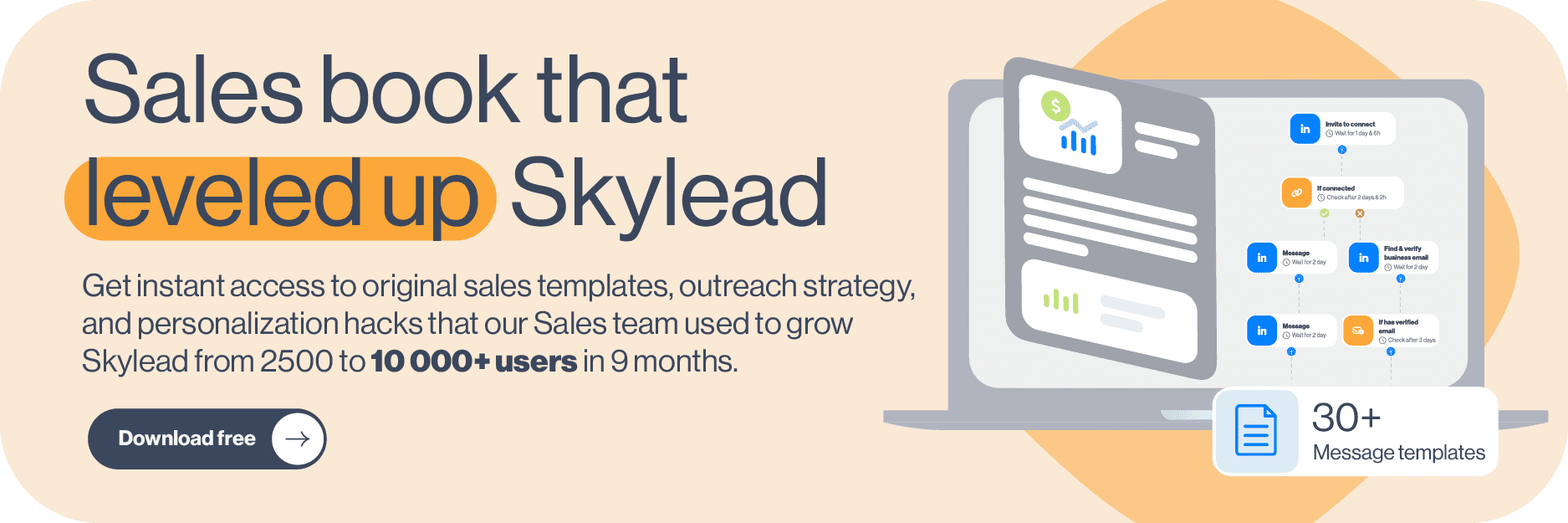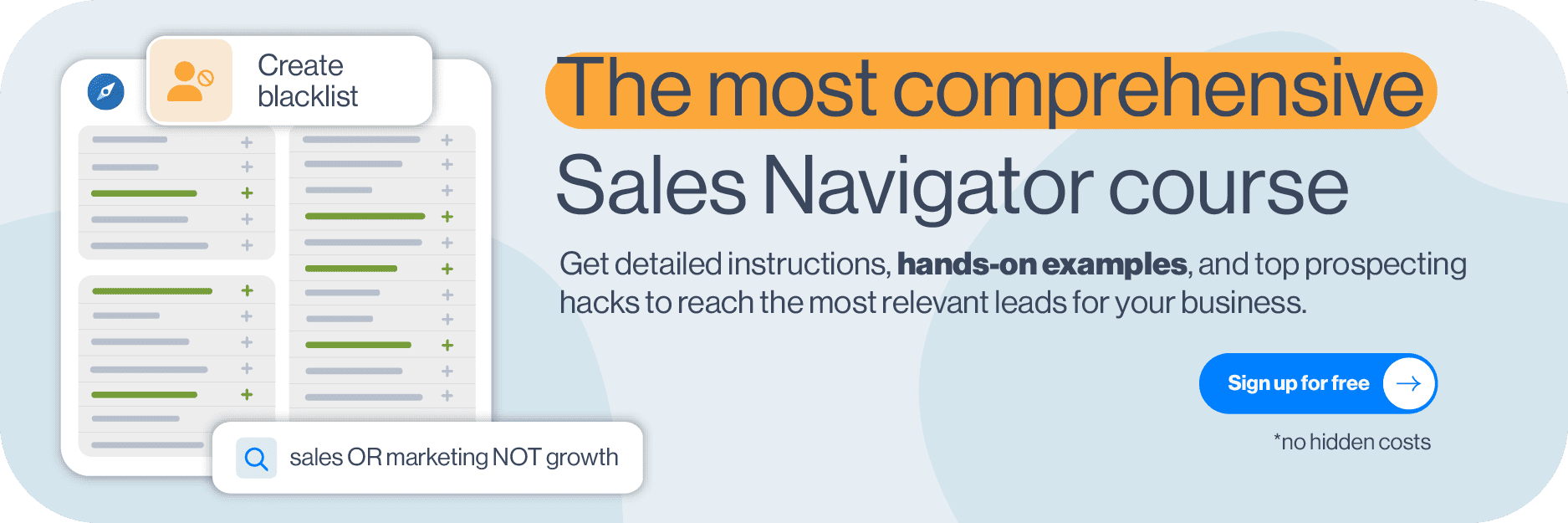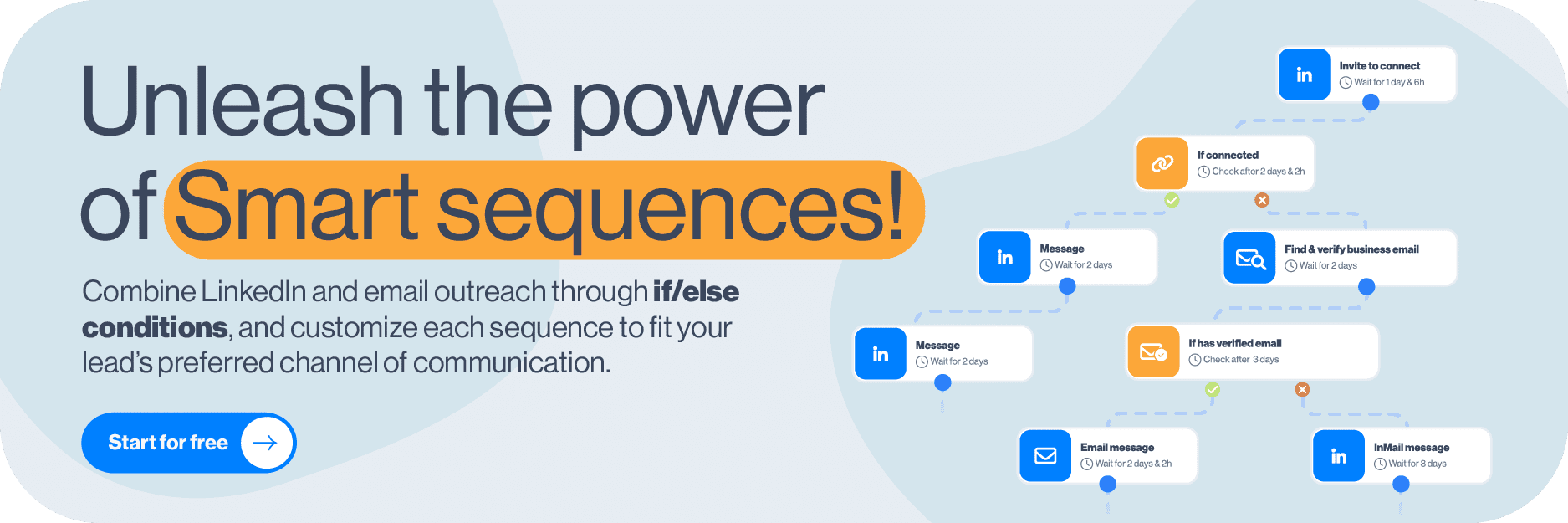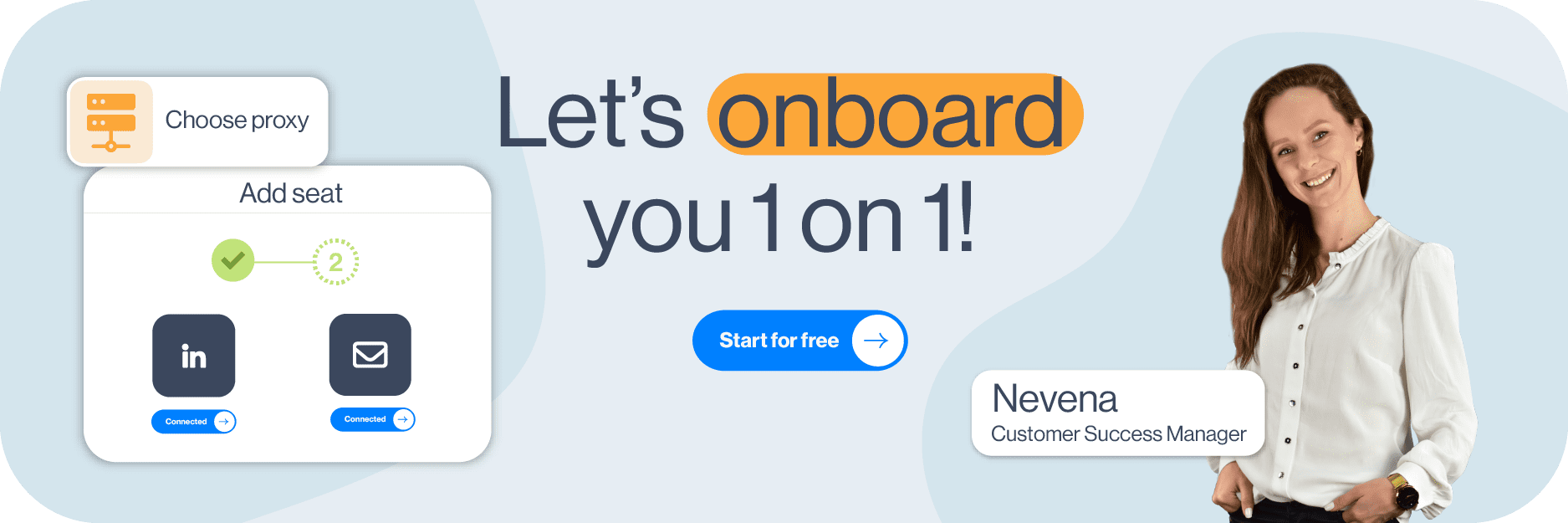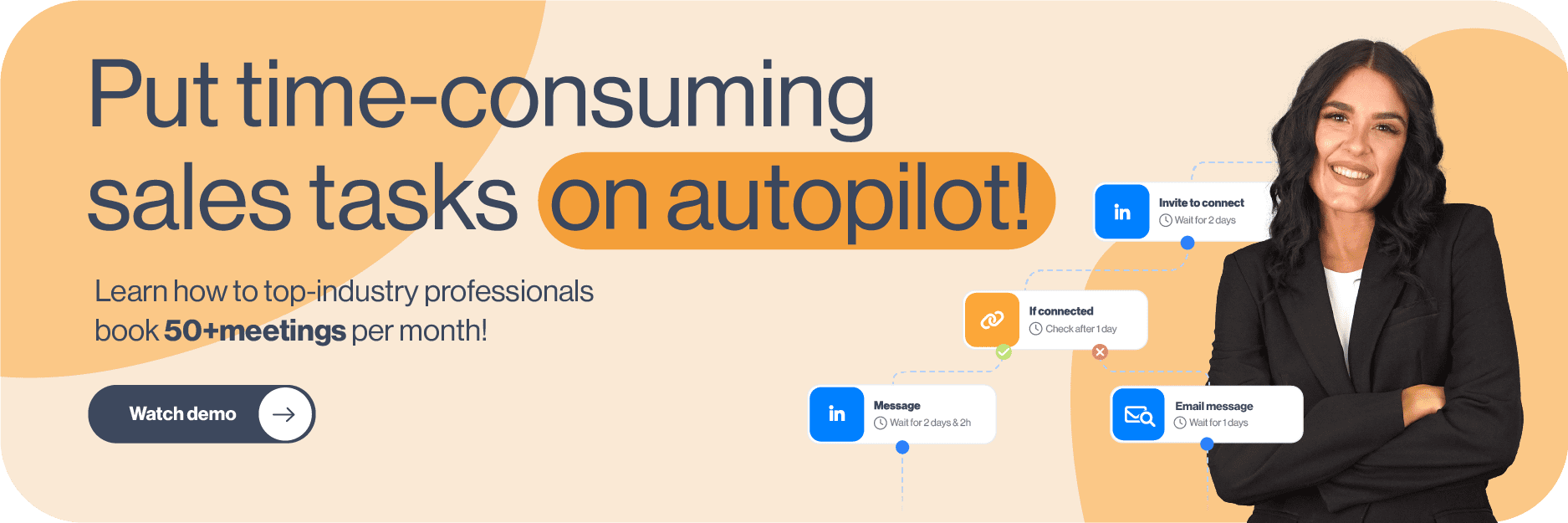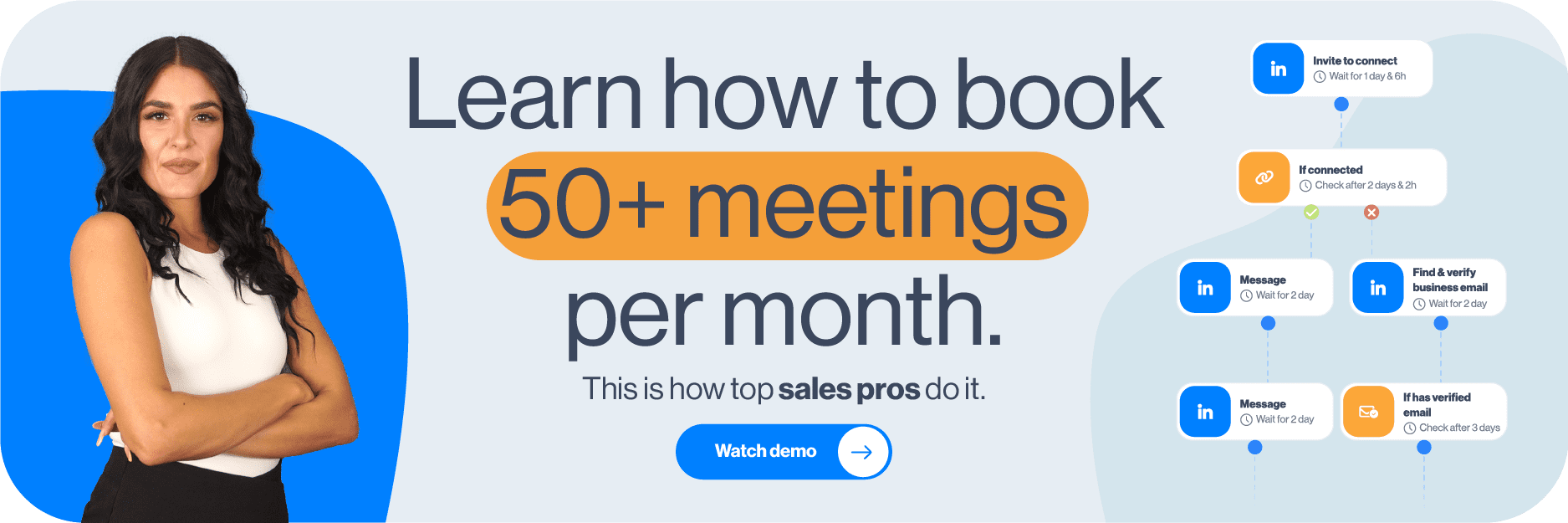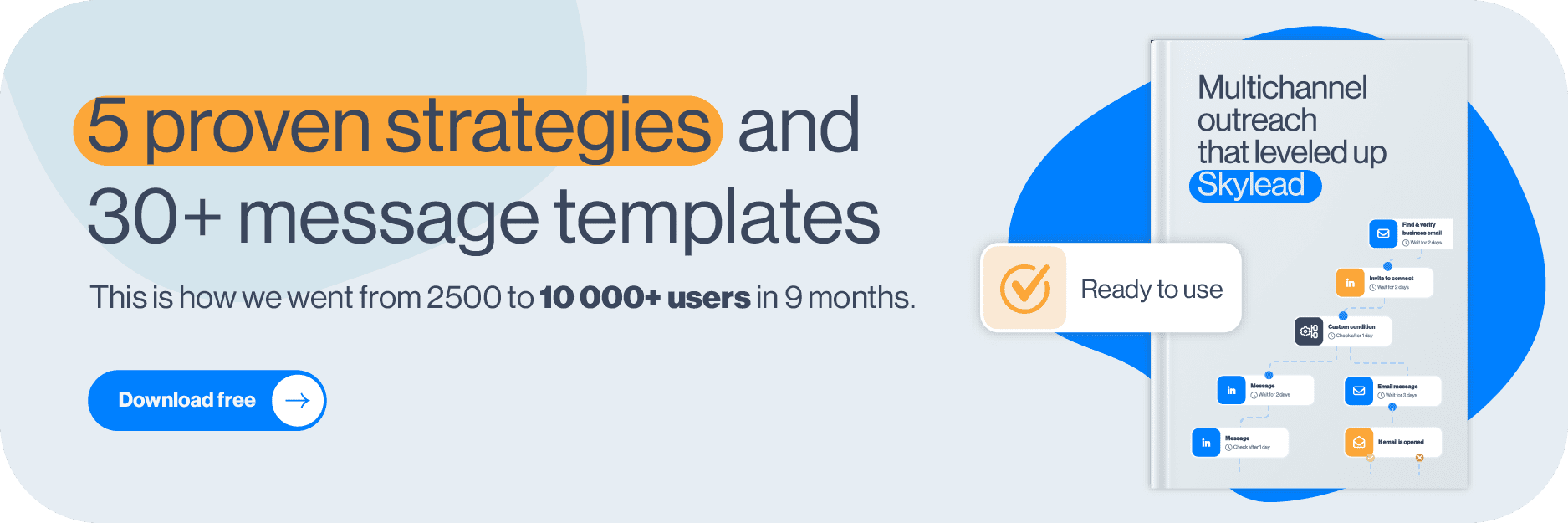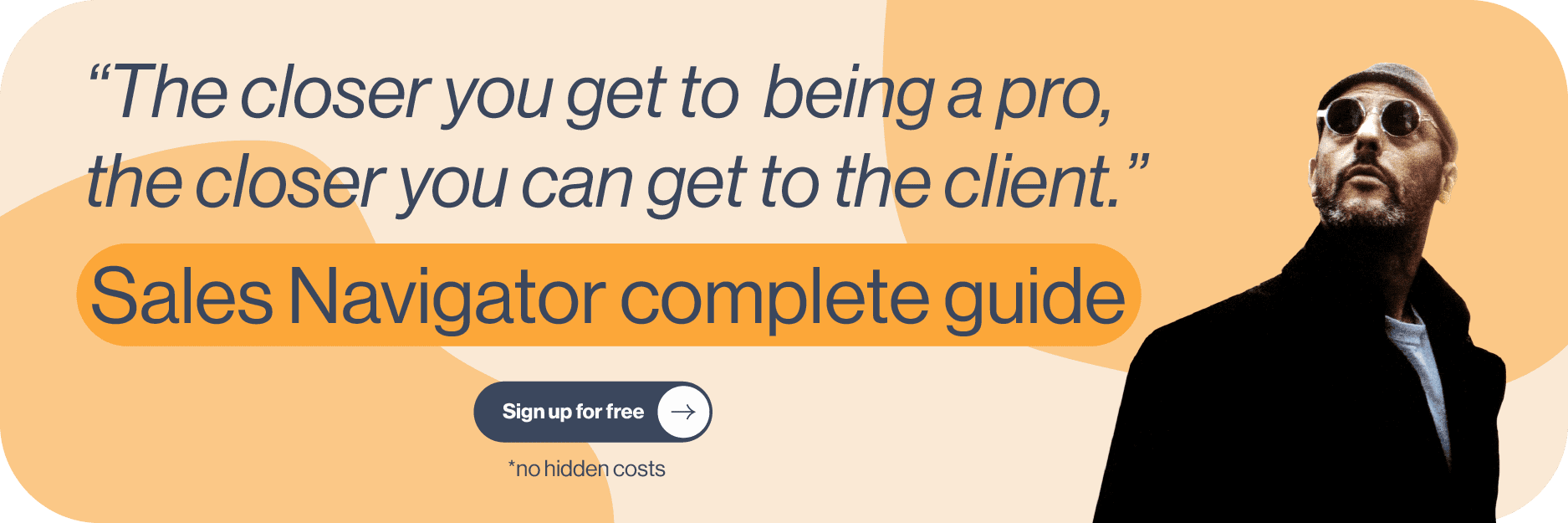Everybody knows that one of the best ways to get new customers is by contacting them using LinkedIn cold messages. Why? Well, sales teams prefer cold outreach via LinkedIn because this social media is the most effective B2B lead generation channel. Compared to cold calling and cold emails, that is.
However, when crafting a LinkedIn cold message, salespeople often get confused about how to approach their leads. Or, for example, their cold outreach message ends up showing no effect at all. We’ve been there too: testing countless variations, rewriting openers, and learning the hard way what gets replies (and what doesn’t).
That said, let’s make your LinkedIn outreach a winning game. In this article, we’ll focus on the best LinkedIn cold messages — the ones that delivered real results for us and our users — along with practical tips to help you write your own.
And as a bonus, we’ll also introduce you to a LinkedIn automation tool that makes it possible to send these high-performing messages and do it at scale.
What is a LinkedIn cold message?
A LinkedIn cold message is a way to reach out to someone on LinkedIn who hasn’t interacted with you before. These messages typically come in 3 forms:
- Connection request,
- Message (after the leads accept an invite),
- or InMail.
Each type has its own approach and best practices for getting a response.
For example, a well-crafted InMail can see an average reply rate of 18 to 25 percent, while cold emails usually sit around 3%.
Nevertheless, it’s important to note that one should not limit oneself to using LinkedIn only. In fact, the best way to acquire and close an outbound lead is by using both LinkedIn and email in your outreach strategy.
The benefits of LinkedIn cold messages
LinkedIn is the biggest social media platform for startups, company founders, CEOs, sales professionals, marketers, recruiters, B2B influencers, and more. With roughly 1 billion users, it’s been recognized as an ideal space to grow your professional network, generate leads, and build business-to-business partnerships.
That’s why marketers often use it for their outbound marketing efforts, such as publishing LinkedIn ads, promoting webinars, and gathering leads for their sales teams. Sales teams and recruiters, on the other hand, typically use LinkedIn for outbound activities such as prospecting and sending LinkedIn cold messages.
But why does cold messaging work so well here?
Firstly, LinkedIn offers more transparency than email. Your recipient can instantly see who you are, what your role is, and decide whether to engage.
Secondly, the larger your network grows, the more leads you can reach, and mutual connections also help increase your acceptance rate.
Lastly, with both connection requests and InMails at your disposal, you always have more than one shot at starting a conversation.
LinkedIn cold message templates & examples that work in 2025
When we first started optimizing our LinkedIn outreach, our reply rates hovered around 10%.
After A/B testing 1000s of messages, we discovered what actually works.
Now, we’re sharing our best-performing templates — the ones that helped us and our users:
- Increase our response rate
- Book more meetings with hard-to-reach prospects
- Shorten our sales cycle and boost conversion
And yes, every result you see here was tracked directly inside Skylead from our and our clients’ real campaigns.
Of course, Skylead does much more than track replies. You can plug these exact templates into it, personalize them at scale, and automate your entire outreach without sacrificing quality.
Want to skip the manual work and launch a high-performing outreach campaign in minutes? Try Skylead now for free!
We’ll go deeper into how it works in a moment. But now, let’s get into LinkedIn cold messages that helped us and our clients increase conversions by 3x!
General cold messaging tactics and templates
Leverage something you have in common
The first tip about cold LinkedIn messages is to find common ground with your leads. To clarify, this can be anything from liking the same post, influencer, or sport. Here is an example.
Cold LinkedIn connection message template:
Hi {{firstName}},
I noticed you liked {{authorName}}’s post on {{subjectOfThePost}}. I loved it as well. Especially the part about {{statementAndConclusion}}. I’d like to connect since I can see you know a lot about {{Topic}}.
Real-life example:
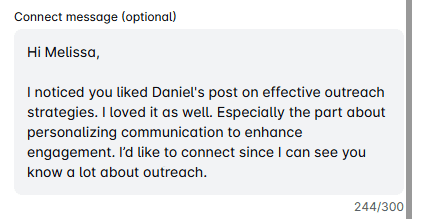
Or you can drop them an InMail such as this one:
Subject line: Post about {{Topic}}
InMail template:
Hi {{firstName}},
I noticed you reacted to {{authorName}}’s post on {{subjectOfThePost}}. I loved it as well — especially the part about {{statementAndConclusion}}.
Anyways, I noticed by looking at your profile that you’re familiar with {{Topic}}, so I wanted to see whether you are approaching {{KeyProblemYou’reSolving}} in {{currentCompany}}?
I would love to know more about this.
Best, {{Your Name}}
Response rate: 35%
Real-life example:
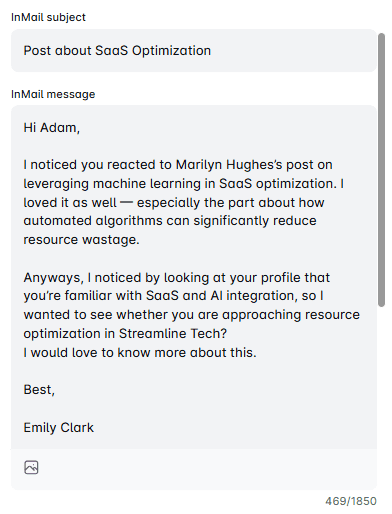
Mention a shared connection
People are more likely to accept a LinkedIn invite if it references a mutual connection. If you’d like to increase your chances, you can send an invite such as this one, which boosted our acceptance rate by 2x in just one campaign:
LinkedIn connection request template:
Hey {{firstName}},
I noticed that {{mutualConnectionName}} is part of your network too. We {{yourHistory}}. Anyways, I see you work as {{Position}} and like to chat. Maybe we can exchange some tips.
Real-life example:
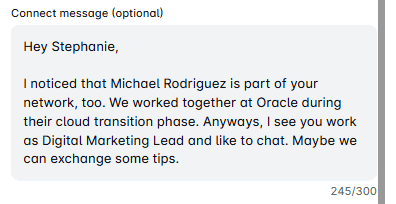
See if a mutual connection can introduce you
If, however, you prefer to get introduced to your lead by a mutual connection, you can send a direct message such as this one:
LinkedIn message template:
Hey {{firstName}},
I noticed that {{leadName}} is a part of your network. I’ve been following them for a while now, and I just wanted to chat about their experience as {{Position}}.
Would you mind if you introduced me to them? It’s always better to be introduced, rather than reaching out of the blue. It would mean the world to me.
Best, {{Your Name}}
Real-life example:
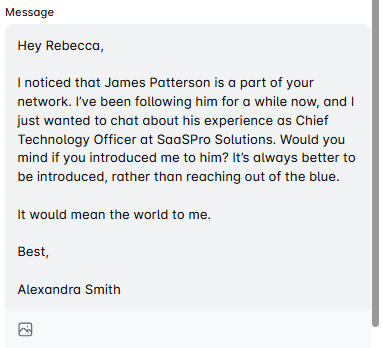
Stroke their ego
Everybody likes to receive a compliment about their work or an accomplishment. So, one way you can compliment your leads is to find the post you genuinely like and reference it in your cold LinkedIn message, as we have:
LinkedIn connection request template:
Hey {{firstName}},
I loved your post about {{Topic}}. What I loved the most was {{Statement}}.
Anyways, I wanted to connect and chat about how you as a {{Position}} handle {{painPoint}} in your daily work life.
Real-life example:
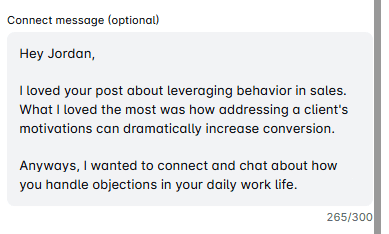
If they do not respond, you can always send an InMail such as this one:
Subject line: Loved your post about {{Topic}}
InMail template: Hey {{firstName}},
I tried sending an invite, but I guess it got lost somewhere along the way. I wanted to reach out and first say I loved the content you are posting, especially the one about {{Topic}}. What I loved the most was {{Statement}}.
Anyways, I just wanted to connect and chat about how you, as a {{Position}} handle {{painPoint}} in your daily work life, and I'd like a chance to present a solution that {{solutionToPainPoint}} to the table.
If what I offer sounds compelling to you, please let me know. However, if the timing is off, or this is not in the area of your interest at the moment, I'll be happy to enjoy your future posts on LinkedIn. 🙂
Warm regards, {{Your Name}}
Response rate: 30%
Real-life example:
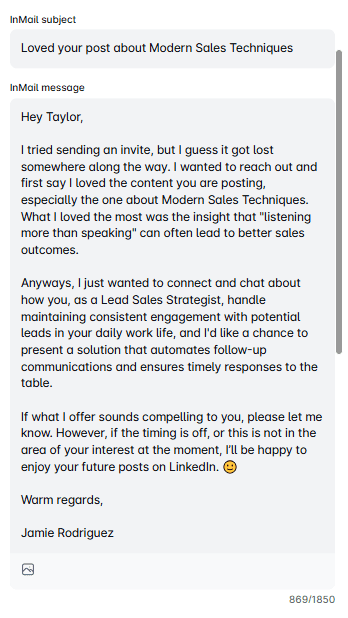
Give reason to reply
By posing a question in your cold LinkedIn outreach, you give your leads a chance to talk a bit about themselves, and you can learn a bit more about their work. So, drop a connection request such as this one:
Cold LinkedIn connection request template:
Hi {{firstName}},
I noticed you work as {{Position}}, so I wanted to reach out and chat about your position. I’m curious what {{Strategy}} has the best {{Result}} from your experience. 😀
Real-life example:
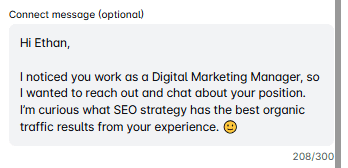
If they do not respond, you can send a cold InMail, such as this one:
Subject line: A quick question
InMail message template:
Hi {{firstName}},
I tried reaching out over a connection request, but it seems it got lost in the sea of requests you might be getting. Anyways, as a {{Position}}, I always like to expand my network and chat with people about their positions. So I came across your amazing profile, and I was curious, what {{Strategy}} has the best {{Result}} from your experience? 😀
Looking forward to hearing from you.
Warm regards, {{Your Name}}
Real-life example:
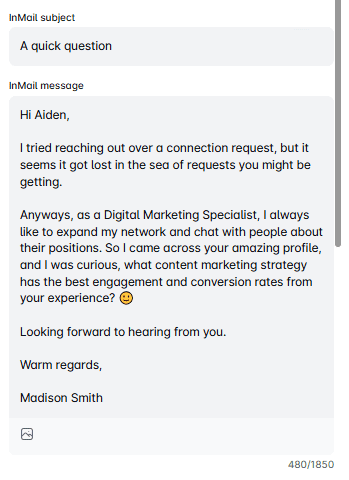
Leverage a group connection
Leveraging mutual LinkedIn groups is one of the best conversation-starters in cold outreach. Moreover, you can top it up with humor and create a charming first impression.
Here is a connection message template that does just that:
Cold LinkedIn connection request template:
Always trust a glue salesperson. They tend to stick to their word…
Just kidding, {{firstName}}. I saw that you are also part of the {{groupName}} group. Hope we can learn from each other!
Acceptance rate: 63%
Real-life example:
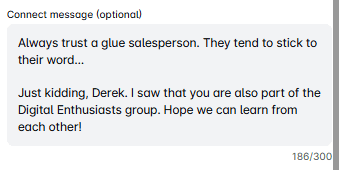
And if they accept a request and do not respond, your next LinkedIn message could sound like this:
LinkedIn message template:
Hi {{firstName}},
Thank you for connecting. I love chatting with other members of the group. Was curious, how are you solving {{painPoint}} at {{currentCompany}}?
Response rate: 37%
Real-life example:
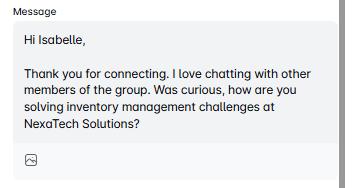
However, if they don't reply to a connection request, you can send the following InMail:
Subject line: Saw you are also a member of {{groupName}}
InMail template: Hello {{firstName}},
I recently tried connecting on CompanyTinder with you... I mean on LinkedIn. Just joking {{firstName}}, I visited your LinkedIn and saw that we are both a part of the same LinkedIn group.
Anyways, I couldn't help but notice you are {{occupation}} at {{currentCompany}}. I was curious, how are you solving {{painPoint}}?
If you still haven't found the solution, I would love to chat with you this week over a call about how {{nameOfYourCompany}} could help you. Either way, hope Q2 is going great for you!
Best! {{Your name}}
Response rate: 27%
Real-life example:
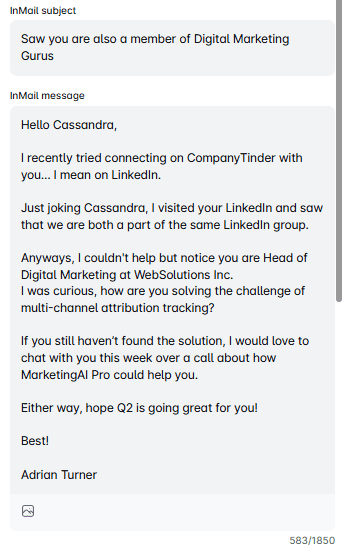
Then you can proceed by asking them what their biggest challenges are, offering tailored solutions, and presenting your product or service.
LinkedIn cold message for B2B lead generation
If they viewed your profile
Sometimes, your Buyer Persona will view your profile. In that case, you can send them a high-performing connection request such as this one:
LinkedIn connection request template:
Hi {{firstName}},
I saw you viewed my profile on LinkedIn. Let's connect and chat. 😊
Perhaps we discover we can collaborate.
Acceptance rate: 63%
Real-life example:
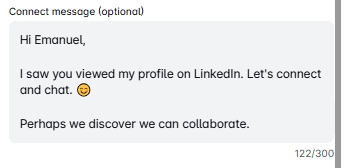
If they accept your connection request but do not respond, try taking this follow-up message for a spin:
LinkedIn message template:
Hey {{firstName}},
Thanks for connecting. Perhaps, I was just in the pool of the {{typeOfProduct}} you are researching. 😊 However, I do have extensive knowledge of {{painPointTopic}}. Let me know if you are looking for something specific.
Response rate: 29%
Real-life example:
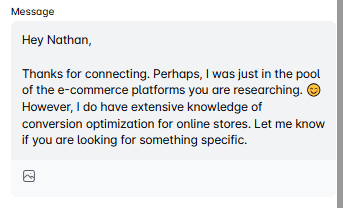
Mention relevant company news
You can also reference recent company news, achievements, or celebrations to catch your lead's attention. In addition, since the company experienced a change, you can present your product/service as a new and refreshing solution on the market. In that case, help yourself with this piece:
LinkedIn connection message:
Hey {{firstName}},
Congrats on {{companyNewsTopic}}. I've been following you for a while now, and this is truly great to hear! I wanted to reach out and chat about an idea that I think your team can benefit from. Let's connect on this.
Real-life example:
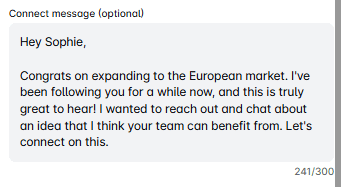
However, if they don’t accept a connection request, send them this InMail:
Subject line: {{ProductOrServiceType}} that actually {{benefit}}! 🙂
InMail message template: Hi {{firstName}},
Congrats on {{companyNewsTopic}}. I’ve been following your company for a while now and I think this is a huge deal! Anyways, It would be silly of me to think you’re not using an {{productOrServiceType}} already, but it’s a no-brainer to present something new on the market that actually helps {{Position}} reach {{Result}} specifically. {{shortDescirptionAboutYourProduct/ServiceWithBenefits}}
Let me know if this sounds interesting to you.
Best, {{Your Name}}
Response rate: 20%
Real-life example:
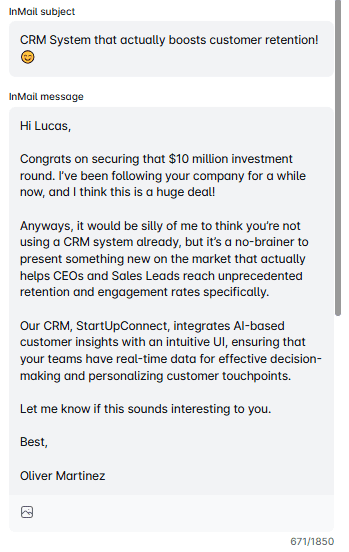
Pitch your product
Some sales professionals prefer to lead with a product or service pitch right from the first touchpoint.
If that’s your style, these outreach templates can help you do it effectively, with sequences that have driven up to a 67% acceptance rate and 39% response rate.
LinkedIn connection request template:
Hi {{firstName}},
Your profile really caught my attention while I was looking for {{TheTypeofCompanyYouTargeted}} companies. Let’s connect!
Real-life example:
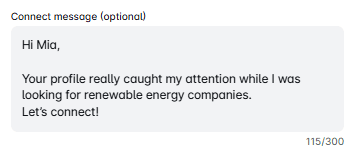
If they accept a connection request, then your following message can sound something like this:
LinkedIn message template:
Hey {{firstName}},
Thanks for connecting! I am looking for companies that are seeking to improve their {{keyProblemYouAreSolving}}
Did you know that you can achieve {{resultsYourProductProvides}}? I believe {{yourProductOrService}} will be an excellent fit for {{currentCompany}} because {{howYourProductOrServiceHelpsYourClients}}. If this sounds interesting, let’s have a chat! How’s next week?
Real-life example:
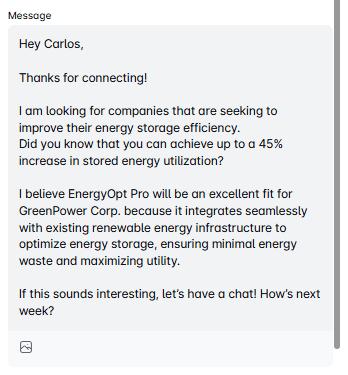
However, if they do not accept a connection request, send an InMail with the following call to action:
Subject line: Quick question about {{currentCompany}}
InMail message template:
Hi {{firstName}},
I am looking for companies seeking to improve their {{keyProblemYouAreSolving}}, and your profile caught my attention.
Did you know that you can achieve {{resultsYourProductProvides}}? I believe {{YourProductOrService}} will be an excellent fit for {{currentCompany}} because {{HowYourProductOrServiceHelpsYourClients}}.
If you agree, let’s connect and have a chat! What do you think about next week?
Best, {{Your Name}}
Real-life example:
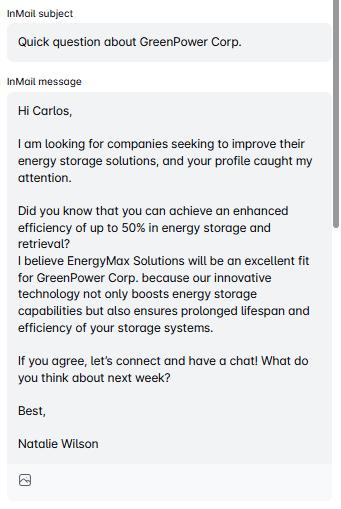
Use past client wins
If you want to pitch first, you can also use some case studies of similar companies. This way, you can demonstrate bullet-proof case studies of your best clients, similar to your leads in question.
The following template works especially well when someone hasn’t accepted your LinkedIn invite, and has helped our users generate replies even from cold leads.
Subject line: Swift question - not to shake it off 🙂
InMail message template:
Hi {{firstName}},
I tried reaching you through LinkedIn, but I guess your account is also overwhelmed with connection requests, ha?
Anyway, the reason I decided to contact you is that I noticed that you work as a {{Position}} at {{currentCompany}}.
We actually were able to help {{RelevantCompany/CaseStudy}} with {{KeyProblemYou’reSolving}}, so I was wondering how you are approaching it at your company.
Worth a convo?
Kind regards, {{Your name}}
Response rate: 35%
Real-life example:
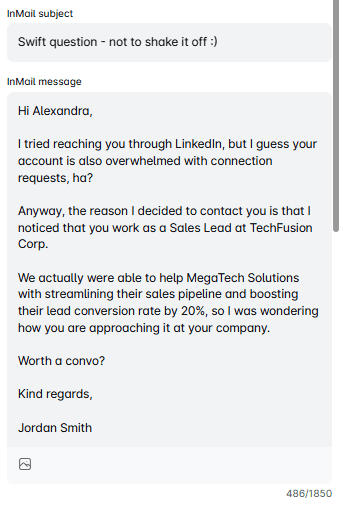
Refer to an event or webinar where you both participated
One of the best LinkedIn cold messages that point out common ground is the one that references a webinar or an event you both attended. Here is how your connection message can sound like:
LinkedIn connection request template:
Hi {{firstName}},
I see you are interested in attending the same webinar as I am. I am talking about {{[nameOfTheWebinar}}. I’d like to connect with you and discuss the event topic.
Acceptance: 75%
Real-life example:
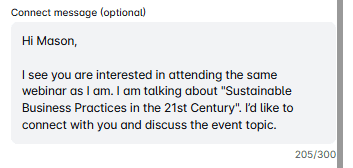
After your leads accept a connection request, you can continue the conversation by using the following LinkedIn cold message template and pitch accordingly later on:
LinkedIn message template:
Thanks for connecting with me, {{firstName}}! So, what are you looking to get from this event?
However, if the lead doesn’t respond to your connection request, you can send an InMail that goes like this:
Subject line: Let’s chat about the upcoming {{[NameOfTheEvent}}
InMail message template:
Hi {{firstName}},
I hope you don’t mind reaching out directly to your inbox.
I see you are interested in attending the same event as I am - {{[NameOfTheEvent}}.
Maybe you just overlooked the invitation without realizing it, but if that’s not the case, I’d like to connect with you and pick your brain about this interesting upcoming event.
Best regards, {{[Your name}}
Response rate: 47%
Real-life example:
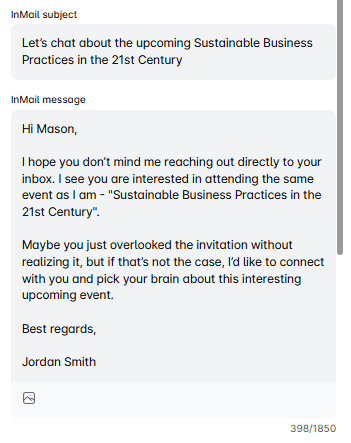
Investor outreach
If you are a startup looking for an investor, your cold LinkedIn message should have a strong CTA. In addition, investors are decision-makers who don’t like to spend time getting the relevant data from you. Instead, you should present it yourself and show the prognosis of ROI right away.
That said, you can try out this InMail message example that we pre-tested:
Subject line: Invest in our company and get {{Percentage}} ROI in the first year
InMail message template:
Hi {{firstName}},
I am the founder of {{companyName}}, a company determined to help {{targetAudience}} achieve {{Results}}.
I’ve been following you for a while and noticed you’ve invested in a type of company such as ours. I’ve created a detailed report and estimated that you could earn {{amountOfMoney}} within the first year, with an investment of {{amountOfMoney}} that will cover our 6-month period.
If this interests you, I would love to show you a detailed report and all the calculations over a call.
Best regards, {{Your name}}
Real-life example:
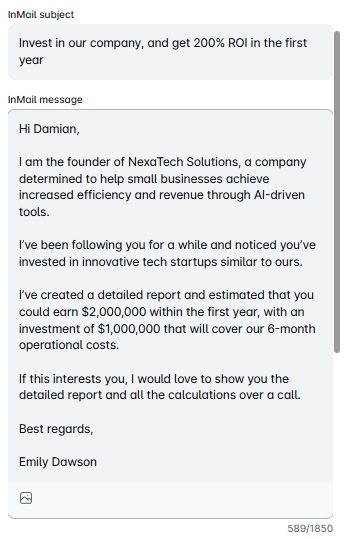
LinkedIn cold message templates for recruiters
If you work as a recruiter in a startup, this would be a perfect cold InMail message example for you.
Subject line: Are you our next {{companyName}} star?
InMail message template:
Hi {{firstName}},
We are {{companyName}}, a team of young people who {{whatYourCompanyDoes}}.
Currently, we are looking for an ambitious person, preferably with the {{Position}} experience and aspirations to grow and develop their career path.
Our team is very successful and fast-developing, and we have multiple sectors where you can further learn and develop your career path. We strive to encourage people who come to our company to contribute their suggestions and propositions to improve their sector and, thus, the company as a whole.
Would you be interested in working in such a young and dynamic team? 🙂
Best, {{Your name}}
Response rate: 65%
Real-life example:
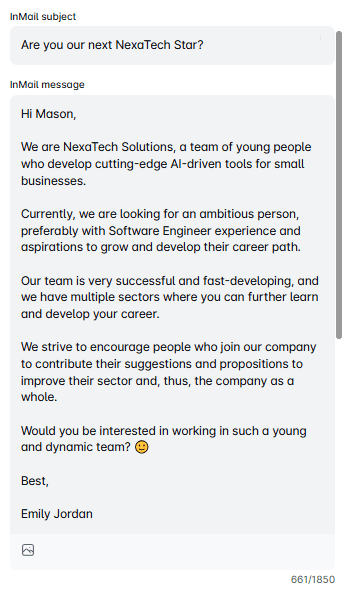
And here is a LinkedIn cold message template for a connection request:
LinkedIn connection request template:
Hey {{firstName}},
I’m HR at {{companyName}}, a team of young people who {{whatYourCompanyDoes}}. We are searching for an ambitious person to fill in our {{Position}} vacancy and aspirations to grow and develop their career.
Real-life example:
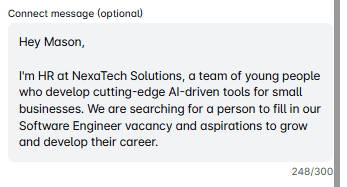
LinkedIn message examples for job seekers
Messaging a recruiter directly
Our Head of Operations, Nikola, says that if you see a hiring manager publishing a job post on LinkedIn, in most cases, it is good to send a connection request to HR. To clarify, this will show that you are serious and proactive and demonstrate initiative.
That said, here is a template he approved:
Cold LinkedIn connection request template:
Hi {{firstName}},
I’ve noticed you published {{Position}} job post. I’ve been following {{companyName}}, and it’s my dream workplace. So I thought it would be better to send you a message, connect directly, and show you my passion for this role.
Real-life example:
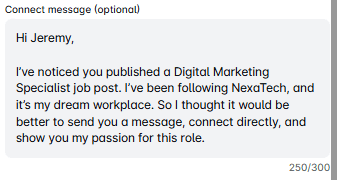
Cold messaging an employee
This is one of the ways to figure out what the company culture is like and establish a connection with an employee within your desired company.
LinkedIn connection request:
Hey {{firstName}},
I noticed you work at {{currentCompany}}. How has your experience been in the {{Department}} since you started? I'm searching for job opportunities, and {{currentCompany}} is my #1. I’d like to connect to chat about it.
Real-life example:
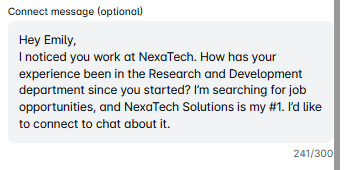
And if they respond, you can send a message such as this one to get their referral:
LinkedIn message template:
Thanks for your message, {{firstName}}.
Really appreciate it. On a side note, are you aware that the {{Position}} job listed on {{websiteName}} falls under your department? If not, can you point me to the person usually responsible for recruiting for such roles? I'm considering applying and would like to ensure my application doesn't disappear in the digital chaos.
Real-life example:
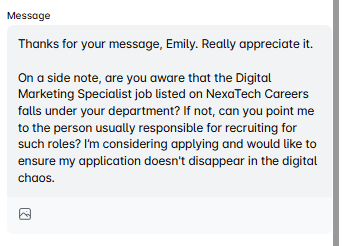
Request an informal interview
Sometimes, in your target company, there are no job vacancies that match your expertise. However, that doesn't stop you from messaging their hiring manager and kindly asking for an informal interview. You can test out this template.
LinkedIn connection request template:
Hi {{firstName}},
I've been following {{currentCompany}} for a while now, and I adore your company culture and achievements. Even though you don't have roles matching my skills, I'd still like to connect and schedule an informal call and present myself in person.
Real-life example:
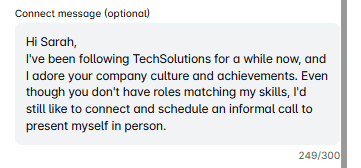
How to cold message on LinkedIn and get replies
Before sending your first message or LinkedIn connection request to your potential customers, you need to get your outreach strategy straight. This way, you can prepare the ground to generate higher-qualified leads faster. Here are our top tips for doing so.
Optimize your profile
The first rule to get the best out of your LinkedIn cold message is to optimize your LinkedIn profile. People are more prone to accept a connection request from someone whose entire profile is set up. In other words, you have your:
- Profile and LinkedIn cover image,
- LinkedIn headline,
- Company name,
- LinkedIn summary,
- Education section,
- And LinkedIn URL.
For example, if you are a salesperson, potential customers can check out your LinkedIn profile and see your product/service and what you are all about before accepting a connection request.
On the other hand, if you are a hiring manager, candidates can take a look at your company name and website. Otherwise, if your profile is not entirely set up, they would mistake you for a fraud. Think of it as the first barrier of defense to prove the validity of your outreach strategy.
Target the right people - ICP & buyer persona
Both cold emails and LinkedIn connection requests can go down the drain if they are aimed at the wrong target audience. In other words, you need to research and create your Ideal Customer Profile and Buyer Persona. Find out what your ideal company headcount, revenue, or location is. Buyer Persona-wise, figure out what position uses your product/service, whether they are business decision makers or not, and their pain points, so you can tailor your sales pitch.
If you are a hiring manager, a Persona for each position will be enough. Just make sure to target the correct position, industry, years of experience, and other factors relevant to your job vacancy.
Lastly, the best way to create these two documents is to analyze your current ideal customers. In other words, find the ones with:
- Highest retention rate and LTV;
- Shortest buying cycle;
- And who would be a referral for your product someplace else.
N.B. Remember that every piece of information in your ICP or Buyer Persona documents needs to be actionable. In other words, create a document with the information you can use for your LinkedIn prospecting or messaging purposes.
Find your leads using LinkedIn filters
Our next piece of advice is to learn how to find your ideal leads. If you are a sales executive, get to the bottom of the ins and outs of the LinkedIn Sales Navigator filters and prospecting hacks. Or find leads outside LinkedIn and trace them back to this social media. And if you are a recruiter, research Recruiter search filters.
Remember, the goal is to be as narrow as possible so you can find your ideal leads with a high-quality status and shorter close cycles.
Personalize your cold message
Personalization wins the conversation. Simple as that. The more personalized outreach is, the more people will respond to your LinkedIn connection request, InMail, or even a phone call.
That said, fill your cold outreach messages with personalized points to get their attention, such as:
- First and last name,
- Current company,
- Position,
- Mutual connection,
- Case studies or posts they shared,
- Webinar they attended,
- Influencers they follow,
- Or the LinkedIn group they joined.
These are just a few examples of how you can personalize your connection messages or cold emails in general. However, when crafting your first message and even your second, you should always have in mind that you need to offer value and make it all about your prospects. In other words, help yourself with the deeper personalization points such as:
- What are the new customers' main goals,
- What are their pain points,
- Post they publish,
- Content they created,
- What type of content do they consume?
These points will help you get a higher response rate. If you don’t want to present your sales pitch or mention pain points right away, you can always send them an interesting article to spark their imagination about your service.
Don’t forget to end your direct messages with a clear call to action. It can be anything from reading a blog, accepting a LinkedIn connection request, or scheduling an online meeting or a phone call. Nonetheless, try to keep only one call to action per message.
Now, if you really want your message to stand out, remember that a picture is worth a thousand words. That’s why many of our users take personalization a step further by adding personalized images or GIFs to their outreach.
With Skylead, you can insert visuals personalized with your and your lead’s profile photo, company logo, and text with variables.
Want to see our image and GIF personalization in action? Here’s a video that shows you exactly how it works!
And believe it or not, we managed to amp up our response rate to 76% using it!
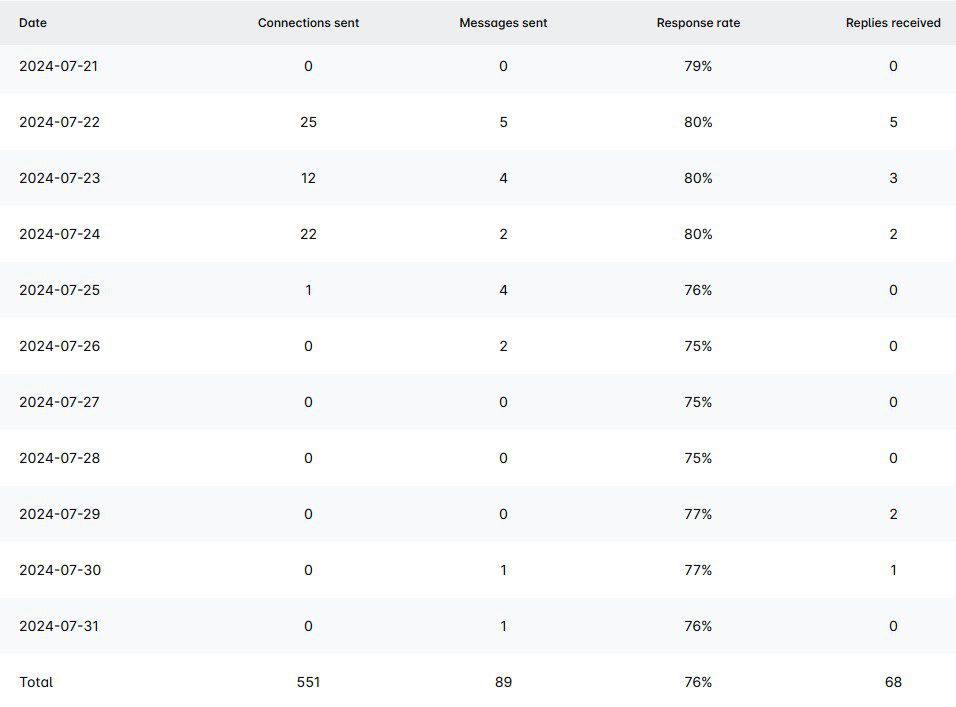
Choose to use it yourself, and sooner than later, you may be in a similar situation to our client, Michael Gonzalez, who said:
“We are currently generating 320 bookings, but that's not a limit.’’
Send your cold message, including InMail
LinkedIn users have not one, but three formats they can use to connect with someone on LinkedIn - connection requests, direct message after invite acceptance, and InMails. These two formats are the main ones for the initial contact with potential customers and candidates.
To clarify, InMails are like cold emails but on LinkedIn. You can write your own subject line and have 8K characters available as opposed to a connection request (300 characters). Moreover, you can send InMails to people outside your professional network only if you have a paid LinkedIn subscription.
Types of InMails & benefits
You can send paid and free InMails. The number of paid InMails you can send depends on your LinkedIn subscription. For example, if you paid for LinkedIn Sales Navigator, you have 50 monthly credits. On the other hand, if you paid for Recruiter Lite, you get 30 InMail credits and 100-150 credits for a Recruiter subscription. Lastly, LinkedIn Premium offers only 15 InMail credits per month.
Contrary to paid InMails, you can send up to 800 free ones, but only to those LinkedIn users who have set their profile to the Open profile status.
That said, make sure to leverage InMail format as a part of your outreach strategy because of the 3 reasons:
- You can contact people who are your 2nd and 3rd-degree connections without sending a connection request;
- You have more characters available than in connection requests, so you can focus on pain points and a better CTA;
- It's a great alternative if your connection request is pending and you'd like to send a direct message straight to the decision-maker's inbox.
Lastly, you can use the LinkedIn automation tool and cold email software, Skylead, to automate sending InMails. Skylead is unique on the market because it allows our users to send both paid and free InMails.
Follow up
Salespeople often perceive follow-up messages as pushy and a thing that can drive their leads away. Therefore, 70% of them do not send any follow-ups. However, a lesser-known fact is that if you send a follow-up, you automatically increase the chance of hearing back from your lead by 25%.
However, if you know how to write a follow-up email after no response or a LinkedIn message, you can increase these chances even more.
That said, our advice is to research how to write the best follow-ups out there and never miss sending them.
Here is, according to our experience, the best advice for crafting follow-ups. Depending on the format, a follow-up should be short and focus on at least 2 of the following:
- Catchy subject line;
- Context;
- Value (case studies, solution to pain points);
- CTA.
Thus, here is one follow-up message that is led by the above-mentioned points.
Subject line: Any thoughts?
Follow-up InMail template:
Hey {{firstName}},
Just checking in to see if you got any thoughts on exploring what {{nameOfYourCompany}} could do for {{theirCompany}}?
We worked with Companies similar to yours, such as:
- {{Company1}}
- {{Company2}}
- {{Company3}}
If you give me a chance for a call to show you, just this once, how other {{ProspectsPosition}} have used this solution to {{smallBenefit}}, I promise we can part ways if you are not impressed. Just let me know when is the best time for you. Anyway, love what you are doing with {{theirCompany}}.
Best, {{Your name}}
Response rate: 27%
Real-life example:
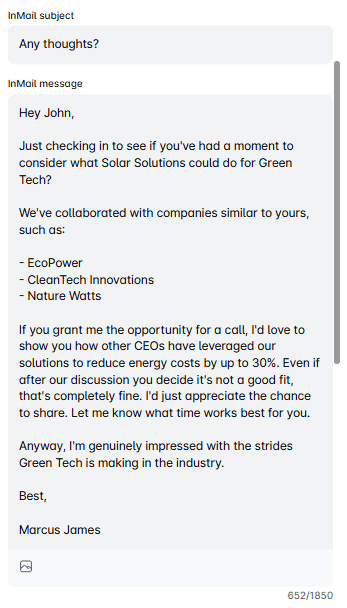
Scale through automation
By now, you’ve seen what works.
But what if you could automate every single step in your outreach flows, from connection requests and LinkedIn cold messages, to InMails and emails, all while tracking responses in real time?
That’s exactly what Skylead does!
This LinkedIn automation and cold email software helps startups and agencies, sales teams, recruiters, marketers, and alike automate lead generation tasks, such as sending:
- cold emails,
- connection requests,
- InMails,
- and LinkedIn direct messages,
depending on their leads' behavior.
To show you just how Skylead follows leads' behavior, let's go through creating one of the outreach sequences using it!
LinkedIn cold outreach campaign
First, choose your lead source, a.k.a. where Skylead will pull the leads from, and insert the source.
For the sake of this blog, we will select the LinkedIn search results and paste the URL to it.
Don't forget to choose the type of connection if available.
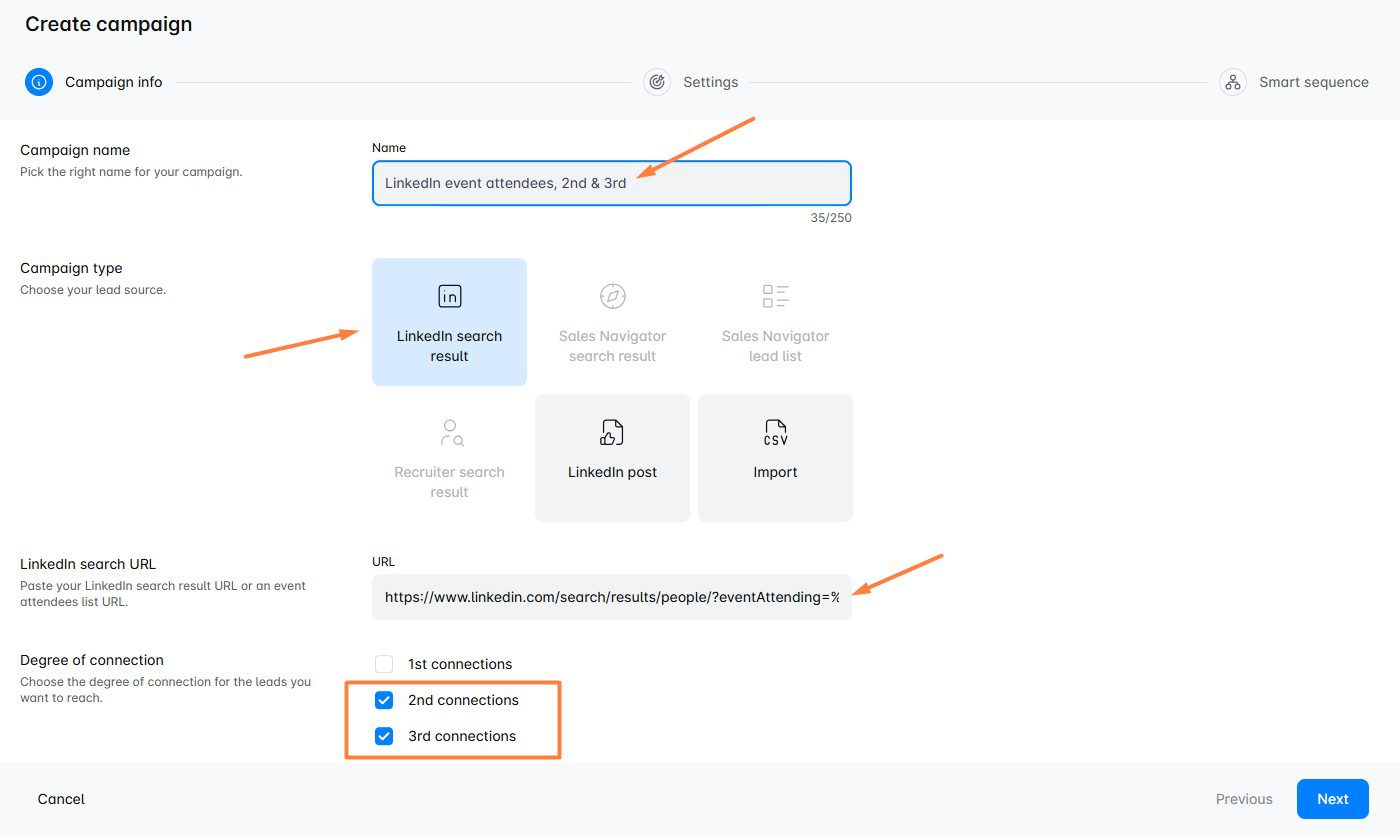
Secondly, set up your campaign settings, including your email, LinkedIn, and global settings.
As part of email settings, you can add unlimited mailboxes (email accounts) to send tens of thousands of emails a month at no extra cost.
You can also create a campaign schedule and set up email tracking in terms of clicks and open emails.
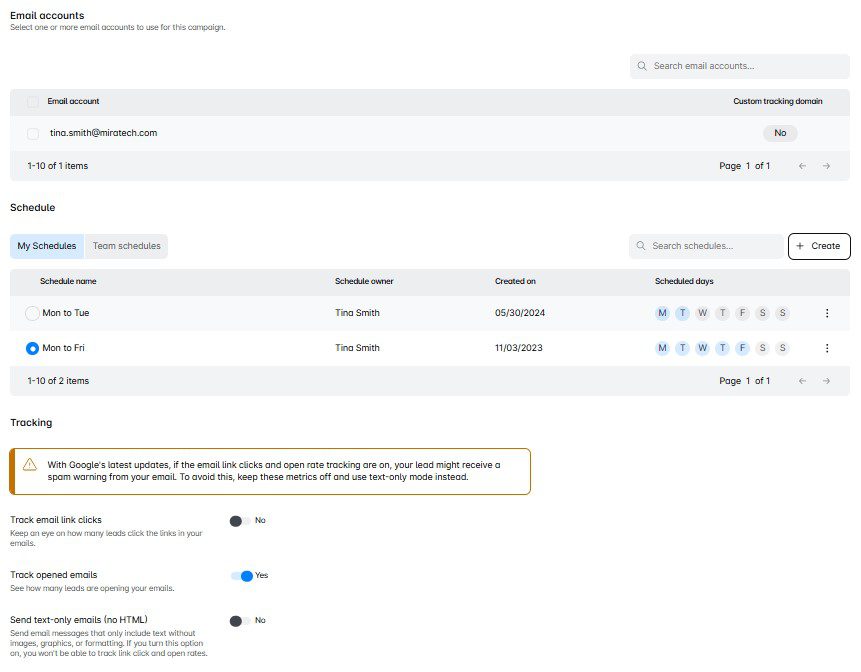
LinkedIn settings let you decide if you’d like to reach out only to those with Premium LinkedIn profiles or Open profiles. You can also set Skylead to collect publicly available information, as well as refresh search and automatically remove leads who haven’t accepted your invites.
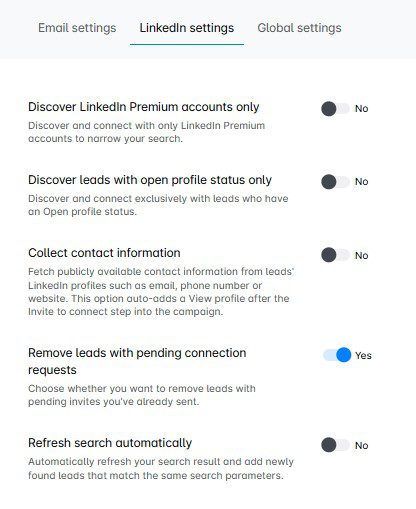
In terms of global campaign settings, you’ve got the option to:
- Include leads that replied to your messages
- Include leads found in other campaigns
- Discover new leads only
This is also where you decide on your campaign start date and time.
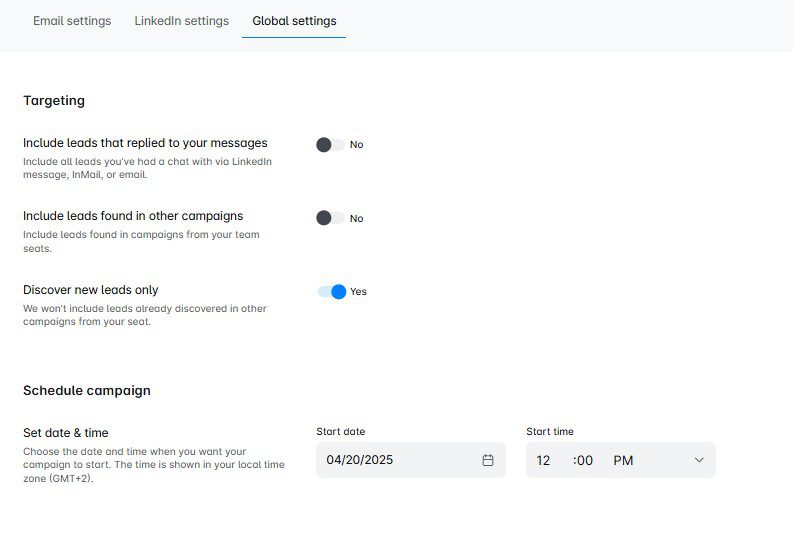
Now, this is where the fun begins. Meet our Smart sequence, a groundbreaking algorithm that allows you to use multichannel outreach and personalize messages at scale.
The secret to why the Smart sequences are so powerful lies in the If/else conditions that you can set after each action and let Skylead follow your lead’s behavior and perform actions accordingly.
Here’s what our client, Daniel H., had to say about them:
‘’I like Smart Sequences and the fact that you can combine everything in one funnel…If/else conditions are the most beneficial.’’
Now, to create a Smart sequence, drag and drop actions and conditions, and connect them.
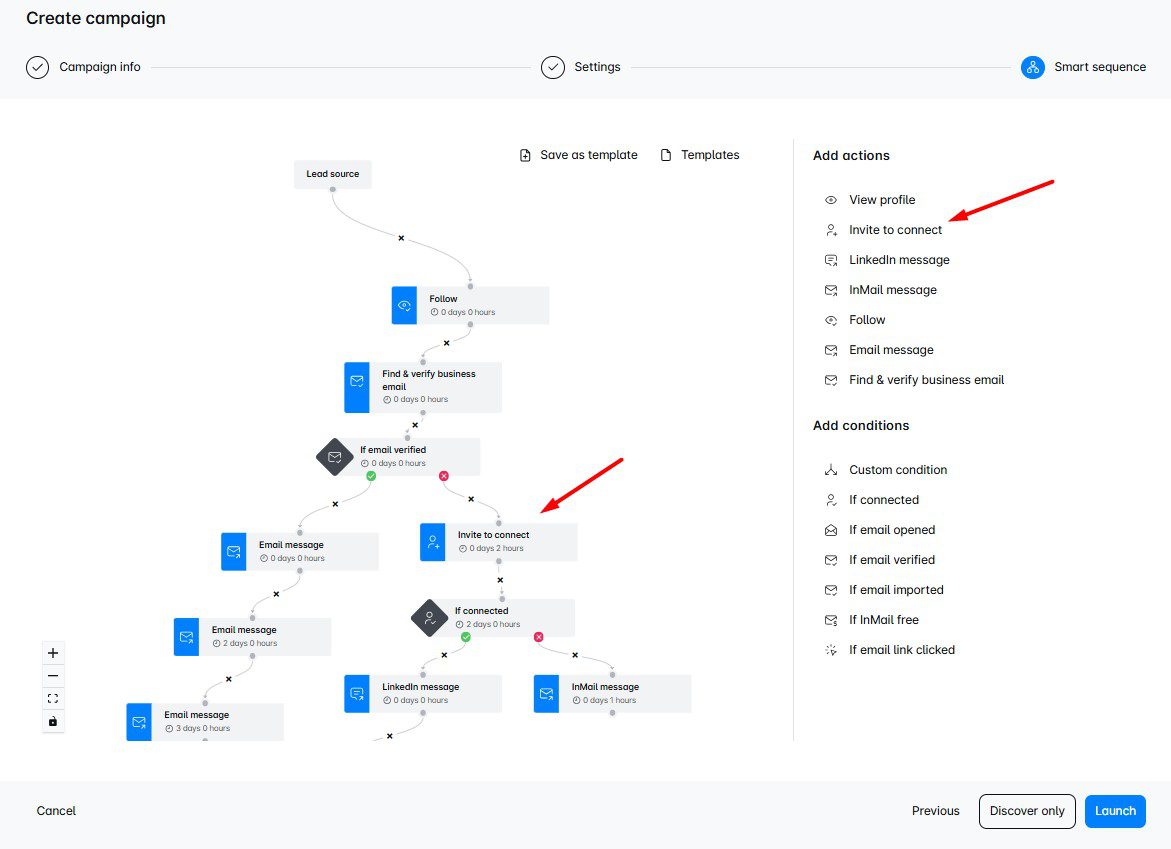
Once you do, write down personalized messages using variables such as first name, company name, and so on.
For example, here is how your LinkedIn cold message, a.k.a. connection request, can look like:
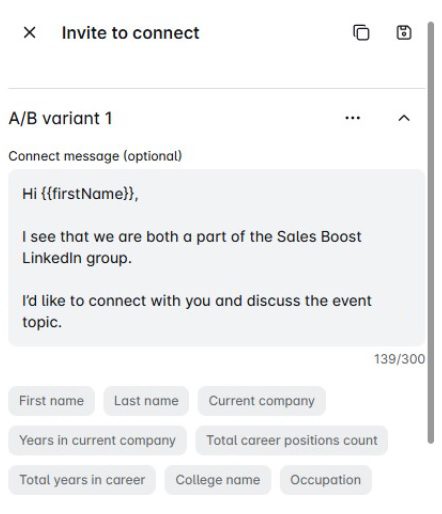
Keep in mind that if you want to personalize your messaging even more, you can always create a CSV file with custom variables and upload it as the lead source.
Here’s a video that explains just how you can do it:
Once a lead responds to your message, the sequence will stop for that lead, and you can see all the messages from all the platforms collected and available in our Smart Inbox. This way, you can continue the conversation without navigating between the platforms. What’s more, you can even label your leads with tags to calculate conversions and ROI.
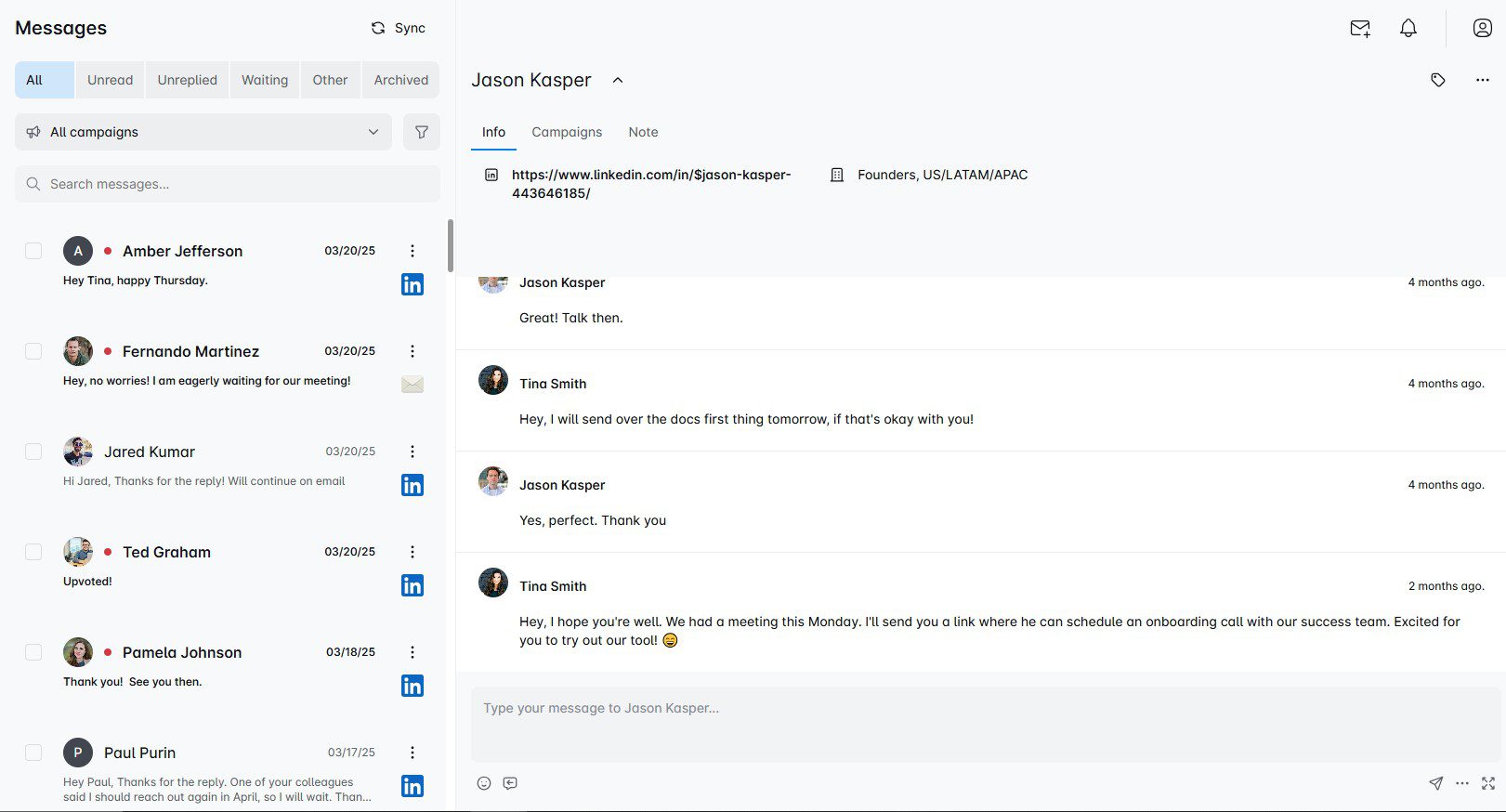
And that is the magic of Skylead. 😊
Frequently asked questions
1. How do these cold message strategies vary in effectiveness across different regions or cultures?
Cold message strategies' effectiveness can vary significantly across different regions or cultures due to varying communication norms and expectations. Tailoring your approach to reflect an understanding of cultural nuances and preferences in communication can greatly enhance receptivity and engagement.
2. What are the long-term follow-up strategies if the initial cold messages receive positive responses?
Long-term follow-up strategies should focus on building a genuine relationship with the recipient. This involves regularly sharing relevant content, updates, and opportunities that add value, maintaining a balance between staying in touch and respecting the recipient's space and interest level.
3. Are there any case studies or success stories of businesses that have significantly benefited from using these specific LinkedIn cold message templates?
Yes. We have a vast library of outreach templates that use these messages, and by examining each type of outreach sequence, you can see other results in addition to the response rate we've stated here.
4. Is it better to cold email or cold message on LinkedIn?
Cold emails have an average of 3% reply rate, while InMail’s is 18-25%. So, cold messages on LinkedIn are better. But it also depends on your target audience and their preferred channel. So, to maximize getting in touch with every lead possible, you should reach out using both channels.
5. What is a good first message on LinkedIn?
“Hey {{firstName}}, I loved your post about {{Topic}}, so I wanted to connect and chat.” Or you can use a humorous approach with personalization: “What’s a marketer’s favorite drink? Brand-y. Just kidding, {{firstName}}, saw that you are also part of the {{GroupName}} group. Hope we can learn from each other!”
Ready for your best cold outreach yet?
We’ve tested thousands of LinkedIn cold messages — and these were the exact ones that brought us (and our users) real replies, booked meetings, and signed deals.
Now it’s your turn.
Skip the guesswork. Skip the manual work. Plug these templates into Skylead, automate your LinkedIn lead generation, and start getting results faster.
Start your 7-day free trial today and see how much easier cold outreach can be!
Today's B2B buyers are a whole different breed. In fact, rather than going straight to the sales rep to learn more about the product or service they are interested in as they did before, 97% of them are more likely to dive into independent research first. But why the sudden change in behavior? It’s because AI-powered tools and digital content were never as accessible as they are now. And while the rise of technology has simplified the buyer’s journey, it’s also caused certain sales tactics to become less effective. Heck, some have even completely died off or were ineffective to begin with.
That said, we sat down with our Head of sales, Andrea, a veteran with 11+ years of experience, to discuss what the future of sales holds. While at it, she reassured us there’s more work to be done than ever before. Provided the right sales tactics are used, that is.
So, we picked her brain on the topic to bring you:
- 24 sales tactics that work in 2025,
- 12 approaches that are best left behind.
We’ll dive into them all in a second. But first, let’s explain what sales tactics really are and what constitutes ethical vs. unethical selling.
What are sales tactics?
Sales tactics are specific techniques that salespeople use to engage prospects, overcome objections, and ultimately close deals. They translate a company’s broader sales strategy into tangible, repeatable actions that drive results. In essence, while a sales strategy outlines your overall plan to reach targets, sales tactics are the day-to-day actions that make that plan work.
Ethical vs. unethical sales tactics
Sales tactics generally fall into 2 main categories:
- Ethical sales tactics
- Unethical sales tactics
Ethical tactics imply putting your prospect first by listening, being transparent, and genuinely solving their problems. This means focusing on what’s in it for them instead of simply chasing a quick win. When you sell ethically, you build trust, forge lasting relationships, and let your product’s true value shine without the need for gimmicks.
Unethical tactics, a.k.a. high-pressure, aggressive, or manipulative tactics, lean on deception and manipulation. They might help you close a deal today, but they often leave a sour taste. They rely on exaggeration, bluffs, and sometimes even bad-mouthing competitors to force a decision. In the long run, such tactics erode customer trust and damage your reputation.
24 best B2B sales tactics you need to use in 2025
Now that you know the difference between ethical and unethical selling, it’s time to talk about the best sales tactics of the year 2025.
So, without further ado, here are 24 of our top picks that are all about selling the right, a.k.a. ethical way!
1. Gap selling
When we asked our Head of Sales, Andrea, to talk about her favorite sales tactic, she mentioned ''Gap selling'' with no hesitation whatsoever.
Gap selling is a problem-centric B2B sales approach focused on identifying the gap between a prospect’s current state and their desired future state.
It was coined by a coach that goes by the name Keenan, who noted that this technique enables prospects to ‘’see its positive impact on their lives” by directly addressing their specific pain points. That’s because, instead of pushing products or services, gap selling prompts you to uncover the buyer’s challenges and goals and then position your product/service as the bridge that fills that gap.
In practice, applying gap selling can involve mapping out the prospects’ challenges and goals side-by-side, then highlighting the exact “gap” your solution will close. For example, this can be reducing a manual process from 5 hours to 5 minutes or increasing ROI by a certain percentage.
As you make this gap and its resolution crystal clear, you create urgency and excitement, which makes the prospect want to close that gap with your help. And because you’ve demonstrated a thorough grasp of their situation, you’ve built credibility and trust, making it an ethical yet high-converting sales tactic.
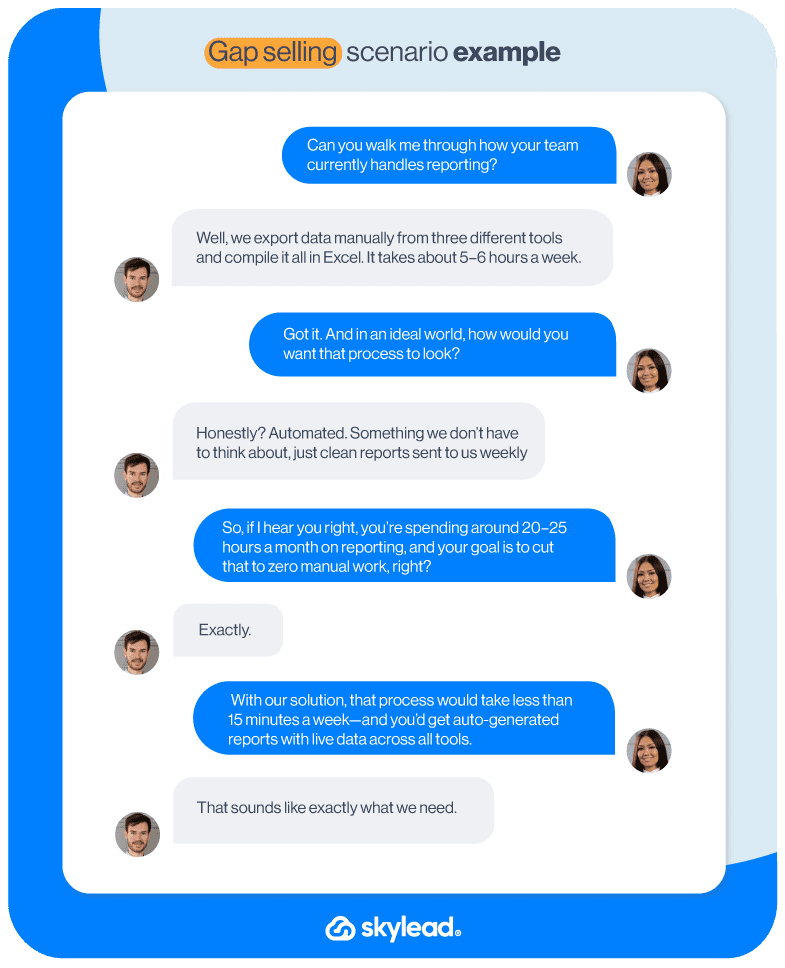
2. Flip the Script
This is a modern sales tactic popularized by Oren Klaff’s book ‘’Flip the Script,’’ which centers on reversing the typical sales dynamic. The idea is to get the buyer to feel that adopting your solution was their idea rather than feeling pressured by a salesperson.
Practically, this means moving away from forceful persuasion and instead leading the conversation in a way that the prospect convinces themselves of the value you offer.
The point is to establish yourself as an equal and a trusted advisor to them by aligning with their perspective and demonstrating insight into their business instead of pitching.
To paint a better picture, let’s say you were in a sales meeting.
Instead of delivering a hard pitch, you share a case study of a common industry challenge and how it was solved. You ask smart questions about how the prospect sees that challenge in their world.
As they engage, you acknowledge their expertise and perspective (status alignment) and add your own opinions sparingly to fill knowledge gaps. The prospect then begins to draw the conclusion that your solution addresses their needs.
By the end, they might say something like, “It sounds like if we did X (your solution), we could achieve Y outcome, right?” – essentially voicing what you wanted to convey. At that point, they feel in control and confident about the decision, which is incredibly effective for conversion.
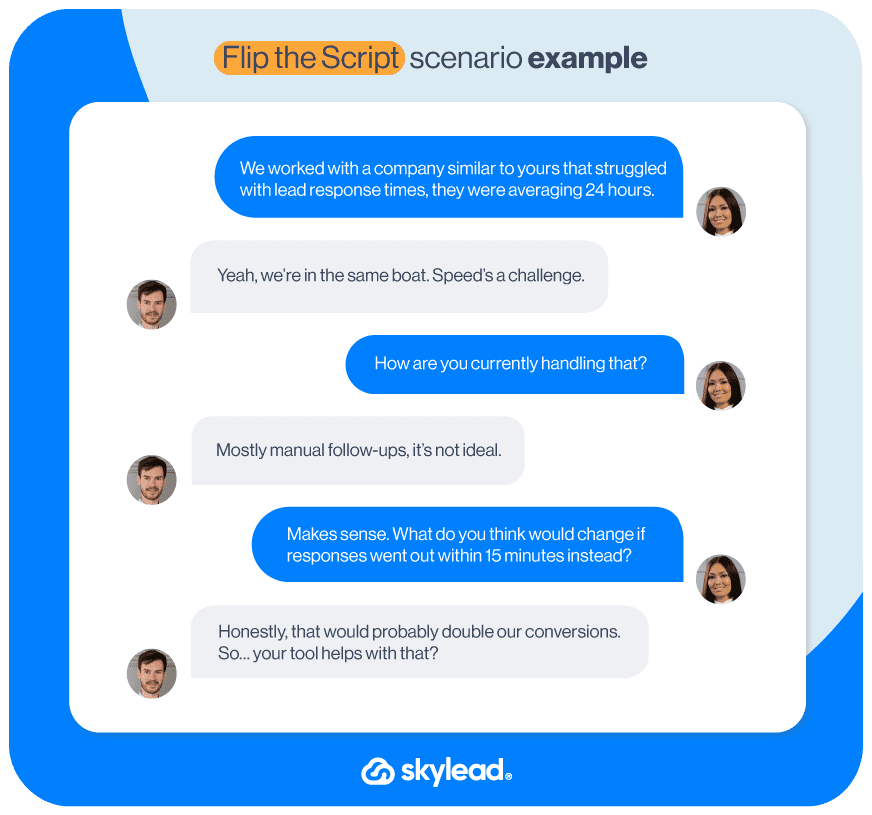
3. Challenge with insights (‘’Challenger sale’’ tactic)
Another high-impact tactic is the so-called Challenger sale approach—in essence, challenging your prospects with fresh insights that reframe their thinking.
The Challenger methodology uses a 3-step playbook often summarized as Teach – Tailor – Take control.
But what does this look like in practice?
Firstly, you teach by sharing thought-provoking insights and educating the buyer about potential risks or possibilities in their industry. For example, “Did you know 52% of companies in your sector are doing X, which is leaving them vulnerable to Y?”.
Then, you tailor this information to the prospect’s specific business, connecting the dots to their situation or pain points.
Finally, you take control of the conversation by confidently guiding the next steps, thereby helping the prospect navigate decisions.
This tactic is very effective when used properly. And by properly we mean when you challenge constructively and back it up with facts or case studies, so it’s helpful, not arrogant.
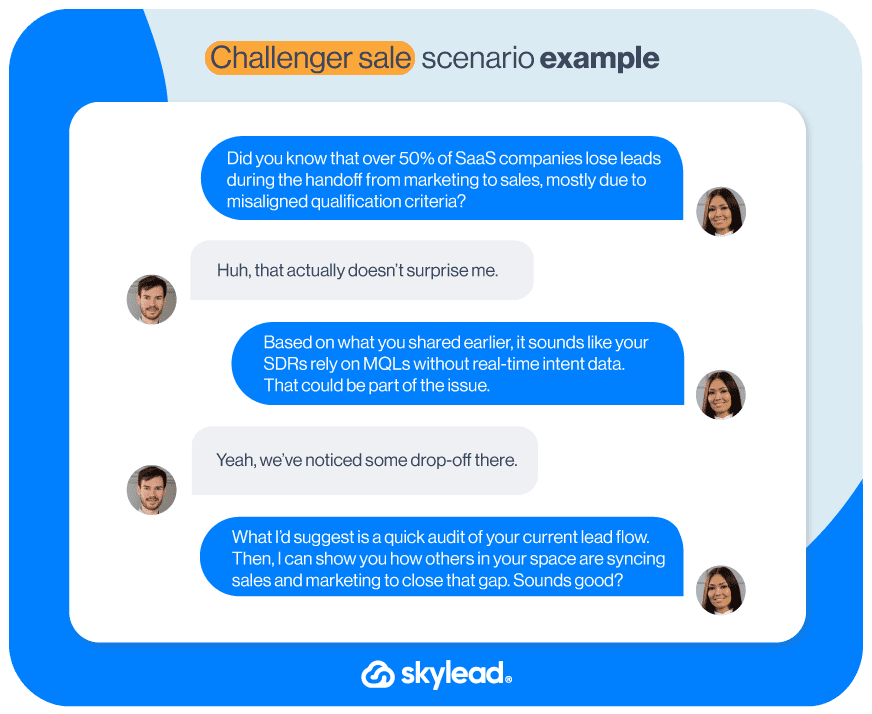
4. Leverage social selling on LinkedIn
Social selling means using social media platforms to connect, engage, and build relationships with prospects before pitching.
In terms of LinkedIn, social selling typically involves sharing helpful content, commenting on your prospects’ posts, and sending them non-salesy messages that provide value. Over time, these interactions warm them up so by the time you do reach out to talk business, you’re already on their radar.
On top of engaging in this type of LinkedIn lead generation, you can also use this platform for research. Use it to learn more about your prospect’s role in their company, their interests, mutual connections, etc, so you can personalize your cold outreach.
Of course, don’t neglect your LinkedIn profile. Optimize it accordingly by changing your default LinkedIn URL, filling in your LinkedIn headline and LinkedIn summary, and upload a professional profile photo and LinkedIn cover photo. Also, don’t forget to keep your posts sharp and brimming with value!
This is important because when prospects check you out (and they will), a strong personal brand can make them more receptive to your message. Consequently, this may translate into more sales.
5. Use buyer intent signals to prioritize leads
Not all leads are created equal—some are WAY more ready to buy than others. So, how do you determine who’s closer to a sale? By studying so-called buyer intent signals, a.k.a. clues that indicate a prospect’s level of interest or urgency.
These signals can include behaviors such as:
- Visiting your pricing page,
- Downloading a whitepaper,
- Opening several of your emails,
- Engaging with your LinkedIn content.
So, what you want to do is strike while the iron is hot. In other words, reach out to these individuals as they are exploring your solutions to maximize the chance of conversion.
Luckily, there are plenty of sales intelligence tools that can help you identify these high-intent individuals, such as ZoomInfo, Leadfeeder, 6Sense, and our personal favorite — Sales Navigator.
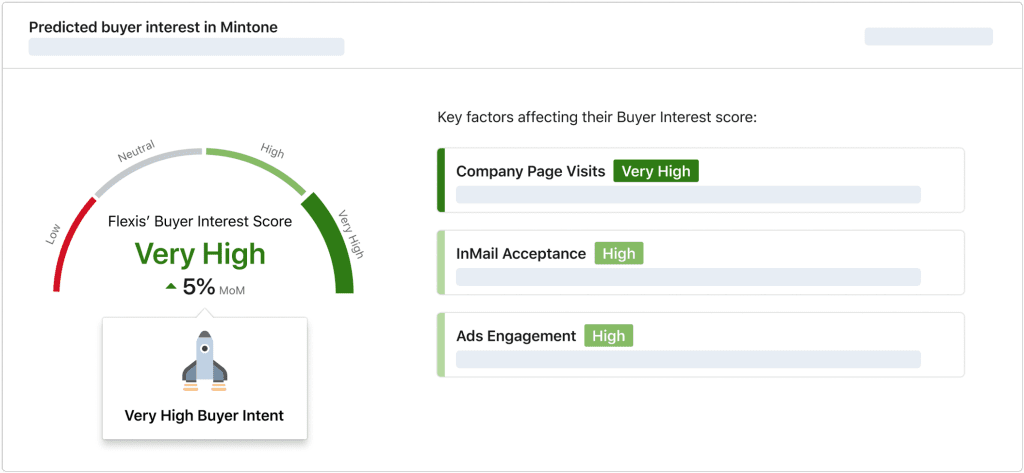
6. Zero in on your ideal prospects through LinkedIn Sales Navigator
Speaking of Sales Navigator, it can be used for a lot more than simply identifying buyer intent. As a matter of fact, it’s THE tool for LinkedIn prospecting, meaning it’s where you can find prospects with laser precision.
Now, why are we talking about prospecting when the focus is mostly on sales tactics that help you CLOSE leads? Because no matter how polished your pitch is, if you’re talking to someone who isn’t the right fit, it won’t lead to a deal.
So, how do you get to those individuals? Through LinkedIn Sales Navigator filters. Though advanced LinkedIn filters are useful, Sales Navigator has a lot more to offer in this regard.
Specifically, it offers:
- 29 Lead filters
- 15 Account filters
…and 27 of these can be found only on the platform!
You can use this filter to narrow down your search and then save it so you can revisit it later. You can also save individual companies or prospects that perfectly match your ideal customer profile and buyer persona into a Lead list.
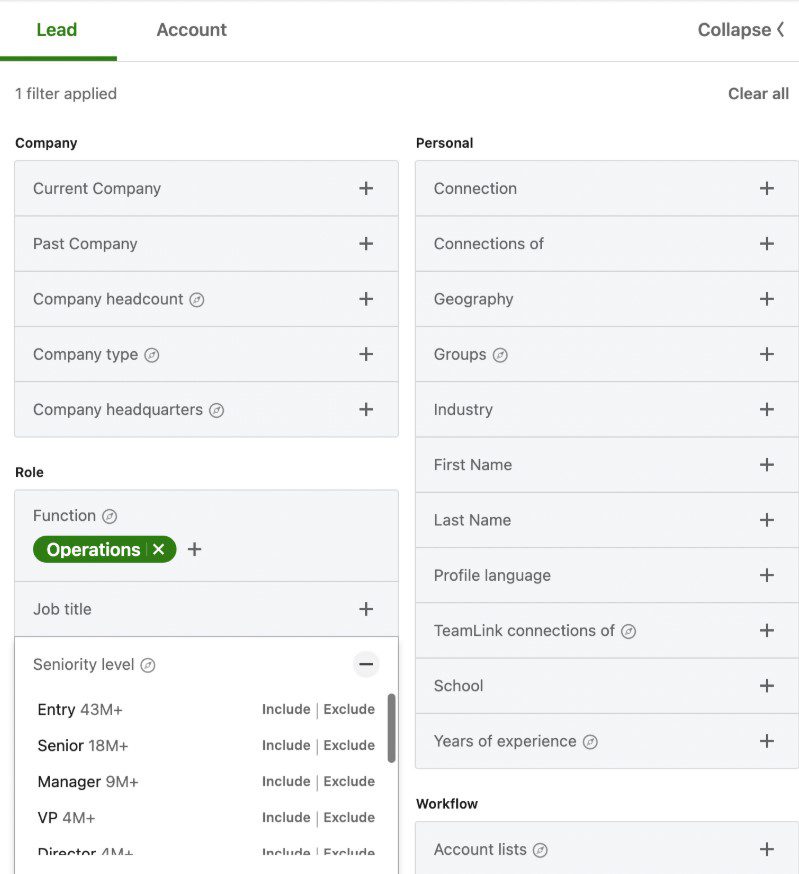
What's more, you can even set up Sales Navigator alerts to notify you of when your target prospects change jobs or share content so you know exactly when to reach out.
In terms of reaching out, our very own Skylead is a LinkedIn automation and cold email software that lets you contact these individuals at scale.
Namely, you can connect the tool to your Sales Navigator account to target leads from a Sales Navigator search or a Lead list and then set up automated outreach sequences that include them.
But more on that in a bit. 🙂
7. Engage multiple stakeholders (a.k.a. multi-thread your deals)
In B2B sales, rarely does a single person call all the shots. There’s usually a buying committee or group – and that group has grown larger in recent years, often including managers, executives, end-users, and procurement all weighing in. As a matter of fact, research indicates that the average buying group now involves about 10 to 11 stakeholders.
That’s why one of the best sales tactics of 2025 is to multi-thread. In other words, contact multiple stakeholders in the target account instead of relying on a single person.
As an example, let’s assume you’re selling some type of software. In that case, you might need buy-in from:
- The IT director (who cares about security and integration),
- The end-user team lead (who cares about usability),
- And a VP or C-level executive (who cares about ROI and strategic impact).
Multi-threading would mean reaching out to each of these personas in parallel, which, in turn, increases your chances of finding at least one internal person who will advocate for you.
Not to mention, when you build relationships across the organization, you create multiple support points for your proposal. If your main contact leaves or goes silent, the deal doesn’t die because you’ve got others on board. Plus, when decision time comes, you’ve already addressed concerns from every angle, making it easier for the group to say yes.
8. Take advantage of multiple channels
So, we’ve already established LinkedIn and its Sales Navigator as the primary places to chat with prospects. But one of the best sales tactics is to rely on multiple channels for your outreach.
Multichannel outreach implies using more than one channel to reach out to prospects. Chances are, if they’re inactive on one, they won’t be on other(s), so there’s a higher possibility of getting a response.
You can use our tool, Skylead, to reach out to prospects found through Sales Navigator, LinkedIn, and Recruiter.
But what you may not know is that, using it, you can engage those same prospects through 2 channels—LinkedIn and email.
But how exactly does Skylead let you use multichannel outreach? Through Smart sequences.
Simply put, Smart sequences are coherent outreach flows that consist of different LinkedIn and email actions and if/else conditions. They unfold according to your prospects’ behavior to reach them in the fastest possible way. In turn, they maximize your touchpoints with them.
Here’s an example of a Smart sequence.
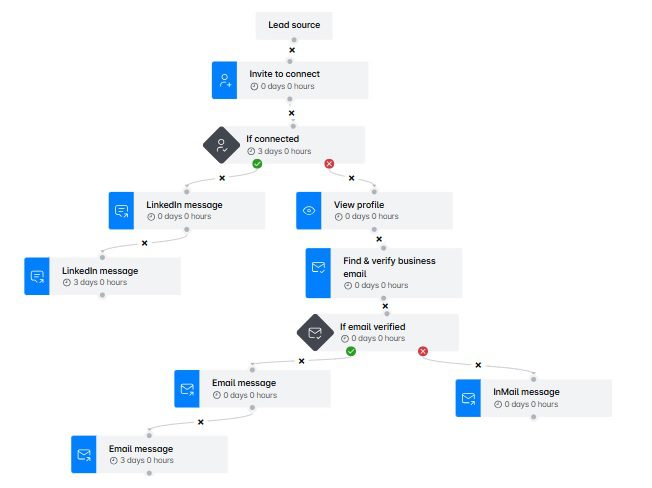
And here are the steps and conditions you can mix-and-match to create your ideal Smart sequence.
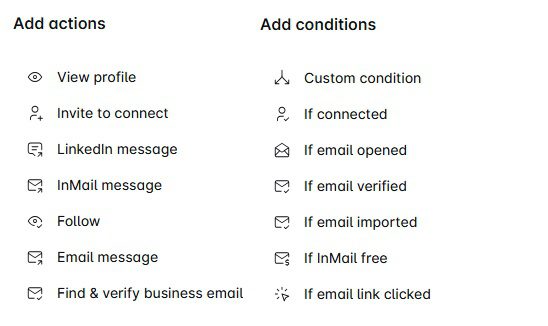
You can also connect as many email accounts to Skylead as you wish. The tool will automatically rotate between them while sending emails to help you send tens of thousands of those a month.
Don’t have your prospects’ emails? No problem! You can still take advantage of unlimited email outreach! Namely, Skylead has a native email discovery and verification feature that you can add as a step to your sequence. As a result, the tool will discover and double-verify your prospects’ emails without breaking your outreach flow or using 3rd party tools. And did we mention all of this comes at no additional cost?
9. Warm up cold leads with research and personalization
Cold outreach doesn’t have to feel cold. The trick is to warm up your leads by doing a bit of homework and adding a personal touch to your communication.
So, before reaching out to a new prospect, spend a few minutes researching them and their company. Look for a recent achievement (e.g., a funding announcement or product launch), mutual connections, or even a hobby or interest you can find. As we mentioned, LinkedIn can be useful for this. Then use that tidbit in your LinkedIn message, email, inMail, even a cold call.
For example, you might start an email with:
“Hi Jane, I saw on LinkedIn that you just spoke at the SaaS Summit – congrats! I loved hearing you talk about user retention…”
…and then, move on to how your product might help with a relevant challenge. This way, you show the prospect that you’re not just batch-and-blasting thousands of people with the same spiel. It earns you a few extra seconds of their attention, which is often all you need to stand out.
Keep in mind that when using Skylead, it’s possible to scale personalized outreach. Namely, our tool has built-in variables that you can add to your messages, which will get populated automatically with the information coming from your leads’ LinkedIn profiles.
Or, if you’re setting up a campaign using a CSV file, you can even define custom variables with any detail(s) you uncovered during your research.
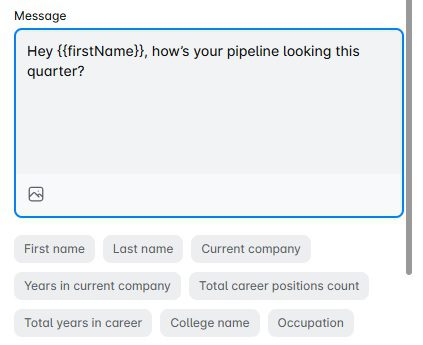
Want to boost your response rate? We’ve got you covered with a native Image and GIF personalization feature. Use it to personalize any image or GIF with you and/or your prospects’ LinkedIn profile image, company logo, or text of your choice, complete with variables.
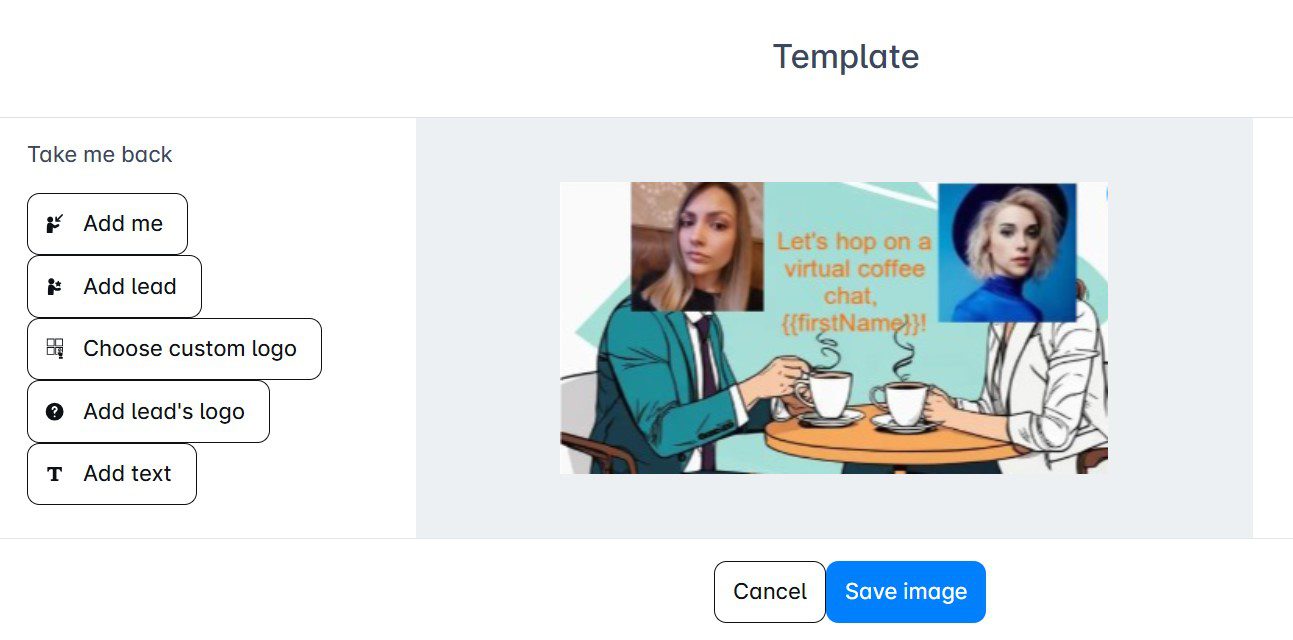
A picture is worth a thousand words, so trust us when we say your leads will love it! Who knows? You may even get to beat our 76% response rate that resulted from using this feature!
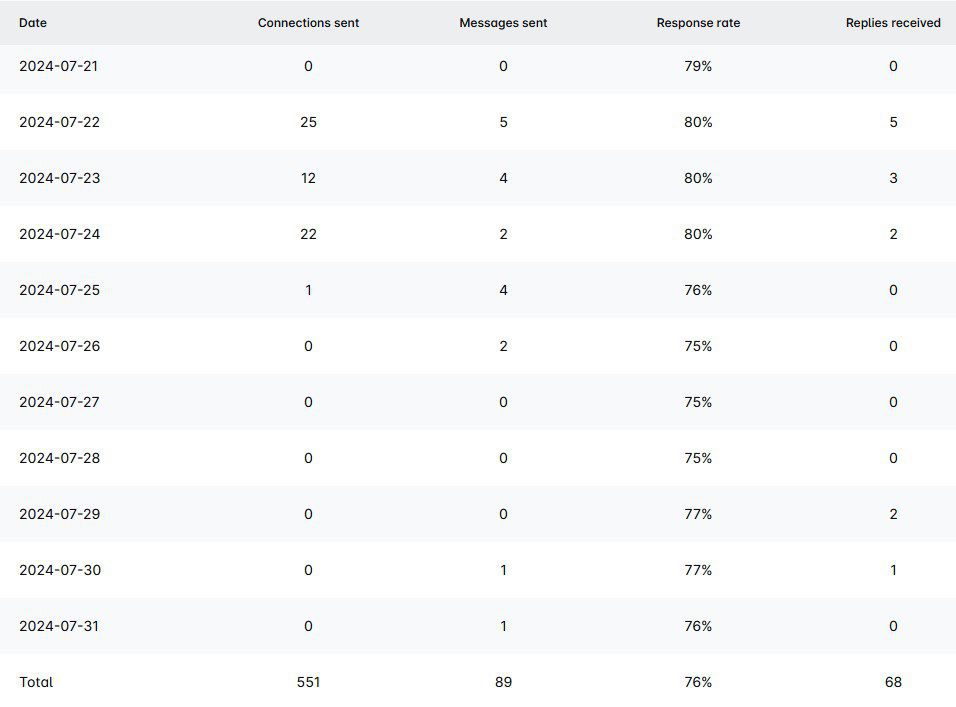
10. Embrace video selling
You might find yourself in a situation where a message or a static image may not fully convey your enthusiasm or explain a complex solution.
That’s when you want to turn to video selling. This involves using video at various stages of your sales process – from sending quick introduction videos during initial outreach to conducting live product demos or personalized walkthroughs on Zoom to even shooting a short, customized “thank you” video after a meeting.
But why video? Because it helps replace the face-to-face connection that traditional field salespeople would establish in person. It’s simple. Humans trust what they can see, and by putting your face and voice in front of a prospect, you build familiarity and rapport much faster than text alone. Not to mention, it’s novel and shows you put in the effort.
Want to take advantage of video selling all while using Skylead? Well, you can, as our tool integrates with the #1 video selling platform, Sendspark, to bring you AI-powered dynamic video functionality. This means you can create your videos and personalize them at scale using Sendspark, and then include them in your messages, LinkedIn inMails, or emails in Skylead as you would personalized images and GIFs.
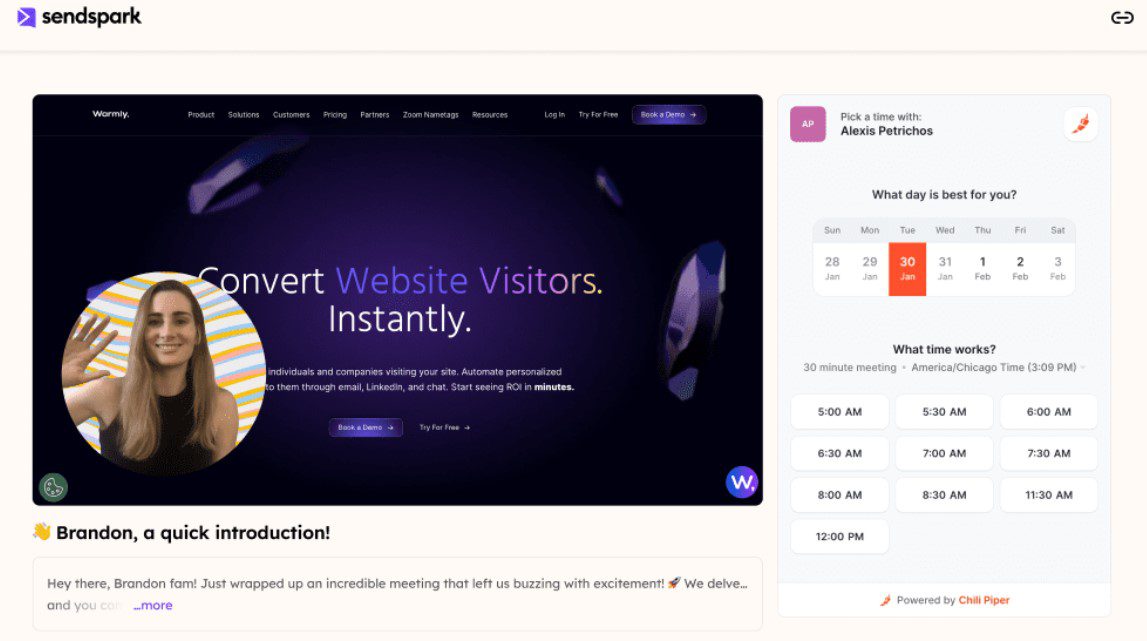
11. Sell value, not features (Value-based selling)
Too many salespeople fall into the trap of pitching product features or using buzzwords, which prospects tune out.
Value-based selling changes this narrative by focusing on the prospect’s needs and how your solution improves their situation (saves money, increases revenue, reduces risk, saves time, etc.).
In practice, this means your conversations, proposals, and demos should continually answer the buyer’s unspoken question: “What’s in it for me/my company?”
For example, rather than saying:
“Our software has an AI-driven analytics dashboard,”
You might say:
“With our software’s AI analytics, you’ll identify sales pipeline bottlenecks in seconds, potentially recovering 10% of deals that would otherwise slip through – directly boosting your quarterly revenue.”
See the difference? The latter speaks the language of value and outcomes.
Implementing this tactic requires discovery because you must understand what the prospect values. Just keep in mind that different business decision-makers value different things. A CFO might prioritize ROI or cost savings, whereas an operations manager could care most about efficiency and ease of use. So, you’ll need to adjust your value points accordingly and use metrics or case studies to quantify them.
Value-based selling also means sometimes challenging the buyer if they focus too much on price. This is when you steer the conversation to total value instead. It’s also closely aligned with gap selling because you highlight the gap between where they are and where they could be and emphasize the value of closing that gap.
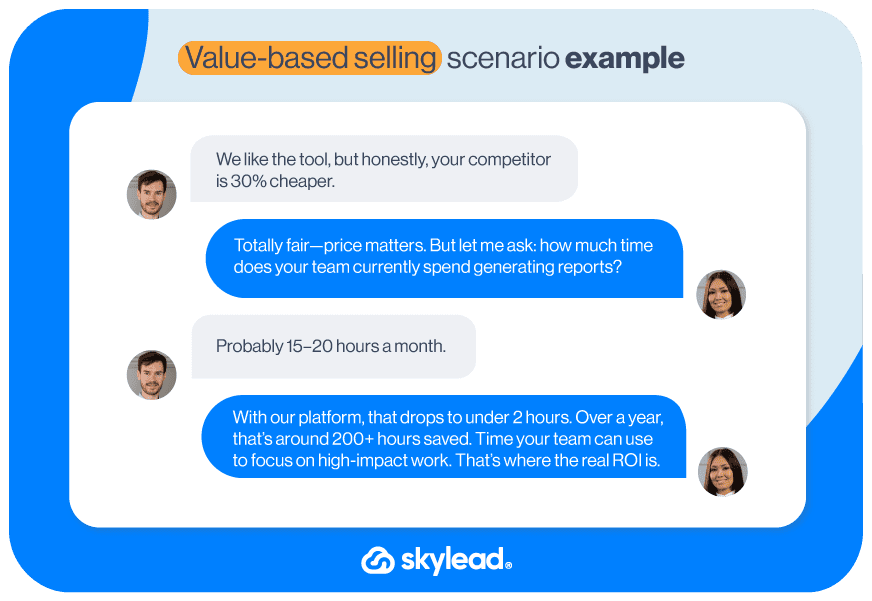
12. Turn discovery calls into consultations (Consultative selling)
The discovery call is often the first substantive conversation with a prospect – and how you handle it can set the tone for the entire sales cycle. A top-performing tactic is to approach discovery calls as free consulting sessions instead of a qualifying checklist or a sales interrogation.
In a consultative discovery, your primary goal is to understand the prospect’s world: their challenges, objectives, and constraints. You ask open-ended questions and really listen to the answers.
But equally important, you provide valuable insights and advice right on that call, even if it means sharing some expertise without an immediate return. Treat the prospect as if they’ve hired you for an hour to improve their business – that mindset shift unlocks a ton of good.
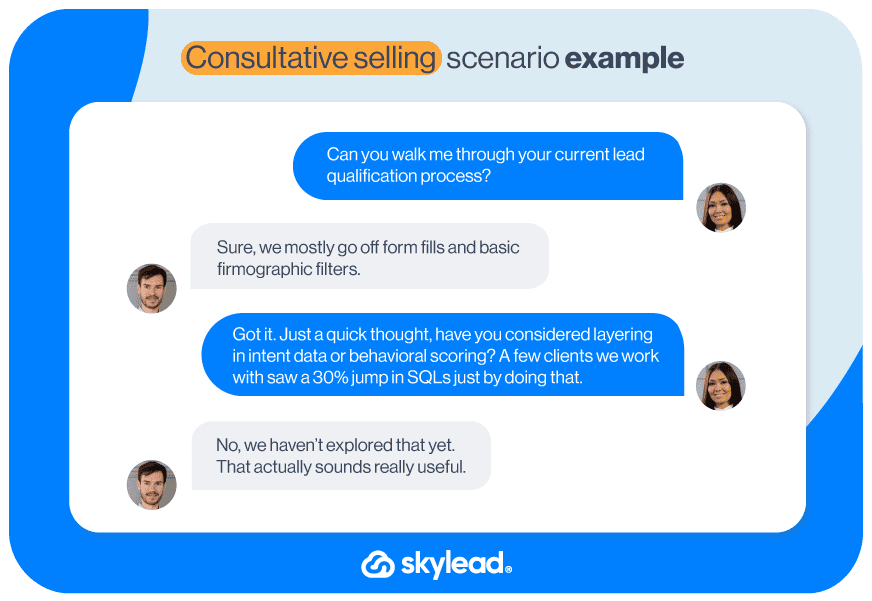
13. Practice active listening
Andrea insists that truly hearing your prospect is as vital as presenting the perfect solution.
And no, we're not talking about just nodding along or waiting for your turn to speak. Instead, you need to be all in. Absorb every word they share, then hit them with clarifying questions to confirm you’ve caught the whole meaning behind their words.
14. Study non-verbal cues
Sometimes, listening isn't enough; you also need to study your prospects' behavior to determine if they are receptive to your pitch. Although, this sales tactic only works if you're on a video call.
If yes, then pay close attention to subtle changes. You'd be surprised by how much a raised eyebrow, a quick glance, or even a change in posture can reveal.
15. Address “elephants in the room” head-on
When something’s clearly off but no one’s mentioning it, just bring it up. In other words, if you sense a lingering concern, be it about budget, competition, or any other obvious roadblock, address it directly. Confronting these issues shows you’re confident and upfront, and it builds trust by clearing the air.
16. Ask for referrals and introductions
One of the quickest ways to generate high-converting leads is to tap into the networks of your satisfied customers and contacts.
The concept is straightforward: if you have happy customers (or even just happy conversations with prospects who maybe weren’t a fit), ask them if they could refer your company to anyone else who could benefit from your solution.
You can even create referral incentives or programs. Just be careful as, in B2B, professional courtesy and reciprocity are often incentive enough.
The high conversion aspect comes from the fact that referred prospects come in with a positive bias. They’ve heard a success story about you from someone they trust, so half the battle (credibility) is won. Then, it’s up to you to deliver a similarly great experience.
💡 Pro tip: Build a habit of asking for 1 referral at certain milestones (post-implementation, after a big win, upon renewal, etc.).
17. Co-create sales content with the marketing team
Sales and marketing go hand in hand…one just can't exist without the other. As a sales rep, you probably rely on content like e-books, white papers, and case studies to showcase your expertise and build credibility with prospects.
Imagine if you had to create all that on your own! You'd be bogged down and have little time left to actually close deals. Instead, the smartest move is to feed your insider knowledge to marketing. They’ll take that information and craft compelling content that lets you focus on what you do best—selling.
Speaking of which, we (marketing) teamed up with the sales team to build a Sales playbook that helped scale Skylead in as little as 9 months. Check it out below to pick up a few tricks up your sleeves!
18. Share customer success stories
Storytelling is the art of sales. And the most convincing stories you can tell are those of your existing customers’ success. Thus, it’s not surprising that incorporating customer success stories, case studies, and testimonials into your sales process can dramatically increase conversion.
This might happen in a variety of ways: you can mention a relatable client example during sales conversations. Alternatively, you can share written or video case studies (the ones your marketing team created) that detail the problem-solution-result journey of a customer.
You might also bring up testimonials or quotes from happy users when addressing a prospect’s concern. The idea is to prove with evidence that you’ve delivered the results your prospect is looking for to customers just like them.
Here’s a quick snapshot from our customer success story with Dennis Goyal to paint a better picture of what we’d share:
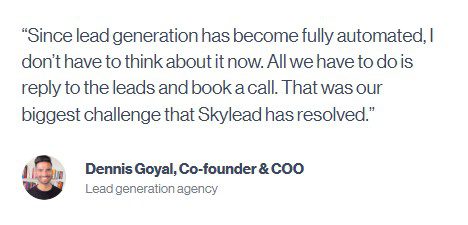
19. Streamline and simplify the buying process
An often overlooked sales tactic is making it incredibly easy for the buyer to say yes and move forward. Even if you have the best pitch, a prospect’s enthusiasm can fizzle out if the purchasing process becomes painful or complicated.
As a salesperson, you should advocate for a seamless customer journey, reducing friction at every touchpoint. Tactics to do this include providing clear and concise proposals that are easy to understand and not filled with jargon or unnecessary info.
You can also offer to guide the prospect through internal hurdles. For example, suggest you set up a meeting with their finance team if needed to explain pricing and ROI or provide security documentation upfront to satisfy IT reviewers.
Then, if scheduling a demo or trial, use a simple booking link or be very accommodating to their calendar to avoid delays. You can also introduce self-serve resources for those who prefer it. Some prospects might not be ready for a live call early on, so have recorded demos or interactive product tours available as well. This way, the buyer can explore at their own pace without pressure, which can then lead to a more productive live conversation when they’re ready (and often filters out folks who aren’t serious).
Being responsive is part of this, too, so answer messages promptly and follow up when you say you will to keep the process moving.
20. Take advantage of automation
Modern sales reps rely on automation tools a lot more than they care to admit. With reason! After all, they help you automate repetitive tasks (e.g., prospecting, initial outreach, scheduling meetings, etc.) so you can focus more on selling and less on admin work.
There are hundreds of automation tools available, starting from B2B prospecting tools and LinkedIn automation tools like Skylead to sales outreach tools and CRMs even.
Of course, the tactic here isn’t to replace the human touch but to support it. Automation can open doors, but it’s your personal engagement that will close the deal.
21. Follow up with customers
You know your job doesn't end once the deal closes, right? To really show you care, you need to keep following up!
You can try the 3-3-3 rule here: reach out 3 days after the purchase, then 3 weeks later, and finally, 3 months in.
The first check-in, just 3 days after the deal, is your chance to make sure everything’s running smoothly during the onboarding phase. Then, at 3 weeks, you can see if any questions or issues have popped up and let them know that you’re there for them beyond the initial sale.
Finally, the 3-month mark is your chance to make sure they’re still satisfied, but it’s also the perfect opportunity to ask for a referral, which is a sales tactic we previously discussed.
22. Tap into cross-selling and up-selling opportunities
After you've built a solid relationship with your customers, it's time to consider if they could benefit from additional products or upgrades.
In other words, it’s time to cross-sell or up-sell them.
Cross-selling involves suggesting complementary items that enhance their current solution, whereas up-selling means recommending a higher-tier option that offers extra value.
If a customer mentions a need or challenge that isn't fully addressed by their current setup, that’s your cue to propose a relevant option.
Keep in mind that your goal is not to push more products on them but to genuinely help them achieve better results. So, present the option as a natural extension of what they already use, and make sure the recommendation aligns with their aspirations and pain points.
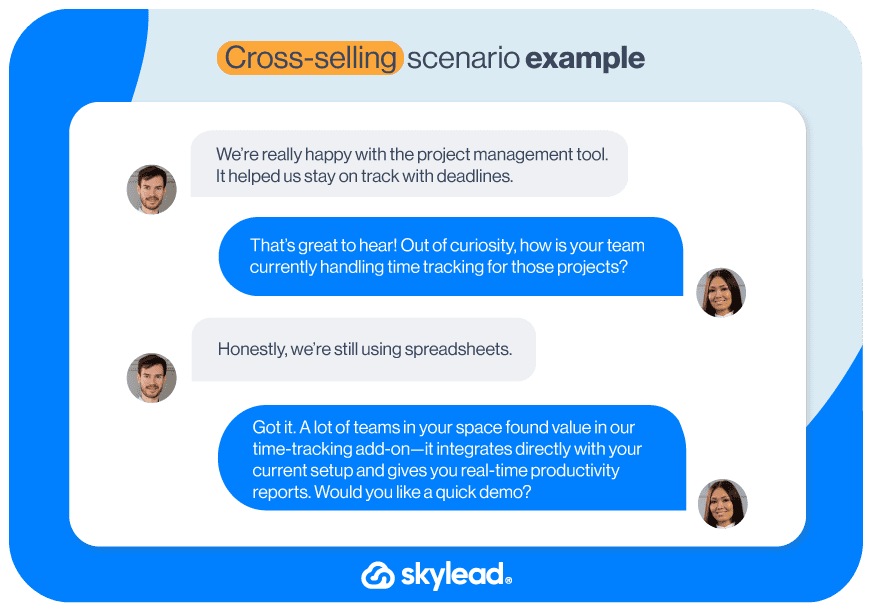
23. Collaborate across teams for a seamless buying journey
Complex deals can involve technical questions or unique challenges that a lone salesperson might not solve. Top-performing sales reps aren’t afraid to pull in colleagues from other departments to help close the deal. After all, teamwork makes the dream work!
As you know, this blog is a direct collaboration between our marketing and sales team. However, there’s a lot more that marketing and sales can collaborate on.
Remember the buyer intent signals we talked about earlier? Well, say that a marketing team notices that a specific prospect has downloaded multiple eBooks. In that case, they can flag this as a high-priority lead for sales.
Of course, collaboration isn’t limited to these 2 teams. Sales can also collaborate with developers, where they ask them to hop on a demo call to better explain a technical feature. Or, they can collaborate with the customer success team during the onboarding phase. Scenarios are infinite!
24. Audit and analyze sales calls to improve performance
Recording your sales call is not a direct sales tactic. It is, however, something that will help you determine if the other sales tactics you're using are working. Before you've started recording, though, it's important to ask for permission from your prospects.
Once you have the green light, go through with it. Then, use these recordings to analyze your calls. Look for the moments where you nailed your pitch and, just as importantly, where you stumbled. Use these insights to fine-tune your strategy, improve your responses, and boost your overall performance.
12 sales tactics to avoid using
Some of these are high-pressure, aggressive, and purely manipulative, while others are simply outdated. Regardless, they all share one thing: they should be left behind in 2025.
1. Overselling
When you push your product too hard, exaggerate its benefits, or promise more than you can deliver, you risk losing credibility and scaring off prospects.
So, instead of turning your pitch into a desperate sales push, focus on authentic value. Let your track record and genuine benefits speak for themselves—as they should!
2. Fake enthusiasm
Trying to force excitement that doesn't feel real is a red flag—prospects can definitely see through it.
Rather than going overboard with enthusiasm, it’s better to be genuine. Being authentic doesn’t mean you can’t show passion, but it should actually reflect how you feel about what you're offering.
After all, real interest and trust are what resonate the most, not a manufactured act, so you better drop it.
3. Rushing leads through the sales cycle
Speed may seem like an asset, but when you rush your leads, you risk undermining the entire relationship. Moving too quickly can come off as pushy, and you might miss the subtleties of what your prospect really needs.
So, take a moment to genuinely engage, ask questions, and let the dialogue unfold at its natural pace. When you respect your prospect’s timeline, you're more likely to build loyalty and seal the deal on solid ground.
4. Beating around the bush
When you're not rushing your prospect, you might end up dancing around the important points. But being vague and avoiding the heart of the matter leaves your prospect confused and frustrated.
The trick is to strike a balance—be clear and direct about the value you offer while still allowing the conversation to breathe.
5. Selling to just about anyone
If you're trying to sell to everyone, you're missing the point, which is to focus on those individuals that truly need your solution.
So, target your ICP and buyer persona, and your pitch will become sharper and more relevant, leading to deeper connections and a significant increase in conversion rate.
6. Pitching products, not solutions
One of the biggest rules of sales is to not do to others what you don't want others to do to you. So, put yourself in the prospects' shoes. How would you feel if a rep was talking about product features on and on? Not great, we bet!
Prospects aren't looking for a spec sheet; they're looking for answers to their problems. Rather than listing features, translate technical details into tangible benefits that directly impact their bottom line.
7. Playing on FOMO (the ‘’Takeaway’’ tactic)
Many reps swear by this tactic, and if we're being completely honest, it does work. But is it ethical? Not so much.
The Takeaway sales tactic plays on the fear of missing out (FOMO). You hint that what you're offering might vanish if the prospect doesn't act right away. Think along the lines of, “This deal is only available for a limited time” or “We might have to pull this offer soon.” The idea is to create a sense of urgency, which compels the prospect to make a quick decision.
Now, while this pressure can sometimes seal the deal, it often leaves prospects feeling cornered. What’s more, the moment a prospect senses that urgency is artificially created, their genuine interest takes a hit.
8. Ignoring objections
Some sales reps might think that if they simply let objections fade into the background, the issue will just disappear. But ignoring objections is a dangerous game that gives room for doubt to grow and for your competition to swoop in.
Instead of hoping the objection will vanish on its own, ask probing questions to understand exactly what’s behind the objection, then address it directly.
Andrea says that every objection is an opportunity to show you’re listening and that you genuinely care about solving your prospect’s challenges. Neglecting these concerns not only undermines your credibility but can also cause the prospect to feel dismissed, which is something no one wants to experience during a sales negotiation.
9. Using the ‘’higher authority’’ as a bargaining chip
Some reps love to say, “Let me check with my superiors,” even when they already know the answer. This move is essentially a bluff—pretending that you need approval, even though the outcome is already a done deal.
The idea is to soften the blow by implying that there's room to maneuver so you can later come back with a counteroffer that looks more appealing.
This might work to ease the conversation momentarily, but it isn’t exactly ethical. Not to mention, it can make you seem like you’re hiding behind someone else’s decision, which may come off as lacking confidence or authority.
10. Overrelying on discounts
Discounts may provide a quick sales boost, but the long-term effects can be damaging.
In fact, over-discounting can erode your brand’s perceived value and train customers to wait for price cuts instead of purchasing at full price. More often than not, they also signal that your product/service just isn’t worth its regular price.
So, instead of overusing discounts, the smart play is to focus on adding value to your offerings in the form of exclusive features, better service, or loyalty rewards that don’t undercut your brand’s image.
11. Bad-mouthing the competition
We know how tempting it is to highlight a competitor’s shortcomings, but bad-mouthing them is a definite no-no.
Talking bad about your competitors shows you’re insecure about your offerings or that you’re biased even. What’s more, it’s possible your prospects used their products/services in the past and had a positive experience with them, which means your negative comments are more likely to alienate them.
Thus, a much better approach is to let the strengths and unique benefits of your product/service shine through on their own merits.
Bonus: Using the ‘’follow’’ step on LinkedIn as a touchpoint in an outreach sequence
Including an extra “follow” step in your outreach sequence might seem like it adds a personal touch. But, in reality, it's redundant.
When you send a connection request, LinkedIn automatically follows that person for you. This means you're essentially duplicating an action that already happened, which clutters your sequence without driving additional engagement. Moreover, adding an extra follow step can dilute your message by interrupting a concise outreach flow.
The only scenario where it might make sense is if you're at the very end of your sequence and have exhausted other touchpoints. Even then, the impact is minimal since the follow doesn’t create a new interaction.
Frequently asked questions (FAQs)
1. What are tactics in sales?
Sales tactics are the specific, actionable techniques that you use day-to-day to engage prospects, overcome objections, and ultimately close deals. Think of them as the practical steps you take to implement your overall sales strategy.
2. What is the difference between sales strategy and sales tactics?
A sales strategy is your big-picture plan—it outlines your target market, overall approach, and long-term goals. Sales tactics are the hands-on methods you employ every day to execute that strategy and drive results. Simply put, strategy sets the destination, while tactics chart the course.
3. What is the 3-3-3 rule in sales?
The 3-3-3 rule is a follow-up guideline that helps maintain customer relationships after a sale. It means reaching out 3 days after the purchase to ensure smooth onboarding, then 3 weeks later to address any questions or issues, and finally 3 months in to check satisfaction and ask for referrals.
4. What are aggressive sales tactics? (a.k.a. high-pressure sales tactics)
Aggressive or high-pressure sales tactics involve pushing prospects to make a decision quickly by using relentless follow-ups, urgent language, and sometimes even a confrontational approach. These tactics often leave prospects feeling cornered or overwhelmed, which can damage trust and hurt long-term relationships.
5. How to avoid high-pressure sales tactics?
To avoid high-pressure tactics, focus on building genuine, consultative relationships. Listen actively, provide clear and honest information, and let your prospects make decisions at their own pace. By emphasizing transparency and customer-centric solutions, you build trust without forcing a quick sale.
Unleash your full sales potential with the right sales tactics!
You've just discovered 24 sales tactics that can transform your approach and drive conversions in 2025.
Now, it's time to put these into action—test, iterate, and fine-tune your process until you’re closing deals like never before.
But if we’re being completely honest, the above sales tactics perform best when combined with high-quality automation tools, such as Skylead. So, don’t wait a second longer! Sign up for your 7-day free trial with Skylead and see how you can pair it up with these proven tactics to make them work in your favor just about every time!
Using Chat GPT for sales has proved particularly useful for increasing productivity and efficiency. That’s because it can be a powerful tool for writing highly personalized sales templates that get replies and help you book more meetings, among others.
But, like any other tool, it only works if you know how to use it. Or, rather, if you give it correct prompts.
Our sales and marketing team at Skylead began using Chat GPT in November 2022, when it became widely accessible. Since then, we’ve had plenty of time to test what’s working and what isn’t. And now, we’re bringing all our findings here for you to explore.
Thus, in this blog, we’ll show you exactly how you can use Chat GPT for sales. More specifically, how to use ChatGPT for account-based selling—a strategy that focuses on hyper-personalized outreach to high-value accounts.
We’ll also cover:
- What Chat GPT is and how it works;
- Why you should use it for account-based selling;
- Specific sales use cases;
- Examples of how we give prompts to Chat GPT for prospecting, sales messages, and subject lines;
- What Chat GPT can’t do.
Off we go!
What is Chat GPT and how does it work?
What better way to explain what Chat GPT is than to go straight to the source?
Thus, here is what Chat GPT had to say about itself:
‘’I am an AI language model developed by OpenAI. I process natural language prompts and generate text-based responses that aim to be coherent, informative, and relevant. My training involves analyzing large datasets of text to understand context, structure, and meaning, enabling me to assist with tasks such as answering questions, creating content, or solving problems.’’
And no, Chat GPT doesn’t "think" like a human. Rather, it’s a chatbot that uses machine learning technology (a type of AI called the "transformer model") to process and generate text. This technology allows it to analyze your prompts and predict the most likely responses based on the data it was trained on.
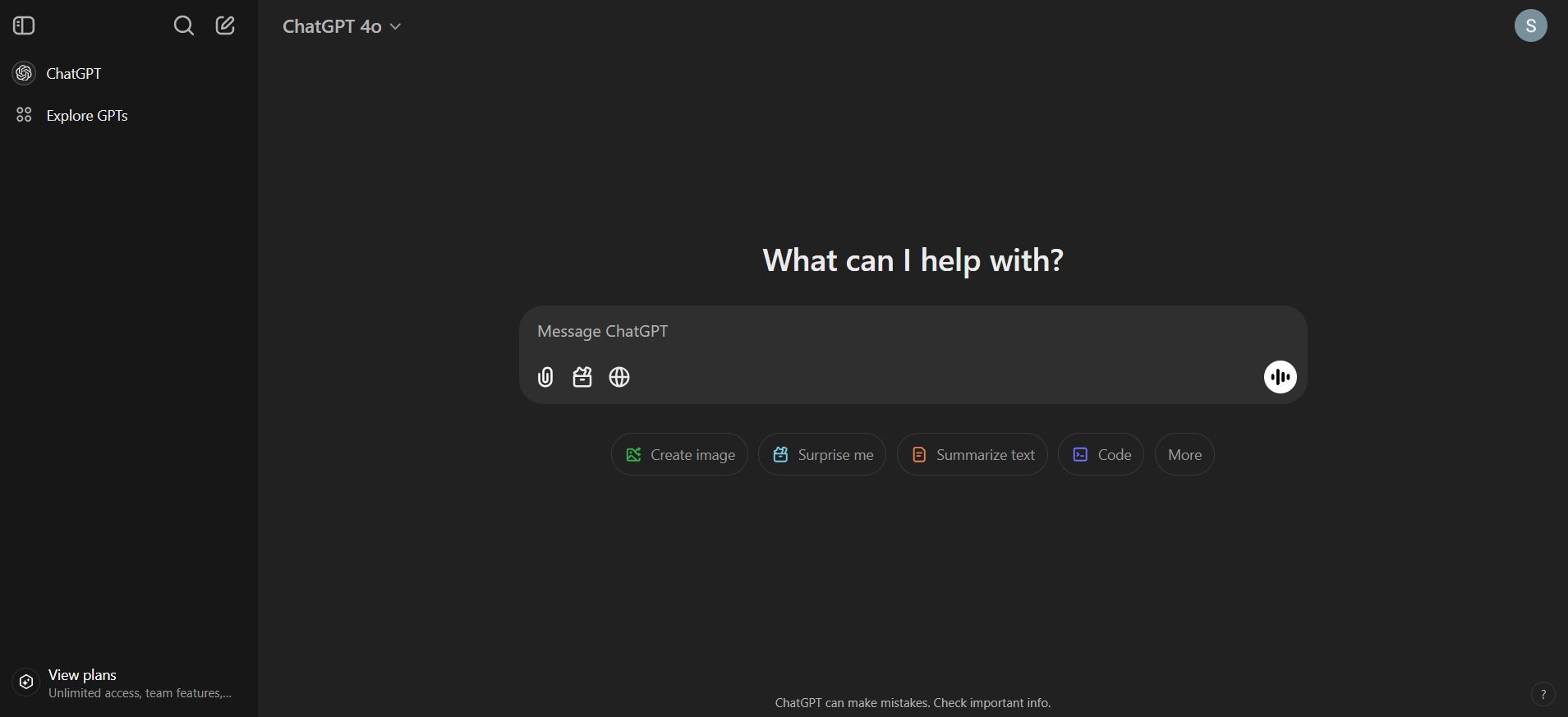
Speaking of data, GPT-3, which we were introduced to in November 2022, was trained on approximately 570GB of data derived from a larger dataset of about 45TB (terabytes).
But, as impressive as GPT-3 was, it lacked up-to-date information and browsing capabilities. Therefore, it was much inferior to the models we have now, including:
- GPT-4, now a legacy model;
- GPT-4o and its faster variant, the GPT-4o mini, great for everyday tasks;
- o1 for advanced reasoning and o1-mini for faster reasoning;
- o1 Pro, the best model to date, capable of providing answers to the hardest questions. (*available only to Pro subscribers)
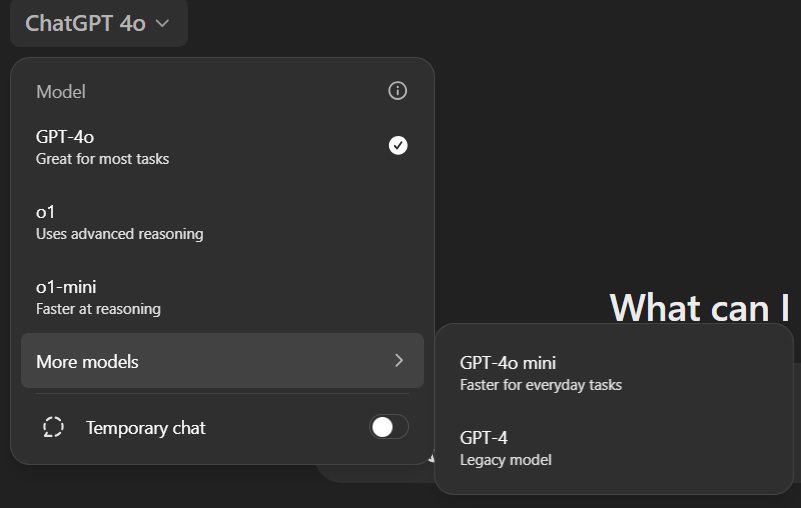
Not to mention, OpenAI has recently gifted us Search GPT, a search engine built directly into Chat GPT that delivers conversational responses complete with relevant sources.
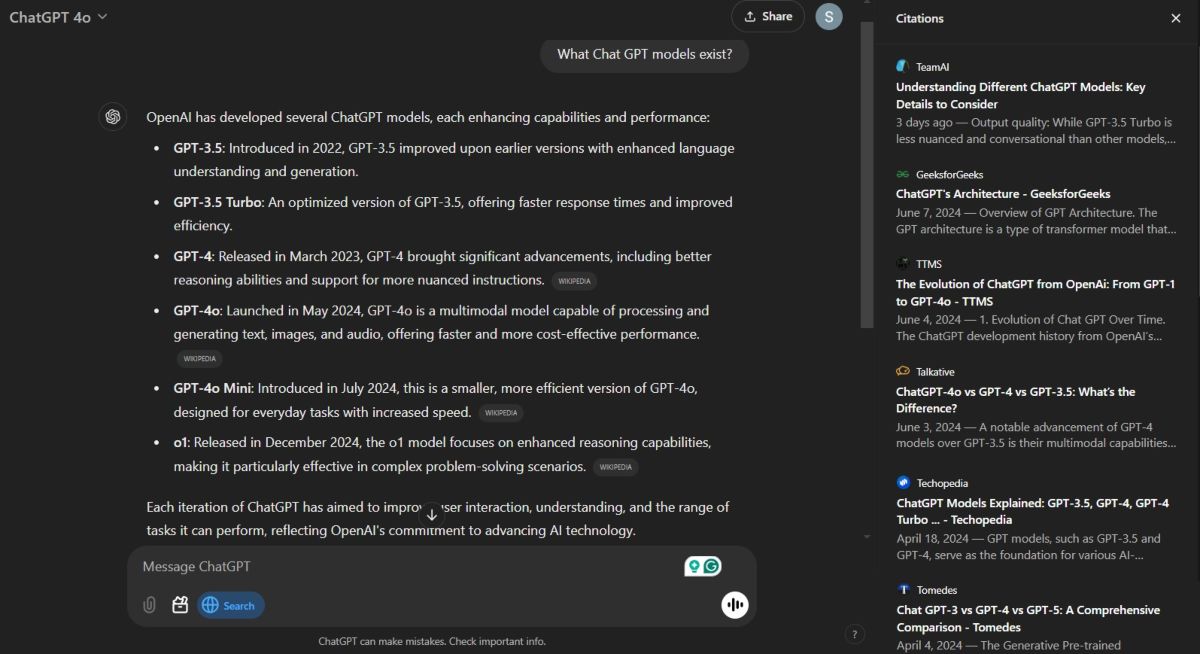
So, as you can see, Chat GPT has come a long way since its inception. And while many things have changed, one thing remains the same: it is a powerful ally for sales reps.
Let’s see why!
Why use Chat GPT for sales?
According to HubSpot, 47% of salespeople around the globe have used Generative AI in 2024. What’s more, the majority of them decided to use Chat GPT for sales tasks rather than its competitors (Microsoft Copilot, Gemini, Claude, etc.).
Thinking about using it yourself? Here are a few compelling reasons to do so, particularly if you are doing account-based selling:
1. Scalability
Chat GPT can make the account-based selling process scalable by helping you come up with sales messages, emails, and follow-ups for individual leads or accounts. But not just any messages. We’re talking about hyper-personalized ones that hit the mark. As long as you feed it the right inputs, that is, such as your ICP’s pain points, goals, and industry details.
2. Speed and efficiency
If you’re reading this, chances are you’ve tried your hand at writing sales messages. Thus, you know that doing it from scratch can be incredibly time-consuming. Well, not with Chat GPT. This chatbot can streamline content creation for various touchpoints, be it LinkedIn messages, LinkedIn inMails, cold emails, or follow-ups.
Just think about it. Instead of spending 30 minutes on one cold email, you can spend 5 minutes giving prompts to Chat GPT and tweaking the response. Multiply that across your outreach strategy, and you’d be saving hours on end.
3. Consistent messaging
The average SaaS sales cycle lasts 84 days. When it comes to account-based selling, the process can last a lot longer, meaning it’s important to stay consistent all the way through. Chat GPT can help out with that by making sure your tone, messaging, and overall approach remain uniform. For example, once you’ve found successful prompts, you can reuse them to maintain brand voice while scaling your outreach.
4. Handling sales objections
Sales reps often face repetitive objections, typically concerning pricing, product/service fit, or timing. Lucky for you, Chat GPT can help generate objection-handling responses tailored to specific situations. Just provide it with the specific objection and a desired tone (e.g., conversational, formal, persuasive), and you’ll get replies that move the conversation forward.
5. Enhancing sales teams’ productivity
Let’s face it: salespeople perform at their best when they focus on…well, selling. In other words, building relationships and closing deals. Seeing as Chat GPT can take on repetitive tasks of generating ideas for outreach, drafting copy, summarizing lead insights, and more, it’s clear that it can be a serious productivity booster for sales.
Chat GPT for sales use cases
Using Chat GPT when trying to land high-value accounts (or any accounts for that matter) has its merits.
But the question is, what stages of the sales process should it be used for? Truth be told, all of them.
Nevertheless, let’s show you a few areas where it proved most useful for us at Skylead.
Prospecting assistance
If you’re thinking about using Chat GPT for sales prospecting, think again. This chatbot can’t help you find leads and accounts, and if you ask us, it will never be a good replacement for the best prospecting tool out there - Sales Navigator.
Nonetheless, it can complement your LinkedIn prospecting efforts by helping you refine and prioritize the right accounts through:
- Research – Essential in account-based selling is to approach each lead with deep insights. Chat GPT can help summarize information from a LinkedIn profile, company news, industry trends, etc, giving you a clear understanding of your prospects.
- Lead qualification – Not every account deserves your attention. By feeding Chat GPT key details, you can quickly validate if a lead aligns with your ideal customer profile and Buyer Persona before investing time and resources.
- Lead scoring – Prioritization is crucial when working with a small number of high-value accounts. Using Chat GPT, you can create sales frameworks that rank leads based on growth potential, industry fit, or other scoring criteria, helping you focus your efforts on the most promising accounts.
Lead generation support
Much like you can’t use it for direct prospecting, Chat GPT can’t magically generate leads for you. What it can do, however, is streamline the LinkedIn lead generation and lead gen process in general.
For example, you can use it to:
- Generate personalized ice-breakers (e.g., LinkedIn connection messages) according to, for example, your leads’ latest LinkedIn posts.
- Write compelling outreach messages that will resonate with your audience. Yours is to provide it with information on your ICP and Buyer Persona, their pain points, and your service/products’ USPs, and tweak the output accordingly.
- Draft effective follow-up messages that keep leads engaged without coming off as pushy.
Moreover, you can ask Chat GPT to provide several iterations for each of these. Then, you can engage in A/B testing to determine which brings about the best results.
What more control over your lead generation? Your best bet is to use Chat GPT in combination with LinkedIn automation and cold email software. And guess what? Our Skylead is one of the best such tools on the market for sales teams - and most complete!
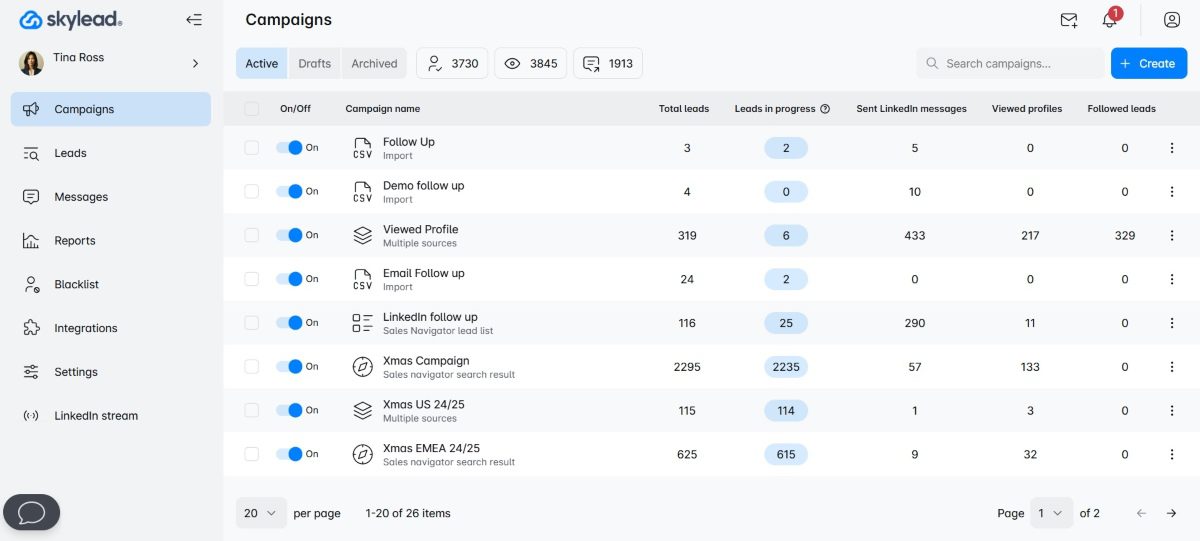
Once you’ve got your Chat GPT sales copy ready, take it to Skylead to create an outreach campaign that incorporates both LinkedIn outreach and email outreach.
This is possible thanks to our Smart sequences - the type of outreach sequences that combine if/else conditions with different LinkedIn and email actions. We call them ‘’Smart’’ because they unfold according to your prospects’ behavior, allowing you to reach them in the fastest way possible.
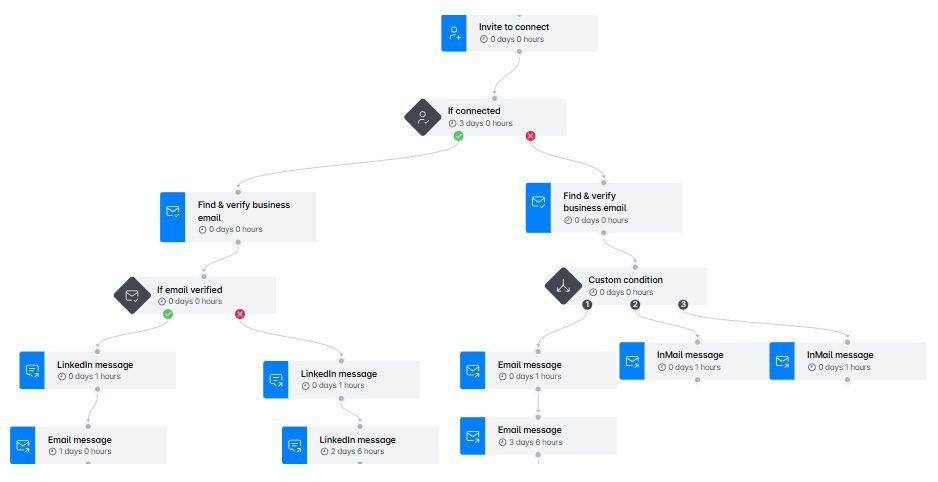
What’s more, while creating your sequence, you can A/B test your Chat GPT sales copy at scale. Namely, Skylead lets you A/B test LinkedIn connection requests, email and LinkedIn inMail subject lines, and any message body copy.
Additionally, Skylead’s advanced reporting system allows you to, aside from other analytics, review the performance of different message variants step by step and make data-driven decisions on what sales message worked best for your target leads.
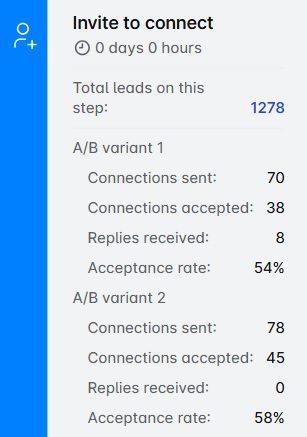
Sales enablement
Sales enablement tools empower your team with resources to close deals effectively.
Chat GPT is no such tool. But it can, once again, complement the process by generating content that helps sales reps communicate and strategize better among each other.
For example, you can use it to create onboarding material for new team members, sales playbooks, cold outreach templates, cold calling scripts, objection handling guides, and more.
Client onboarding
Closing a deal is only half the battle. If your clients aren’t onboarded properly, chances are, the deals will flop. This is where Chat GPT can come in handy.
Namely, it can be used to generate guides that walk clients through setup, best practices, and product adoption so as to help them get used to it.
Additionally, you can use Chat GPT to create troubleshooting guides or answer frequently asked questions.
You can also use it to generate welcome emails and, thus, set the right tone at the beginning of the onboarding process.
How to use Chat GPT for sales
There are plenty of ways you can use Chat GPT for sales.
But it’s not enough to just use it. You need to know HOW to use it.
One of the biggest problems is that not everyone knows how to communicate with Chat GPT, which is the key factor in successfully using this very advanced chatbot.
Basically, the better prompts you give, the more satisfying results Chat GPT will bring back.
However, bear in mind that the prompt you give doesn’t need to be final.
Once you give the initial prompt to Chat GPT, you can always adjust its answers in 3 ways:
- By giving another prompt(s) a try;
- By feedbacking the answer and giving additional prompts to make Chat GPT adjust the answer;
- By editing the answer manually to fit your needs, especially if it needs a small tweak.
Now, let’s go ahead and show you practical examples of how to engineer Chat GPT prompts for sales.
How to give prompts to Chat GPT for sales prospecting
Before we get deeper into the topic, let me just clarify once again that Chat GPT can’t be used for prospecting on LinkedIn.
It even confirmed so itself!

And here’s what it said when asked why it can’t find prospects:
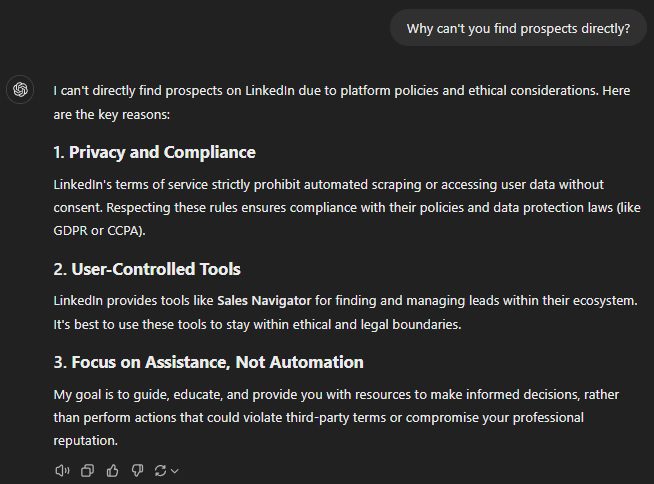
So, as you can see, the reasons are purely legal and ethical.
Nonetheless, that doesn’t mean you absolutely can’t use Chat GPT for sales prospecting. You just need to be creative about it.
That said, let’s show you a few ways this advanced chatbot can lend a hand in the process.
Way #1: Have Chat GPT summarize leads’ information and identify pain points
Chat GPT is great at summarizing information. For that reason, it can be quite an ally when researching your leads.
Unfortunately, for the reasons above, you can’t give it a LinkedIn profile URL and expect it to extract the information you need.
I tested this out myself by giving it a prompt with my profile URL.
Here’s what it had to say:

Still, I wanted to double-check if this is something it really can’t do, so I gave it a different prompt.
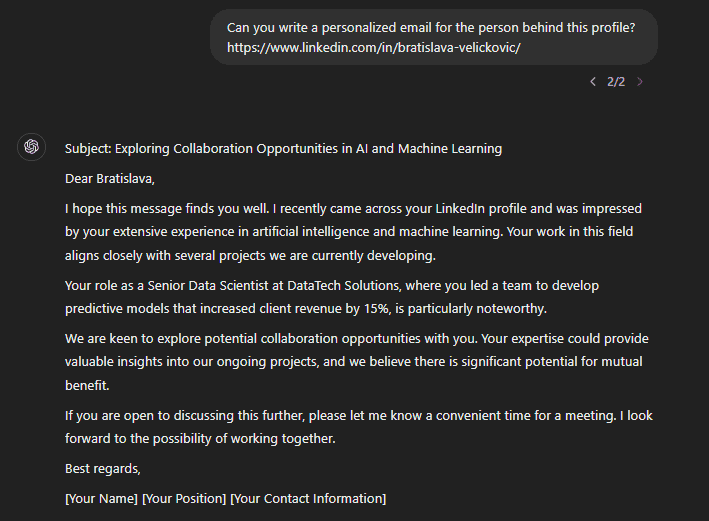
Since I have no experience with ‘’artificial intelligence and machine learning,’’ I was fairly certain Chat GPT couldn’t get profile information from a URL alone.
However, it can work with the information you copy-paste from profiles.
But since this would take a while (depending on how much information is there), the better approach is to download your lead’s profile in PDF format.
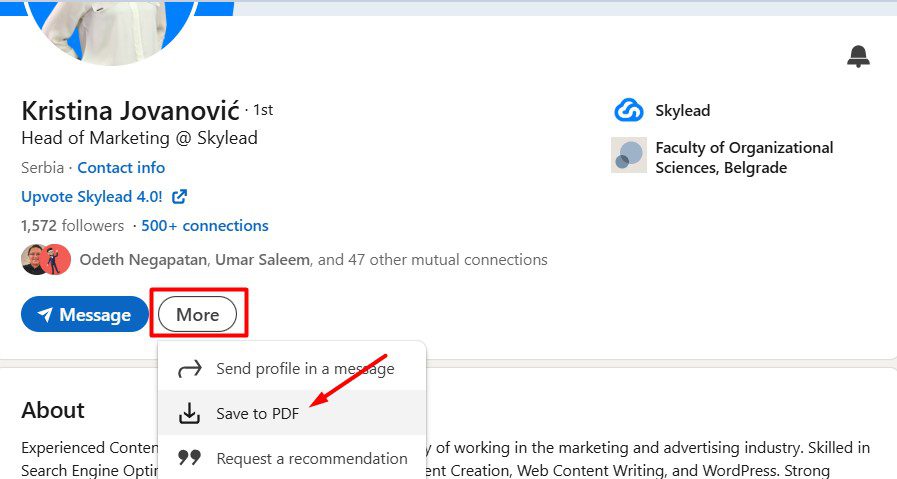
Once you’ve downloaded it, simply attach it to the chat and give a prompt.
This is what I got:
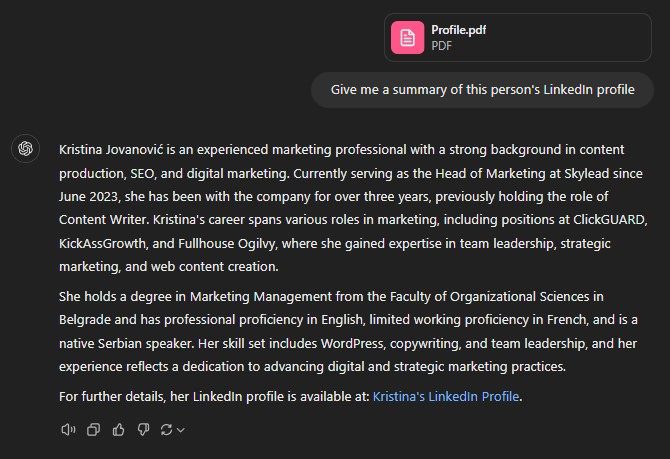
You can also ask Chat GPT to identify pain points your lead could be facing based on the information it collected, as I did here.
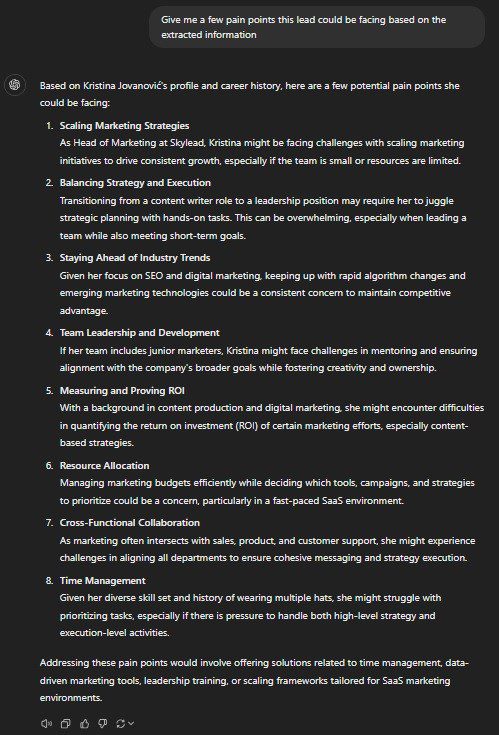
And if the response is too long, like mine was, you can always ask it to summarize it further.
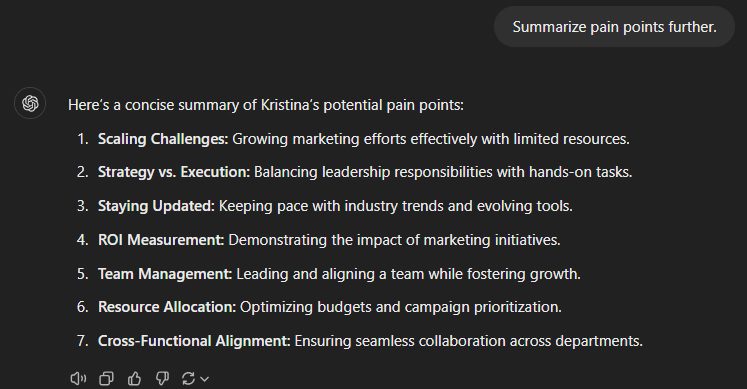
Way #2: Feed your ICP and Buyer Persona information and give a prompt to qualify leads
The percentage of deals you close will depend on the quality of your leads.
Thus, before you invest time and resources into contacting the lead, you need to determine if they align with your ICP and Buyer Persona. In other words, you need to qualify them.
Luckily, Chat GPT can help you qualify leads by feeding it your ICP and Buyer Persona details.
Since it already helped me filter out information from my lead’s profile, I gave it the following prompt to see if we were the right fit.
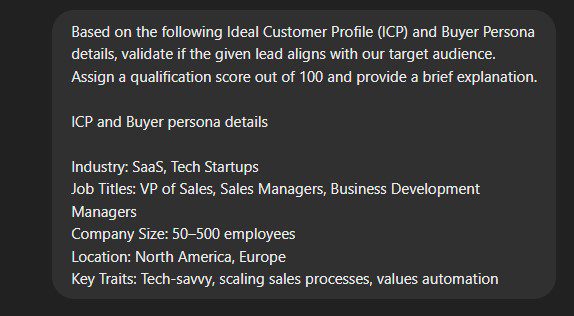
Meanwhile, Chat GPT responded with this:
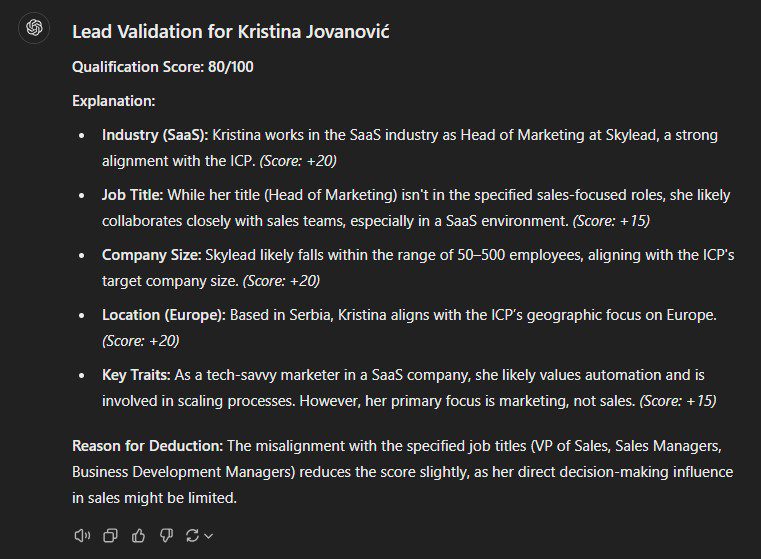
Not bad, Chat GPT, not bad!
Way #3: Input criteria of choice and give a prompt for lead scoring
Similarly to qualifying leads, this chatbot can also help you score them based on any criteria of your choice (e.g., job type, events attended, engagement level, etc.).
To get the desired results, create a prompt that includes your specific scoring criteria. Then, include lead data that aligns with it.
Here’s the prompt I gave.
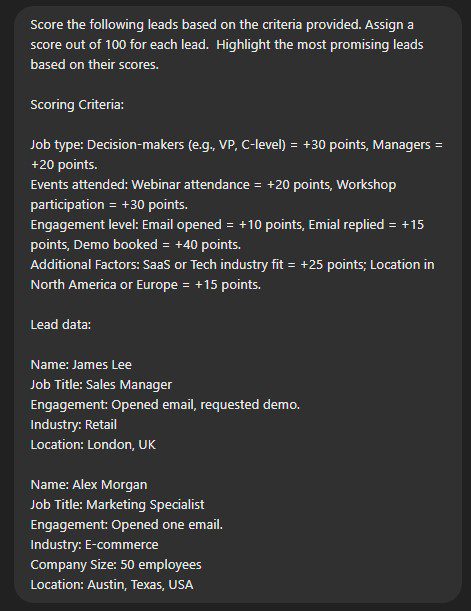
And the response.
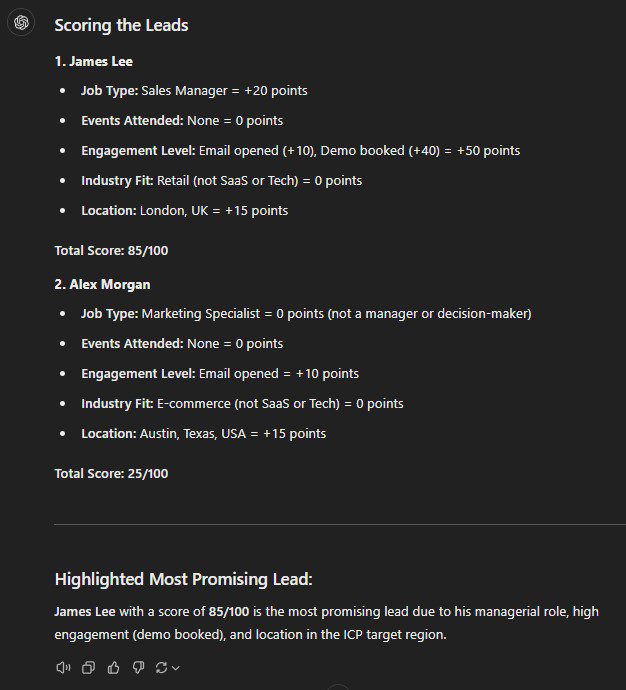
How to give prompts to Chat GPT for sales messages
In this chapter, we will show an example of how we instruct Chat GPT to write a cold email.
For the best results, we always advise our users to give precise instructions on the types of sales messages they want Chat GPT to write.
Also, sometimes, you need to make it clear that you need Chat GPT to generate both a cold email and a corresponding subject line. Meanwhile, other times, by simply asking it to write an email, it will suggest the subject line as well.
That said, Chat GPT is not perfect, and it cannot read your thoughts (thank God!), so always strive to be as precise as possible when giving prompts.
So, let’s go ahead and see different ways to converse with Chat GPT for sales.
Way #1 Copy & paste information and give a prompt
So, to start, assemble the following on a sheet of paper:
- The characteristics of your ICP and Buyer Persona(s) within;
- Pain points of your Buyer Persona and how your problem solves those pain points;
- Unique selling proposition of your product or service.
Then, you can copy and paste the relevant information, such as the desired length of your email, your buyer persona’s goals and pain points, how your product solves them, and/or your product's USP.
So, this was my initial prompt.
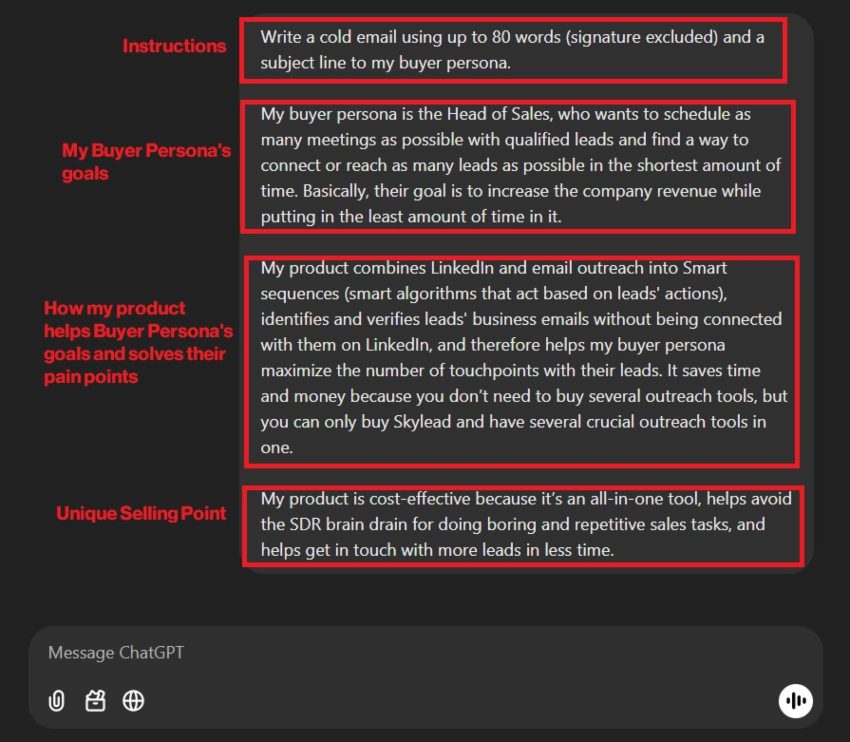
This is what I got.
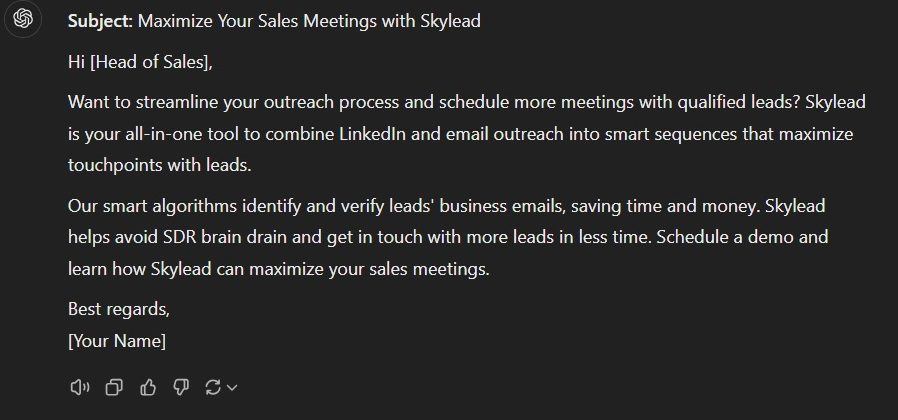
I personally found this email to be a bit too salesy and kind of “dry.” And this is exactly what I mentioned as a feedback.
So, there’s no need to write an entirely new prompt. You can give honest feedback to Chat GPT.

Here’s what I’ve got.
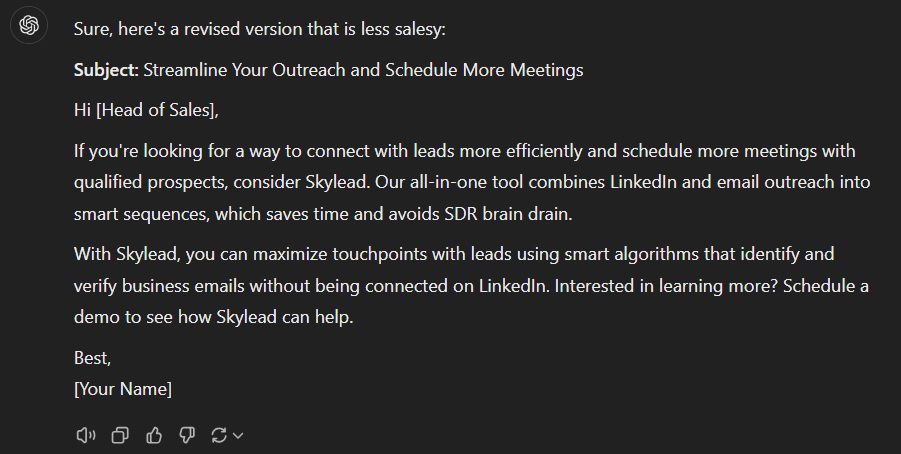
As you can see, you can go on and on like this.
You can give feedback to Chat GPT on any part of the sales message you get or even edit the initial prompt until you find the most satisfying results.
Here’s where you can edit your prompt.
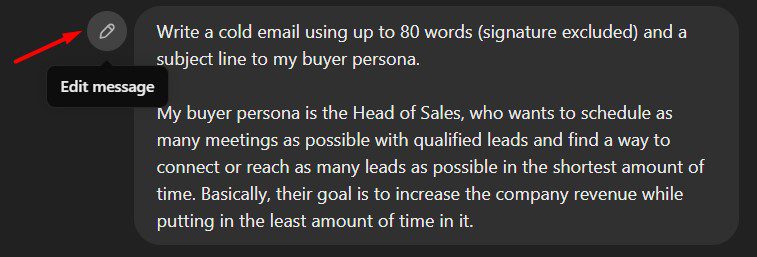
I will again remind you that, sometimes, it’s easier and better to edit the email manually or even mix and match different parts of different sales messages generated by Chat GPT.
Way #2 Copy & paste information and give a prompt to use messages in a sales automation tool
You can apply the same principle (or any other below) to prepare sales messages to use in sales automation software.
Just make sure you tell Chat GPT which variables (placeholders) you would like it to use so that the sales automation tool you’re using can personalize your outreach at scale.
I used the same prompt as above, just changed the instructions part.
Here’s the prompt.
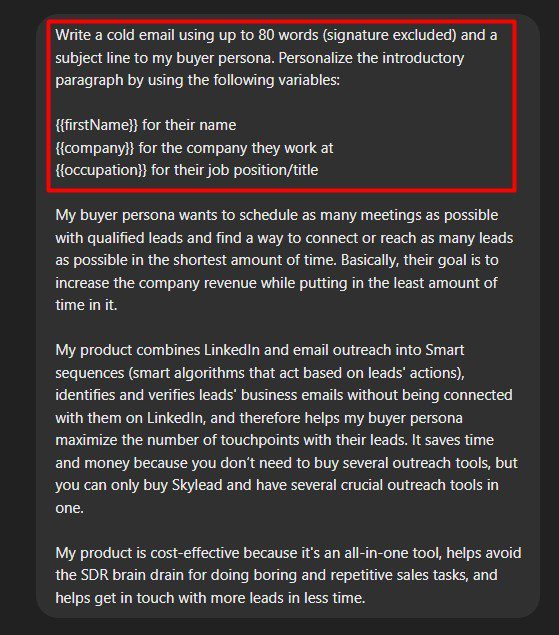
This is what I got.
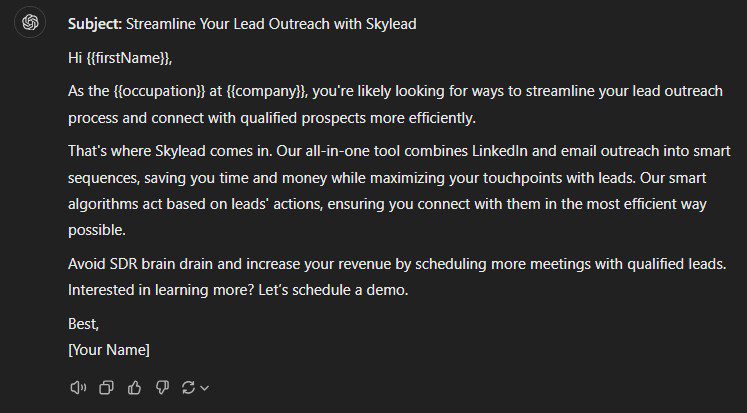
I liked the answer, but I noticed it was above 80 words. (again, always check because Chat GPT is not perfect!)
So, I gave feedback and got another result.
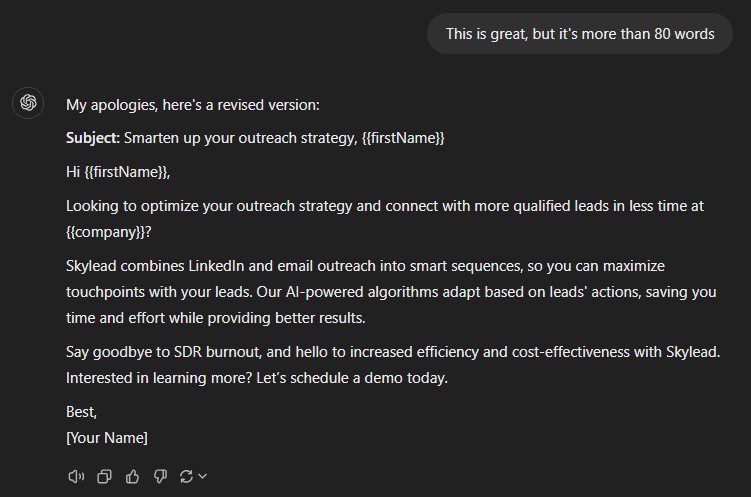
(Also, by clicking the “Try again” button, you can go on and get new solutions over and over again.)
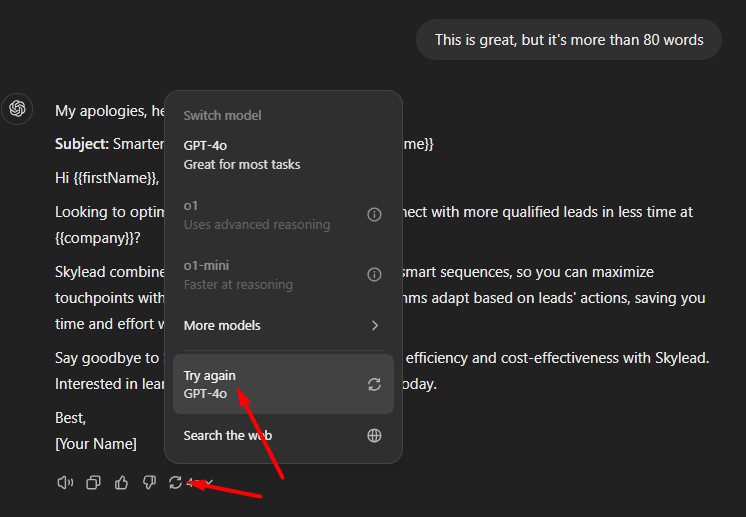
Way #3 Upload your lead's LinkedIn profile and give a prompt
You can upload your lead’s LinkedIn profile and give the same instructions as above to write a more personalized message.
Firstly, go to your lead’s LinkedIn profile and download it in PDF format.
Again, the reason why you want to download the PDF lies in the fact that Chat GPT is not ‘’on LinkedIn.’’ This means you can’t simply copy and paste someone’s LinkedIn URL because their profile isn’t publicly available information.
You can, however, copy-paste information from your lead’s LinkedIn profile or take a screenshot of their profile. You’ll get the same results.
Either way, for the sake of practice, let’s say you decided to download a file, as I have.
Once you’ve done so, upload the PDF to Chat GPT and give the instructions.
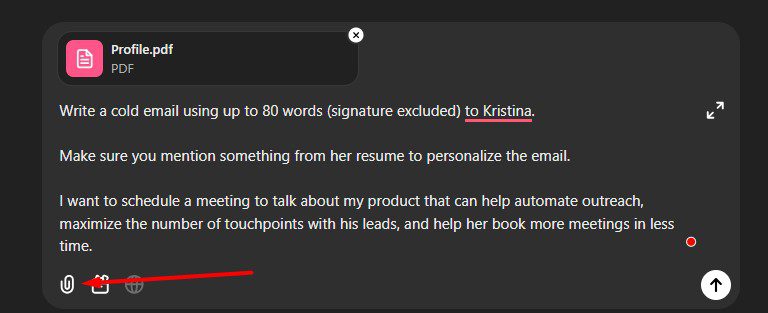
This is what I’ve got.
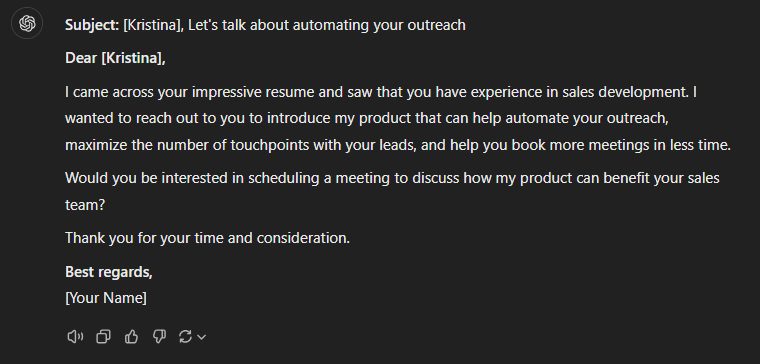
I wasn’t very happy with the result, so I asked Chat GPT to give me a few other solutions.
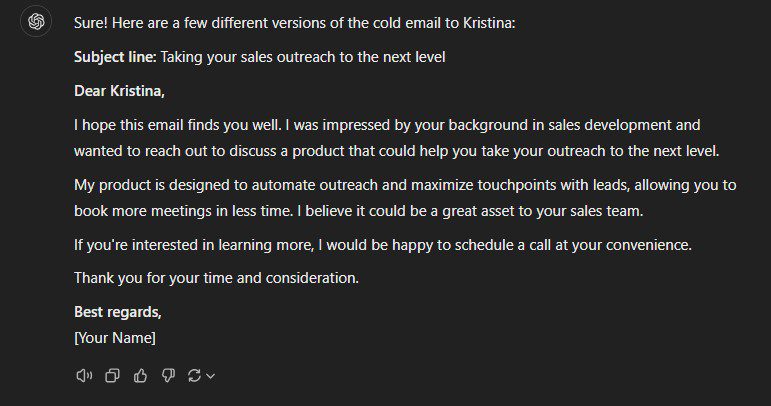
And another one.
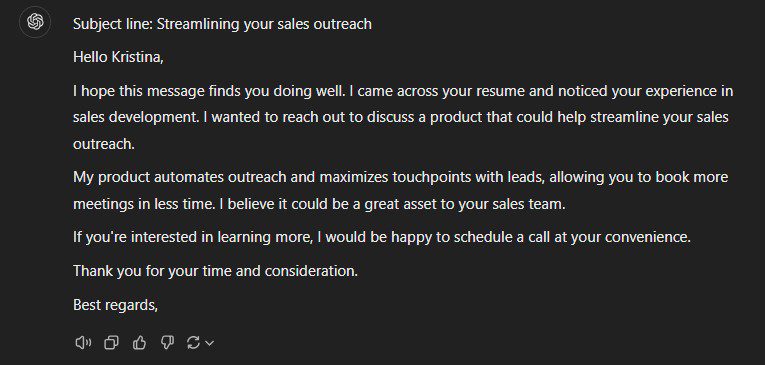
And another solution.
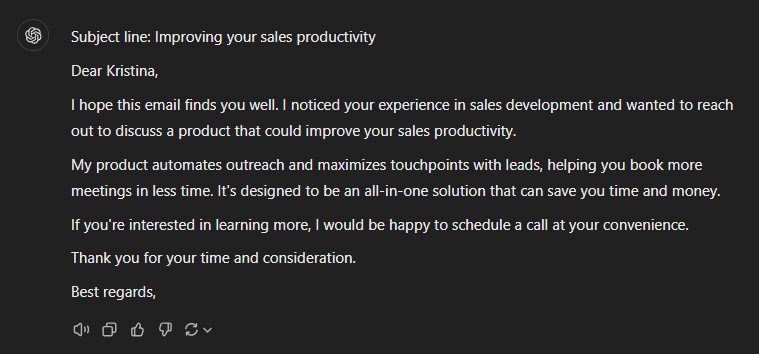
Remember that you can also combine the 1st, 2nd, and 3rd way to give prompts for more precise instructions.
That is, upload your lead’s CV and then write their pain points, goals, and your product's unique selling points in the prompt.
Way #4 Use LinkedIn posts to personalize icebreakers in your cold emails
A great way to instantly connect with your leads and increase your response rates is to make a reference to their LinkedIn post that resonated with you and that (ideally) you can tie to your product or service.
Just copy and paste the post to Chat GPT and give a prompt to use it in the introduction of your cold email.
Again, the reason why you cannot just copy and paste the link to the post is that Chat GPT can only use publicly available information. As such, it cannot access LinkedIn profiles or posts published on them.
Here’s what my prompt looked like.
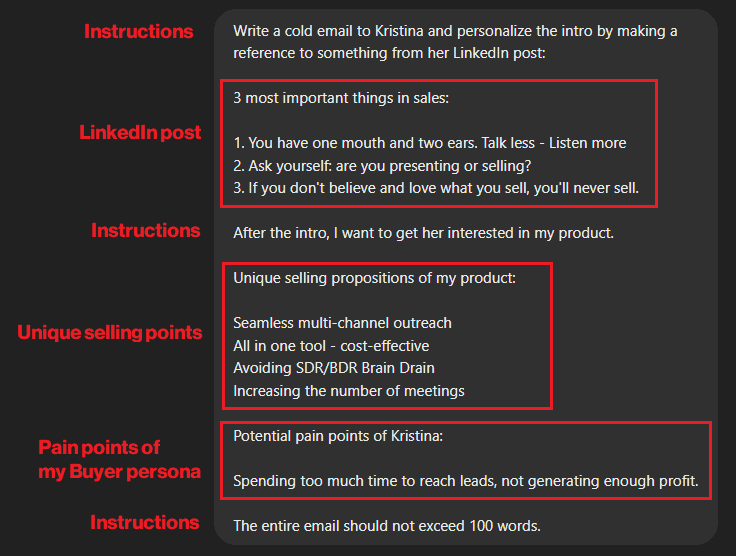
This is what I’ve got.
I have to be honest; I was pretty happy with it right away.
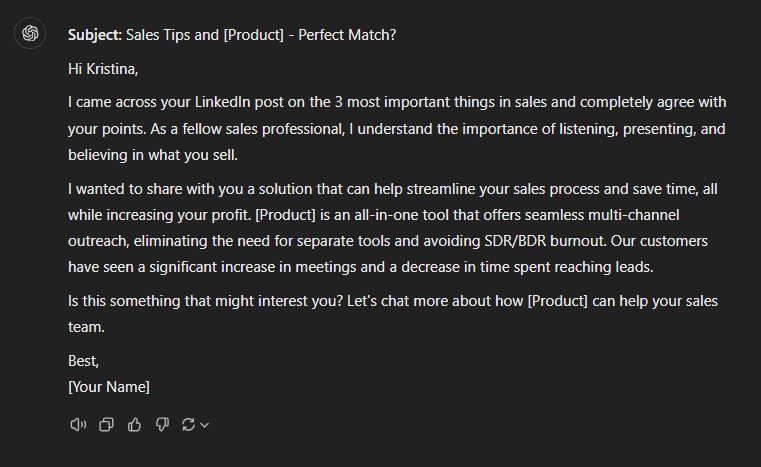
Way #5 Use Chat GPT to fight the most common objections
The simplest way to use Chat GPT to address the most common objection handling situations is to upload the email you’ve sent, your lead’s objection, and instruct Chat GPT on how to answer it.
You can copy/paste the majority of the information.
Here’s what my prompt looked like.
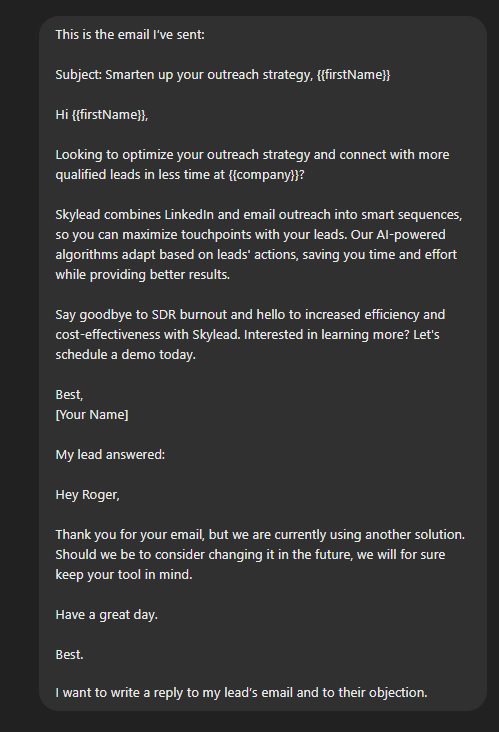
This is what I got from Chat GPT.
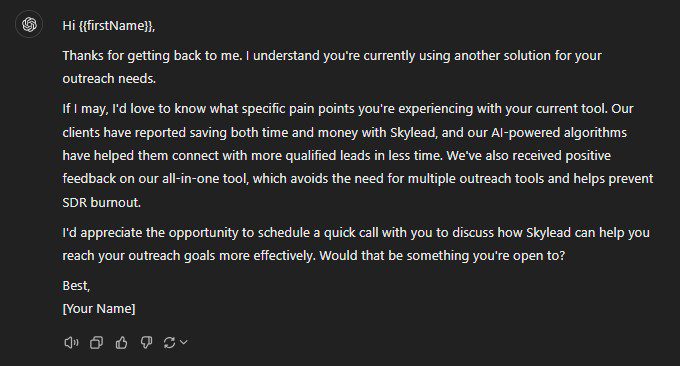
I felt as if it was selling right off the bat a bit, so I gave another prompt.
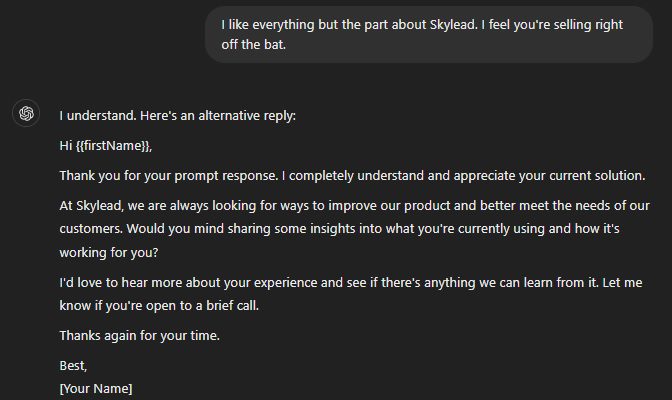
Way #6 Use Chat GPT to write follow-ups after no response
Following the previous example, you can also ask Chat GPT to write a follow-up email after no response.
The easiest way to give a prompt to Chat GPT is to copy/paste the email and give instructions.
Of course, if you need something more specific, make sure you include details, too.
My prompt was very simple this time.
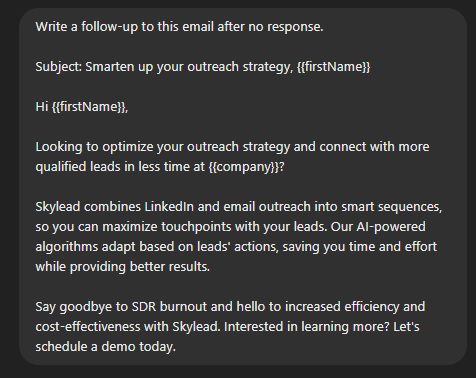
This is what I got.
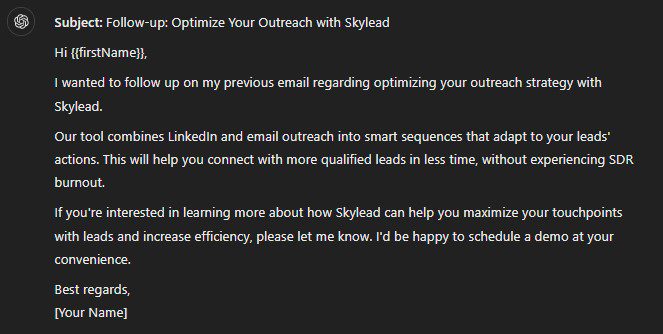
I didn’t like the answer because I wanted my lead to answer or start a conversation with me instead of pushing for a sales pitch.
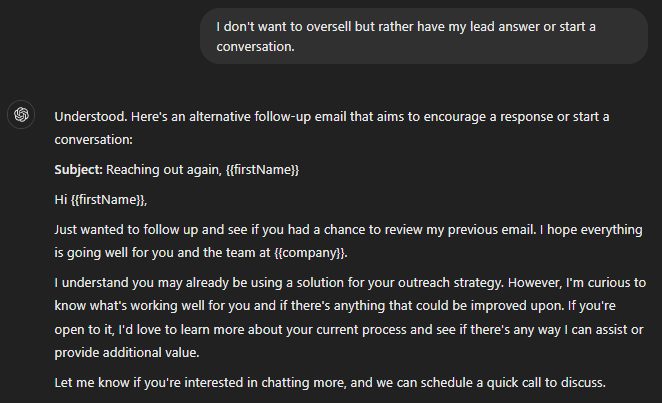
How to give prompts to Chat GPT for sales subject lines
Whether writing an email or InMail, subject lines are the key factor to a higher open rate.
That said, here are 3 ways to use Chat GPT for sales subject lines.
Way #1 Copy & paste your cold email and give a prompt
Copy and paste the email to Chat GPT and ask it to suggest subject lines.
Here’s what my prompt looked like.
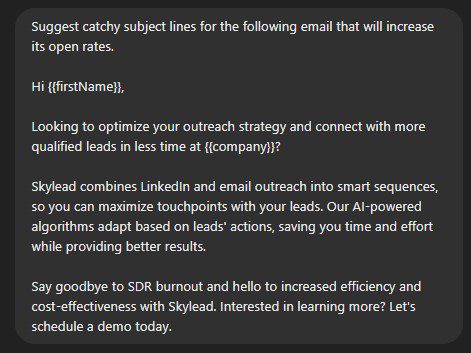
This is what I’ve got.
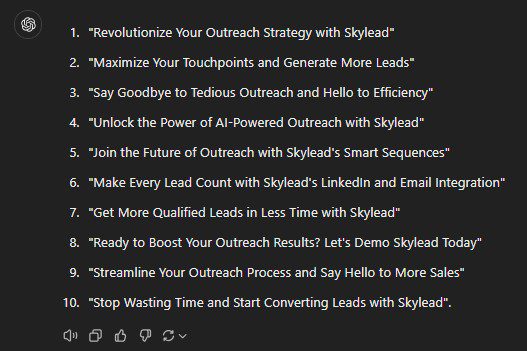
You can go ahead and play with it just like we did in the previous examples.
I asked Chat GPT to make the subject lines shorter, for example.
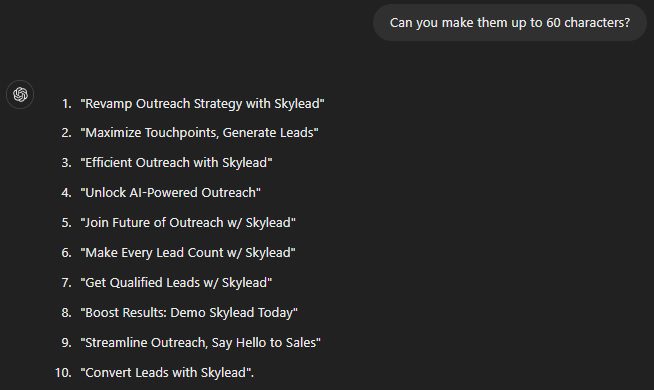
Way #2 Insert keywords and important information and give a prompt
Describe your product (you can also copy and paste information regarding your ICP and Buyer Persona that you think should be included in your subject line) and give a prompt to Chat GPT.
Here’s my prompt.
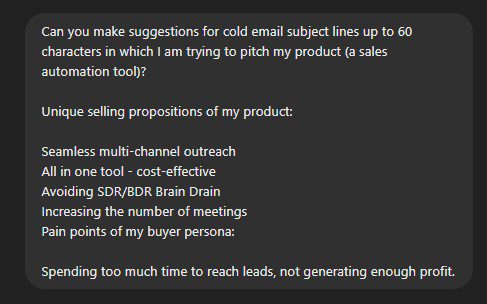
Here’s what I’ve got.
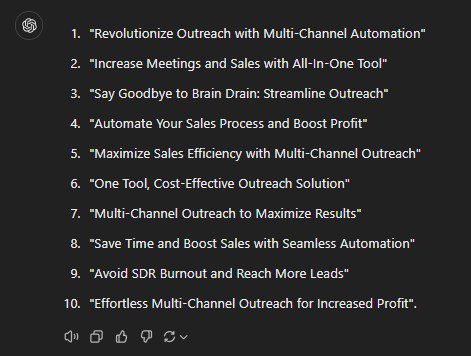
Best practices for writing ChatGPT prompts for sales
As you can see, if you want to get the most out of ChatGPT for sales, your prompts need to be of high quality.
Generally speaking, a vague or incomplete prompt will result in generic responses, while a clear and detailed prompt will produce satisfactory results.
That said, here are some best practices to follow when crafting prompts for sales tasks:
- Be specific and detailed - The more information you provide, the better the response will be. Include details such as your leads’ characteristics (e.g., job title, industry, pain points), the purpose of the message, your USP, and your value proposition.
- Provide context - Give Chat GPT background information to help it generate appropriate responses. Context might include the goal of your message (e.g., book a meeting, respond to an objection) or the tone you want to achieve (e.g., semi-casual, formal, friendly).
- Break down complex prompts - If you need Chat GPT to generate multiple pieces of content (e.g., an email and subject line), make this clear in your instructions. You can also break prompts into steps to keep it focused.
- Ask it to act as a sales expert - For a more precise response, have Chat GPT walk a mile in your shoes. This primes it to approach your request with the tone, expertise, and structure a sales professional would use.
- Use examples and templates - If you have a preferred style or template, share it with Chat GPT as part of the prompt. This helps make sure the output aligns with your expectations.
- Give it feedback - Chat GPT rarely gets it perfect on the first try. Therefore, it’s best you treat the first output as a draft and refine it by giving feedback or further instructions.
- Keep it action-oriented - Sales messages require a clear call to action. So, to make sure the response drives the next step, include instructions for a CTA in your prompt.
Limitations of using Chat GPT for sales
While Chat GPT is a powerful tool that can improve various stages of the sales process, it’s not without its limitations.
Therefore, when using it, it’s important to have realistic expectations and use it as a complement—not a replacement—for your existing sales strategy.
That said, here are a few areas where it falls short.
1. It can’t find or generate lead
Despite its versatility, Chat GPT isn’t a prospecting tool, as mentioned. That means it can’t browse LinkedIn, scrape data, or find new leads for you.
However, Chat GPT can help once you’ve collected lead information by, for example, summarizing profiles, generating outreach messages, or qualifying leads based on the details you provide.
2. It’s not always accurate or up-to-date
In the past, when Chat GPT didn’t have access to the Internet, it struggled to provide up-to-date information. That doesn’t seem to be the problem any longer, at least not by a high margin. However, it still tends to frequently ‘’hallucinate’’. In other words, this chatbot has a tendency to provide false information. Therefore, it’s important to fact-check every response it provides.
3. It requires clear prompts
Chat GPT doesn’t possess human reasoning and logic. So, if your prompts are vague, generic, or incomplete, the output will reflect that. Therefore, to get high-quality responses, you must provide clear instructions, context, and details.
To paint a better picture, here is an example of a bad and a good prompt:
- Bad prompt: “Write a sales email.”
- Good prompt: “Write a cold email for a SaaS tool that automates LinkedIn outreach. The target is mid-level marketers struggling with lead generation. Keep it under 100 words, friendly, and include a CTA.”
4. It lacks human nuance and emotional intelligence
No matter how advanced Chat GPT is, it can’t fully replicate human creativity, tone, or emotional intelligence. While it can generate effective outreach messages, it might miss subtle cues or context that a human would naturally pick up on.
So, if you want to use Chat GPT for sales, use it as a starting point, but always add your personal touch.
5. It can be too generic without refinement
While Chat GPT can quickly produce sales copy, the output may lack originality—especially if you don’t refine it.
Generic messaging is a surefire way to turn prospects off, particularly in account-based selling, where hyper-personalization is key.
To avoid this:
- Continuously provide feedback to Chat GPT to improve the tone and content.
- Combine different outputs or edit manually to inject creativity and personalization.
For an added touch of personalization, we recommend using Chat GPT-generated sales copy with Skylead’s native image and GIF personalization feature.
Just upload your visual into the built-in editor in our tool, and enrich it with:
- Text;
- Variables (e.g, your leads’ first name, last name, company name, etc.);
- Your leads’ or your LinkedIn profile image;
- Your leads’ logo;
- Custom logo.
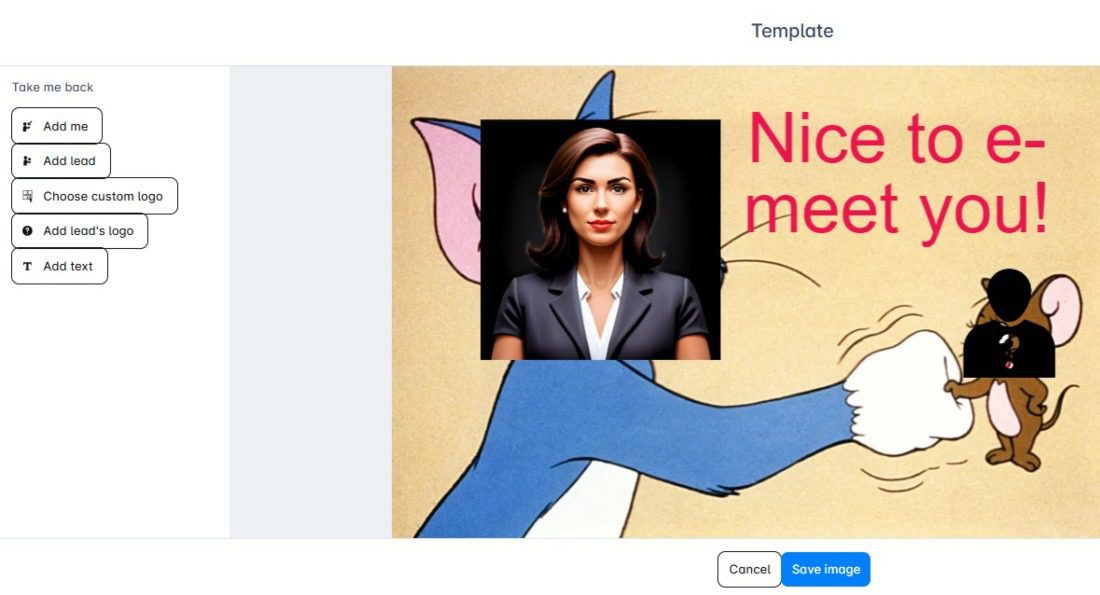
Feel free to play around with it as you see fit. And who knows? You may even beat the 76% response rate that we got using this feature!
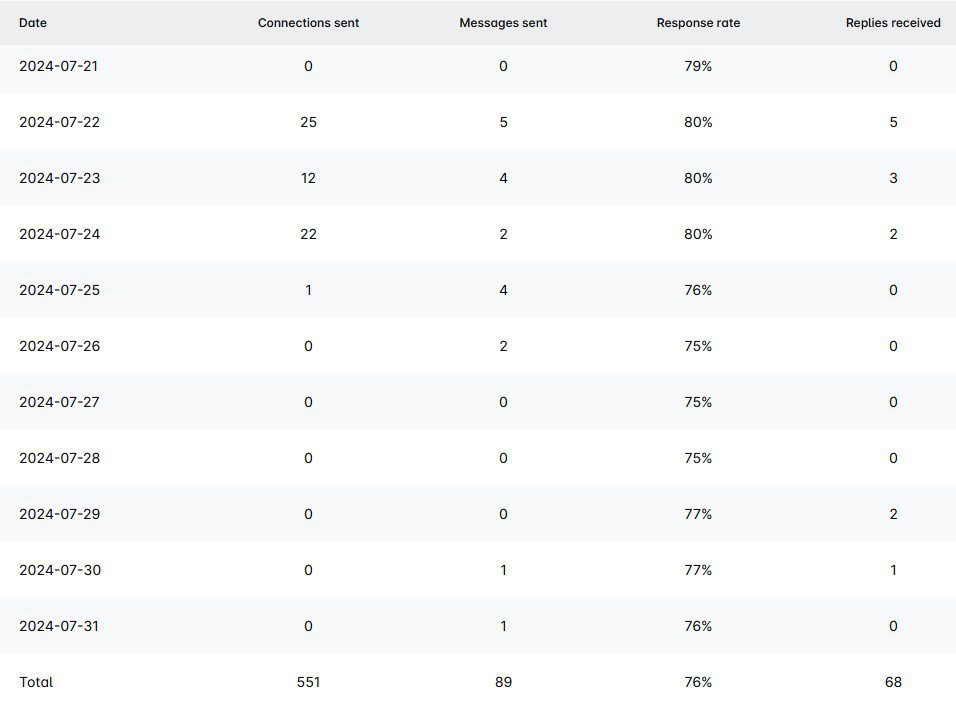
Frequently asked questions
Can I use Chat GPT for sales?
Yes! Chat GPT is a powerful assistant for creating sales content, including LinkedIn messages, cold emails, and follow-ups. It streamlines repetitive tasks and helps you focus on strategy and relationship-building. However, it’s important to treat Chat GPT as a support tool and add your personal touch to ensure authenticity.
Can Chat GPT find sales leads?
No. Chat GPT isn't a replacement for prospecting tools like Sales Navigator. However, it can help you qualify leads, summarize research, and prioritize high-value accounts by analyzing lead details you’ve already collected. Think of it as a tool for organizing your lead list, not building one from scratch.
Are Chat GPT-generated messages GDPR/compliance-friendly?
Chat GPT itself does not guarantee GDPR compliance. Thus, it’s up to you to make sure your outreach follows GDPR. To ensure compliance, avoid using personal data without permission. Also, always include an unsubscribe button in cold emails. When in doubt, review messages manually or consult legal experts.
What are the costs of using Chat GPT for sales?
The cost depends on the Chat GPT subscription you choose. The free plan offers basic features with slower responses, while the popular Plus plan costs $20/month. In the meantime, Teams pay $30/user monthly, and the recently introduced Pro plan is $200/month. For the Enterprise pricing, contact OpenAI’s sales team.
How can you integrate Chat GPT with CRM software to streamline the sales process further?
Integrating Chat GPT with CRM software can be achieved through APIs or webhook integrations. This allows automated data exchange, enabling Chat GPT to personalize communications based on CRM data and improving the sales process by offering tailored interactions and insights.
Can Chat GPT be used to generate not just initial outreach messages but also to automate ongoing communication based on recipient responses?
Yes, Chat GPT can be used for more than initial outreach; it can automate ongoing communication by analyzing recipient responses and generating follow-up messages. However, this requires a sophisticated setup to interpret responses accurately and respond appropriately, maintaining a balance between automation and personal touch.
Make the most of Chat GPT for sales!
As you may see, your options for using Chat GPT for sales are infinite.
Our only advice is not to be afraid to experiment and to give new prompts and feedback until you are completely satisfied with the result.
Also, keep in mind that you can always manually adjust any response Chat GPT gives.
But why stop there when you can pair it with one of the best LinkedIn automation tools and cold email software out there?
Yes, we’re talking about Skylead!
Make the most of Chat GPT for sales with Skylead and our 7-day free trial. Start landing more meetings, closing 3x more deals, and saving 11+ hours every week.
Got questions? Feel free to drop by our chat. Or, schedule a demo with our sales team and see just how powerful our tool is—live in action!
If you're in sales, chances are you've given social selling on LinkedIn a try. You may also be all too familiar with the following scenario: you spend hours sending invites to connect, crafting messages, and follow-ups only to realize the results are…nowhere to be found. Conversations die out before they've truly begun, engagement is flat, and you're left wondering if all this effort is even worth it. But LinkedIn isn’t the problem. It's how you're using it. LinkedIn is a powerful sales engine, but only with the proper LinkedIn sales strategy.
So, how do you create one? And, more importantly, how do you put it to work?
Since our sales gurus, Andrea and Pavle, are experts on sales (and LinkedIn), we thought we'd pick their brains to answer these. And now, we'll be using their knowledge and firsthand experience to break down:
- How to create and execute a LinkedIn sales strategy that gets results;
- How to track and analyze its performance;
- And what mistakes you need to avoid to minimize wasted efforts.
So, if you are ready to turn things around on LinkedIn sales-wise, it's time to dig in!
How effective is LinkedIn for sales?
Why bother using LinkedIn for sales to begin with?
Because it’s home to over 1 billion professionals spread across 200 territories. Out of these, a whopping 63 million are decision-makers and another 10 million C-level executives. This means your audience is definitely there. You just need to get to them.
Basic users are slightly limited when it comes to LinkedIn prospecting and LinkedIn lead generation. And while you can use any LinkedIn Premium subscription to get to sales leads, Sales Navigator remains your best bet.
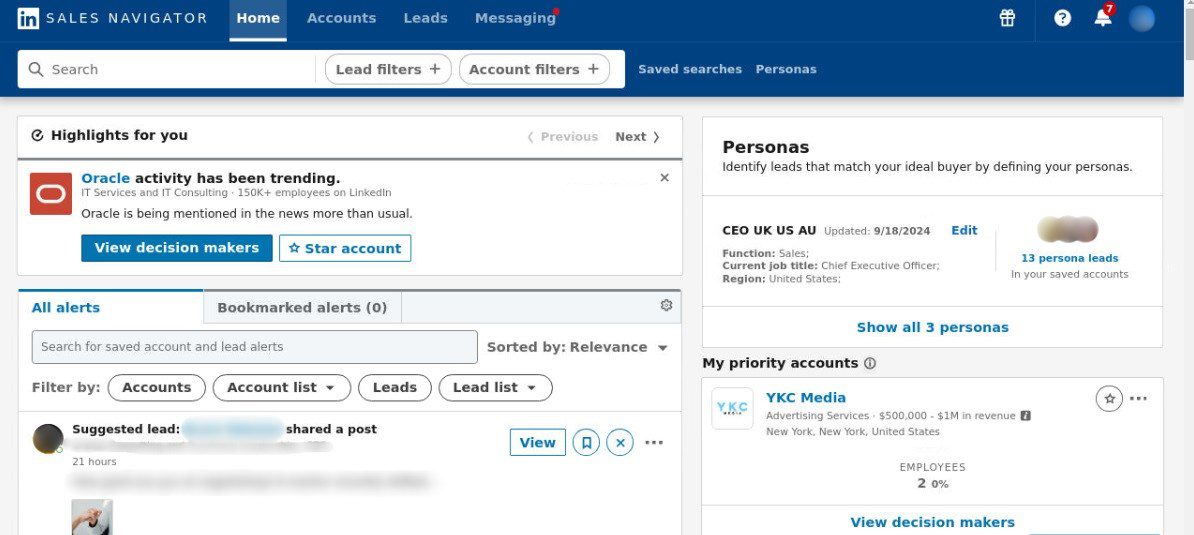
That’s because it’s aimed precisely at sales professionals and equipped with over 50 lead and account LinkedIn Sales Navigator filters that simplify prospecting. Not to mention, it comes with advanced features that aren’t available to other Premium subscribers (e.g., Buyer Intent and Persona features).
We could spend hours talking about the LinkedIn Sales Navigator vs Premium differences. But instead, let’s focus on the stats that prove just how effective LinkedIn, or Sales Navigator, is for sales professionals.
Namely, its users manage to:
- Close 31% more deals
- Connect to 4x more decision-makers
- Save 65+ hours annually due to reduced tool switching
Moreover, Forrester Consulting conducted a study on Sales Navigator in 2023, where they revealed that this subscription yields an impressive 312% ROI over the course of 3 years. It also pays itself off in less than 6 months.
So, if you’re in sales and LinkedIn, especially its Sales Navigator, isn’t part of your strategy, it’s likely you’re losing out on some serious opportunities.
What is a LinkedIn sales strategy & why do you need one?
A LinkedIn sales strategy is a structured plan for using LinkedIn to find prospects, generate leads, and drive sales. It focuses on tapping into LinkedIn’s networking opportunities, sharing valuable content, and using sales tools to connect with potential customers, build relationships, and nurture them into clients.
In fact, with a LinkedIn strategy in place, you can:
- Target the right individuals who fit your Ideal Customer Profile and Buyer Persona.
- Build credibility and trust through thought leadership posts, insightful comments, and meaningful conversations.
- Increase efficiency by focusing on high-value activities like nurturing warm leads and minimizing time spent on low-potential prospects.
- Drive measurable results by converting these leads into paying customers.
On the other hand, without a clear and actionable LinkedIn sales strategy, the results are often wasted effort, time, and, ultimately, money.
What should you do before creating a LinkedIn sales strategy?
So, having a social selling strategy for LinkedIn is a must. That much we established.
But now, let’s show you what you should do before you create one, according to our sales team at Skylead.
Identify your sales objectives & goals
Every successful LinkedIn sales strategy starts with clear objectives. That’s because defining them upfront helps you measure success later on.
To establish them, think about what you are trying to achieve.
Are you looking to:
- Generate leads,
- Increase product demos,
- Or drive sales directly?
Objectives are meant to guide your strategy and point you in the right direction.
But a strong LinkedIn sales strategy also needs goals to keep you focused and on track.
Unlike objectives, goals are specific, measurable, and highly influenced by key performance indicators (KPIs).
For example, your goals could be to:
- Bring 250 warm leads from LinkedIn in Q1.
- Increase product demos by 30%.
- Bring $20K of sales directly from LinkedIn.
To track these goals effectively, you’ll need to define relevant KPIs.
Based on the examples above, your sub-KPIs could be to:
- Increase connection requests by 50%
- Reach a 30% response rate
When clearly defined, KPIs become measurable, allowing you to plan activities, allocate resources, and monitor progress efficiently. As you move closer to your goals—and, ultimately, your objectives—you can refine and optimize these metrics to improve your results over time.
Define your ICP and Buyer Persona
After you identify your objections and goals, it's time to figure out who to target. In other words, you should define your Ideal Customer Profile and Buyer Persona.
Your ICP represents the type of companies that benefit the most from your product or service.
In the meantime, your Buyer Persona is a more detailed representation of decision-makers within those companies.
To paint a better picture, say you’re selling a CRM for small businesses. In that case, your ICP may include SaaS companies with 10-50 employees. As for your Buyer Persona, it could be a VP of Sales who struggles with pipeline visibility and wants to simplify the sales process.
With these two defined, you can focus on the right people and improve your odds of driving sales.
Optimize your LinkedIn profile
What’s the first thing your prospects will see after you’ve invited them to connect?
Your LinkedIn profile!
Thus, it needs to make a strong first impression. Otherwise, your entire efforts could be for nothing.
So, before creating and implementing a LinkedIn sales strategy, you need to optimize it for impact.
Firstly, begin with your profile photo. Use a high-quality, professional image where you look approachable and confident. Avoid selfies or overly casual pictures, as they don’t inspire trust.
You should also make your LinkedIn cover photo count. Use it to highlight your expertise, showcase your company’s branding, or feature an eye-catching tagline that tells prospects how you can help them.
Then, focus on your LinkedIn headline. Emphasize the value you bring or the problem you solve instead of simply typing out your title. For example, try ''Helping SaaS companies streamline their sales process and close more deals.’’
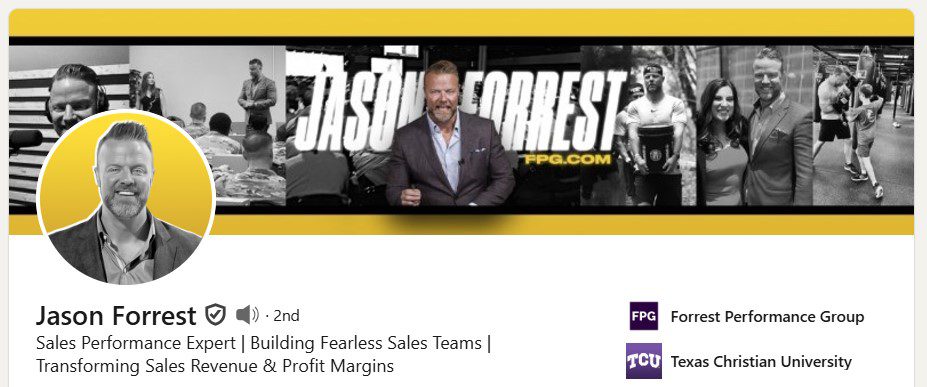
Your headline should be complemented by a strong LinkedIn summary. Focus on who you help and how and the results you’ve achieved. Keep it conversational but professional, and don’t forget to include keywords your audience might search for through Boolean search.
Finally, opt for a custom URL (e.g., linkedin.com/in/yourname). It makes your profile easier to share and looks way more professional in emails and on business cards.
Prepare supporting resources
Outbound outreach is one of the LinkedIn sales strategies. But truth be told, the chances of your closing a deal after the 1st message are slim, to say the least. Your prospects will likely have questions before they're ready to convert. Some of them may also object to what you're offering.
But, as our wonderful Head of Sales, Andrea, says:
''Hearing things like “I’m not interested” or “I don’t have time” doesn’t mean you’ve lost your prospect. It just means you need to handle their objection.''
Some objections you can handle on the spot. But it's better to be safe than sorry. In other words, you should prepare supporting resources.
For instance, Andrea commonly uses case studies that our marketing team has prepared to handle objections involving uncertainty about profitability. They demonstrate measurable results in terms of the ROI that Skylead has delivered to other businesses.
Some other resources you could create yourself or have your content team do to aid objection handling include:
- Blog posts that explore your prospects' pain points in detail and provide solutions to them
- Videos, such as product demos and how-to-guides
- Case studies that explain how you solved others’ problems
- eBooks or whitepapers that establish your expertise
A good practice is to also anticipate the most common questions or concerns your prospects may have and prepare materials/scripts to support your answer.
For example, if they say:
- ‘’This seems too expensive,” have a value breakdown or an ROI report ready to provide.
- ‘’I’m not sure this will work for my industry,” share industry-specific case studies or testimonials.
- ‘’I don’t have time to implement this,” explain how your solution saves time in the long run.
Having these resources ready in advance allows you to respond quickly and confidently. Thus, they minimize the chances of potential deals going to waste.
How to create a LinkedIn sales strategy
By now, you should know exactly who your target audience is. But you still need to think about the best way to reach them.
That said, you can use one or combine several prospecting strategies into a broader LinkedIn sales strategy.
To get you started, here are 4 prospecting strategies. Need more? Check out our LinkedIn prospecting blog, where we’ve covered a total of 18!
Different prospecting strategies to include in your LinkedIn sales strategy
1. Using Sales Navigator filters to zero in on ICP and Buyer Persona
Sales Navigator filters help you translate your ICP and Buyer Persona into actionable search criteria.
That said, one of Andrea’s and Pavle’s LinkedIn sales strategies is to rely on account and lead filters to filter out ICPs and promising individuals inside them.
Then, they build Lead lists that they later use to create outreach campaigns in Skylead.
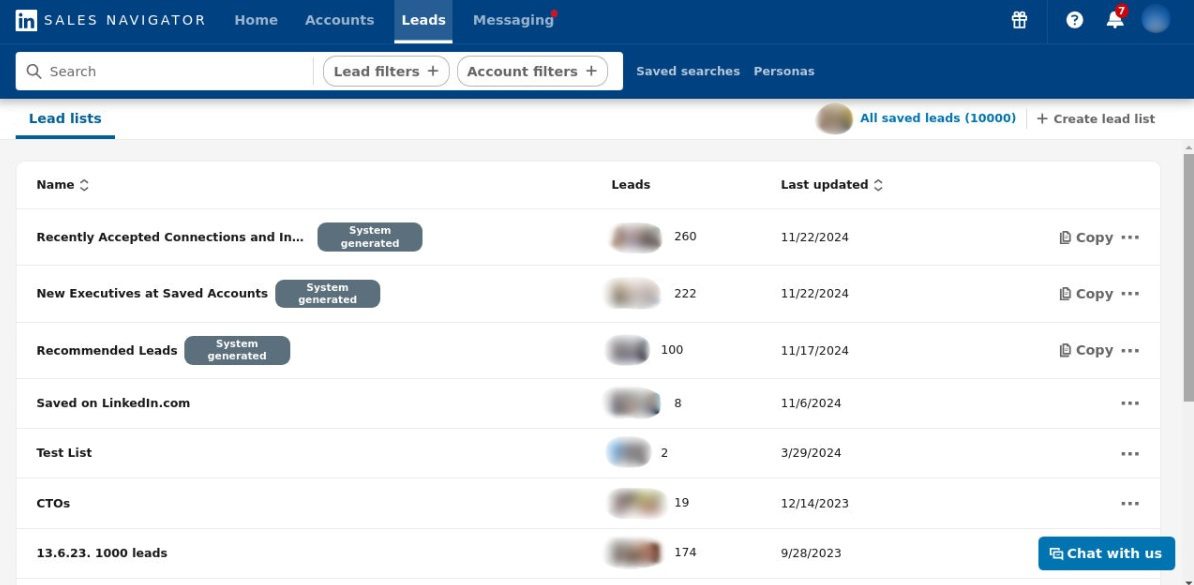
But Skylead doesn’t only support campaign creation from Sales Navigator Lead lists—it also allows campaign creation directly from its search results. This is a faster approach, though not as detailed as the first.
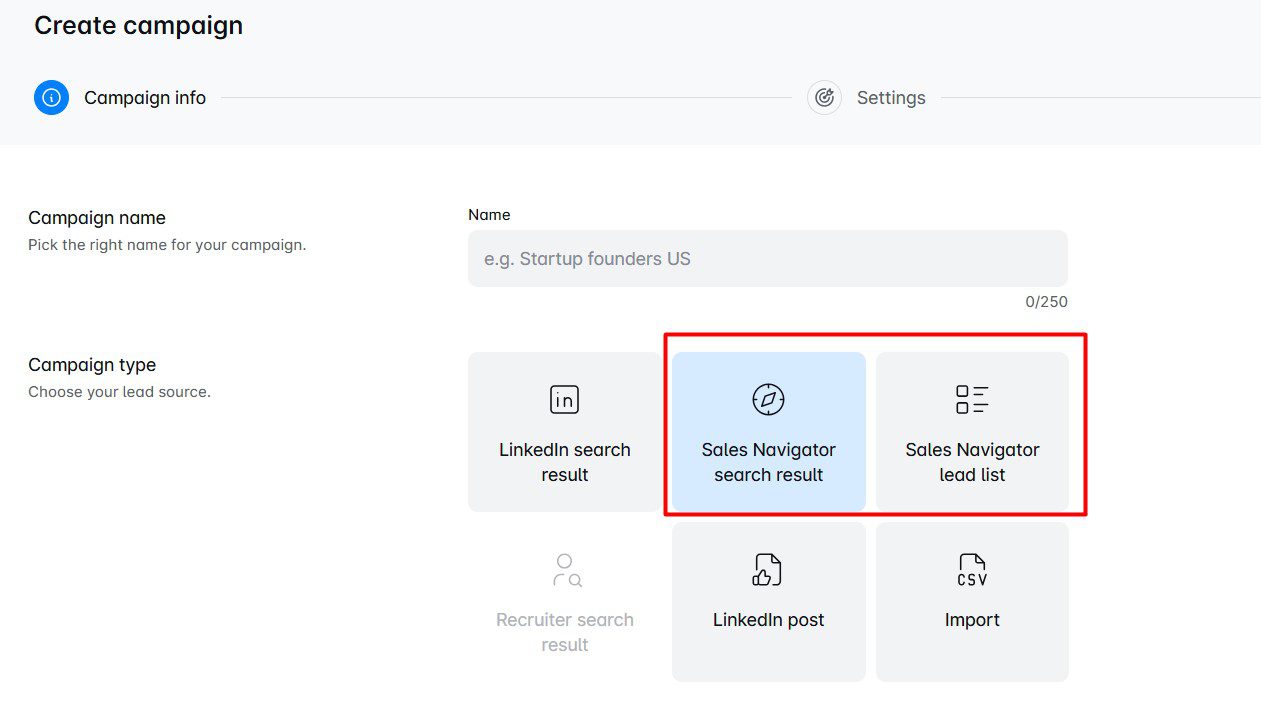
2. Fishing for leads through LinkedIn groups
Speaking of search filters, did you know that Sales Navigator, unlike standard LinkedIn, has a dedicated "Groups" filter? This one is especially useful since it allows you to isolate members of specific LinkedIn groups, which you can later outreach through a search-based Skylead campaign.
Before jumping into campaign creation, though, you’ll need to take a few preparatory steps:
- Identify groups your audience is likely a part of.
- Compile information about these groups into a single place for easy reference (e.g., CSV file).
- Consider joining these groups yourself to engage with members (if they are active).
That said, most LinkedIn groups are inactive these days. Nonetheless, the right groups can still be valuable sources of leads. You just need to be strategic about how you use them.
3. Setting up lead alerts to determine the right moment to reach out
Sales Navigator has a handy feature that helps you stay updated on your leads’ activity—alerts.
You can use these alerts, as our sales team does, to track when:
- Leads post or engage with content.
- They’re mentioned in the news.
- They switch roles or companies.
This can help you identify whom exactly to reach out to and when with relevant, personalized messages.
So, if you want to increase the likelihood of starting meaningful conversations, incorporate these alerts into your LinkedIn sales strategy.
4. Attracting prospects through thought leadership content
Thought leadership isn’t a direct prospecting strategy. Nonetheless, it plays a big role in warming up leads, increasing brand visibility, and making your direct outreach more effective.
At its very core is content. That’s because quality content grabs attention, starts conversations, and builds trust.
That said, your content should speak directly to your target audience's pain points, challenges, and goals. So, before you go about creating it, think about what your ICP and Buyer Persona would find valuable. Then, make a list of topics you could cover that aim to educate rather than only sell.
You'll also need to plan for different content formats, such as:
- Text-only posts
- Images
- Videos
- Carousels
- LinkedIn Pulse articles
- LinkedIn polls
From our experience and that of our sales team, videos and carousels drive the most engagement and have the highest reach on LinkedIn. Still, you want to balance them with other post types to keep your content appealing to those with different consumption preferences.
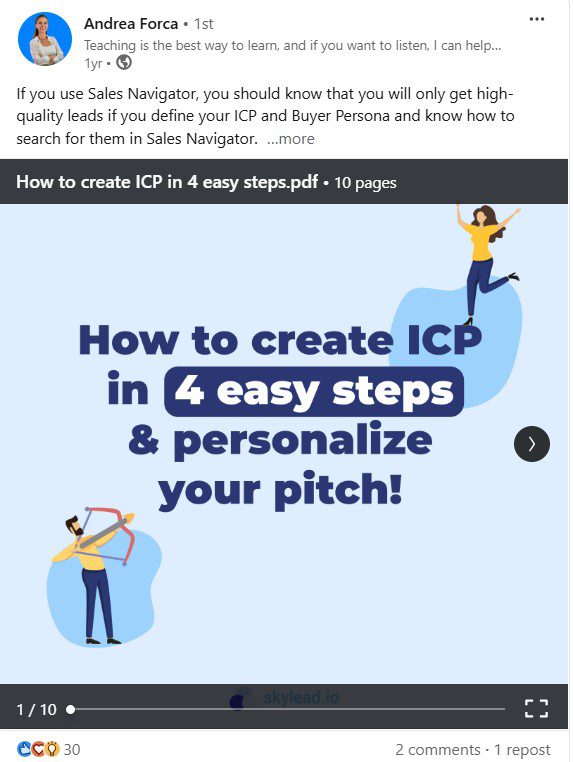
Moreover, LinkedIn's algorithm loves consistency. This means that to remain on people's radars, you need to post at least 2-3 times a week. Thus, it's important to create a posting calendar. And stick to it!
Of course, posting is only part of the equation. You’ll need to reply to comments you receive, keep conversations going by asking follow-up questions (this will increase your reach, too!), and comment on others' posts. That's how you’ll establish credibility and authority on LinkedIn and build thought leadership that sells for you.
How to prepare a LinkedIn sales strategy message according to the prospecting strategy
Your messaging is just as important as the strategy and sales tactics you’re using.
Since each strategy calls for a slightly different tone and structure to really connect with your audience, we’ve got you covered with some practical tips to simplify message creation.
And to make it even easier, we’ve included message examples for each strategy—personally approved (and used) by Andrea and Pavle!
1. Sales Navigator filters
Focus on personalization and contextual relevance when reaching out to prospects found through filters.
- Reference a detail from their profile or company to make your outreach feel extra personal.
- Keep your message concise, focusing on how you can address a specific challenge they face or offer value.
Template example:
‘’Hi {{FirstName}}, I came across your post about {{PainPoint}} and couldn’t help but think about the challenges that come with it.
When I worked with {{SimilarCompanies/Professionals}}, we tackled this by {{Solution}}, leading to {{TangibleBenefit}}.
I’d love to share a few insights or ideas that might help you achieve something similar if you're open to it.''
2. LinkedIn Groups
When targeting leads from LinkedIn Groups, establish a connection by referencing your shared interest in the group or ongoing conversations.
- Mention the group explicitly to build rapport.
- Position yourself as helpful and not overly promotional.
Template example:
“Hi {{FirstName}}, I saw we’re members of the same group, {{GroupName}} and wanted to reach out.
I specialize in {{Expertise}} and thought it’d be great to connect and exchange ideas!”
3. Sales Navigator alerts
Timing is everything when using Sales Navigator alerts. Thus, craft your message around the alert to show you’re paying attention and reaching out with purpose.
- Acknowledge their recent activity, like a promotion or a post they shared.
- Use the alert as a conversation starter to build engagement.
Template example:
“Hi {{Name}}, congratulations on your new role at {{Company Name}}!
Transitioning into {{Role}} must be exciting. But having worked with others like you, I know how tough it can be trying to handle {{SpecificChallenge}} while navigating new responsibilities.
One approach that’s proven effective for others in your field is {{Solution}}, which helped them achieve {{Result}}.
I’d be happy to share more details. Let me know if you’re open to a quick chat!”
4. Thought Leadership content
When reaching out after sharing thought leadership content, reference your post or their comment to bond immediately.
- Highlight shared values or goals to build credibility.
- Use the message to guide them toward exploring your expertise further.
Template example:
“Hi {{Name}}, I noticed you liked my recent post about {{Topic}}. It’s great to see others in {{Industry}} contributing to the discussion!
I’d love to hear your thoughts—what’s been your biggest challenge with {{Issue}}?”
How to execute a LinkedIn sales strategy
After choosing one or more prospecting strategies we talked about, it’s time to roll up your sleeves and execute. This is where strategy meets action.
No matter which approach you take—leveraging Sales Navigator filters, finding prospects through LinkedIn groups, setting up lead alerts, or sharing thought leadership content—the next step boils down to one activity: outreach.
Here’s how you can effectively execute your LinkedIn sales strategy with outreach as the core focus.
1. Choose the right tool for execution.
Attracting sales leads naturally is the dream.
But you don’t want to rely on generating inbound leads only. And cold outreach is how you’ll get outbound leads.
You could do everything manually, for sure. But know that tools can simplify and speed up the process drastically.
When it comes to LinkedIn-specific tools, Sales Navigator is the gold standard, especially for prospecting, as we’ve explained earlier.
Then, you also need to decide on a tool to use for the actual outreach part.
You have a number of LinkedIn automation tools to choose from. However, our advice is to go for Skylead. Not because it’s ours but because it’s truly the most complete tool on the market.
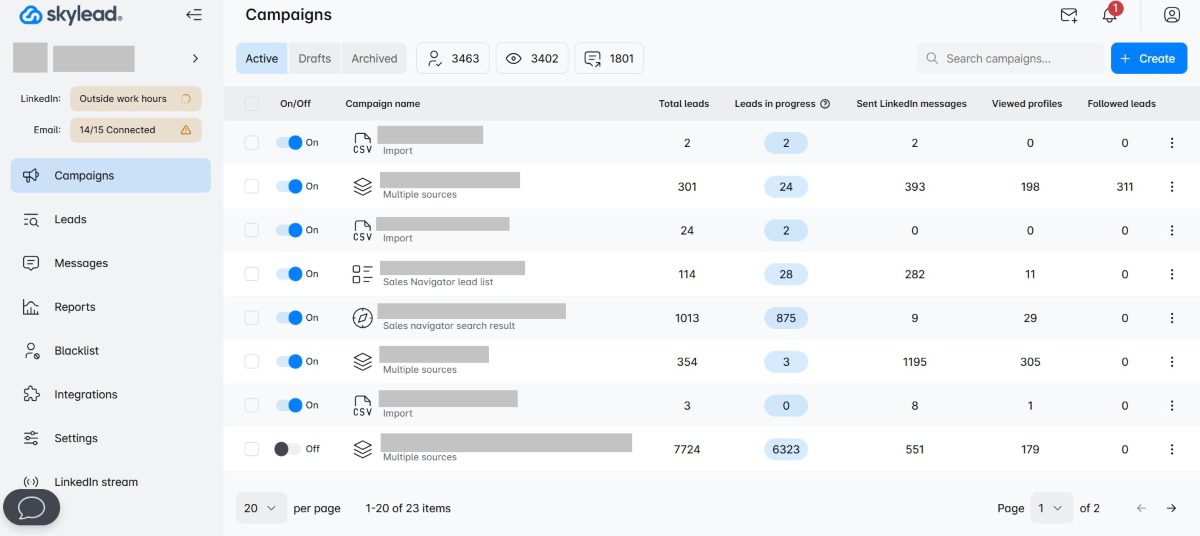
To paint a picture, our Skylead is your one-stop-shop LinkedIn automation and cold email software that sales teams can use to:
- Automate lead generation at scale.
- Combine LinkedIn outreach with unlimited email outreach to maximize touchpoints with leads.
- Find and verify emails of leads to reduce bounces.
- Increase response rates to 76% and more with hyper-personalized images & GIFs.
- Warm-up infinite emails thanks to our partnership with one of the best email warm-up tools, InboxFlare, to keep emails away from spam.
In essence, Skylead lets you make the most of your LinkedIn sales strategy and compliments it by introducing multichannel outreach into the mix. This is possible thanks to our Smart sequences. We were the first tool on the market to introduce this feature, which lets you combine LinkedIn and email steps with if/else conditions. As a result, you get coherent outreach flows that react according to your leads' behavior to reach them in the fastest way possible.
And did we mention you get all this at a single price?
On top of a reliable outreach solution like Skylead, you also need to choose a CRM. If you don’t use one already, that is.
A CRM helps you connect all your leads’ details, track their progress through the sales funnel, and monitor conversions. Some of the best CRM software for sales include HubSpot, Pipedrive, Salesforce, and Monday.
If you want, you can also use content scheduling tools for LinkedIn, such as Hootsuite or Buffer. However, LinkedIn has its own post-scheduling feature. So, if other social media platforms aren’t part of your sales strategy, these may be redundant.
The point is to choose tools that fit your workflow and the ones that you’ll actually use.
2. Create an outreach campaign
After choosing the tools, it’s time to create an outreach campaign.
We’ll walk you through the process using Skylead and Sales Navigator search as a lead source.
However, bear in mind that you can also use these lead sources with our tool:
- Sales Navigator Lead list (as mentioned)
- LinkedIn and Recruiter search result
- Recruiter Talent pool and Pipeline URL
- LinkedIn post
- LinkedIn event
- CSV file
That said, here’s how to create a campaign step-by-step.
Step 1: Use Sales Navigator filters to refine search
Narrow down your audience in Sales Navigator using filters like industry, job title, geography, company size, etc.
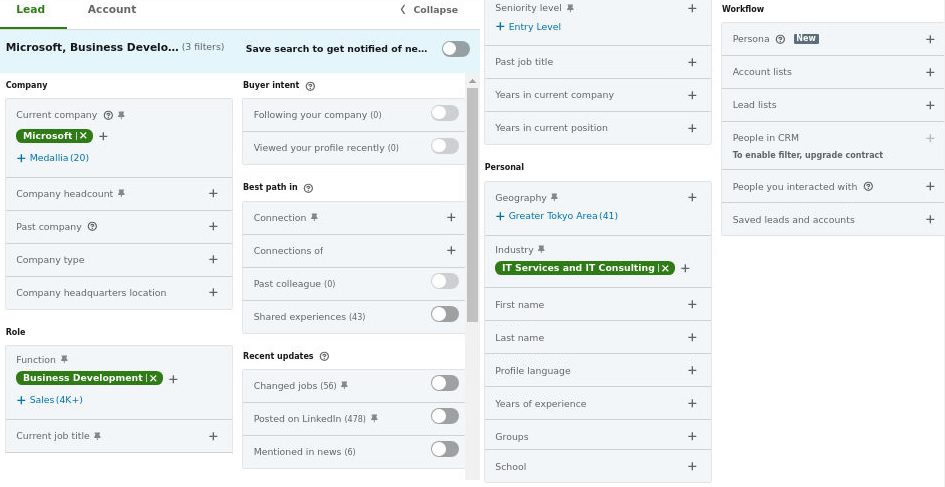
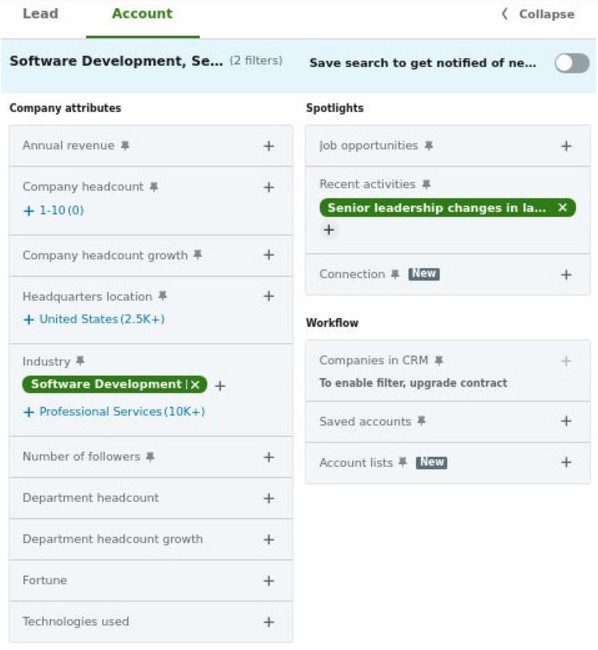
Once your search results are refined, copy the search URL.
Step 2: Begin campaign creation in Skylead
Now it’s time to hop into Skylead.
- Go to the Campaigns page and click Create New Campaign.
- Name your campaign.
- Paste the search URL into the corresponding field.
- Choose a connection degree.
- Hit Next.
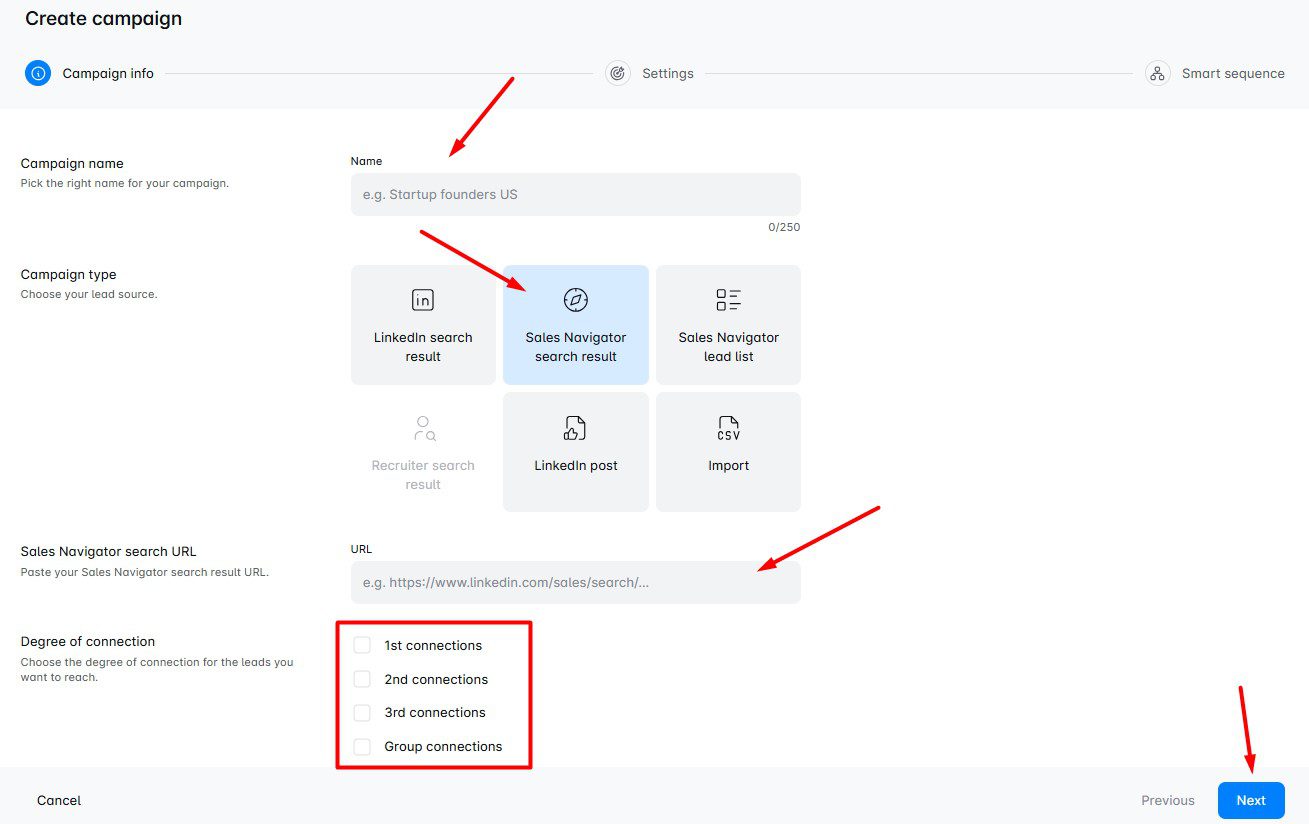
Step 3: Define campaign settings
There are 3 types of settings to set up next:
- LinkedIn settings
- Email settings
- Global settings
Under LinkedIn settings, you get 2 options you can toggle on or off:
- Collect contact information - If turned on, Skylead will collect publicly available information from your leads’ profiles.
- Refresh search automatically - Turned on, it prompts Skylead to refresh search results and add new leads into a campaign if they appear.
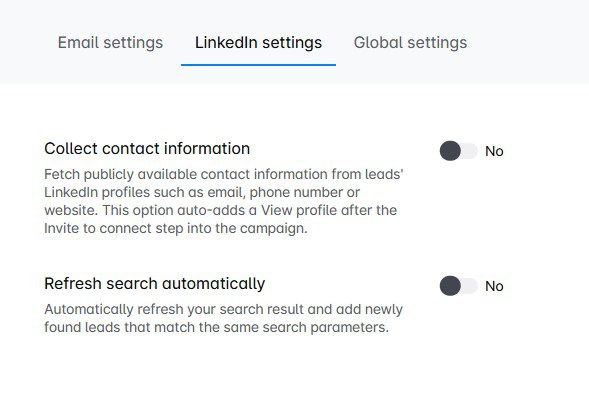
If you’d like to use email as an outreach channel, use email settings to select the specific accounts. Skylead lets you connect unlimited mailboxes and rotates through them while sending emails. As a result, you can send tens of thousands of emails a month at no additional cost.
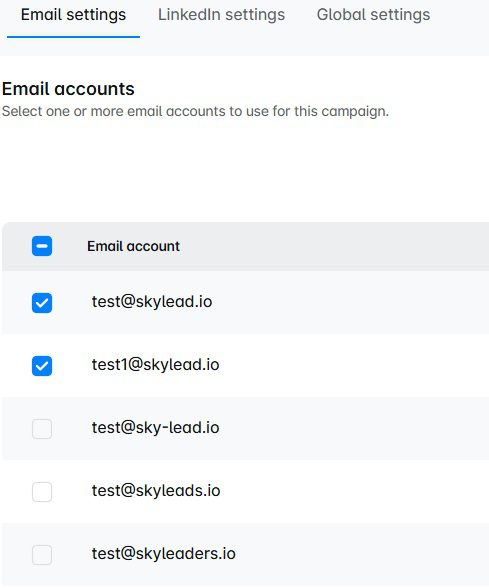
Finally, as part of global settings, you get to set a schedule Skylead will use for the campaign, along with targeting options.
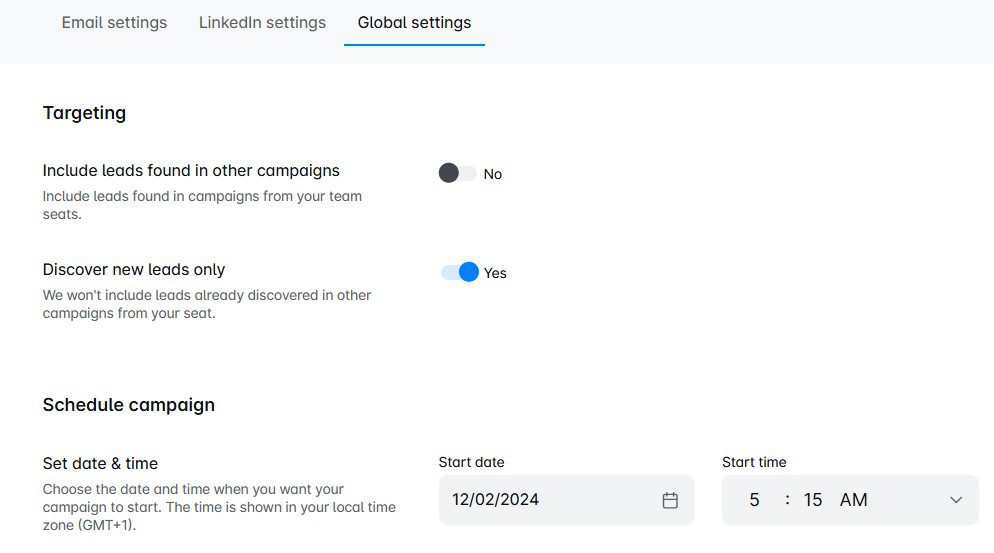
When you’re happy with the settings, click Create sequence.
Step 4: Create your Smart sequence
This is where you get to build your own Smart sequence.
Just drag actions and conditions from the right and drop them into the workspace. Then, connect them to each other to form coherent outreach flows. Don’t forget to set delays between steps while at it!
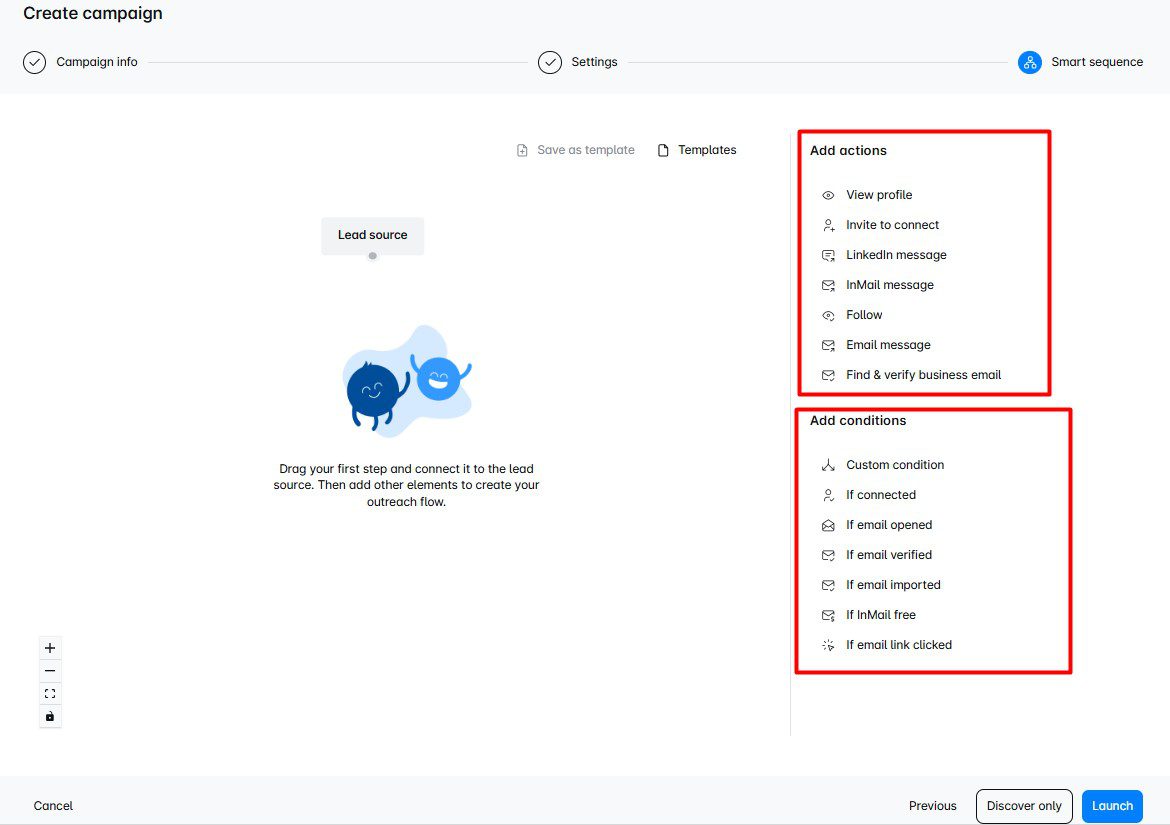
Here’s an example of a Smart sequence for inspiration.
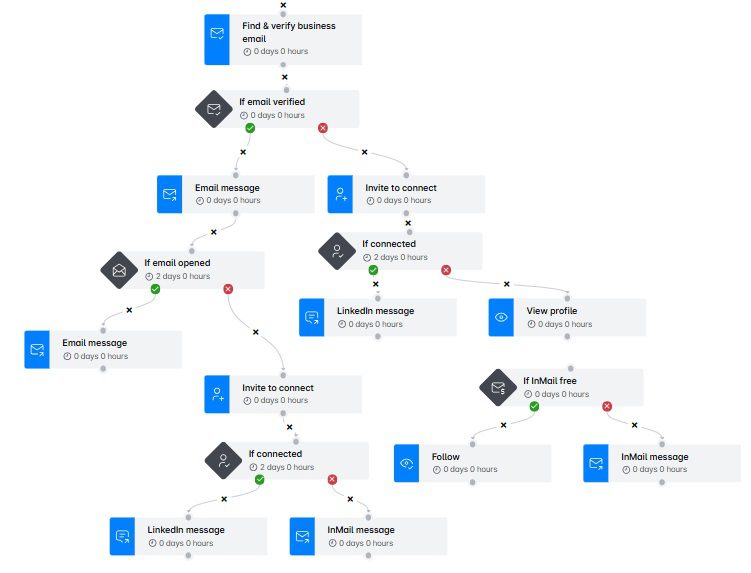
Need more inspiration? We’ve got a library of Smart sequence templates that Andrea personally tested. So, feel free to check them out and use them in your outreach for guaranteed results!
Step 5: Add hyper-personalization
Message-based steps (e.g. Invite to connect, LinkedIn message, inMail, and email) allow you to use variables for personalization.
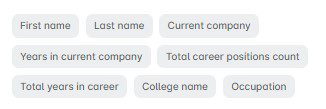
But we’ve got another feature that helps you truly stand out in your leads’ inboxes: native image & GIF hyper-personalization.
To enter the image & GIF editor, click the Add image button above the message field.
Then:
- Click Create new template
- Upload the image/GIF
- Submit
A new window will open where you’ll have the option to personalize the visual with:
- Your or your leads’ LinkedIn profile photo
- Your leads’ logo or a custom logo
- Custom text
Once you’re happy with the results, just click Save Image, and it will be added to your message for a chance at up to 76% response rate, as we had using this feature.
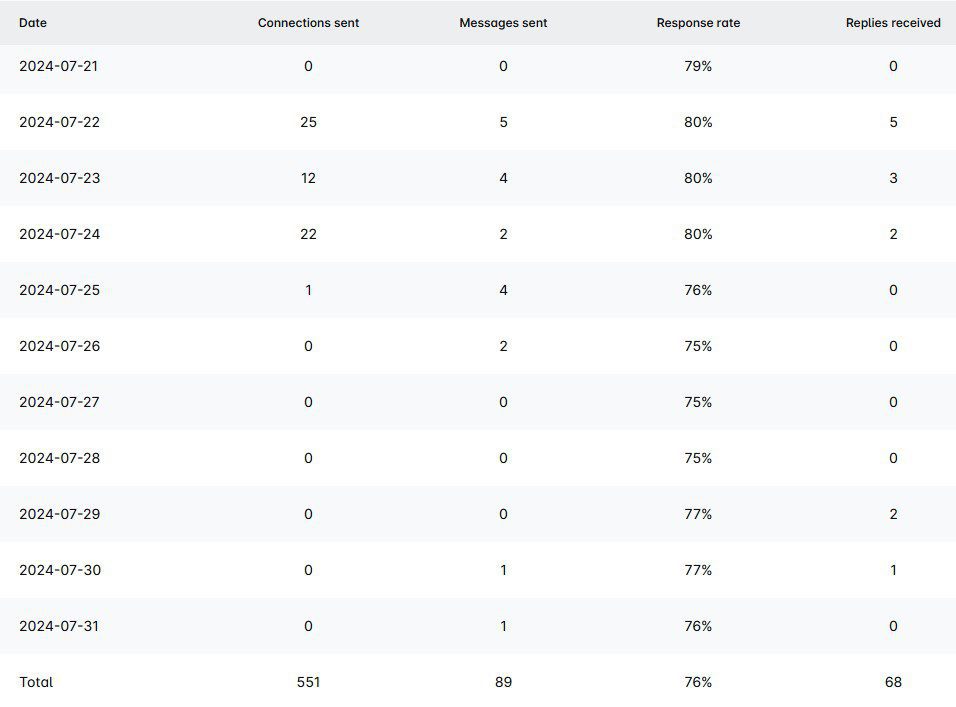
And if you’re happy with your entire sequence, this is consequently the time to kick your campaign running!
The tool will then reach out to your prospects on your behalf. If they reply, the chat will immediately appear in your Smart inbox, where you can take over the conversion and nurture away.
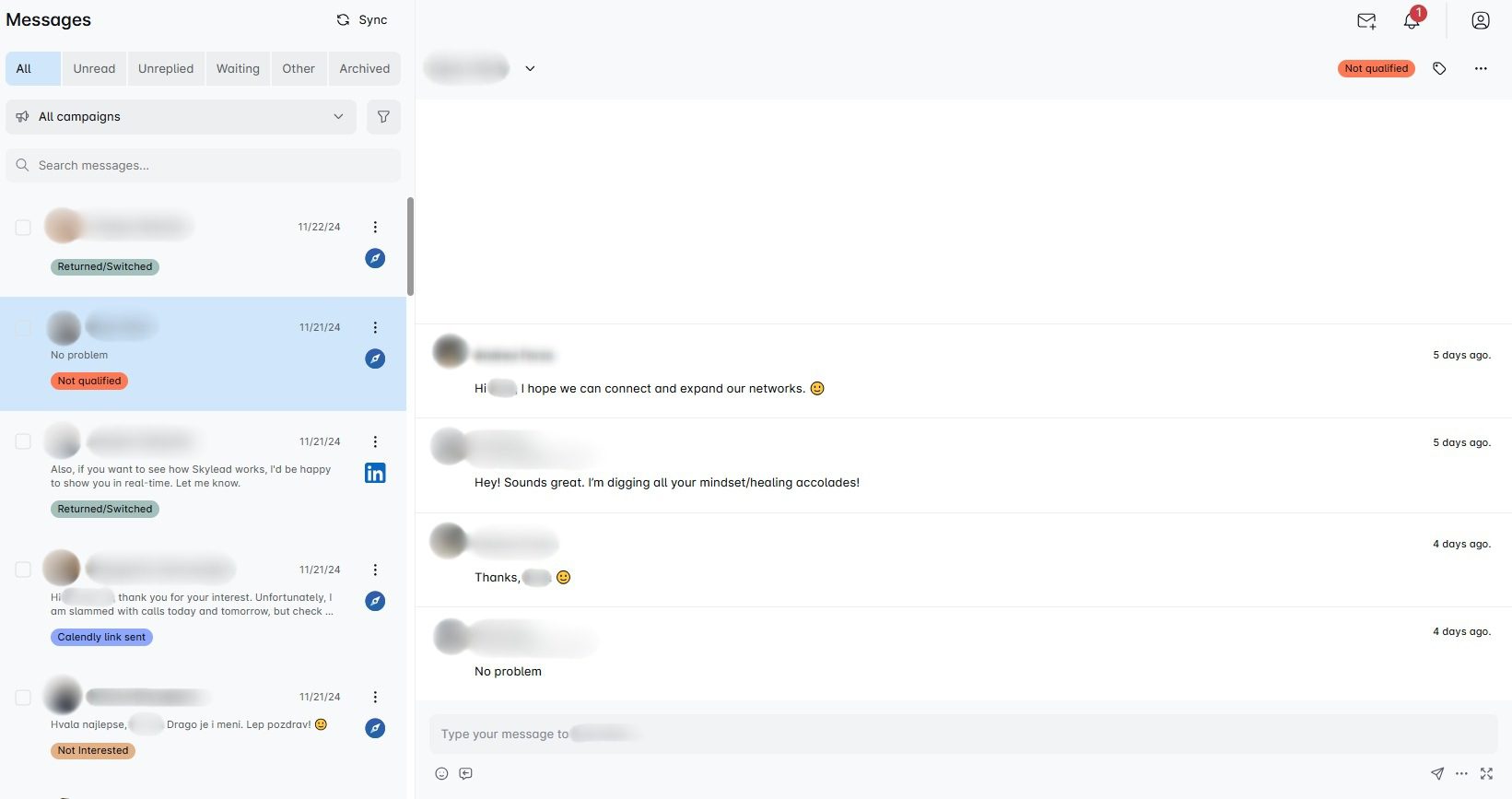
Smart inbox is consequently where you can label leads according to whether they are warmed up, if they booked a call, or converted. Thus, you can also use it to keep track of conversions and ROI.
How to analyze the success of your LinkedIn sales strategy
Crafting and executing a LinkedIn sales strategy is only half the battle. To make sure it’s working as intended—and to make improvements where needed—you need to track and analyze its performance.
That said, the first thing to do is analyze the KPIs that you defined in the strategy. Doing so will help you determine which parts of your strategy are driving results and which need to be refined.
Depending on the type of KPIs that you want to analyze, you can use LinkedIn’s native analytics to track:
- The demographics of your profile viewers (e.g., job titles, industries, locations).
- The performance of your posts and articles, including impressions and engagement rate.
- Trends in follower growth and audience interactions over time.
In terms of specific LinkedIn sales strategies, LinkedIn’s social selling index is a good indicator of whether your thought leadership strategy is working or not.
What’s more, if you’re using Skylead for outreach, you can easily keep track of different KPIs, like the number of leads you reached out to (connections sent), connections accepted, response rate, etc. These are available on our Reports page via:
- Graph view to spot oscillations at a glance;
- Table format to analyze day-to-day change in performance and sport patterns;
- Step-by-step mode to identify exact spots where prospects drop off or engage.
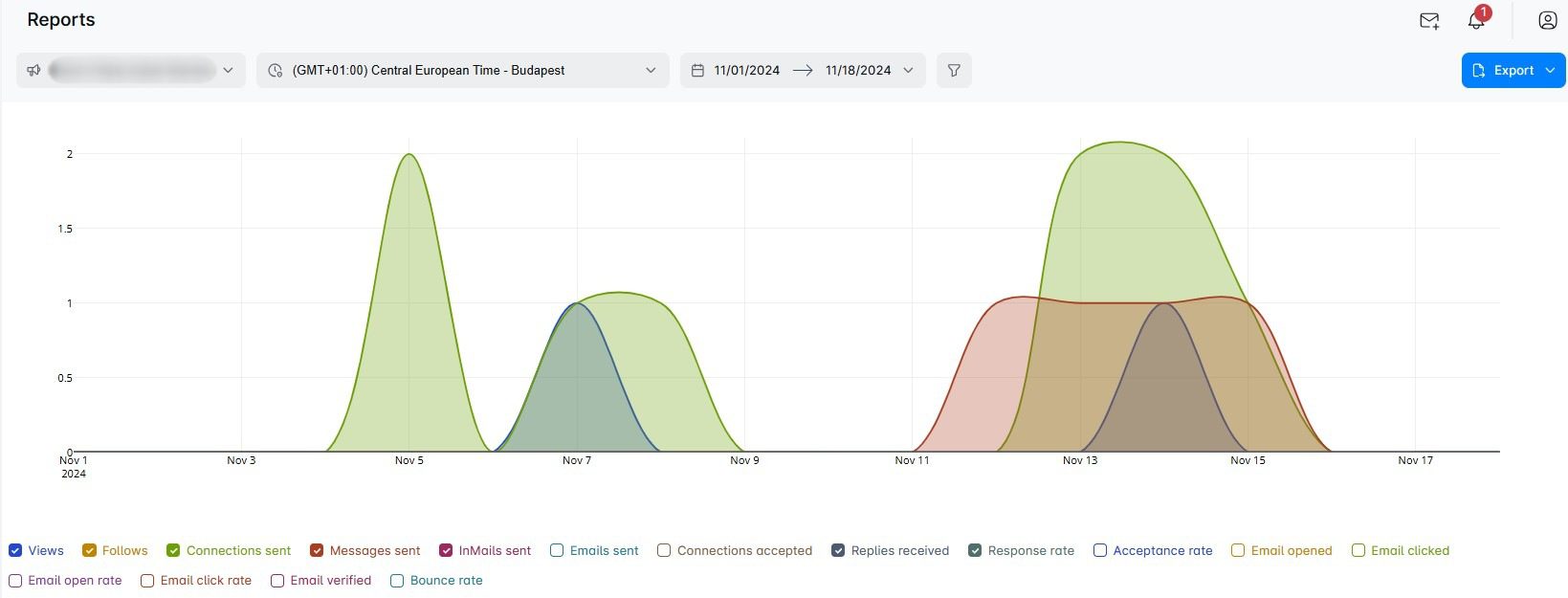
Furthermore, if you aren’t sure of the impact of the messages you prepared in a strategy, a good practice is to experiment with A/B testing. For example, while creating a Smart sequence in Skylead, you can define up to 5 different variants of your messaging and compare them against each other later on.
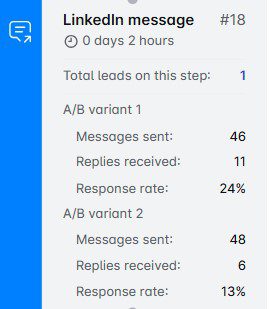
Of course, if results aren’t there immediately, that doesn’t mean all hope is lost. Often, they take time to show. That said, Andrea suggests you give your LinkedIn sales strategy 2 to 4 weeks to reflect progress. Only then should you evaluate its performance and optimize it accordingly.
Common mistakes to avoid when creating and executing a LinkedIn sales strategy
Even the best-intentioned LinkedIn sales strategies can fall flat if certain pitfalls aren’t avoided.
That said, here are some of the most common mistakes to watch out for—and how to steer clear of them.
1. Not adjusting your strategy to your audience
Your audience isn’t a monolith, so your approach shouldn’t be universal. After all, a generic strategy often leads to low engagement and missed opportunities.
Avoid this mistake by:
- Tailoring your messaging and content to the specific needs and pain points of your ICP and Buyer Persona.
- Regularly revisiting your target audience criteria to make sure they’re still relevant.
2. Sending generic connection requests
Nothing screams “spam” more than a connection request that says “Let’s connect!” without context. These requests often get ignored or outright declined.
Instead, personalize every connection request with a reference to something specific about the prospect, such as their recent post or a common interest.
For example:
"Hi {{FirstName}}, I loved your recent article on {{topic}}—it gave me some great insights! I’d love to connect and exchange ideas on {{shared interest}}."
3. Sending sales pitches right after connecting
The fastest way to lose a connection is by pitching your product or service immediately after connecting. Social selling is about building relationships above all.
Therefore, engage with their content before sending a direct message. When you finally message them, focus on providing value first and your offerings second.
4. Neglecting to follow up with connections
Not everyone will respond to your initial outreach message. That doesn’t mean they’re not interested, though. In such a situation, a lack of follow-up can cost you some valuable opportunities.
Avoid this by scheduling polite and value-driven follow-ups spaced a few days apart.
To follow up after no response, feel free to share a relevant blog post or case study with a message like:
"Hi {{FirstName}}, I thought this article might be helpful based on our earlier conversation about {{topic}}. Let me know if it resonates!"
5. Giving up too soon
LinkedIn sales strategies often take time to show results, as we pointed out earlier. Many give up after a few weeks of minimal engagement. By all means, don’t do the same!
Instead:
- Be consistent with your efforts.
- Evaluate your performance occasionally and make data-driven adjustments.
Frequently asked questions (FAQs)
How do you use LinkedIn effectively for sales?
Focus on building relationships. Optimize your profile, create engaging content that speaks to your audience’s pain points, and use Sales Navigator for targeted prospecting. Combine this with personalized outreach and consistent engagement to nurture leads and drive conversions.
What’s the recommended balance between inbound (content-driven) and outbound (cold outreach) efforts in a LinkedIn sales strategy?
A 60/40 split is often ideal, from our experience. This means you should devote 60% of your efforts to inbound (content-driven) strategies to build trust and visibility and 40% to outbound (cold outreach) to directly engage with prospects. Then, adjust as you go based on audience response and resource availability.
How can I make the most of a LinkedIn sales strategy if I’m working with a small team or limited resources?
You can maximize efficiency by using automation tools like Skylead to save time on manual outreach. This leaves you time to focus on high-impact activities like relationship-building. Also, prioritize connecting with your ICP and Buyer Persona and repurpose content (e.g., turning blog posts into videos or carousels) to maximize your reach with minimal effort.
Seal the deal with the proper LinkedIn sales strategy
Creating and executing a successful LinkedIn sales strategy is the difference between chasing leads aimlessly and actually closing deals.
So, take the time to plan it out and put it into motion when you're confident you’ve got it right. And whatever you do, don’t cut corners—success on LinkedIn is all about doing things the right way.
Just keep in mind that results may not come overnight. But that’s just part of the process. Be patient, stay consistent, and tweak things as needed. Over time, it’ll all start to click, and your hard work will pay off.
Need a little help along the way? Skylead can handle the repetitive outreach tasks for you, freeing up your time to focus on what really matters: nurturing those valuable connections.
The best thing is that you can try it out for 7 days free of charge! Got questions or just want to say hi? Our team’s here on live chat, ready to help and cheer you on on your way to becoming a social selling expert on LinkedIn.
You were ready to subscribe to LinkedIn Premium only to find out there's another option: Sales Navigator. Now, you're wondering—are they the same? If not, how do LinkedIn Sales Navigator vs Premium features compare? And which one is right for you?
While many sales reps recommend Sales Navigator for prospecting, it's not always the clear winner. Nonetheless, our job is to compare LinkedIn Sales Navigator vs Premium, and yours is to decide which fits your needs.
One thing's clear, though: LinkedIn Basic is too limited for professional use. To make the most of LinkedIn, an upgrade is essential.
Now, let's find out which option is best for your business.
What is LinkedIn Premium?
LinkedIn Premium is a paid subscription that offers enhanced features that go beyond LinkedIn’s Basic, free account.
It is designed to help professionals unlock more networking, career advancement, and business growth opportunities.
With Premium, users gain access to features like InMails, insights into who viewed their profile, LinkedIn Learning courses, etc.
No wonder LinkedIn cashes in $1.7 billion annually from LinkedIn Premium alone!
Who is LinkedIn Premium for?
LinkedIn Premium consists of 2 sub-plans:
- Premium Career
- Premium Business
Premium Career is created specifically for job seekers interested in advancing their career or switching it altogether.
Meanwhile, Premium Business helps individuals grow their LinkedIn network and scale their business. As such, it’s perfect for prospective entrepreneurs and small to medium business owners.
LinkedIn Premium features
Both Premium Career and Premium Business plans have their clientele.
However, since the Business plan has a broader application, today, we’ll be covering the Premium features it comes with.
Monthly InMail credits
LinkedIn Premium gives you 15 paid InMail credits a month that can be accumulated to up to 45 credits in 3 months.
Any LinkedIn member can receive a paid InMail. However, only LinkedIn Premium, Sales Navigator, and Recruiter users can send them. Each time you get a reply, you get that InMail credit back.
Premium users can also send up to 800 free inMails monthly to members whose profiles are set to ‘’Open’’.
And while 15 paid inMail credits are a minimum, truth be told, the exact number of these you can send depends on your plan. This is where Sales Navigator surely wins the LinkedIn Sales Navigator vs Premium “battle.” But more on this below.
Moreover, since each LinkedIn member can receive a paid InMail, we advise our users to use it as the last resource. Therefore, LinkedIn InMails are usually one of the very last steps in our Smart Sequences.
InMails also turned out to be a clever move if you want to get in touch with members who are hard to reach—typically, decision-makers. Check out these LinkedIn inMail examples to get inspired when reaching out to these individuals.
“Who Viewed Your Profile” feature
If you are a Premium Business subscriber, you’ll have a detailed insight into LinkedIn members who viewed your profile.
You may have appeared in their feed or their search results. Maybe someone recommended you, or they came across your name while checking your company’s website. Your profile could also have appeared in their “People also viewed” or “People you may know” section.
Either way, they showed some kind of interest in you. And reaching out to them turned out to be a LinkedIn prospecting practice that brings results.
This is where you can see who viewed your profile on LinkedIn.
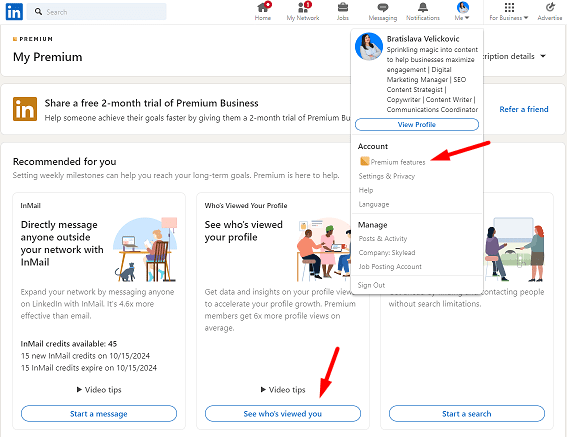
Company insights
All LinkedIn Premium members can visit any LinkedIn company page and check out the company insights.
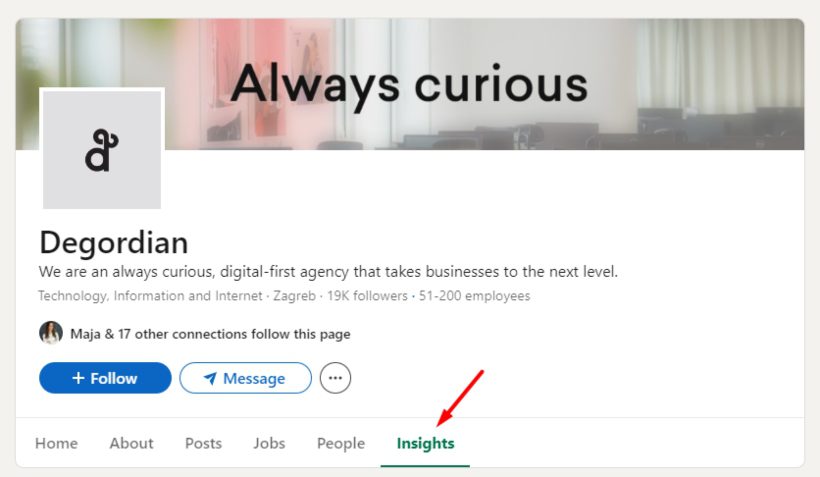
Companies that hire, grow, and receive funding are generally more likely to consider innovative solutions, hire counselors, and automate certain processes. That's why taking into account specific company insights can be valuable for your next business move.
Here, you can see data like:
- Total employee count
- Total employee growth in the last 6 months, 1 year, and 2 years
- Employee distribution and head growth by function
- New hires
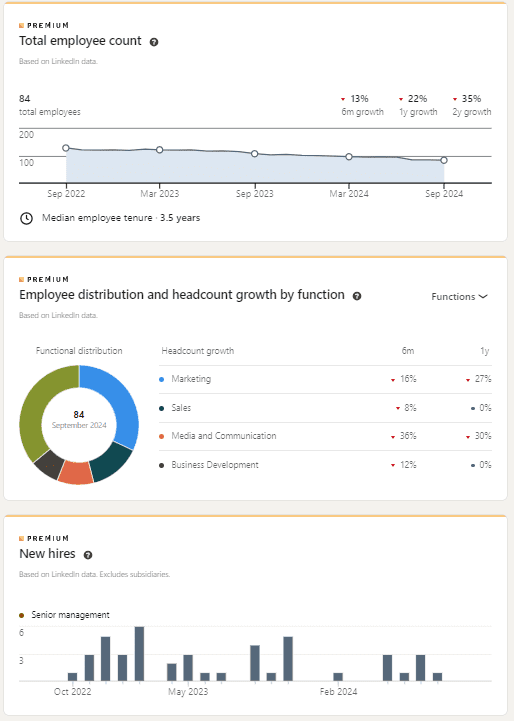
LinkedIn Learning
LinkedIn Learning is LinkedIn's free online learning platform. It provides video courses taught by industry experts and is available to all Premium users. The main goal of this platform is to provide different skill sets necessary for scaling your business and/or advancing your career.
This is what your LinkedIn learning platform dashboard looks like.
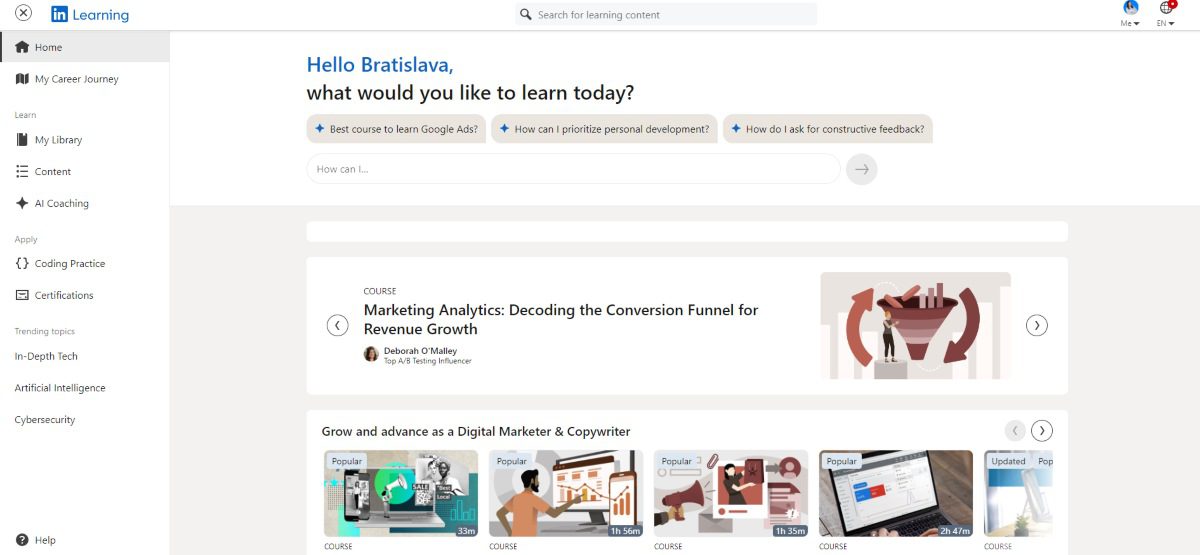
At the very top of the page, there is a search bar that you can use to search for the specific course by name. However, right below it is another search bar. But, this time, one where you input a prompt that LinkedIn’s AI will use to suggest a course for you.
Now, before you go fishing for courses, we advise you to set up your ‘’Career Journey’’. You can find this option in the sidebar menu on the left.
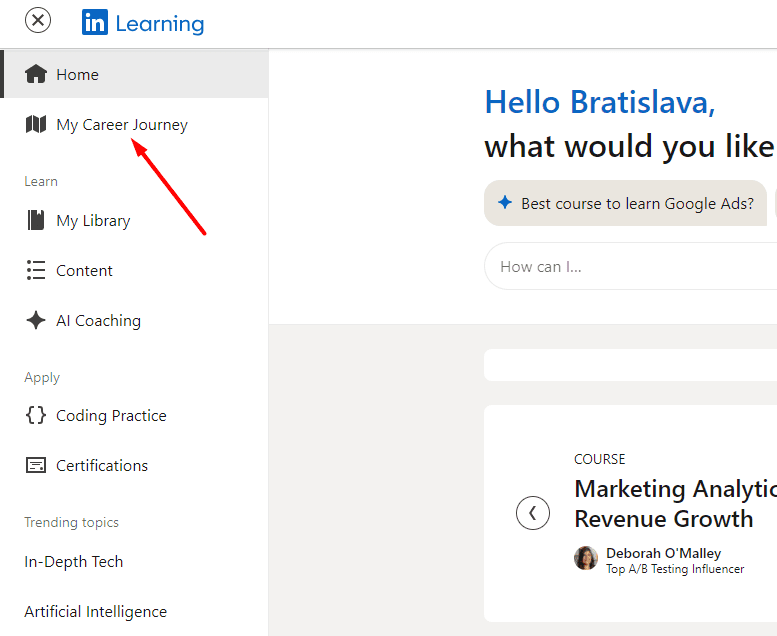
This is where you should set up your ‘’Career goal,’’ a.k.a. what you wish to accomplish in the next 6 to 12 months.

There are a total of 3 goals you can choose from.
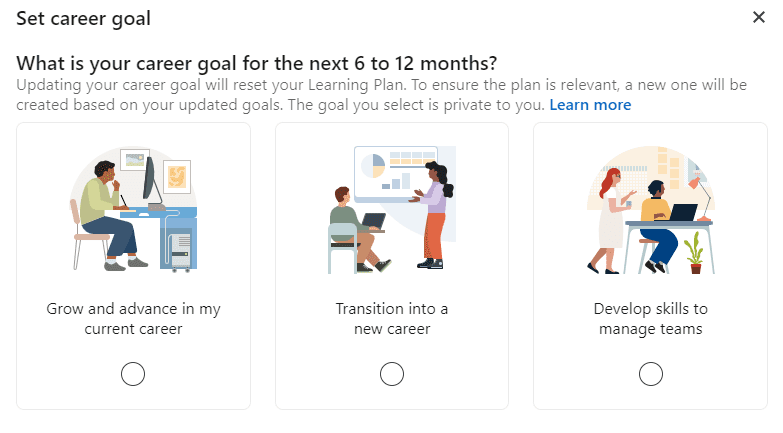
Once you’ve decided on the one, LinkedIn will create a personalized Learning plan complete with the best coursework to help you achieve it.
Of course, you can build upon it by adding more courses or remove those you find irrelevant.
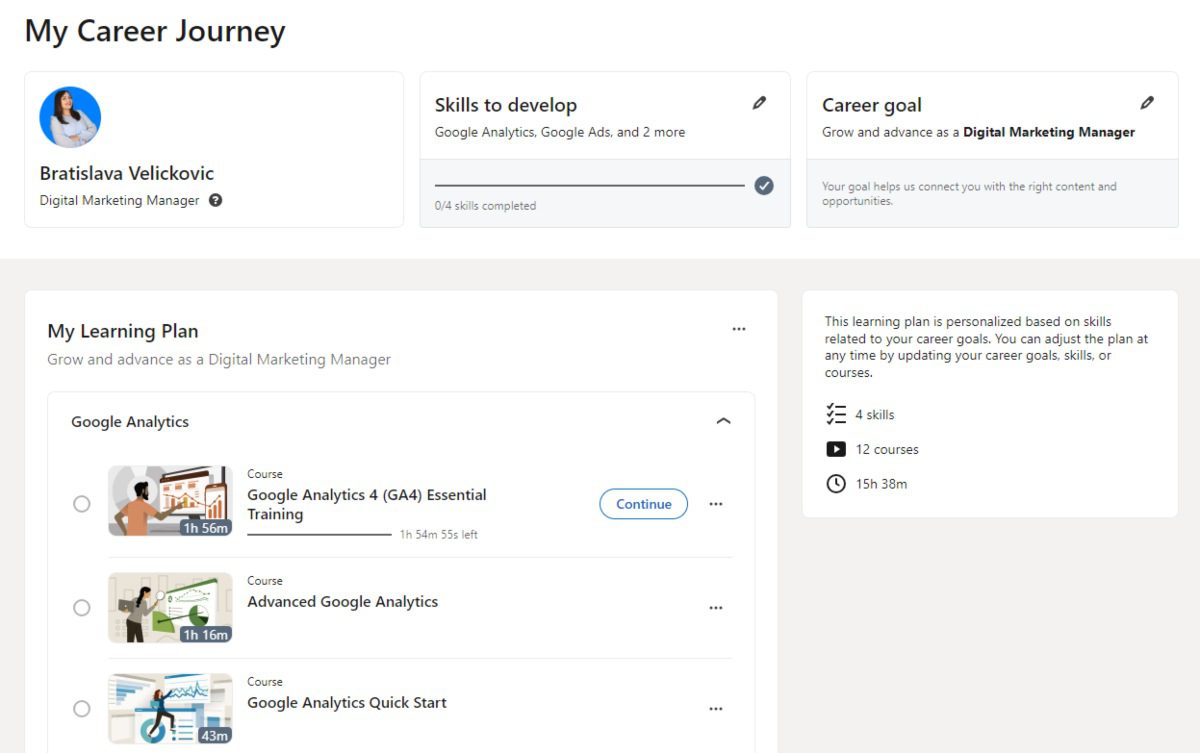
How fast you go through these is up to you. But if you want to keep yourself on track, we recommend setting up a weekly goal.
This isn’t something that LinkedIn asks you to commit to. It’s more of a personal goal you set for yourself.
To set one up, click the ‘’My Library’’ button in the left sidebar, and then tap on the ‘’Set my weekly goal.’’
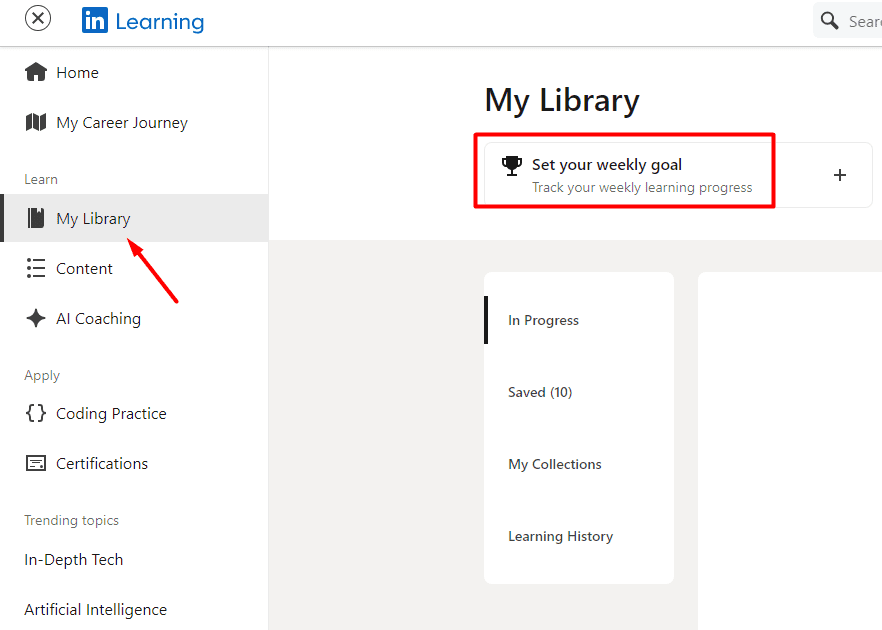
These are the 4 weekly goals available.
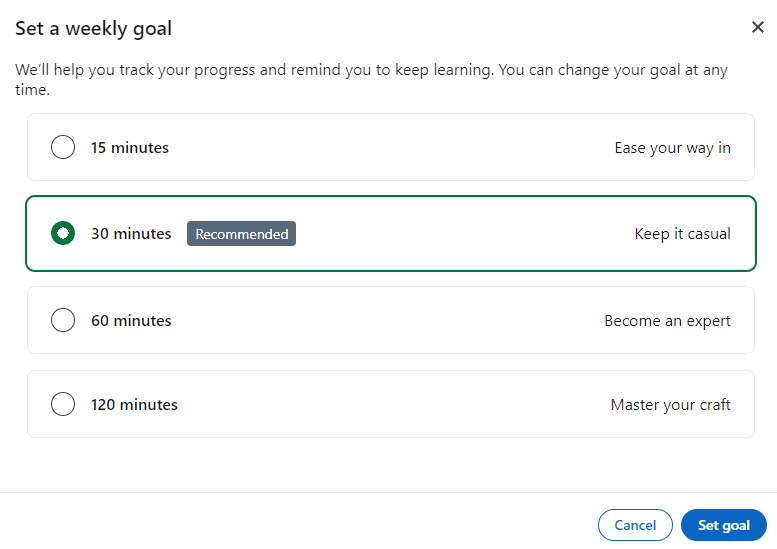
Now, moving back to the LinkedIn Learning homepage, you can also see recommended courses. LinkedIn suggests these based on your professional path, previously set preferences, and what’s currently trending among fellow LinkedIn learners.
For example, this is what LinkedIn’s top picks look like for me.
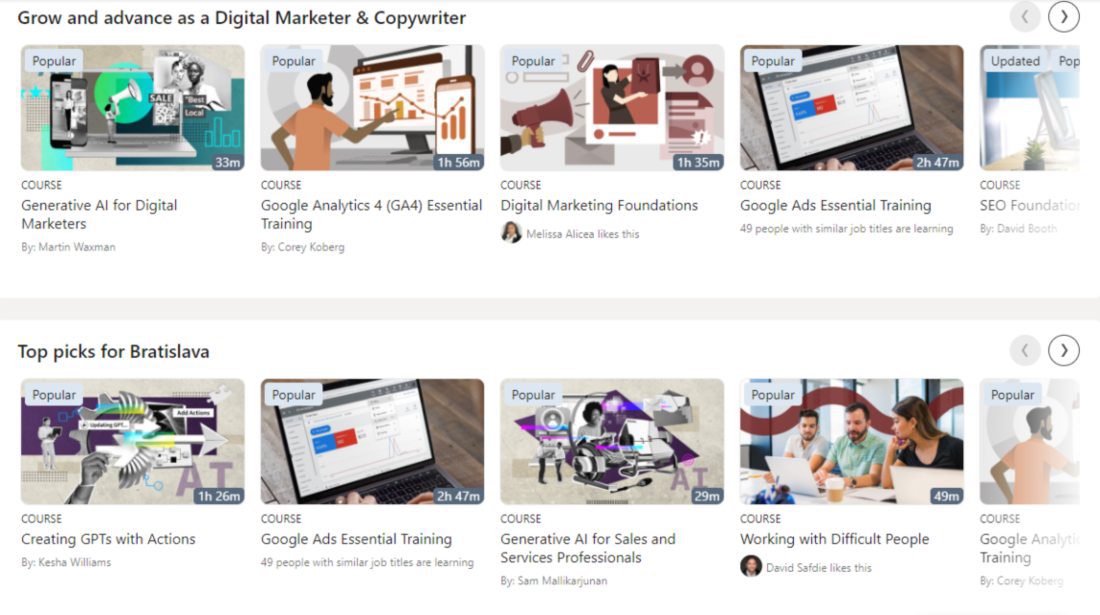
LinkedIn Premium pricing
The LinkedIn plan price and the VAT depend on the country where your account has been registered.
To give you an example, our team, which is based in Serbia, is paying the following amount for LinkedIn Premium Business:
| Monthly cost | $59.99 + 20% VAT, as specified by our country |
| Annual cost | $575.88 + 20% VAT, as specified by our country |
For more pricing details, be sure to check our blog, which talks about LinkedIn Premium cost in greater detail.
Also, bear in mind that certain individuals can get LinkedIn Premium free of charge. So, be sure to check if you fall into this category before subscribing.
What is LinkedIn Sales Navigator?
LinkedIn Sales Navigator is a specialized LinkedIn subscription plan. It's meant to help streamline LinkedIn lead generation and prospecting with features that help you find, track, and connect with potential leads more effectively.
Who is LinkedIn Sales Navigator for?
As its name suggests, LinkedIn Sales Navigator is primarily built for sales teams.
However, it’s also useful for business development professionals, account managers, and anyone else looking for an efficient way to find, engage, and track leads.
So, if you are in a role where discovering new business opportunities, building relationships with decision-makers, or managing a high volume of leads is critical to your success, Sales Navigator is your perfect LinkedIn subscription.
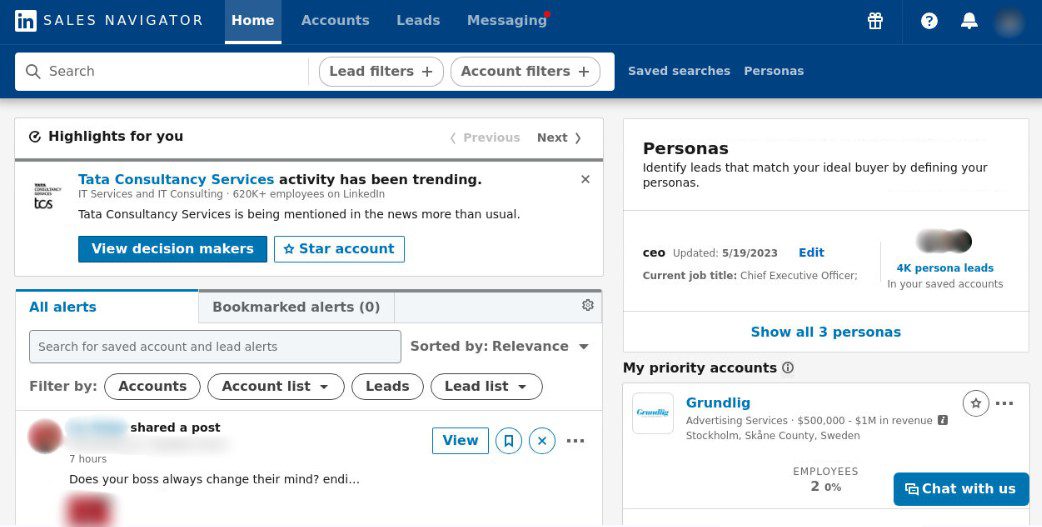
LinkedIn Sales Navigator features
What may position this subscription plan as a winner of the LinkedIn Sales Navigator vs Premium debate? Well, it’s the unique features it comes with.
With that in mind, let’s uncover the most prominent ones.
Advanced filtering
LinkedIn Sales Navigator filters are one of its greatest benefits.
Namely, Sales Navigator comes with 29 Lead Filters and 15 Account Filters, 27 of which are exclusive to the platform. Yes, LinkedIn Premium members and those using Recruiter can’t access them!
That said, if your niche requires pretty specific lead profiles, Sales Navigator is the right subscription for you.
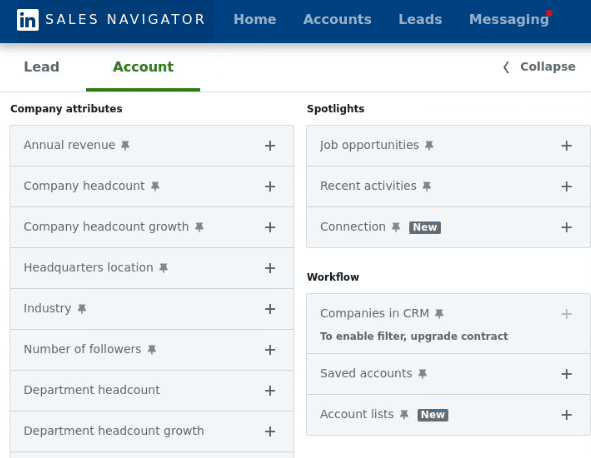
Saved search
The Saved Search option allows you to save specific criteria that get you as close as possible to your ideal customer profile and buyer persona.
You can name your Saved Search in any way that helps you distinguish between other saved searches you have.
Every time you enter the Saved Searches dashboard, you will see the number of leads added since the last time you opened that specific saved search. You can also see when you last accessed that particular list.
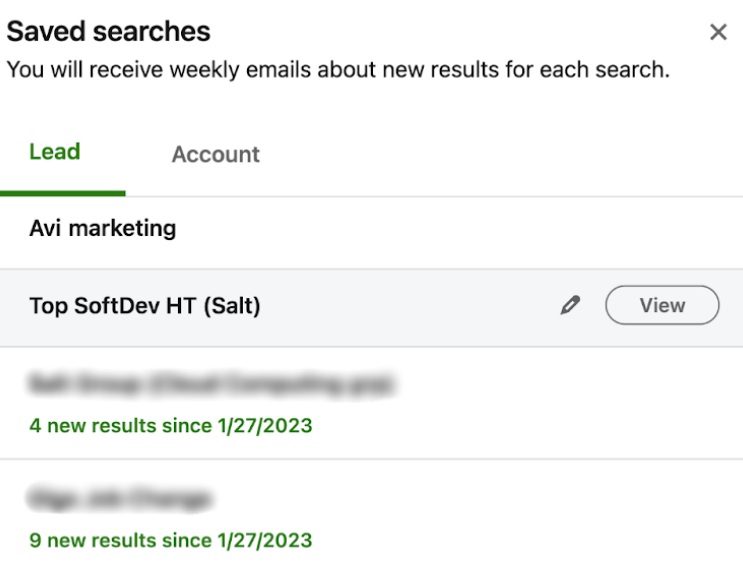
Lead and account lists
Something similar to the previous feature is the Lead List and Account List options. Here, you can keep specific leads or accounts that match your criteria in one place and under one name.

InMail credits
The concept of free and paid InMail credits is the same as explained above. The only difference is that Sales Navigator offers 50 paid InMails credits that can be accumulated to up to 150 in 3 months. LinkedIn gives you back InMail credits each time a user answers.
Additionally, each Sales Navigator subscriber gets 800 free InMail credits that can be sent only to users with open profiles. Therefore, when it comes to the LinkedIn Sales Navigator vs Premium battle, Sales Navigator is surely a winner in this regard.
CRM integration
Among the 3 plans, Sales Navigator Core, Sales Navigator Advanced, and Sales Navigator Advanced Plus, only the last 2 support the option of connecting your CRM.
Once you’ve connected your database, Sales Navigator will match the list of leads with their LinkedIn profiles and enable you to perform any action you would normally be able to through a regular Sales Navigator.
Sales Navigator supports the majority of CRMs. If you don’t have one—or are not sure which one is for you—we’ve listed the 10 best CRM software for sales with their advantages and disadvantages to help you choose.
Lead alerts
Set alerts for leads and accounts of your choice, and Sales Navigator will make sure to regularly update you on every activity the platform finds relevant. This could be anything from job changes, post-shows, growth insights for companies, etc. It is an excellent way to know what your leads of interest are up to and wait for the right moment to approach them.
‘’View Similar’’ feature
The View Similar option is available for accounts only. It is the right choice once you’ve defined your ICP down to the smallest detail.
Let’s say you found that ideal company that you would like to replicate if you could. In a way, you can.
Click on the three dots next to the company name in the Sales Navigator search results. Then, choose ‘’View Similar’’.
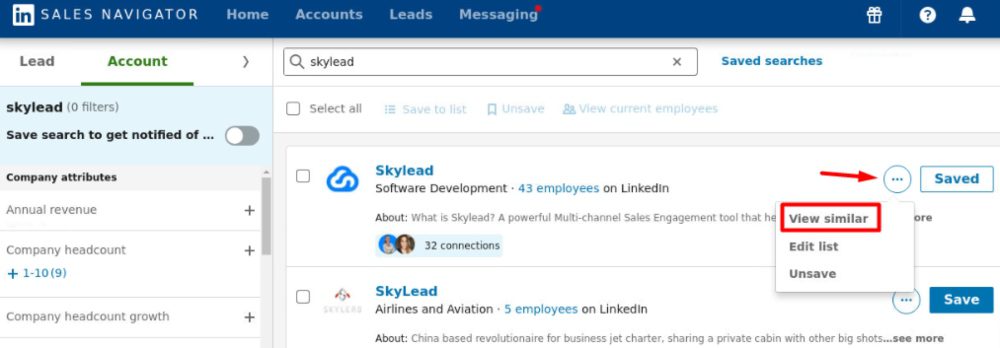
Sales Navigator will list other companies whose attributes match the original one as closely as possible.
Leave notes
Sales Navigator gives you the option to leave notes next to the leads and accounts of your choice. This way, you know at any moment what stop they’re at on their buyer’s journey.
Personas
If you want to zero in on leads that perfectly match your buyer persona, the Personas feature in Sales Navigator has you covered!
That said, this feature lets you create customized profiles based on key factors like:
- Job title
- Function
- Seniority
- Geography
Once you've set up your Personas, Sales Navigator automatically finds leads that align with those profiles within your target accounts, making your outreach faster and more focused. It also gives you valuable insights, like tracking the growth of specific Personas within a company, to help you spot potential opportunities.
By default, Sales Navigator provides 2 Personas: Director + and CXO.
However, you can create up to 3 additional custom Personas to suit your LinkedIn sales strategy better.
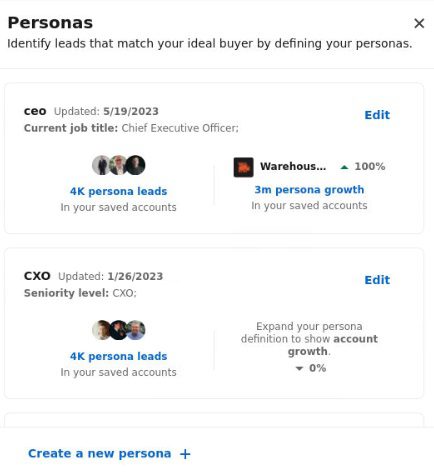
Buyer Intent
This feature is available for Sales Navigator Advanced and Advanced Plus subscribers only.
Nonetheless, it’s very useful as it lets you identify which accounts or leads have shown interest in your product/service.
Buyer intent gives you full insight into where a buyer is in their journey, from checking out your company page to accepting your messages. No other tool offers such detailed intent data. Plus, it shows you the exact activities people are doing that signal interest, so you know exactly where to focus your targeted outreach efforts.
To set up Buyer Intent, you need to contact LinkedIn support.
But once it's set up, you can access Buyer Intent insights in these places:
- Account hub
- Account pages
- Highlights section on the Sales Navigator homepage
- Alerts on the Sales Navigator homepage
- Buyer Intent search filter
- Product category intent filter
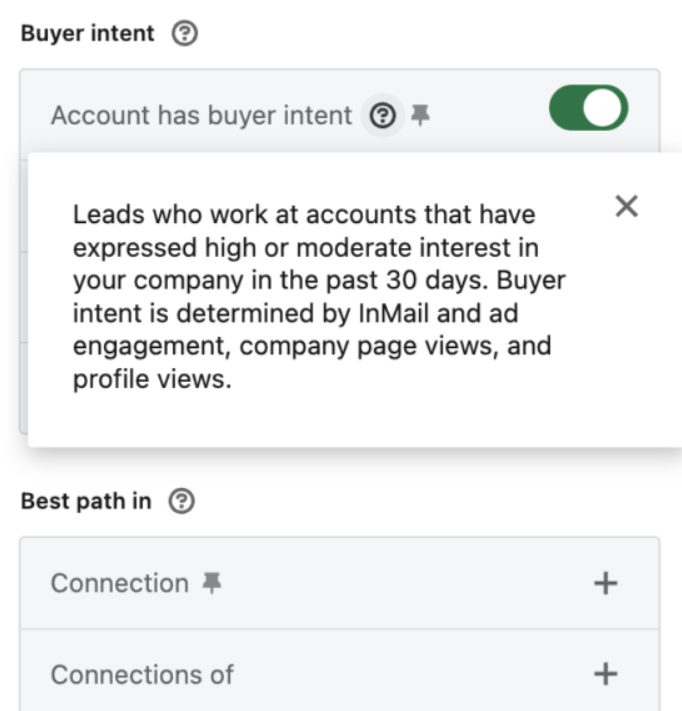
Blacklist specific leads and accounts
Blacklisting specific leads or accounts can be an excellent way to avoid certain leads. These can be people you already spoke to, your competitors, partners, existing customers, etc.
Sales Navigator doesn’t have the Blacklist feature per se.
However, our tool, Skylead, does.
Connect your Sales Navigator account to it to take advantage of the possibility of excluding certain individuals from your outreach campaign.
Smart Links
A Smart Link is a shareable link to a document (PDF, Word, PowerPoint, or image) or a downloadable file (a video, zip file, CSV, etc.) that you can include in a LinkedIn InMail message.
Smart Links are only available with Sales Navigator Advanced and Advanced Plus plans.
The main advantage of these is that they allow you to track engagement—things like link clicks, time the recipient spent viewing content, access date, etc.
Also, if the recipient is logged into their LinkedIn account when they click, you can see their basic profile details, including their:
- Name
- Job title
- Company
- Profile picture
Additionally, if they have an open profile, you can send them a free InMail or a paid one if necessary.
However, if they're not logged in, they must enter their full name and email before accessing the content.
This is a great way for sales and marketing teams to collect significant insights into people showing interest in their product/service.
LinkedIn Sales Navigator pricing
How much does LinkedIn Sales Navigator cost?
Much like with the Premium plans, the Sales Navigator subscription cost varies depending on your geographical location.
However, this is how much you can expect to pay for it in general:
| Sales Navigator plan | Monthly cost | Annual cost |
| Core | $99.99/mo | $959.88/year |
| Advanced | $149.99/mo | $1,300/year |
| Advanced Plus | / | $1,600 per seat a year |
⚠️ Beware: These prices do not include Value Added Tax (VAT), Goods and Services Tax (GST), and other related taxes. For a detailed breakdown of additional, country-specific fees, consult this LinkedIn help center article.
LinkedIn Sales Navigator vs Premium: Key differences
While both LinkedIn Premium and Sales Navigator offer advanced tools for LinkedIn users, they serve different purposes.
For example, LinkedIn Premium is ideal for individuals looking to build their network, access LinkedIn Learning, and gain insights into who’s viewing their profile.
On the other hand, Sales Navigator is meant for professionals focused on lead generation and sales in general. It provides more robust filtering options, lead management tools, CRM integration, and tracking capabilities that are unavailable in Premium.
LinkedIn Sales Navigator vs Premium features
| Feature | Premium Business | Sales Navigator Core |
| Unlimited access to LinkedIn Learning | ✔️ | ✔️ |
| Private browsing | ✔️ | ✔️ |
| Applicant insights | ✔️ | ✔️ |
| Direct messaging | ✔️ | ✔️ |
| Who viewed your profile | ✔️ | ✔️ |
| Who's viewed your profile insights availability | 365 | 365 |
| InMail credits | 15 | 50 |
| AI tools | ✔️ | ✔️ |
| Custom button | ✔️ | ✔️ |
| Business insights | ✔️ | ✔️ |
| Premium Service Page features | ✔️ | ❌ |
| Top choice job | ✔️ | ❌ |
| Advanced search | ❌ | ✔️ |
| Standalone sales interface | ❌ | ✔️ |
| Custom lead and account lists | ❌ | ✔️ |
| Lead recommendations and saved leads | ❌ | ✔️ |
| Real-time updates and alerts | ❌ | ✔️ |
To see how different LinkedIn Sales Navigator plans stack against each other, consult LinkedIn’s Sales Navigator comparison page.
LinkedIn Sales Navigator vs Premium pros and cons
LinkedIn Sales Navigator pros
- Advanced filtering and lead-generation tools.
- CRM integration.
- Smart Links for tracking engagement.
Premium pros
- Affordable compared to Sales Navigator.
- Great for networking and career building.
- Access to LinkedIn Learning and "Who Viewed Your Profile."
LinkedIn Sales Navigator cons
- More expensive.
- It can be overwhelming for beginners.
Premium cons
- Limited lead generation features.
- Fewer InMail credits.
LinkedIn Sales Navigator vs Premium pricing
| Plan | Monthly cost | Annual cost |
| LinkedIn Premium Business | $59.99/mo + VAT | $575.88/year + VAT |
| Sales Navigator Core | $99.99/mo + VAT | $959.88/year + VAT |
| Sales Navigator Advanced | $149.99/mo + VAT | $1,300/year + VAT |
| Sales Navigator Advanced Plus | / | $1,600 per seat a year + VAT |
Frequently asked questions (FAQs)
1. What is the difference between LinkedIn Sales Navigator and Premium?
Sales Navigator is focused on advanced prospecting and lead generation, with advanced filtering and CRM integration. Meanwhile, Premium is designed to provide general networking opportunities, business, and career insights.
2. What does LinkedIn Sales Navigator allow you to do?
Sales Navigator provides powerful features to help you find, track, and engage with leads.
3. Is LinkedIn Sales Navigator useful?
Yes, especially for those in sales, thanks to its filters, lead lists, tracking abilities, saved searches, CRM integrations, and more.
4. Is LinkedIn Premium worth it?
It depends on your needs. For job seekers and general networking, it's a valuable investment. However, Sales Navigator may be better for serious sales efforts.
LinkedIn Sales Navigator vs Premium: The final verdict
At the end of this LinkedIn Sales Navigator vs Premium comparison, we must emphasize that the choice of your LinkedIn plan will highly depend on your intentions.
Either way, whether you opt for LinkedIn Premium, Sales Navigator, or even Recruiter (if searching for the best talent), know that Skylead supports all 3 plans and can help you reach out to your leads faster…and easier!
Skylead is a one-stop-shop tool that takes over boring and time-consuming sales tasks. As a result, it can save you +11 hours a week and allow you to focus on closing the deals and deals only.
Curious about how it can make this happen?
Check out our website, schedule a FREE demo with our sales team, and sign up for your 7-day free trial now!
We can’t wait to show you what Skylead’s all about!
LinkedIn is the perfect place to connect with colleagues, school alumni, and like-minded individuals. But have you thought about using LinkedIn for B2B marketing?
If you haven’t yet, it's time you did!
After all, it would be a shame not to tap into its massive pool of 1 billion users and counting, especially when LinkedIn’s own stats suggest that 80% of them participate in the decision-making process.
Not quite sure where to start? This blog is for you!
Stay tuned, and we’ll show you everything from whether—and how—LinkedIn works for B2B marketing to how to use it to your advantage.
Is LinkedIn good for B2B marketing?
LinkedIn is not only good for B2B marketing, but it’s also the preferred place to engage in it.
In fact, a whopping 96% of B2B marketers have recognized the power of this platform and have chosen to make it their marketing ground base.
Meanwhile, 84% of them reported that, out of all social media outlets, LinkedIn was the place where they found the most success.
Diving deeper into statistics, 40% of B2B marketers say that LinkedIn is the most effective channel for lead generation. This is because it contributes to the acquisition of higher-quality leads that are 6x more likely to convert.
No wonder LinkedIn’s B2B advertising revenue for the current year alone is 4.56 billion dollars!
Why use LinkedIn for B2B marketing?
Surely, you can use Facebook, Instagram, X, and other social media channels for advertising purposes. But what makes LinkedIn a game-changer for B2B marketing is the type of crowd it attracts: professionals. The majority of whom are decision-makers, nonetheless!
Here, you won’t typically find the casual chatter or viral videos common on other networks (though the occasional office humor does pop up!).
Instead, it’s the platform that encourages individuals to connect with one another and engage in industry-focused conversations that help companies:
- Increase brand awareness
- Establish authority and credibility
- Drive engagement
- Accelerate lead generation
- Boost conversions
So, if you're in B2B, not using LinkedIn for marketing is like leaving money on the table. It's where you gain access to big industry players and where your next big deal could be a connection away.
How to use LinkedIn for B2B marketing?
Now that you know why LinkedIn is a B2B marketers’ paradise, it’s time to discuss how B2B businesses use it.
And what better way to present the marketing use cases than to draw from our own experiences?
So, without further ado, here’s how other companies and we, the marketing team in Skylead - a leading LinkedIn automation and cold email software - use this platform to rock B2B marketing. And it’s how you can use it as well!
Expand your network to mingle and supercharge your LinkedIn for B2B marketing
LinkedIn is as much about who you know as it is about who your connections know.
The more people you are connected with, the higher your reach and the chance that another business will notice yours.
That said, for successful and organic B2B marketing on LinkedIn, it’s important to work on expanding your network. It’s what we did.
Thankfully, Skylead let us automate much of that process. We use it to run campaigns that help us expand the network faster and save +11 hours a week!
However, we didn’t and neither should you add just about anyone to your connections! Instead, engage in some quality LinkedIn prospecting and target individuals relevant to your industry who can help you scale your business.
Of course, once they are in your network, your work doesn’t stop. It’s your job to mingle to build those relationships. Like their posts, share them, and comment on them. This will keep you on their radar and increase the chances of your content and your company being seen by their connections.
Become a thought leader
Thought leaders are seen as authoritative figures in the field. As such, they naturally attract more connections and business opportunities.
But, what is it that makes a thought leader…well, a thought leader?
Our CEO, Relja, is the perfect example of one.
He’s become influential on LinkedIn by following these steps:
- Sharing valuable content;
- Publishing original posts on LinkedIn that spark discussion and solve problems or address burning industry questions;
- Engaging with other people’s posts through likes, comments, and shares;
- Posting our company updates and sharing our mission and values;
- Hosting webinars and masterclasses;
- Staying updated with the latest industry developments and news.
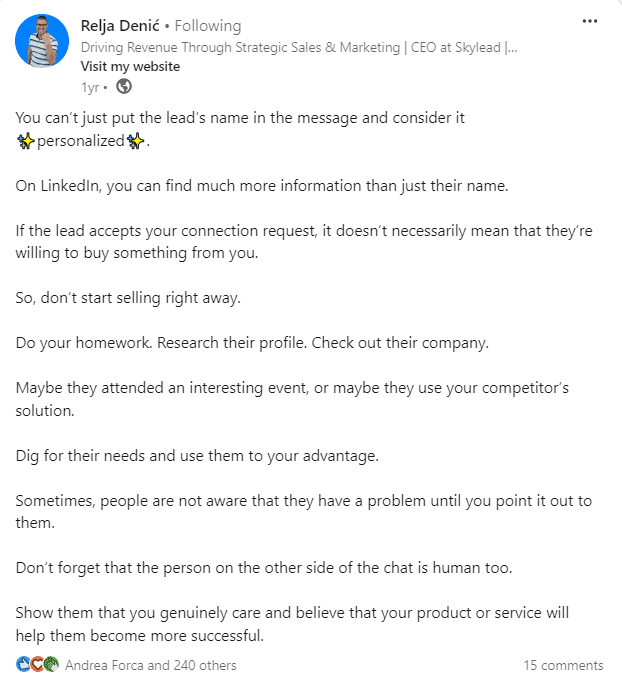
You won’t become a thought leader overnight. It’s an achievement that requires consistency, commitment, and genuine interaction with your community.
Nevertheless, if you follow the same steps we mentioned above, you’ll undoubtedly start to build a reputation on LinkedIn as a knowledgeable and respected professional.
Use LinkedIn to distribute content for B2B marketing purposes
When not working on new content or strategizing and executing marketing activities, you’ll typically find Skylead’s marketing (and sales) whizzes distributing our content on LinkedIn.
This is where having a wide network really pays off and often results in a dramatic increase in visibility and traffic.
To distribute the content, we use a mix of different post formats (regular posts, photos, short videos, etc.). We also encourage cross-team sharing and have found it does wonders for our reach!
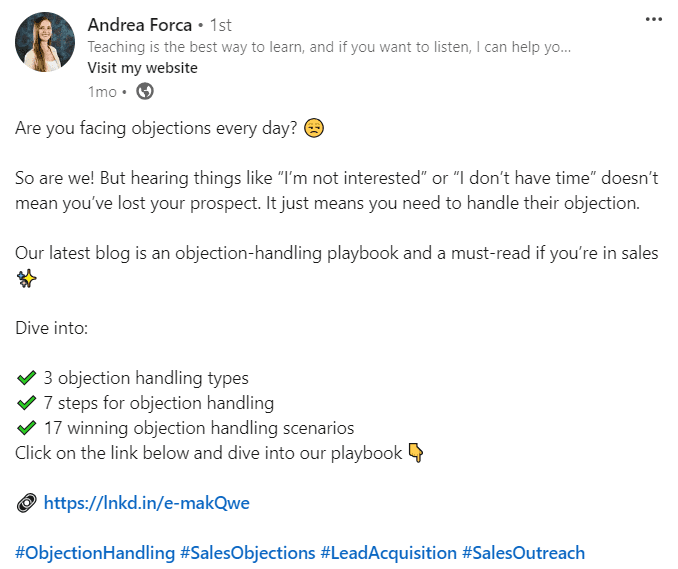
Of course, content distribution is all about timing. You can’t post something in the middle of the night and expect it to get the attention it deserves. So, take it from us and post when your audience is the most active for maximum engagement. These would be business hours on weekdays, though be wary of your audience’s time zone. From our experience, we can tell you that 4 PM is the best time to post.
Generate leads
People typically think lead generation is the responsibility of a sales team rather than marketing, but it’s really a joint effort. That’s why the great news for marketing experts is that LinkedIn is the #1 platform for B2B lead generation. It’s also where most of your B2B leads should come from!
The combination of personalized cold outreach and targeted ads work best for LinkedIn lead generation.
Speaking of LinkedIn outreach, our head of sales, Andrea, begins the process with a perfectly crafted LinkedIn connection message that increases the likelihood of acceptance and subsequent engagement.
As for running targeted ads on LinkedIn for B2B marketing purposes, you can use:
- Sponsored content to promote valuable resources to a broader and more targeted audience on their feed.
- LinkedIn’s native lead generation forms to collect qualified leads easily.
- Text and dynamic ads to target specific audiences based on job titles, industries, company sizes, etc. Dynamic ads also personalize the ad experience by including the viewer’s name or other profile information.
Find new backlinking partners
Let’s say you wanted to diversify your backlink portfolio to improve your website’s authority on search engines and drive more organic traffic. Where would you find the partners to exchange links with?
That’s right; on LinkedIn!
As for us, the process of finding new backlinking partners goes a little bit like this:
- We do the research to identify potential partners whose backlinks could add significant value to our site. LinkedIn search filters are of immense help here. However, we find that Sales Navigator search filters - since there are more of them - help us pinpoint potential partners better. Then, we set up a campaign in Skylead to reach out to these individuals and discuss terms of potential partnerships.
- If we don’t get a response after the first try, we don’t give up. Instead, we make it a habit to write a follow up email after no response, inMail, or a good old LinkedIn message.
- After landing a backlinking deal, we don’t let our partners go to waste. Rather, we work on maintaining a positive relationship with them for a lasting, mutually beneficial partnership.
Use LinkedIn for B2B marketing to help your Product Hunt launch
If you’re a SaaS startup or a tech company, launching on Product Hunt can be transformative. This platform boasts excellent exposure and hosts daily competitions where companies showcase their products or new features.
We successfully launched Skylead 3.0 on Product Hunt in October 2023 after a major redesign and introduction of the unlimited email accounts feature. Preparations lasted for 3 months, during which we worked hard on product and marketing copy, visuals, and video material.

Why discuss Product Hunt in the context of LinkedIn for B2B marketing, though? Because promoting your launch on LinkedIn can improve your chances of ranking high. As a result, you can get more clients and partnerships like we did.
We started by scheduling the launch early.
After scheduling it, we used LinkedIn for outreach and post-sharing.
For the outreach part, we set up LinkedIn search-based campaigns with Skylead to encourage clicks on the "Notify" button.
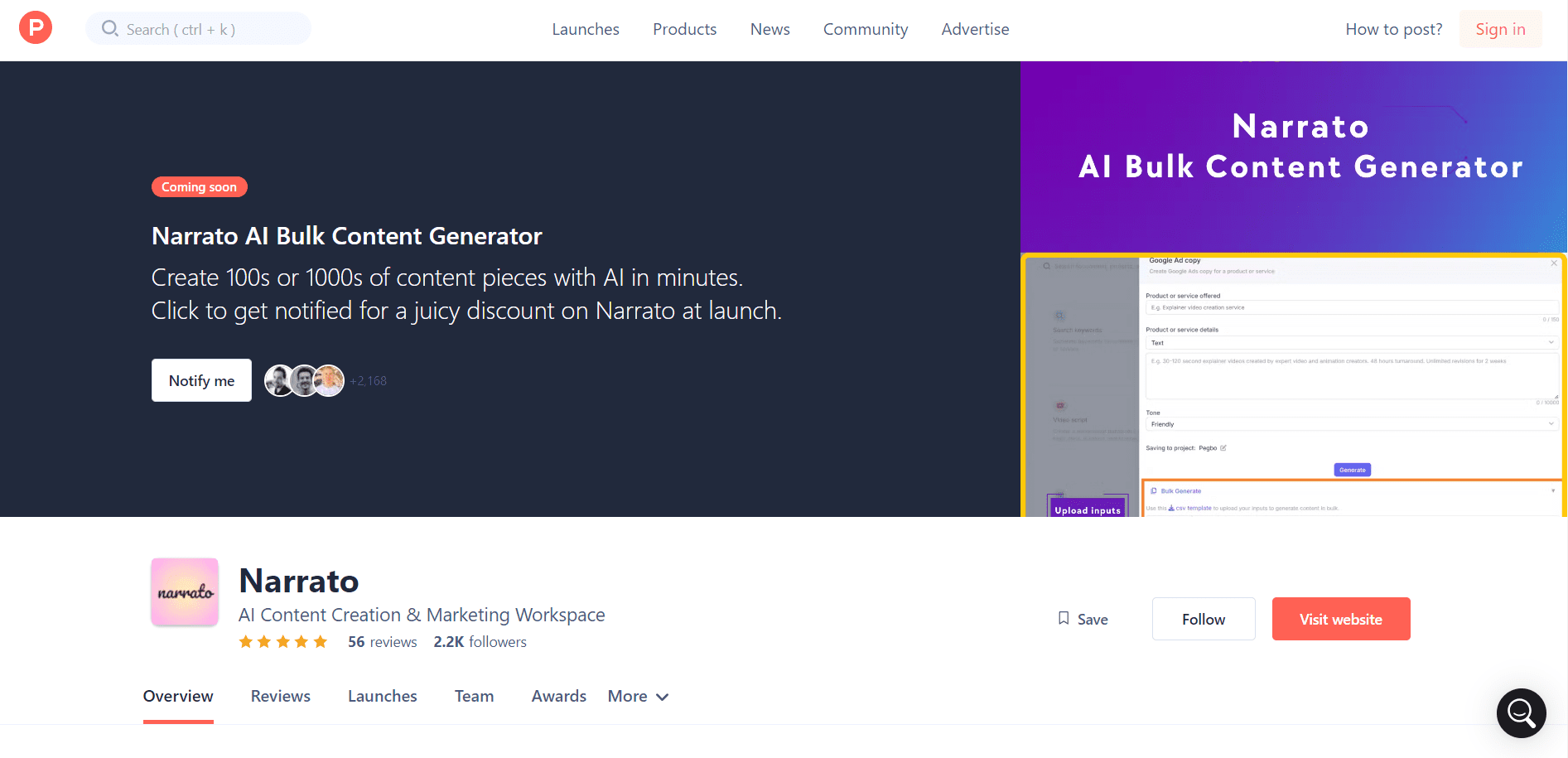
Leading up to the launch, we posted teasers on LinkedIn, including behind-the-scenes content, sneak peeks, milestones, and countdown posts.
We also used Facebook, Slack, and LinkedIn groups for Product Hunt promotion and actively engaged in the Product Hunt community.
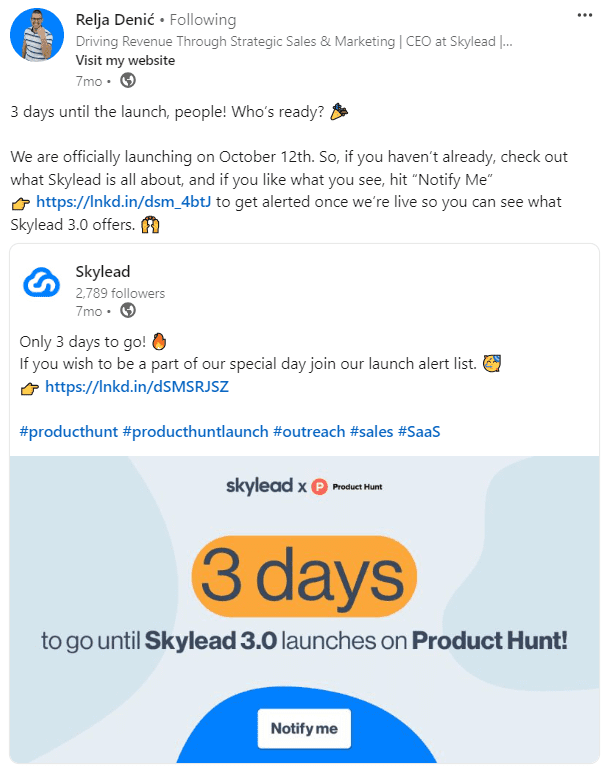
On launch day, we set up outreach campaigns yet again to remind people to vote. We also responded to every comment on Product Hunt!
This is just a speed run and a fraction of what we did, but as you can see, most of our Product Hunt launch marketing revolved around LinkedIn. And yes, we spent months preparing. But it’s that time and effort that got us 2nd place!
That same time and effort can bring you results if you ever decide to use LinkedIn to promote your Product Hunt launch.
Promote your community
You may not have a product launch to promote, but a community.
For instance, the marketing team behind Skylead uses LinkedIn to automate reaching out to different individuals and inviting them to join our Facebook community.
Of course, you may have a community on another channel to promote (e.g., a Slack group, subreddit, etc.). Regardless, you can use LinkedIn to promote it — as we do — and, thus, reach your audience faster.
11 strategies to leverage LinkedIn for B2B marketing
As you can see, there are plenty of situations that warrant using LinkedIn for B2B marketing.
That said, let’s put the wheels into motion and teach you how to leverage the platform’s B2B marketing potential.
Define your objectives for effective B2B marketing on LinkedIn
You can’t go into B2B marketing on LinkedIn without having a clear goal in mind.
But before defining objectives, you need to think about what you wish to use LinkedIn for. Is it for content distribution? To generate leads? Or both?
Your ultimate goals will vary depending on the use case. However, some of the common ones include:
- Driving more traffic to your website
- Boosting conversion rates
- Enhancing brand awareness
You don’t have to limit yourself to one goal only. In fact, it’s preferable to have a few well-defined objectives that align with your overall marketing strategy.
Identify your ICP and buyer persona
For your marketing efforts to come to fruition, you need to know that the people you are targeting are the ones who will respond to your messaging.
So, after figuring out your goals, it’s time to understand who your Ideal Customer Profile (ICP) and Buyer Persona are.
ICP is a fictional representation of the company that would get the most value from your product/service and provide the most value to your business in return. Meanwhile, a buyer persona is an ideal decision-making individual in that same company.
If you don’t have clients, users, or customers, consider factors such as your target audience’s demographics, locations, job titles, industries, and company sizes when creating your ICP and buyer personas.
However, if you already have them, identify and analyze the best ones.
Create a striking company page
Your LinkedIn company page is your brand’s face on the platform.
That said, you need to make sure it’s compelling and informative.
Use a high-quality logo, a striking cover image, and a clear description of your business. Don’t forget to highlight your products/services and any unique selling propositions you have!
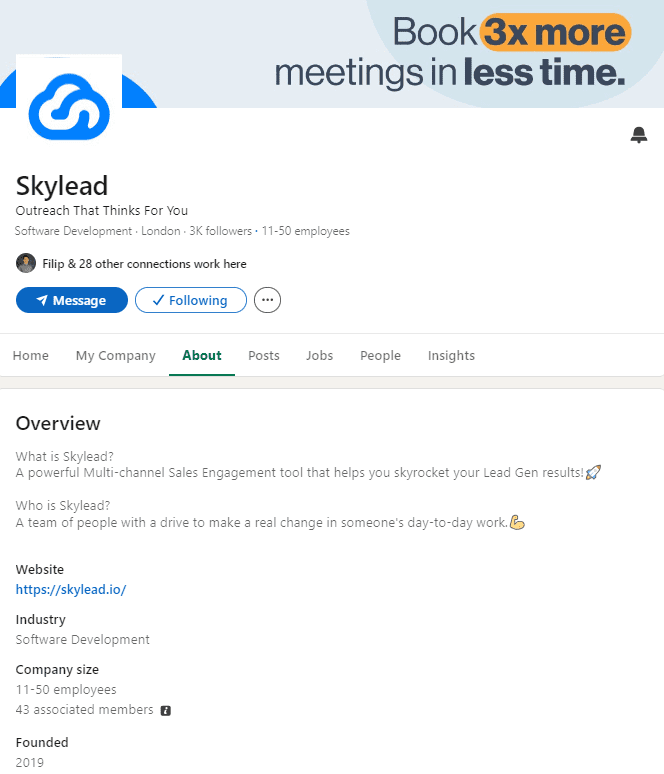
Once you’ve set it up, use your company page on LinkedIn for B2B marketing by sharing relevant content that your audience finds valuable.
Complete your LinkedIn profile with B2B marketing in mind
Your personal LinkedIn profile is as important as your company page, especially if you are in a decision-making role.
With that in mind, pay special attention to your LinkedIn headline. Why? Because it’s among the first things your profile visitors will notice — along with your LinkedIn cover photo and profile image.
You’ll want to optimize it with relevant keywords to increase visibility on LinkedIn search. The same goes for your LinkedIn URL.
Your LinkedIn summary section is also important. But bear in mind that without clicking ‘’...see more,’’ your visitors can see only around 300 characters of your summary. For that reason, you need to find a way to hook readers right from the start!
Include keywords here, as well, to make sure those who rely on Boolean search can stumble across your profile.
Create engaging content
Let’s say you managed to draw in a substantial audience using the strategies outlined above. However, now comes the real challenge: keeping them engaged over time.
Luckily, since the content is king on LinkedIn, it’s also your gateway to retaining the audience.
That said, it’s your job to share content that’s both interesting and informative.
Think of it this way: the better the quality of your content, the more success you will find with B2B marketing on LinkedIn.
To enhance it further, include relevant hashtags whenever possible. Our experience tells us that it’s best to keep hashtags to a maximum of 5, though.
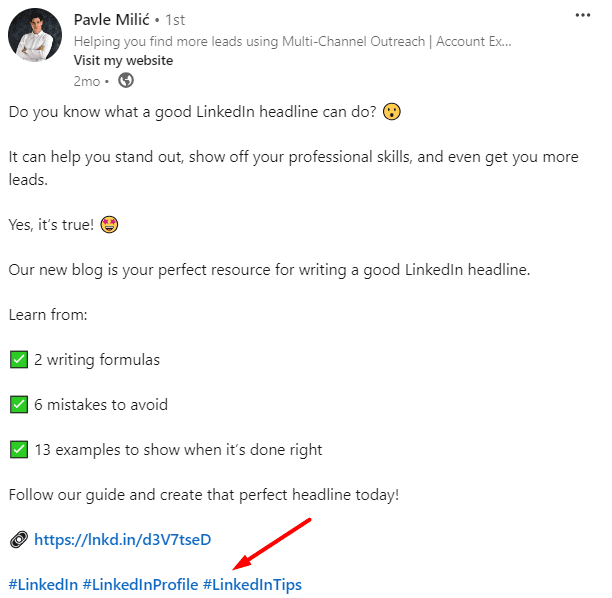
Adjust your tone of voice when using LinkedIn for B2B marketing
Your tone of voice on LinkedIn should be professional yet personable.
In fact, it’s that genuine and relatable communication that helps build trust with your network.
So, avoid overly formal language by all means and strive to be authentic and engaging.
Experiment with formats
People get tired of the same-old same-old type of content fast. That’s why you should diversify it.
Don’t be afraid to experiment with different formats, such as regular posts, images, videos, and native articles.
Variety keeps your audience asking for more and pleases those with different preferences for content consumption.
Create a posting schedule
You can’t expect to make a splash on LinkedIn with your B2B marketing efforts if you commit to posting every couple of months. Consistency matters a lot!
So, develop a posting schedule and stick to it. Regular posting keeps your brand top of mind and helps maintain engagement.
As for how often you should post, aim for at least 3-4 posts per week. To make scheduling easier for you, you can use LinkedIn’s scheduling feature to schedule all posts for that week.
Also, the time you post is as important as the frequency of posting. With that in mind, avoid doing it on weekends and during off hours, as most professionals aren’t browsing LinkedIn when away from work. Furthermore, adjust your posting schedule so it fits the time zone of your target audience.
Use automation to streamline outreach and LinkedIn for B2B marketing efforts
Much of B2B marketing on LinkedIn involves outreach. Manual outreach takes a long time, especially if hundreds of leads are involved.
But why bother with it when LinkedIn automation tools like Skylead exist, and you can use them to reach out to your leads on autopilot?
That being said, with Skylead, you can set up automated Smart sequences to reach all leads — one way or the other — by combining:
- Profile views
- Follows
- Connection requests
- Messages
- Free and paid LinkedIn inMails
…with conditions (If Connected, If Email Found and Verified, etc.).
These conditions put ‘’smart’’ in ‘’Smart sequences’’ and allow them to determine the fastest route to your prospects based on their behavior.
Plus, since the tool doubles as cold email software, you don’t have to worry if your leads aren’t responsive on LinkedIn. Smart sequences let you tap into multichannel outreach by letting you reach out to them via email, too. Within the same campaign flow, nonetheless!
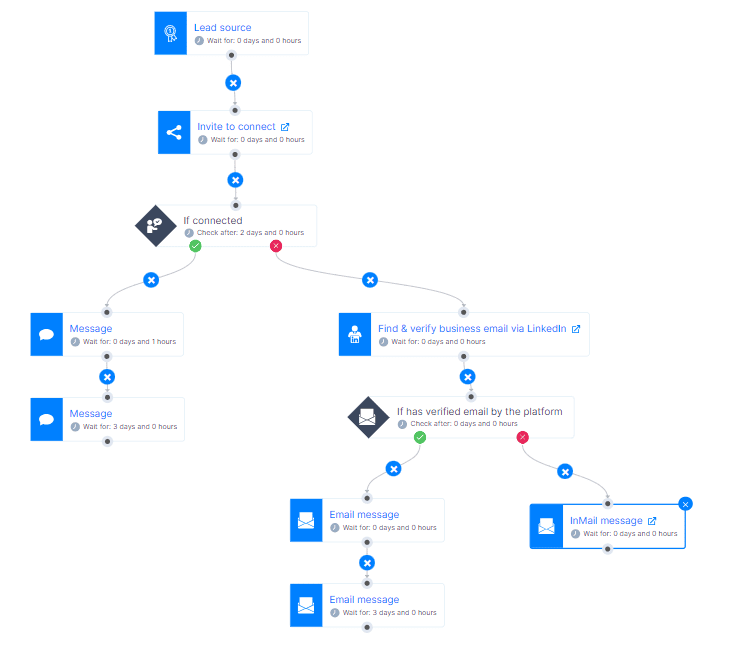
However, to take advantage of email outreach, you need your leads’ email addresses. Skylead’s email discovery and verification feature can help you obtain these, even if they are not available on your leads’ LinkedIn profiles!
To use it, just add the "Email Finder and Verifier" step to your campaign flow. The tool will then do its magic and consider emails valid only after double-verifying their existence.
Run retargeting ads
Those who have already visited your website are familiar with your brand. Chances are, they are more likely to convert and are, therefore, a perfect audience to target.
The question is, how?
Through LinkedIn retargeting ads.
However, before you create any ads, install LinkedIn Insight Tag on your website. The tag collects information about your website visitors that you can use to retarget these individuals through ads on LinkedIn.
But don’t run your ads as soon as you have added the tag to your website! Instead, we suggest waiting at least 2 to 4 weeks for it to collect sufficient information.
Retarget website visitors with LinkedIn Insight Tag
Wondering how to create an ad campaign on LinkedIn to re-engage past website visitors using LinkedIn Insight Tag?
Firstly, locate the ‘’For Business’’ menu in LinkedIn’s header section and click the ''Advertise'' button down below.

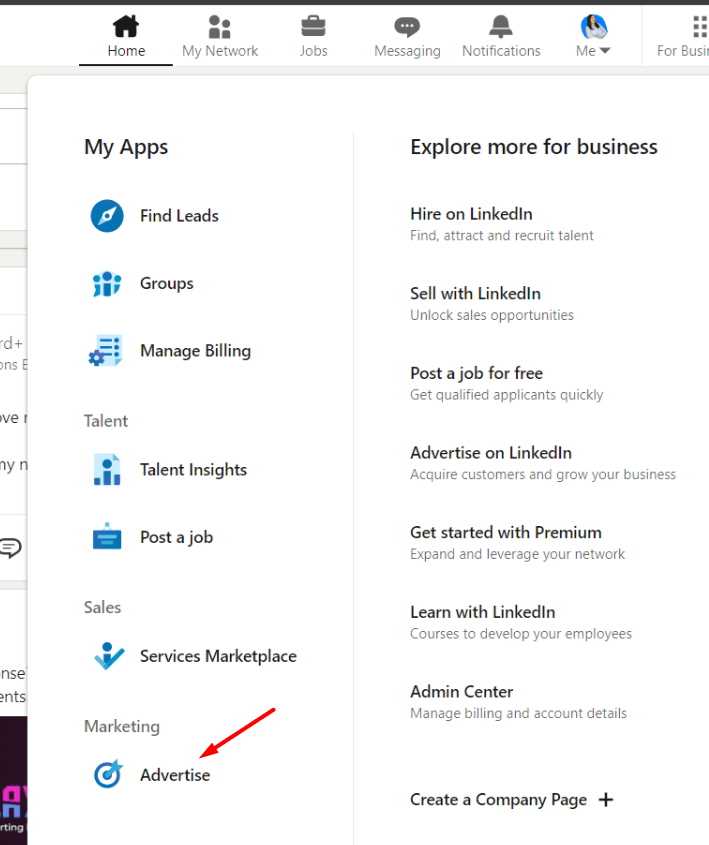
You’ll be taken to the Campaign Manager page, where you can create an account if you don’t have one.
Once you are in the campaign dashboard, however, hit ‘’Create’’ and select ‘’Campaign’’.
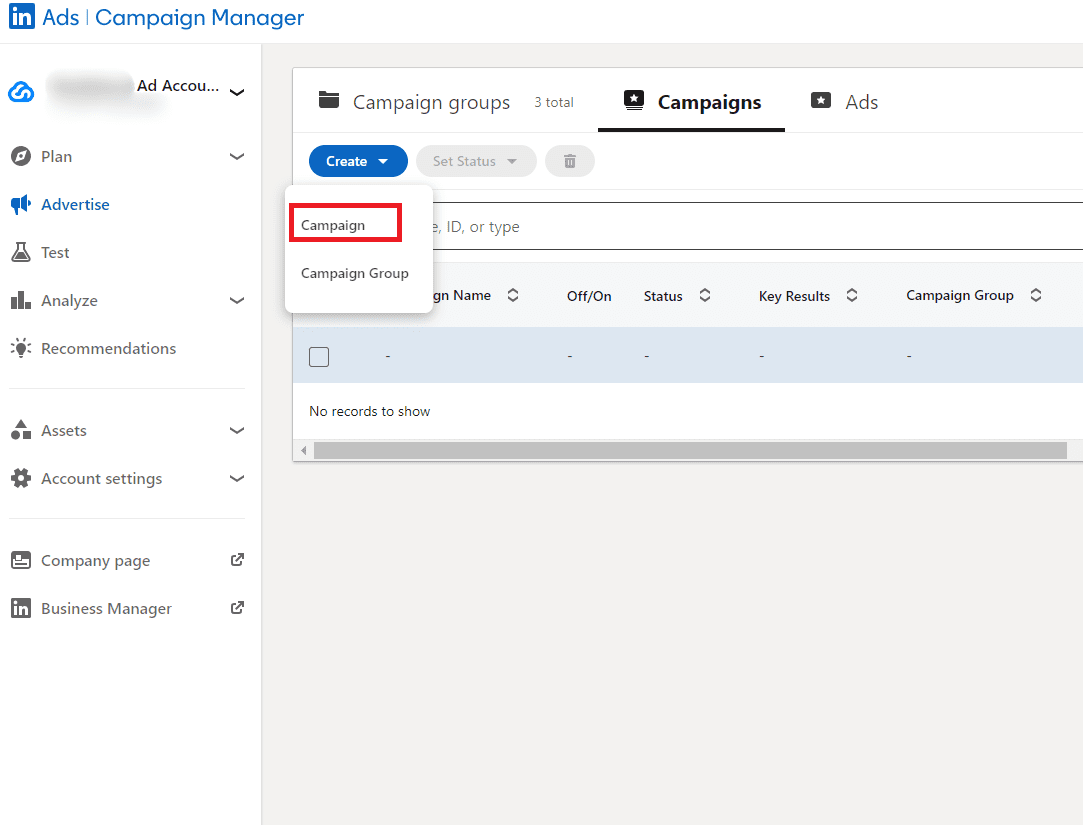
#1 Choose your campaign objective
To continue creating your ad, you need to insert the name for your campaign and choose your campaign objective.
As you can see, there are several objectives divided into 3 campaign categories:
- Awareness
- Consideration
- Conversions
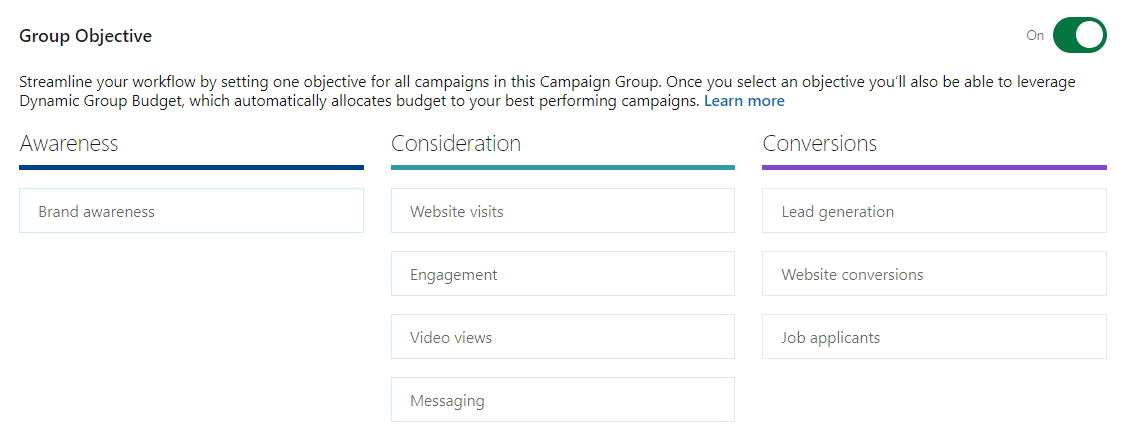
Here’s how to use each campaign type:
- Lead generation to get leads’ information. From our experience, the cost per lead is greater on LinkedIn than on any other platform.
- Engagement to increase interactions with your ad or get more Company Page followers.
- Increase video views.
- Messaging to start chatting with your leads.
- Website conversions to drive leads to perform a meaningful action on your website.
All these campaign types let you retarget your website visitors.
Nevertheless, for example purposes only, let’s assume you had a resource on your website you wanted them to revisit it for.
In this case, you’ll want to choose ‘’Website visits’’ as your objective.
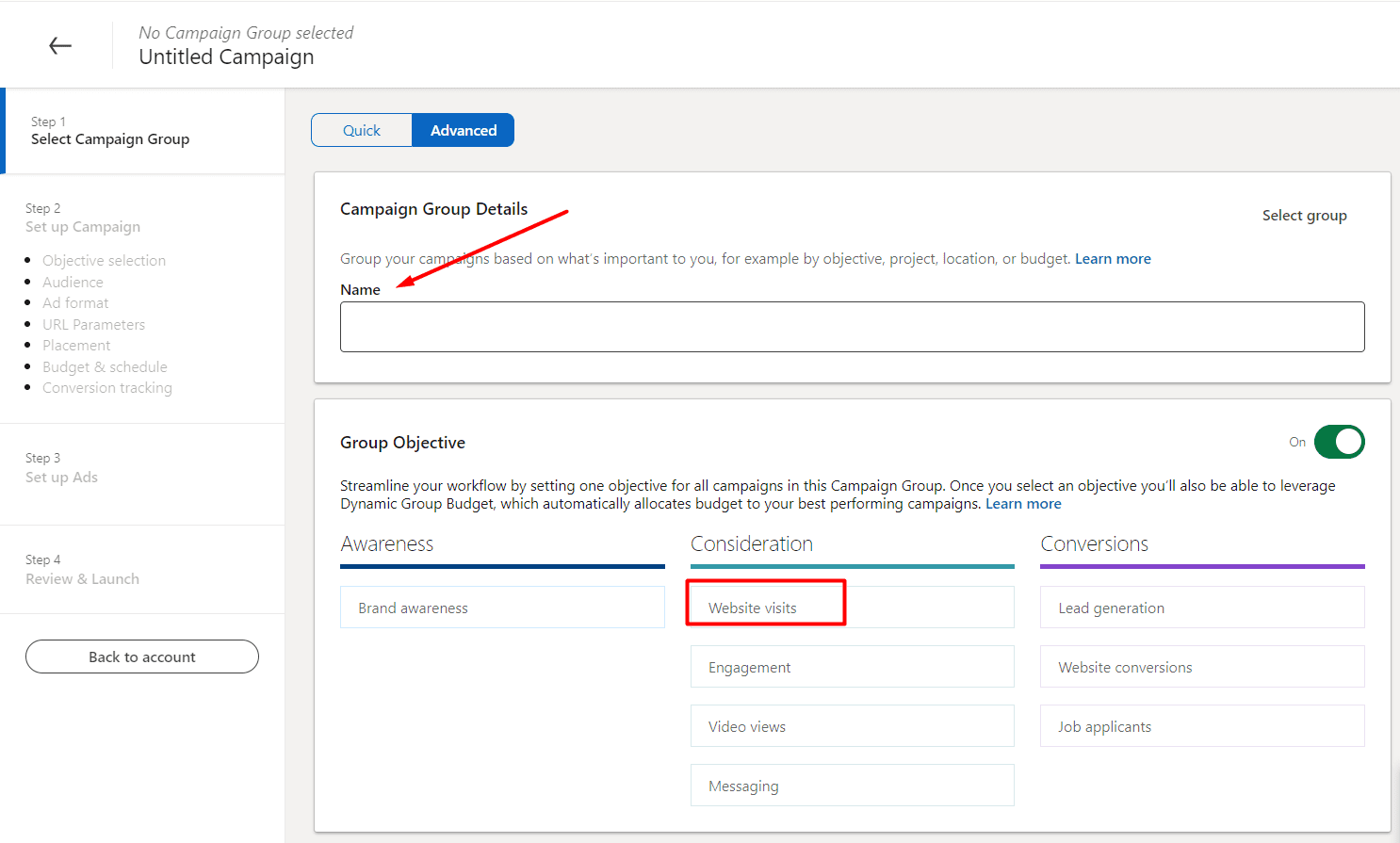
#2 Set up a budget and schedule for your campaign
If you are working with limited resources, you may want to set up a daily budget for your campaign. So, turn this option on or keep it off, depending on your preferences.
Also, don’t forget to set up your campaign schedule. Your campaign can be open-ended or have a clear start and end date.
Once you’ve decided on the optimal running time, click ‘’next’’.
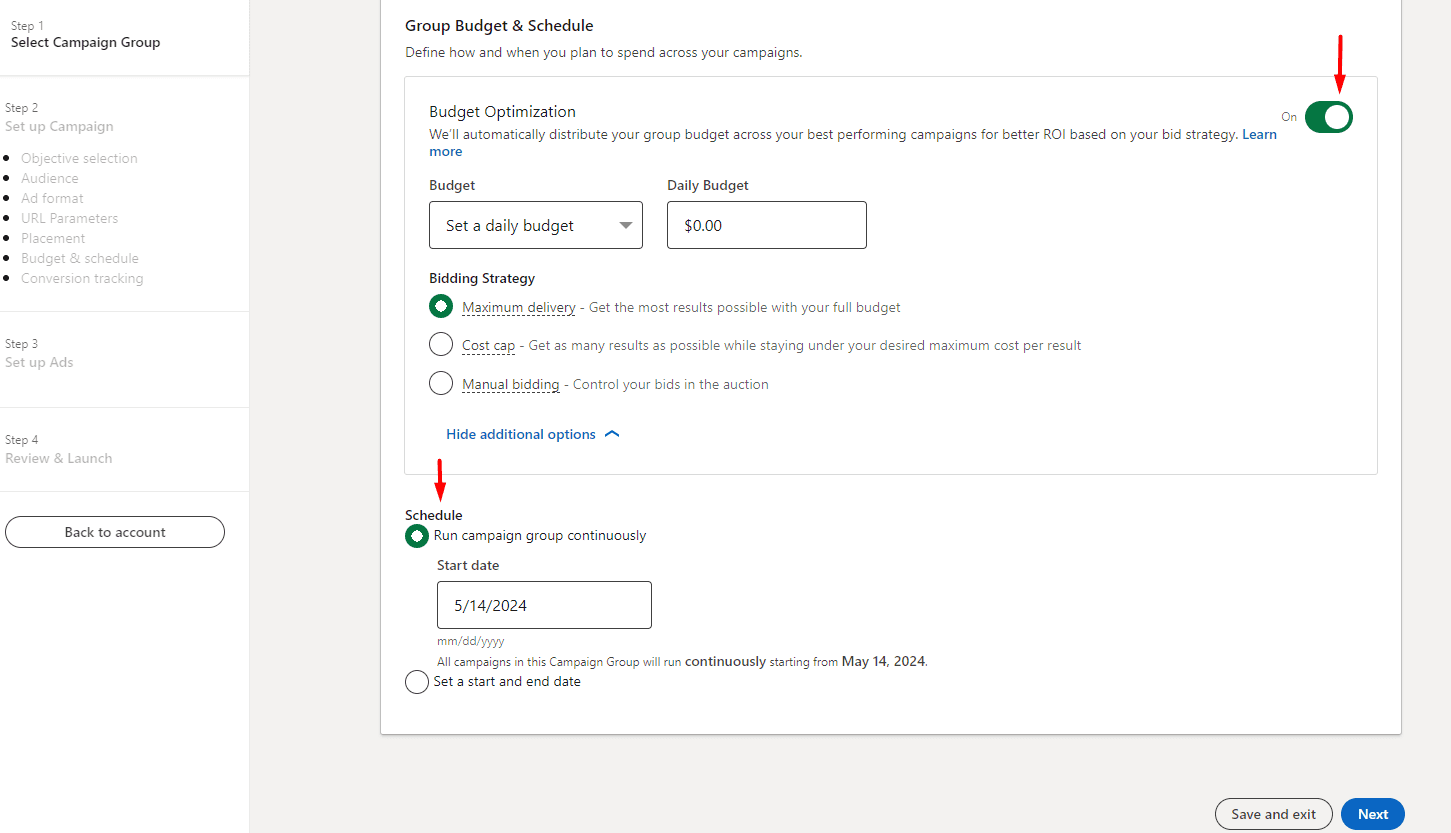
#3 Determine your audience
Now comes the time to configure your audience. Choose the ‘’Retargeting’’ option.
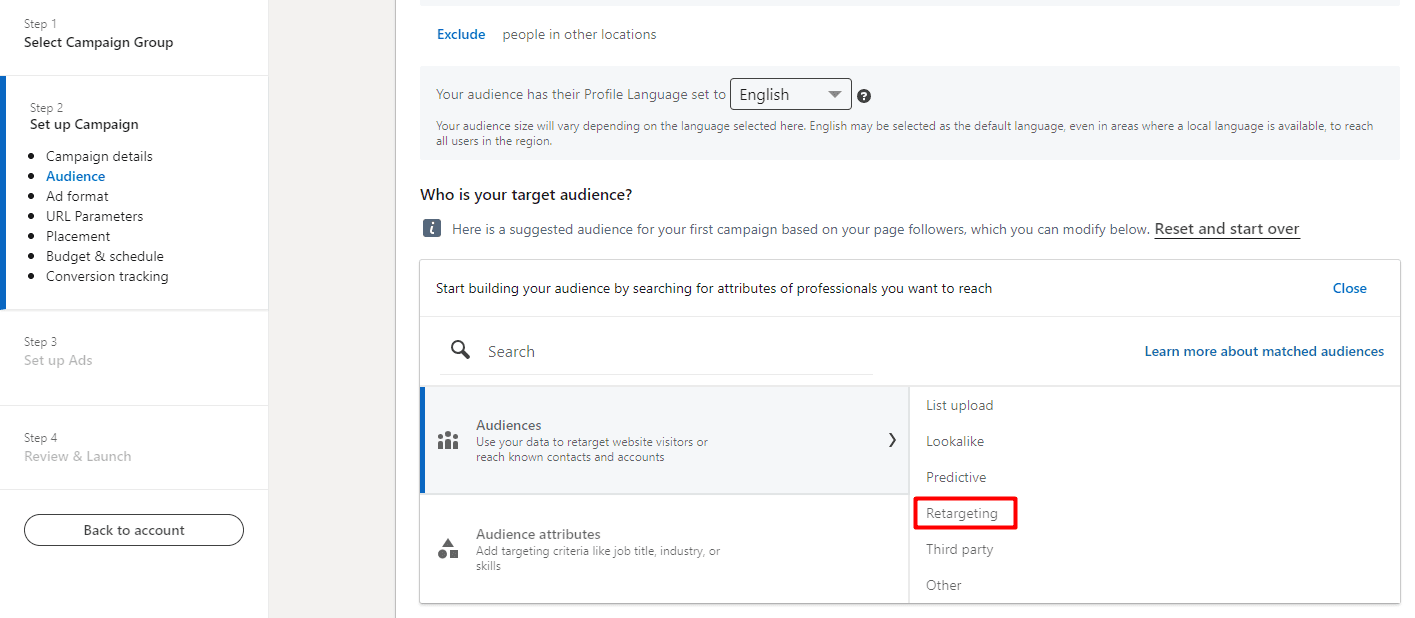
Next, choose ‘’Website’’ and select the audience of your website visitors that you already created.
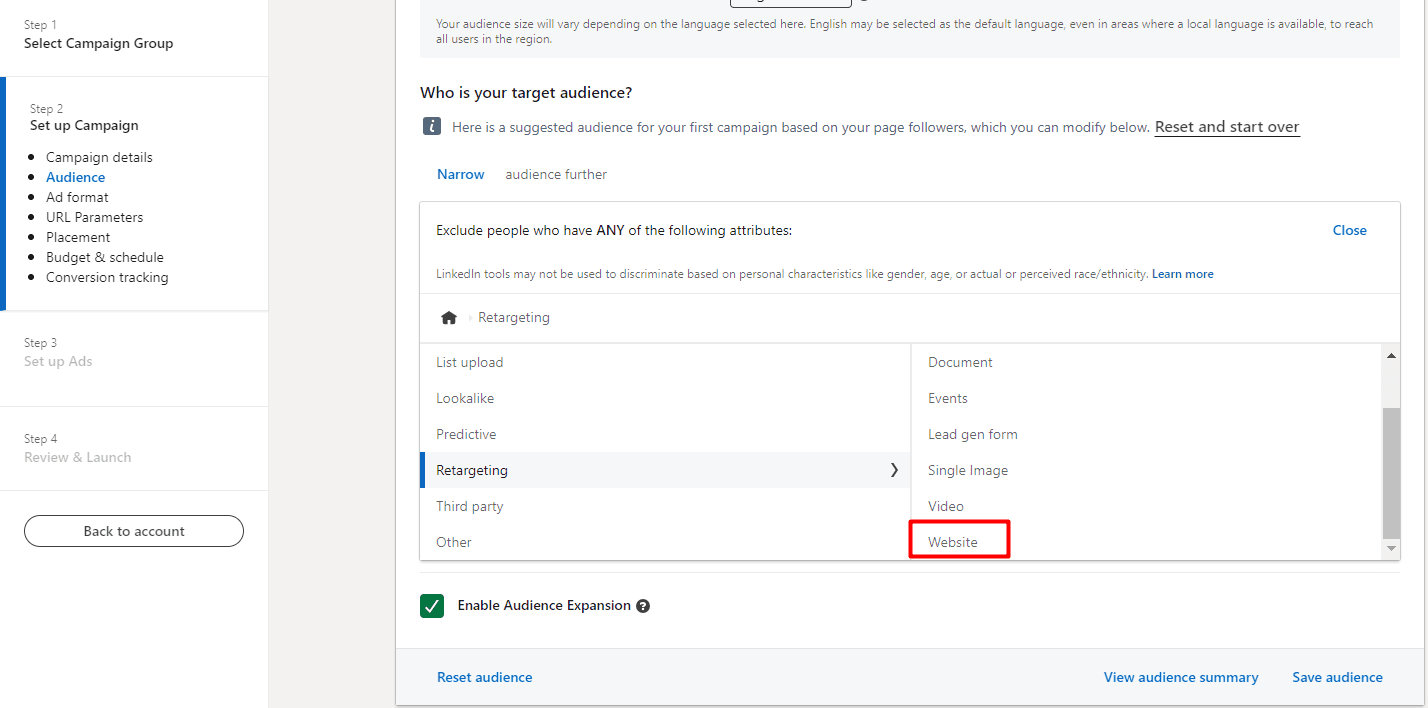
#4 Select the ad format and create your ad
After you define your audience, it’s time to create your ad. That said, select the ad format from the following options.
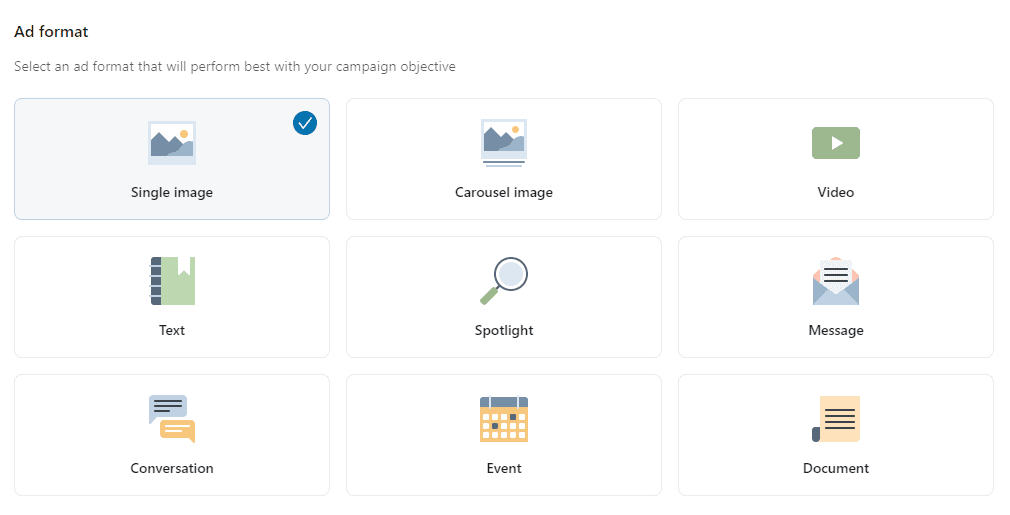
…and placements.

Depending on your goal, you can also set up URL tracking parameters and conversion tracking.
What we can tell you from experience, though, is that it's better to set them up. In doing so, you'll be able to track the results of your campaigns with the end goal.
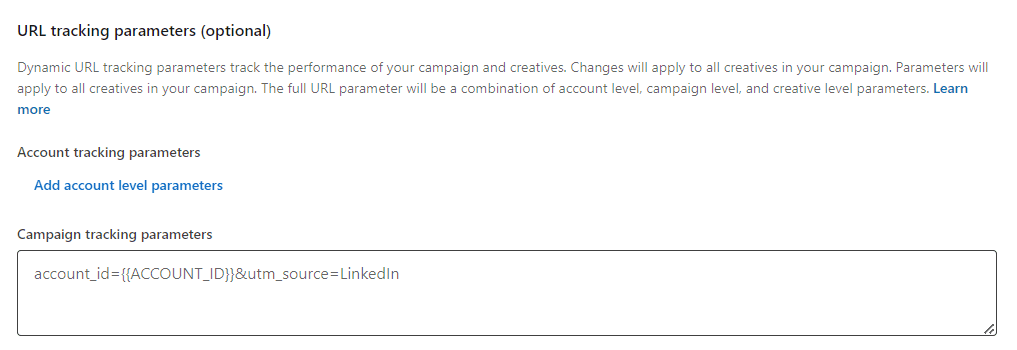

And now comes the fun part: ad creation.
To create one, click ‘’Create new ad’’.
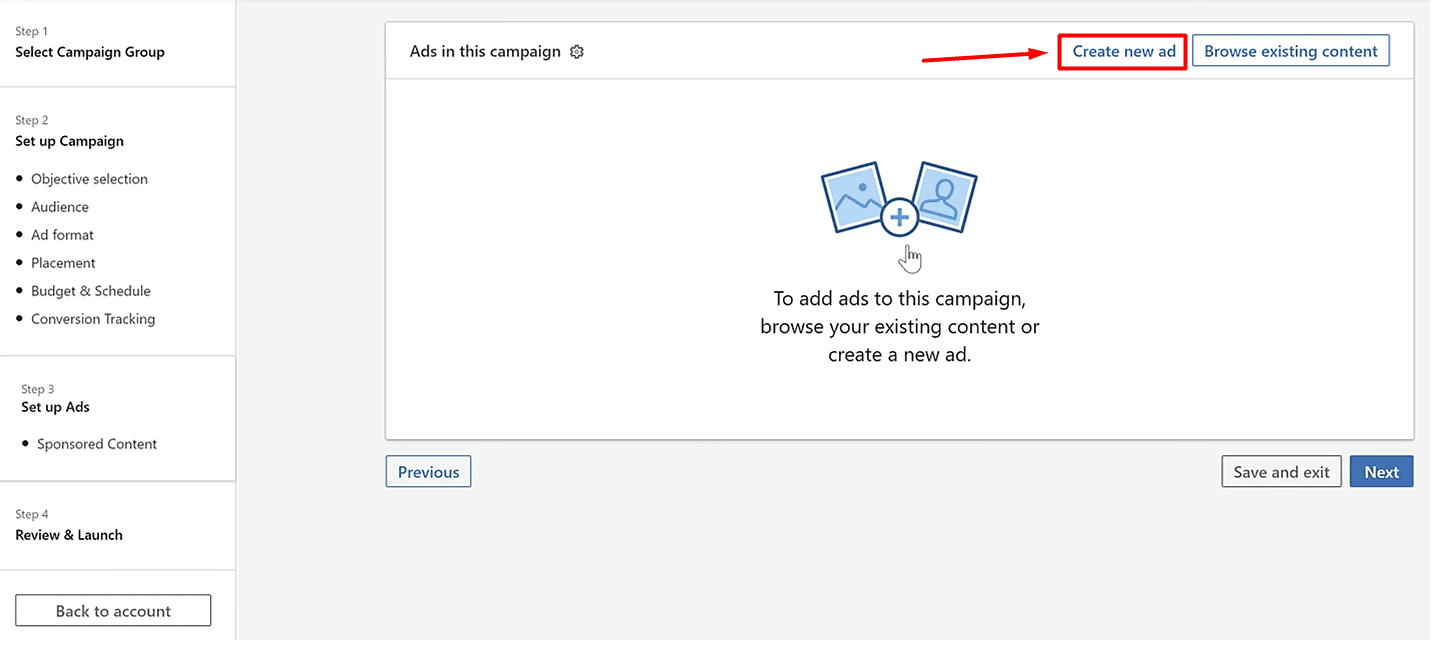
You’ll be taken to an ad builder page where you can input your message, website URL, visuals, etc. Just bear in mind that the interface (and options) will differ depending on the ad format you have chosen.
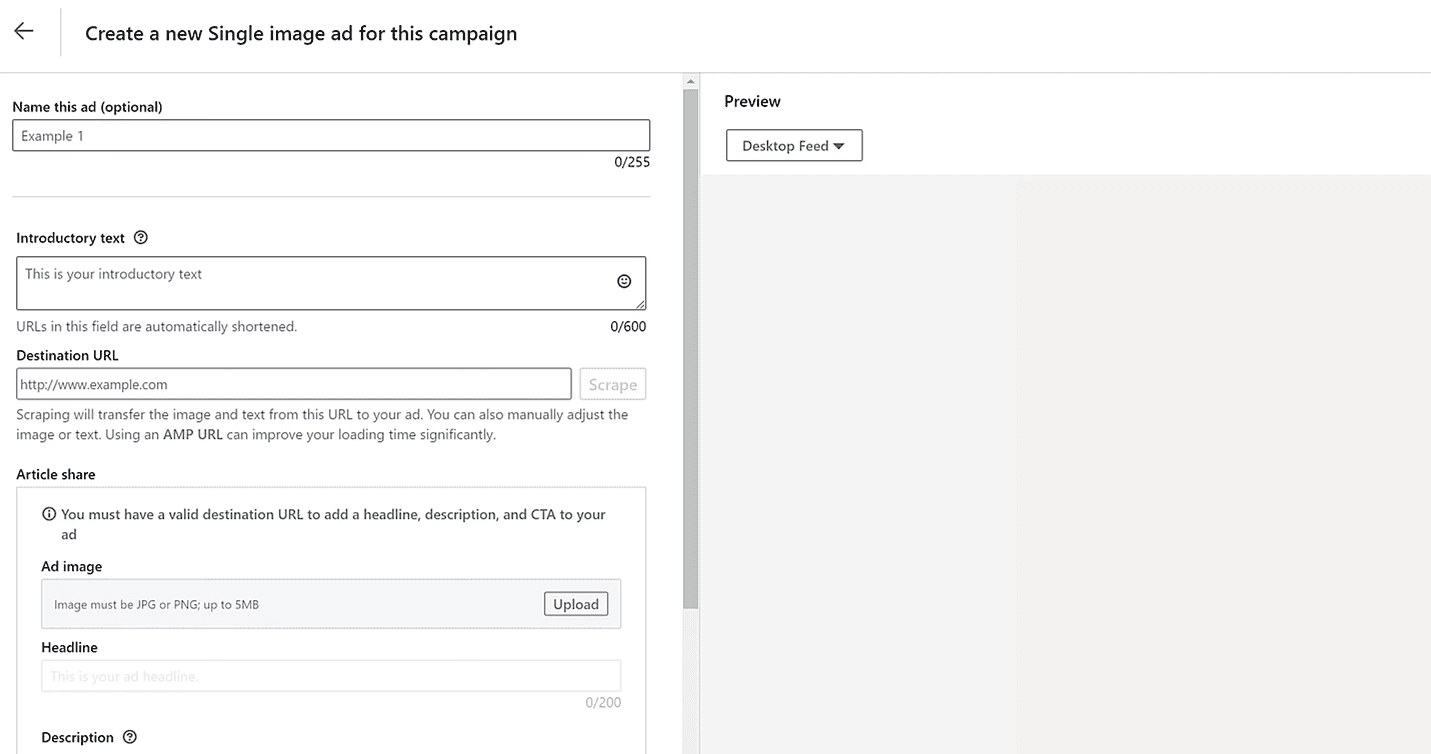
Build retargeting ads with emails
Did you know there was another way to expand your reach and get to people who are highly likely to convert? You just need to create a Predictive audience from the emails of people who have interacted with your brand.
The Predictive audience is somewhat of a hybrid between LinkedIn’s no longer-existing Lookalike audience and conversion-based retargeting.
It’s also the best type of audience in B2B marketing for reaching new, similar leads on LinkedIn and making your campaign worthwhile.
#1 Use Skylead to find and verify your audience’s emails
Skylead’s email discovery & verification can help you find the emails of your best leads, which you can use to create a Predictive audience!
To take advantage of it, first, create a CSV file with the LinkedIn profile URLs of your best-converting customers or high-quality leads. Click here to learn how to create a Skylead-friendly CSV file.
Then, navigate to Skylead’s dashboard and locate the Campaigns page.
Click ‘’Create campaign’’.
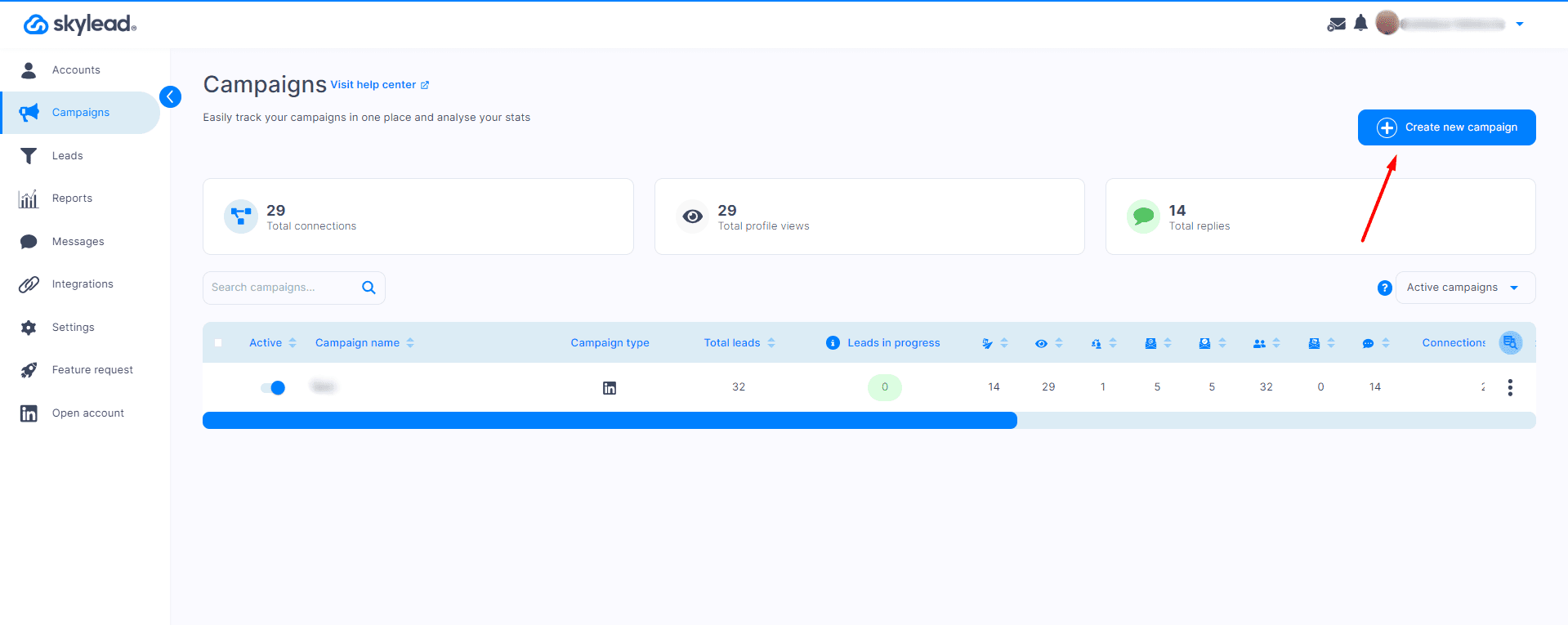
Our software lets you choose between the following lead sources.

However, in this case, you should choose ‘’Import’’ and upload a list you have created.
Also, don’t forget to input your campaign name.
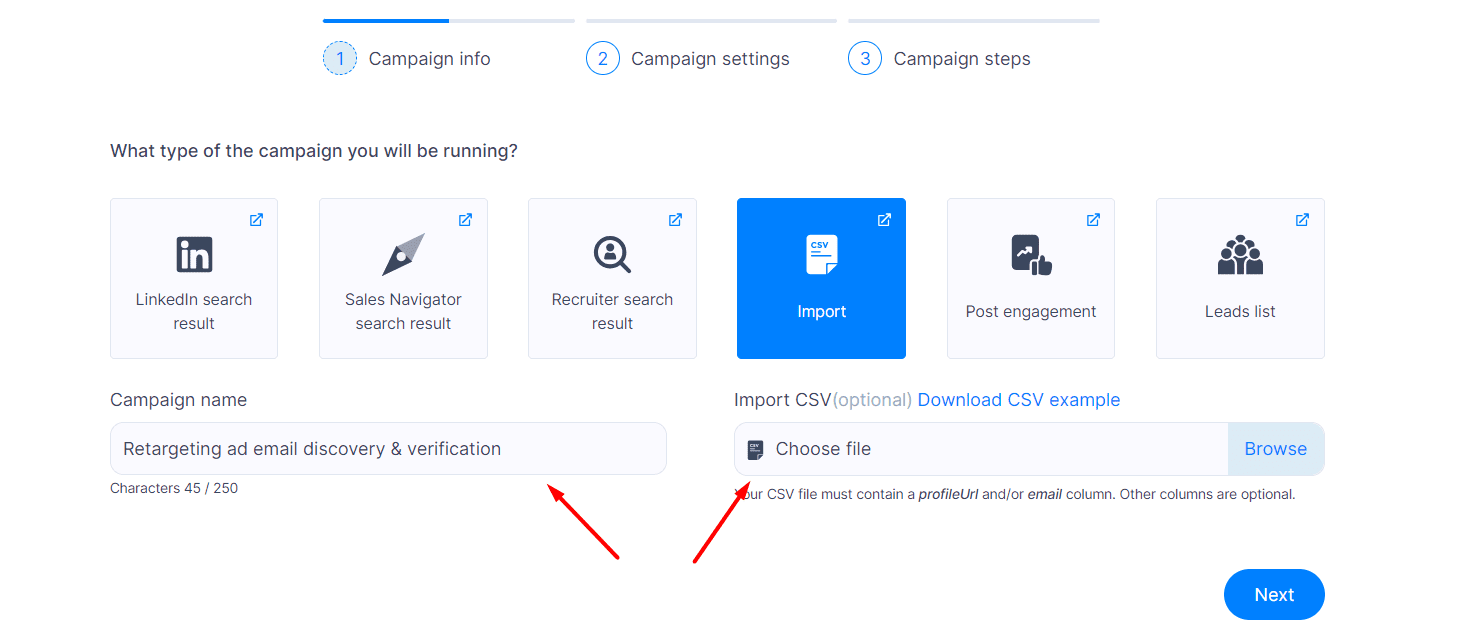
After uploading a file and naming your campaign, click ‘’Next’’.
If this were a typical campaign, you’d need to define your global, LinkedIn, and email outreach settings.
But since no outreach is involved, proceed to the ‘’Create sequence’’ step immediately.

Choose the ‘’From scratch’’ option to be taken to a campaign builder page.
Then, replicate the Smart sequence below and start the campaign to have the tool discover and verify leads’ emails.
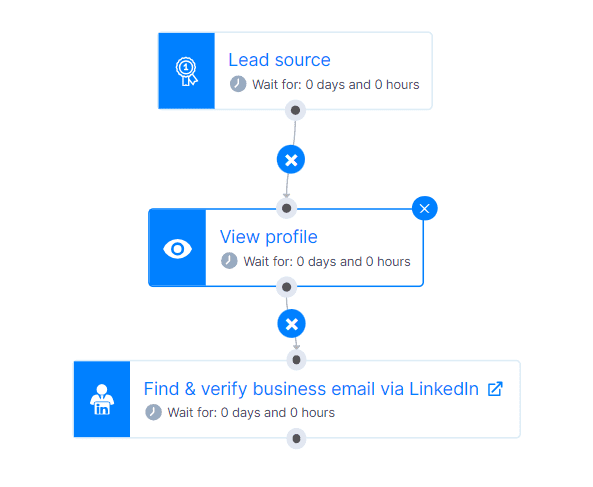
When the results are in, go to the Leads page, select the campaign from the drop-down menu, and click the ‘’Export leads’’ button to download the CSV file with your lead information.
This file will include your leads’ information and email addresses that Skylead was able to find and verify.
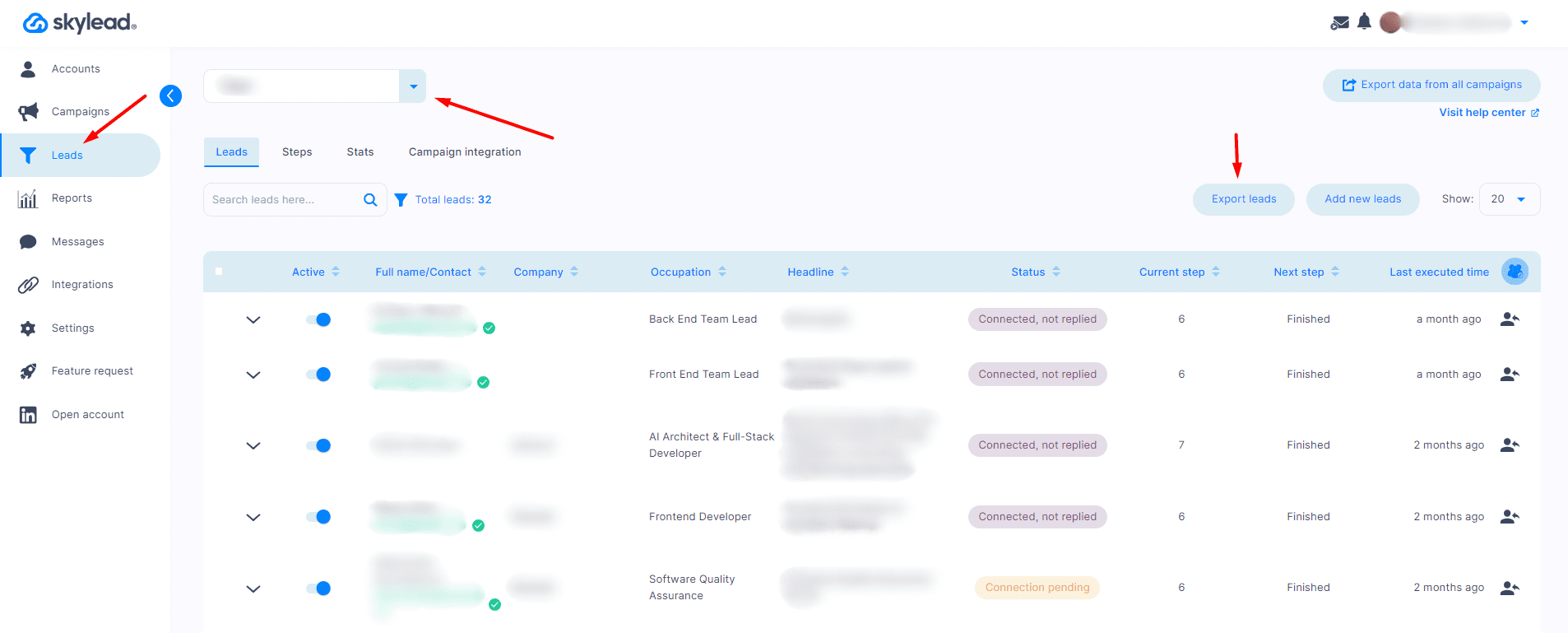
#2 Create your Predictive audience
Next stop: LinkedIn’s Campaign Manager. This is where you’ll want to create your audience first.
To do so, click ‘’Plan’’, and then ‘’Audiences’’ in the sidebar menu on the left.
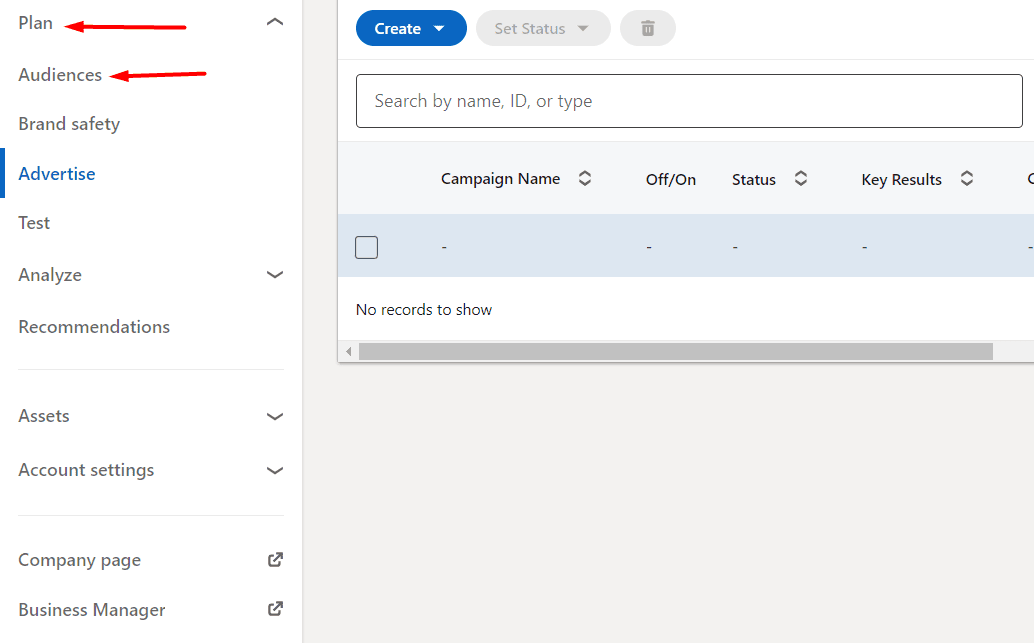
Once you're on the Audiences page, hit the ''Create audience'' button and choose ''Predictive''.
A new menu will pop up, and you'll need to name your audience.
After doing so, open the drop-down menu to select the source from which you’d like to create your audience.
Choose "Contact list'' and upload your list.
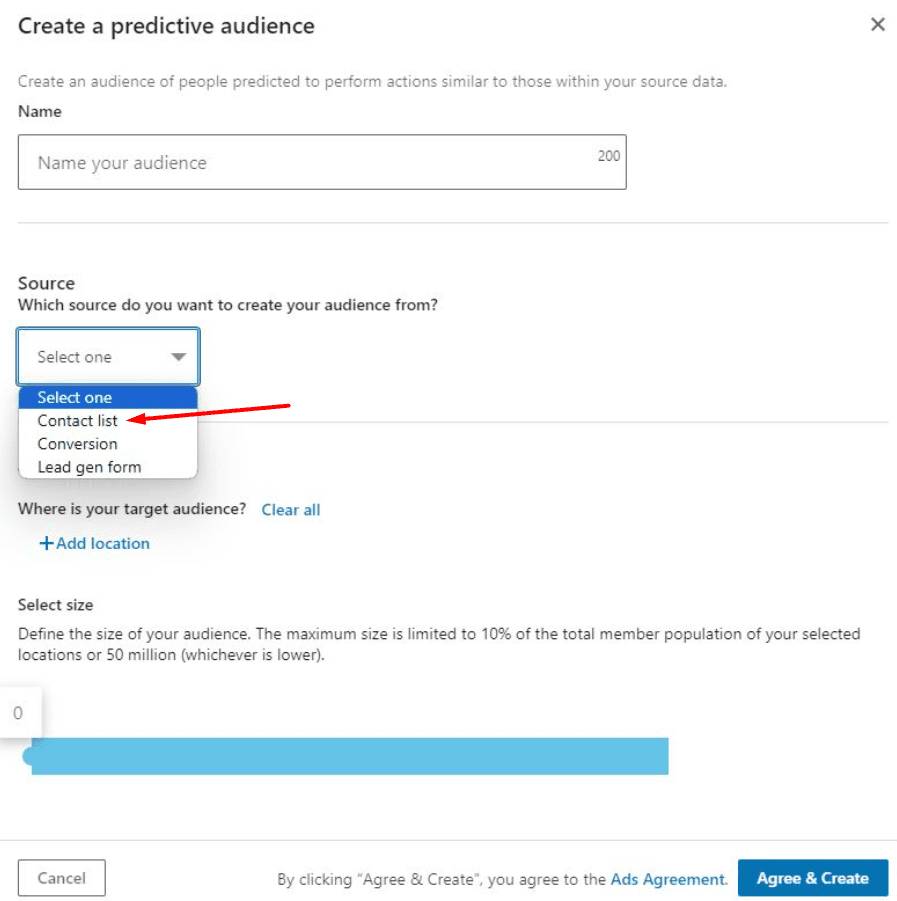
After that, choose the location of your target audience and use the slider to select its size.
Finally, click ''Agree & Create.''
📝 Note: Your list must have a minimum of 300 members and a maximum of 300,000. Otherwise, you can’t create a Predictive audience. Also, before hitting launch on your campaign, it’s best to let your audience populate.
#3 Create your ad campaign
Once your audience is created, go back to the Campaign Manager dashboard to create your campaign.
Name it, choose the objective, and set up your budget and schedule just as you would with any other campaign.
However, when the time comes to define your audience, instead of the ‘’Retargeting’’ option, choose ‘’Predictive.’’ Then, select the audience you’ve previously created.
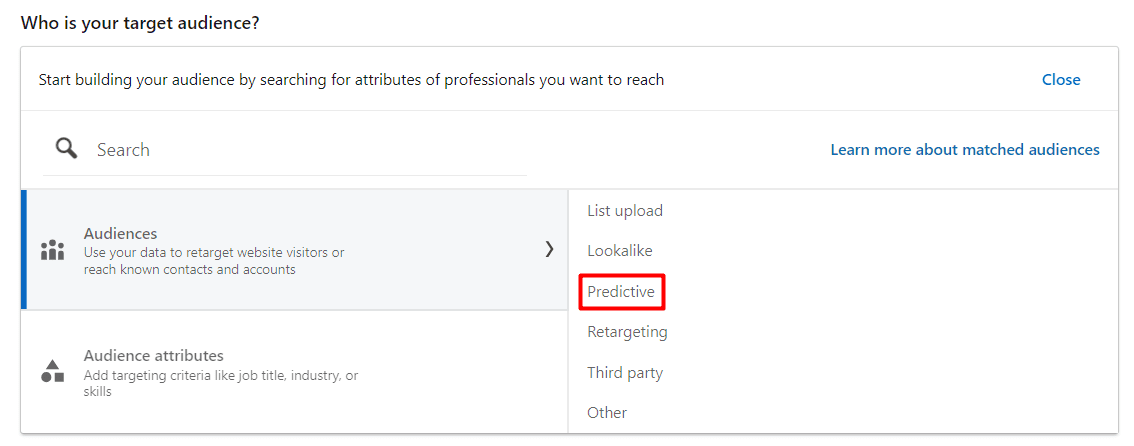
The rest of the campaign creation process follows the same steps we covered for retargeting website visitors with the LinkedIn Insight Tag.
So, go through them, work on your ad, and when you’re happy with everything, launch your campaign!
Personalize your outreach
Nobody likes receiving a generic message. So, if you want to leverage LinkedIn for B2B marketing in its full capacity, personalize your outreach.
Refer to your prospect by their name, mention a detail from their profile, a mutual connection, or anything else you like to make the conversation more engaging. This comes rather naturally with Skylead’s default and custom variables.
However, if you decide to automate your outreach, our native Image and GIF personalization feature can be a real changer! Use it to upload any visual you like and enrich it with your and/or your leads’ LinkedIn profile image, their company logo, a custom logo, or text with variables. Then, import the final product into your messages to increase your response rate up to 63% without the extra charge!
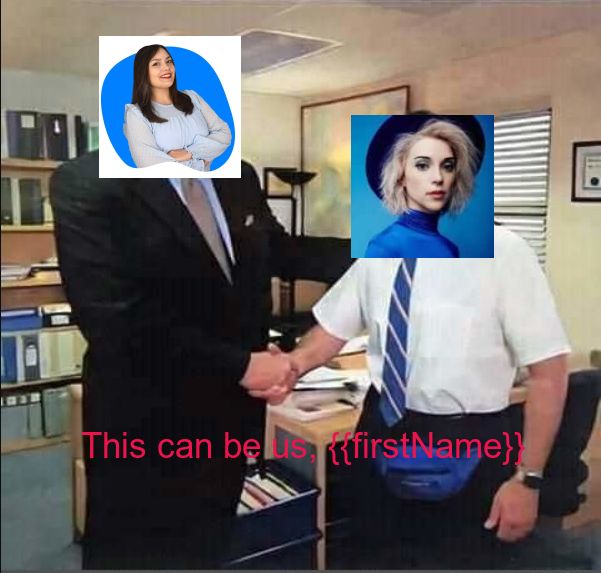
Frequently asked questions (FAQs)
1. How many B2B marketers use LinkedIn for B2B marketing?
A significant majority of B2B marketers use LinkedIn for their marketing efforts. Specifically, 96% of B2B marketers use it for content marketing, making it the leading platform for B2B content distribution. Additionally, LinkedIn is exceptionally effective in generating leads, with 89% of B2B marketers relying on it for this purpose.
2. How do you measure the success of LinkedIn B2B marketing campaigns?
To measure the success of LinkedIn B2B marketing campaigns, track metrics like engagement rates, conversion rates, and website traffic from LinkedIn. Use LinkedIn Analytics and Google Analytics to monitor these KPIs and adjust strategies accordingly.
3. How can small businesses with limited resources effectively leverage LinkedIn for B2B marketing?
Small businesses can leverage LinkedIn for B2B marketing by focusing on organic growth strategies, such as networking and sharing valuable content. They can also utilize free LinkedIn features and gradually invest in affordable tools to streamline outreach and content distribution, such as Skylead.
Don’t miss out on LinkedIn’s B2B marketing potential!
Congratulations! You've made it thus far!
And since you have, you are aware that LinkedIn provides an unmatched opportunity to connect with the decision-makers who can drive your business forward. You've also learned the strategies that can help you fully utilize LinkedIn for B2B marketing.
But theory alone won't drive results; it's the execution that makes all the difference. So, feel free to apply the learned to enhance your brand's visibility, form strategic partnerships, and ultimately scale your business.
Finally, when ready to take your B2B marketing efforts on LinkedIn to the next level, try Skylead. Sign up for your 7-day free trial as soon as today and start transforming your LinkedIn presence into a powerful B2B marketing engine.
LinkedIn groups as a lead generation tool. How is this possible?
As the most prominent professional social networking app, LinkedIn holds great potential for lead generation, giving you a chance to scale your business. LinkedIn has over 1 billion users, and 48% of them are active monthly. Even when you narrow your search to your target audience, that’s huge potential for LinkedIn prospecting.
So, how do LinkedIn groups fit into the story? In this article, we will show you the following:
- LinkedIn groups use cases and benefits
- How to create and join the right LinkedIn groups
- How to use LinkedIn groups for lead generation
- How to use automation to target LinkedIn group members
- LinkedIn group outreach message templates
What are LinkedIn groups
LinkedIn groups are communities that gather around specific interests, industries, shared ideas, and more. Members share insights and experiences, ask for guidance, and build valuable connections for further professional development. Marketers can use these groups to share content and ad placement, salespeople can exchange pitches and tips and ask for advice, and founders can create discussions, share experiences, and network with other founders.
LinkedIn group types
On LinkedIn, you’ll find three group types:
- Private Listed Group - These types of groups appear in LinkedIn search results. If you’re a member of this group, it will be visible to other members on your LinkedIn profile under the Interests section. Other LinkedIn users can see whether their connection is a member. However, only group members can see posts in this group.
- Private Unlisted Group - These groups do not appear in search results for non-group members and are also not visible to others on your LinkedIn profile. You can access the group when invited or through a direct link.
- Public Group - These group types appear in search results. Anyone on or off LinkedIn can see posts in these groups.
Note 💡: If you want to change the type of your group, you can only change a private group to public, but not a public group to a private one. However, if you want to change the discoverability of your group, you can:
- Click the Edit group on the left side.
- Under Discoverability section, select your group type by choosing Listed or Unlisted,
- Once you’re done, click Save.
How to create and join LinkedIn groups
Create LinkedIn groups
People create LinkedIn groups to gather people and form communities that encourage engagement, content and experience exchanges, and making solid business connections. Even though most LinkedIn groups are inactive nowadays, you can still make one if you wish to give it a go. That said, let's go over it step by step.
Go to your LinkedIn homepage, and find and click on Groups in the left corner of your screen.
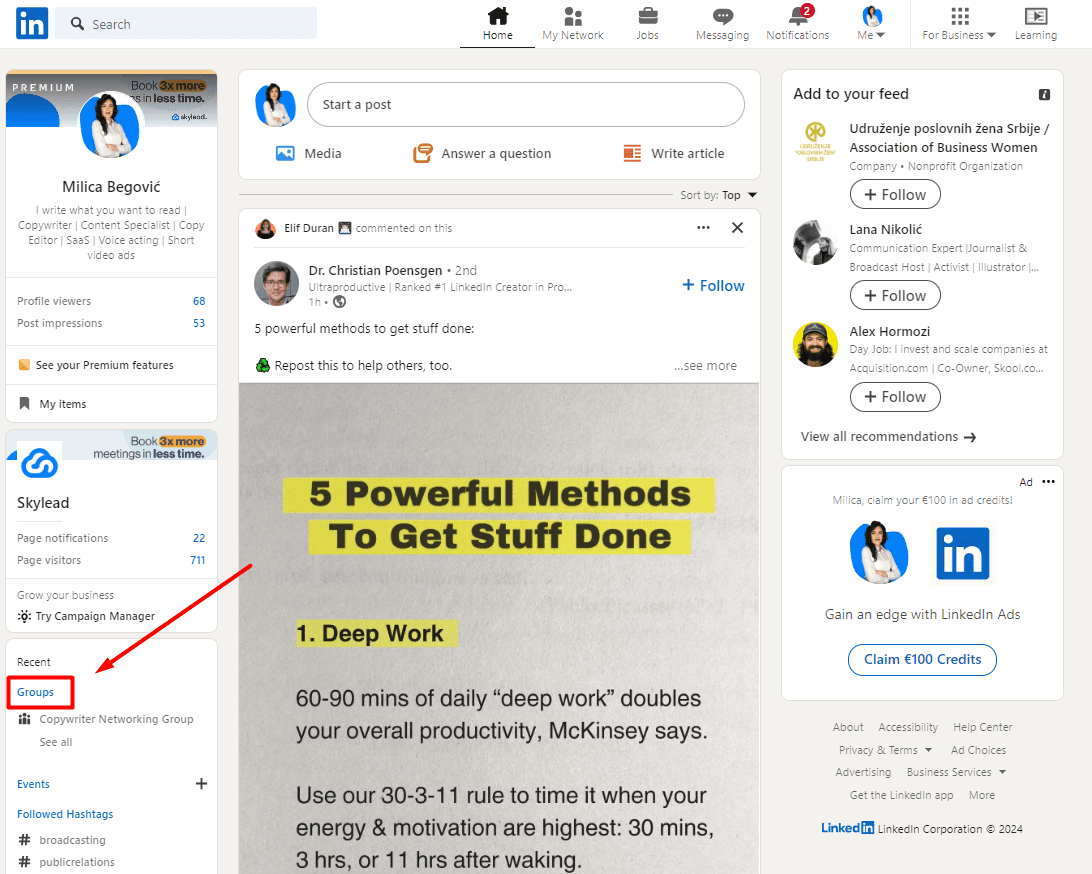
From there, click the “Create group” button.

Next, this pop-up will appear, and you should fill in the required fields. It is best to fill in detailed information about your group, and make it specific to attract the right kind of crowd.
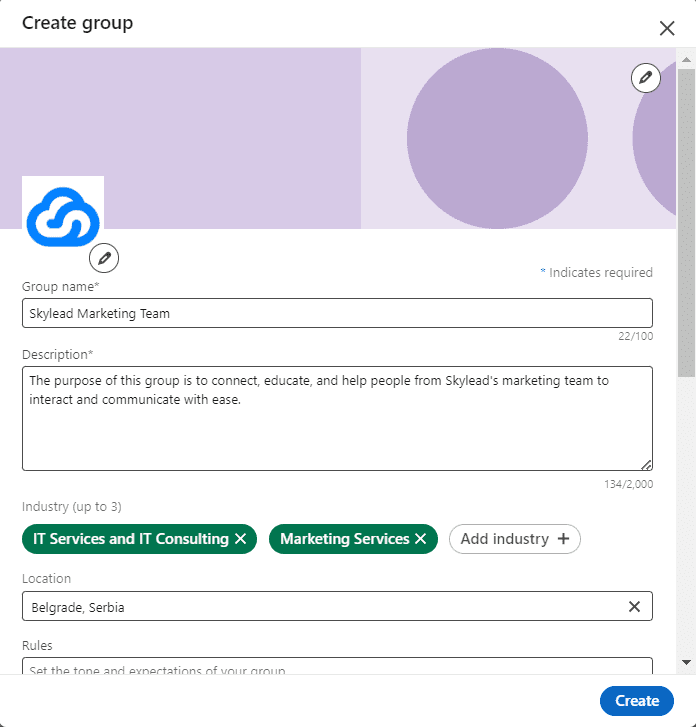
Don’t forget to set your group type, discoverability, and permissions.
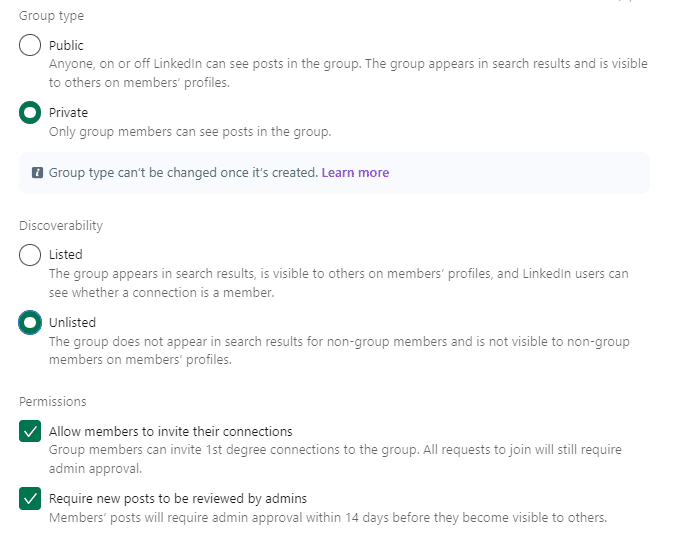
Finally, click on the Create button, and you’re done.
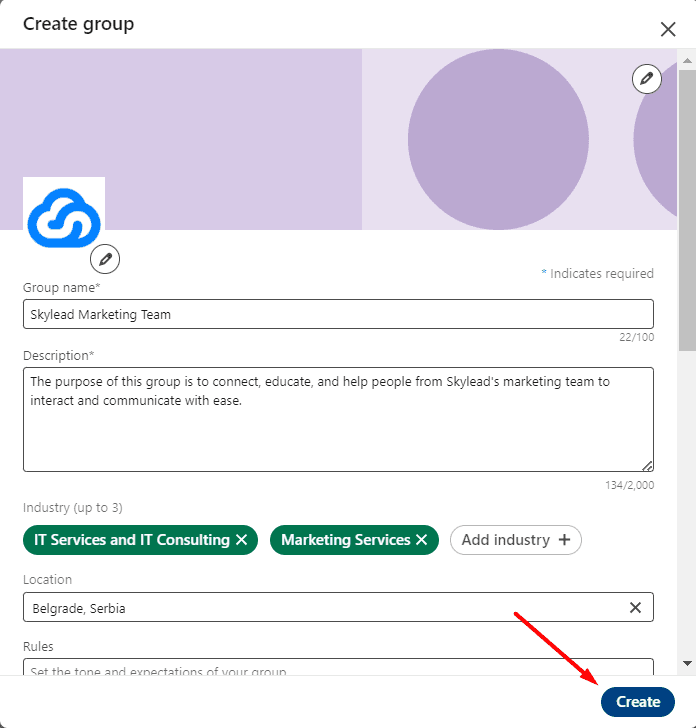
Join LinkedIn Groups
You can find and Join groups in 3 easy steps:
- Write your keyword in the search bar
- Click on the Groups tab
- Scroll down the list of groups for that keyword
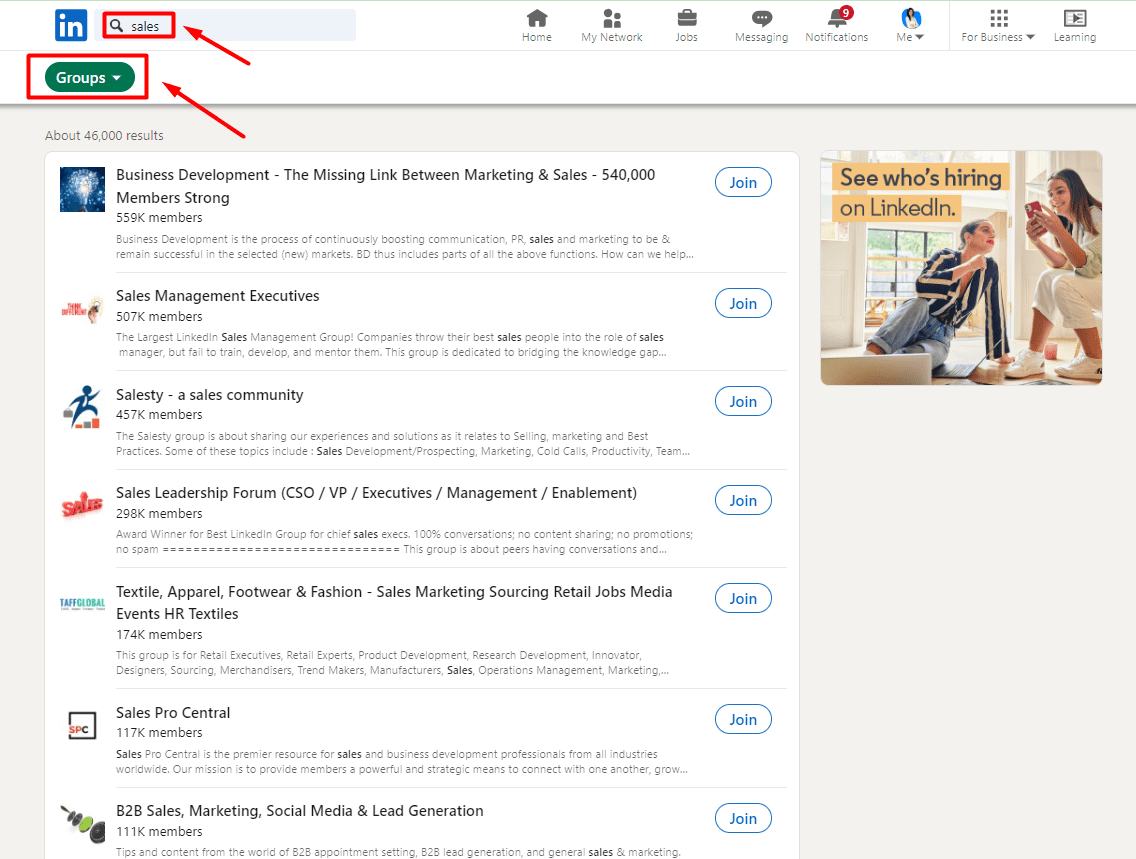
When you find your preferred group, click “Join”. Once you become a member, you can start engaging with the community, find answers, and send invites to connect to group members. Once you do, you can use them for lead generation, but more on that later. 🤓
LinkedIn groups use cases and benefits
LinkedIn’s main purpose is to help its users connect with industry professionals, share experiences and expertise, and stay updated on all industry-related news. With LinkedIn groups, you have three options:
- You can find and join niche groups for any industry (e.g., B2B marketing, growth hacking, sales).
- Discover groups of your target market and reach out to them.
- Create your own LinkedIn group and invite your target audience to join.
All of these options for using LinkedIn groups for growth hold numerous benefits. Here’s some of them 👇
- Business networking - If you’re active on LinkedIn, you’ll surely gain useful connections and exposure, which will help you expand your professional network.
- Lead generation - You can use LinkedIn groups to reach your target audience while simultaneously retaining and gaining new users for your product/service.
- Brand awareness - Brand visibility is important for businesses, and LinkedIn groups can help with further exposure and building loyalty with current and future users. However, since most groups are inactive, using this benefit might be harder than you expect.
- Ad placement—If you're an active member of a niche group or you created your own group, you can use it as an organic content distribution channel and ad placement if the group members are active and group policy allows it.
From our own experience, we can tell you that LinkedIn groups are generally inactive. However, that doesn’t mean we can’t use them in these other cases—for business networking and lead generation. In fact, LinkedIn groups are one of the best places to start when trying to reach your target audience. So, let’s dive into the know-how of LinkedIn groups and lead gen.
How to use LinkedIn groups for lead generation
Finally, the long-awaited part is how to use LinkedIn groups for lead generation. Note that before you even consider lead gen, you should define your Ideal Customer Profile and Buyer Persona profiles for these and other LinkedIn lead generation purposes.
As for LinkedIn groups, if we have potential leads conveniently arranged in groups by interests, industries, and certain topics, it eases the prospecting process. You already have easy targets.
1. Find your LinkedIn group members
Once you have your LinkedIn group list, you need to find its members. The best way to do this is to use LinkedIn’s Sales Navigator filters and Group filters.
First, open your Sales Navigator profile and click on “Lead filters.”

The drop-down menu with filters will appear in the following format, so scroll down and choose “Groups.”
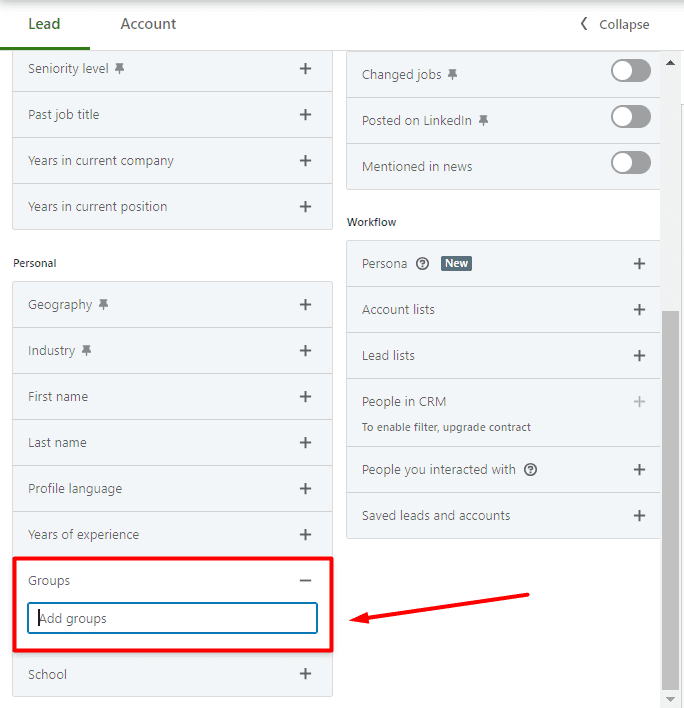
Once you type in a specific group, the dropdown menu will appear, which means you can target multiple groups and all of their members.
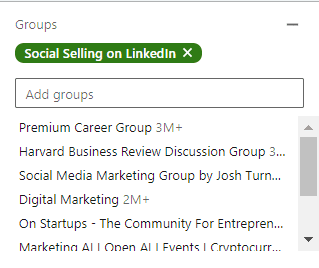
You’ll also see the number of people in this group or groups in the top right corner.
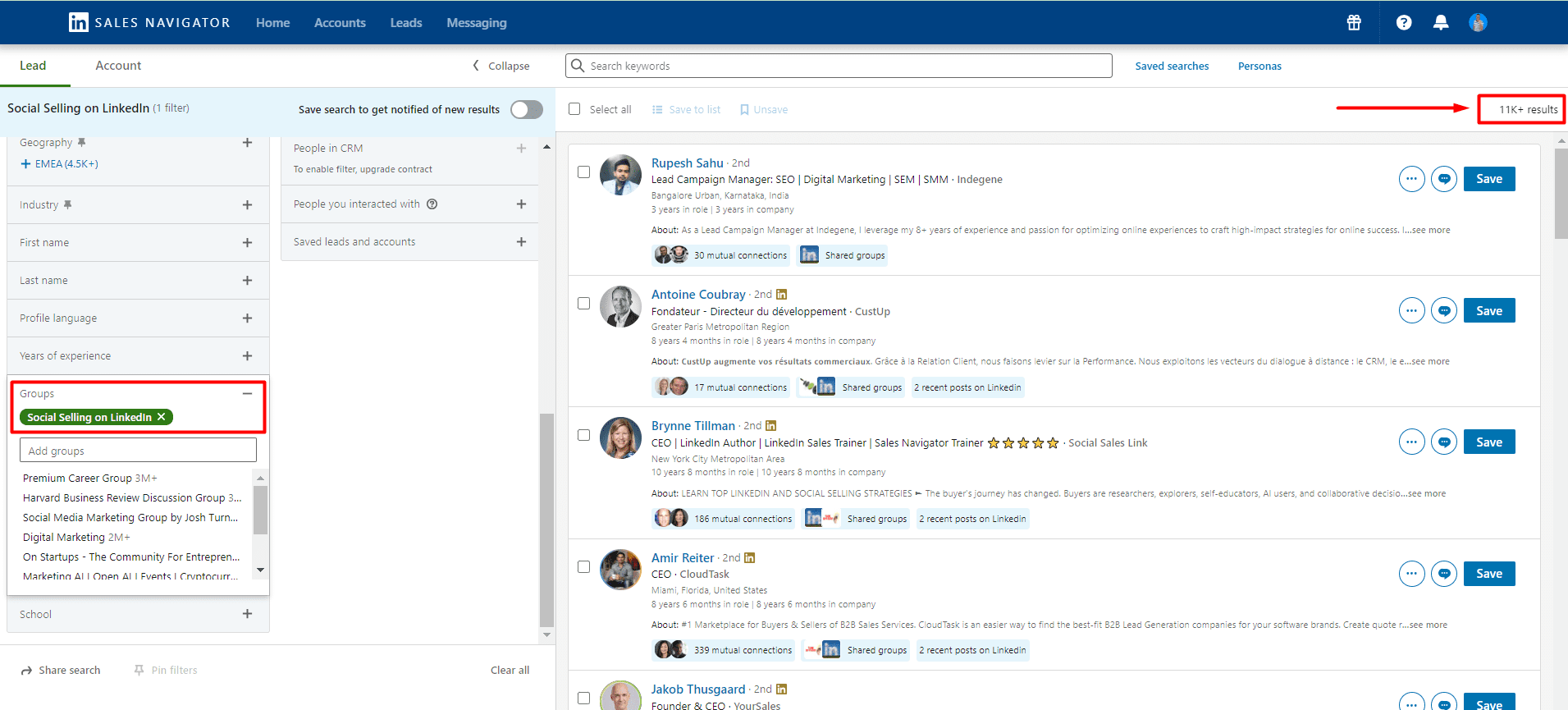
You can target one or multiple groups and use the remaining 23 lead filters to narrow your search further. One more thing to note is that you can even exclude certain parameters. Not all filters support this option, but most do. This is how to do it 👇
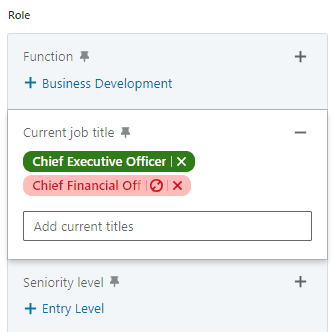
Last but not least, some of these Sales Navigator filters allow you to use the Boolean search. This type of search combines keywords with modifiers such as AND, NOT, and OR to produce more exact results. 👇
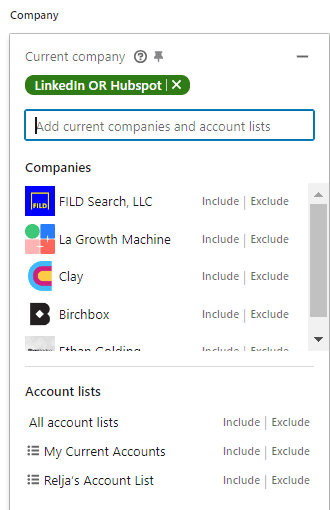
Now that you have your leads filtered, you can reach out to them manually. But we have a better option - why not automate the outreach process instead? Before we get into the know-how, copy the link from the URL bar and then… Keep reading to find out what to do with it. 👓
2. Reach out LinkedIn group members on autopilot
When it comes to the actual outreach process, it's tiring to reach out to your leads manually. However, you can always use Skylead to automate your outreach and reach out to your leads faster and more efficiently. This way you can save 11+ hours of work per week and keep your calendars always full.
First off, log into your Skylead account and click the Create campaign button to begin creating your campaign.
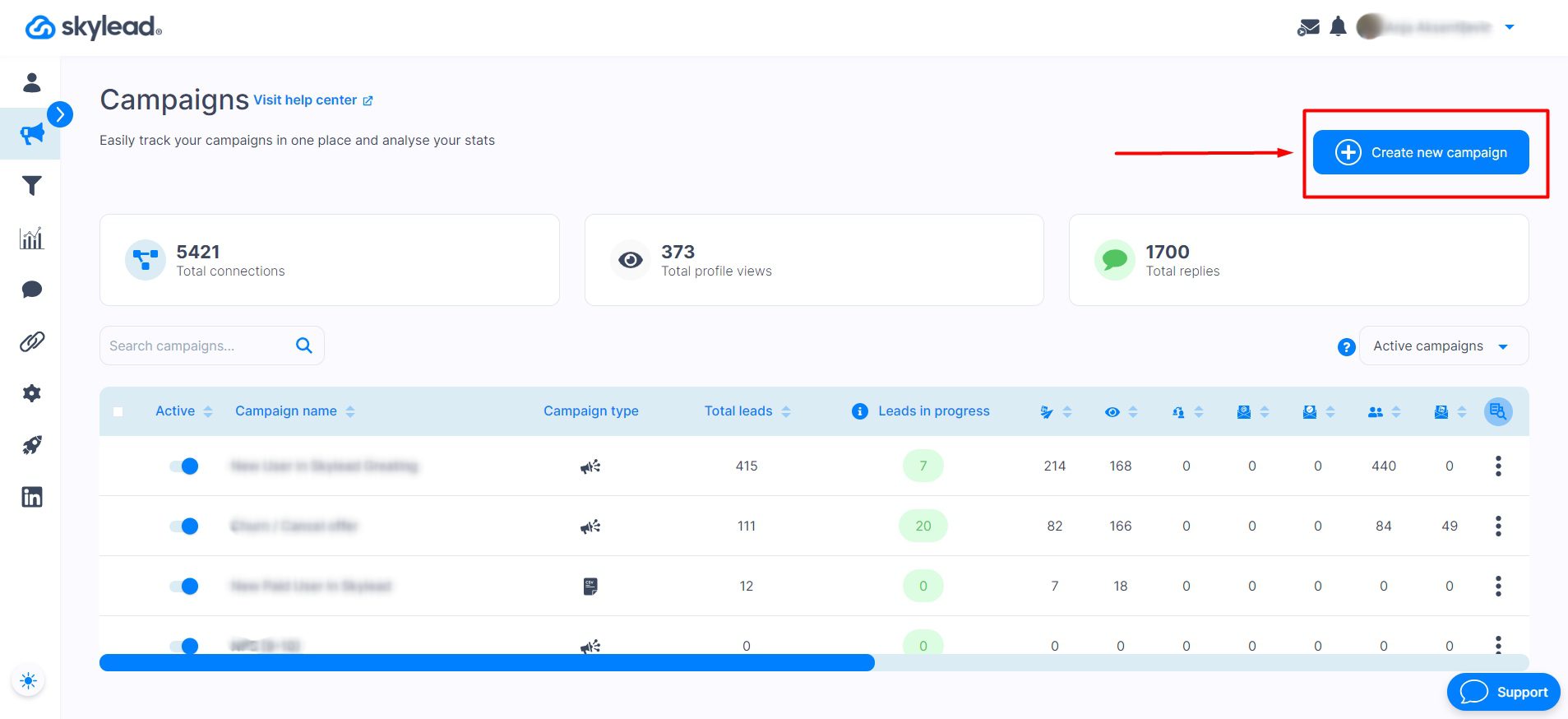
Use the URL you copied earlier and paste it into Skylead’s Campaign Creator. In case you didn’t specify the connection degree (1st, 2nd, or 3rd-degree connections) beforehand, you can do it directly at the Skylead Campaign Creator page.
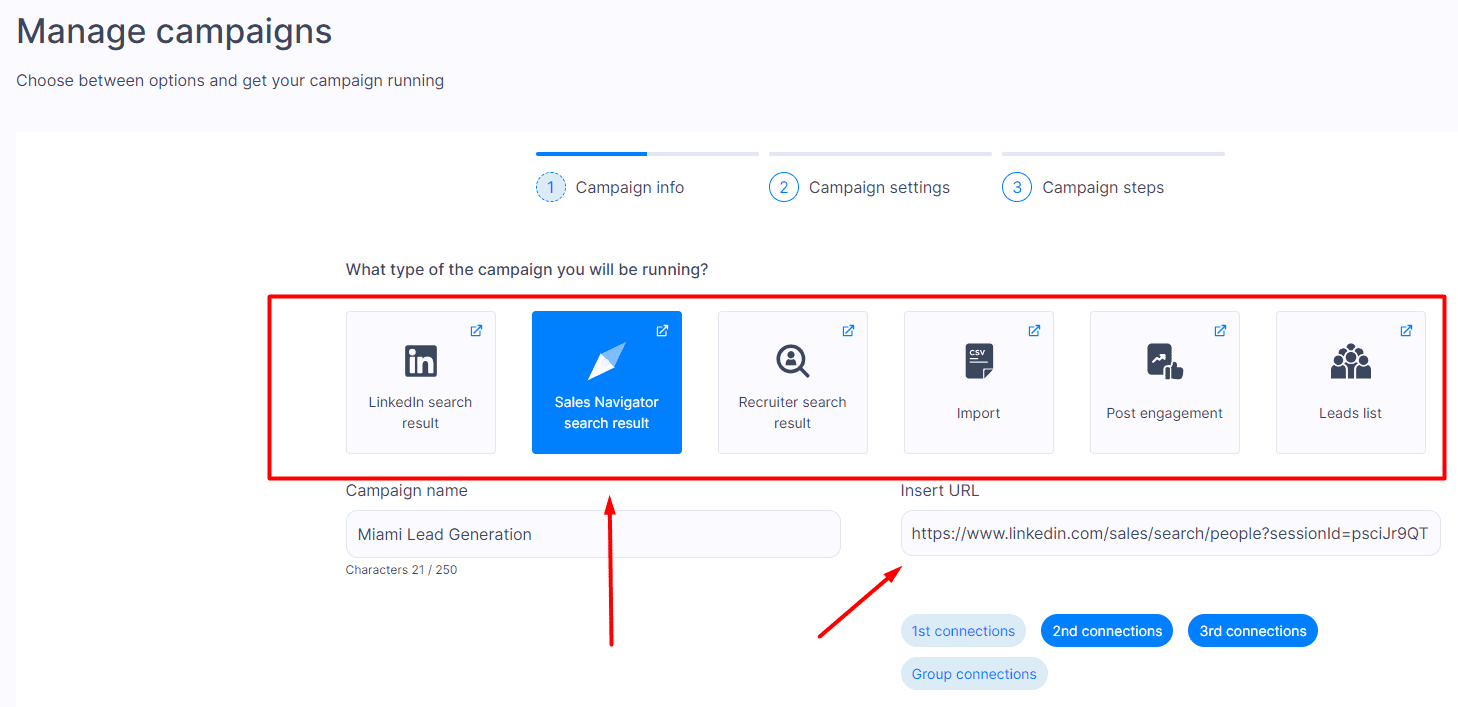
After pasting the URL and checking your degree of connection, click Next and then configure your Campaign settings according to your preferences.

The only thing left after you’re done with step two is to click on Create Sequence and let the outreach magic begin. This is where we introduce our first-to-market power feature - Smart sequences. ✨
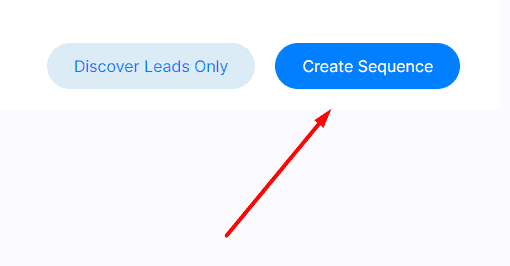
Smart sequences are an algorithm that allows you to combine if/else conditions with different actions listed below. This way, Skylead will follow the outreach flow you create and find the fastest route to your prospect, depending on their reaction to your outreach action. These are the actions and conditions you can use throughout your campaigns:
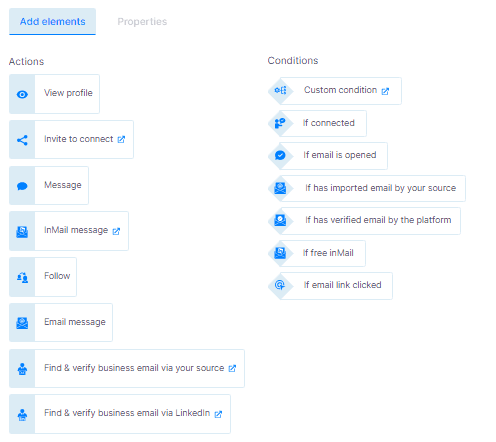
A great thing about Skylead is that it uses a multichannel approach. This means you can contact your prospects via LinkedIn and email thanks to its native email finder and verifier feature.
Here’s an example of a multichannel sequence with the mentioned steps where you can include email finder and verifier steps without breaking the outreach flow:
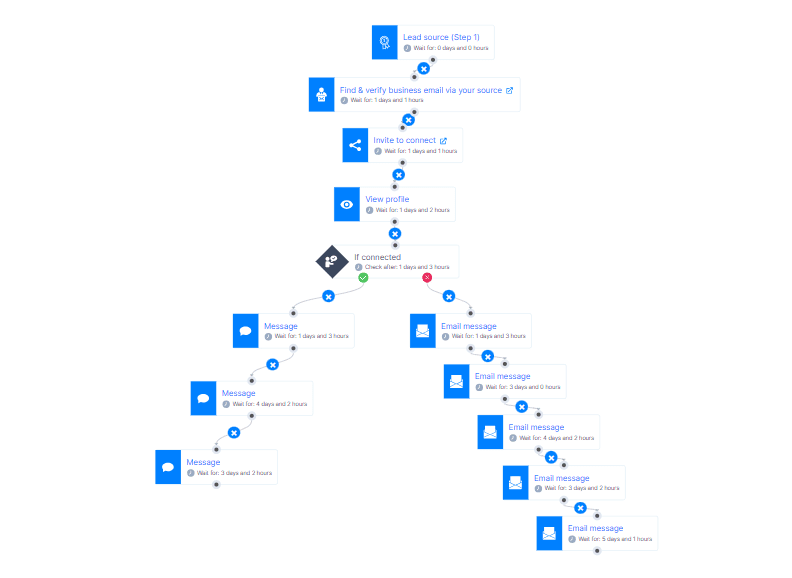
Another thing to note is that you can customize every message thanks to our Image & GIF personalization. You can personalize each message with variables, plus add visual elements to spice up any message.
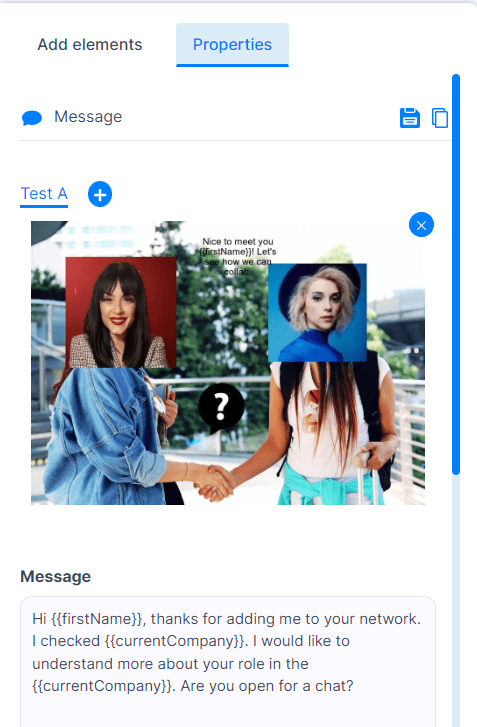
Once you have all your messages and steps ready, hit the Start campaign and you're good to go. The only thing left to do is to keep an eye out for Skylead's Smart inbox for the messages that will start pour in from the campaign, so you can take over the conversation with your leads and nurture them.
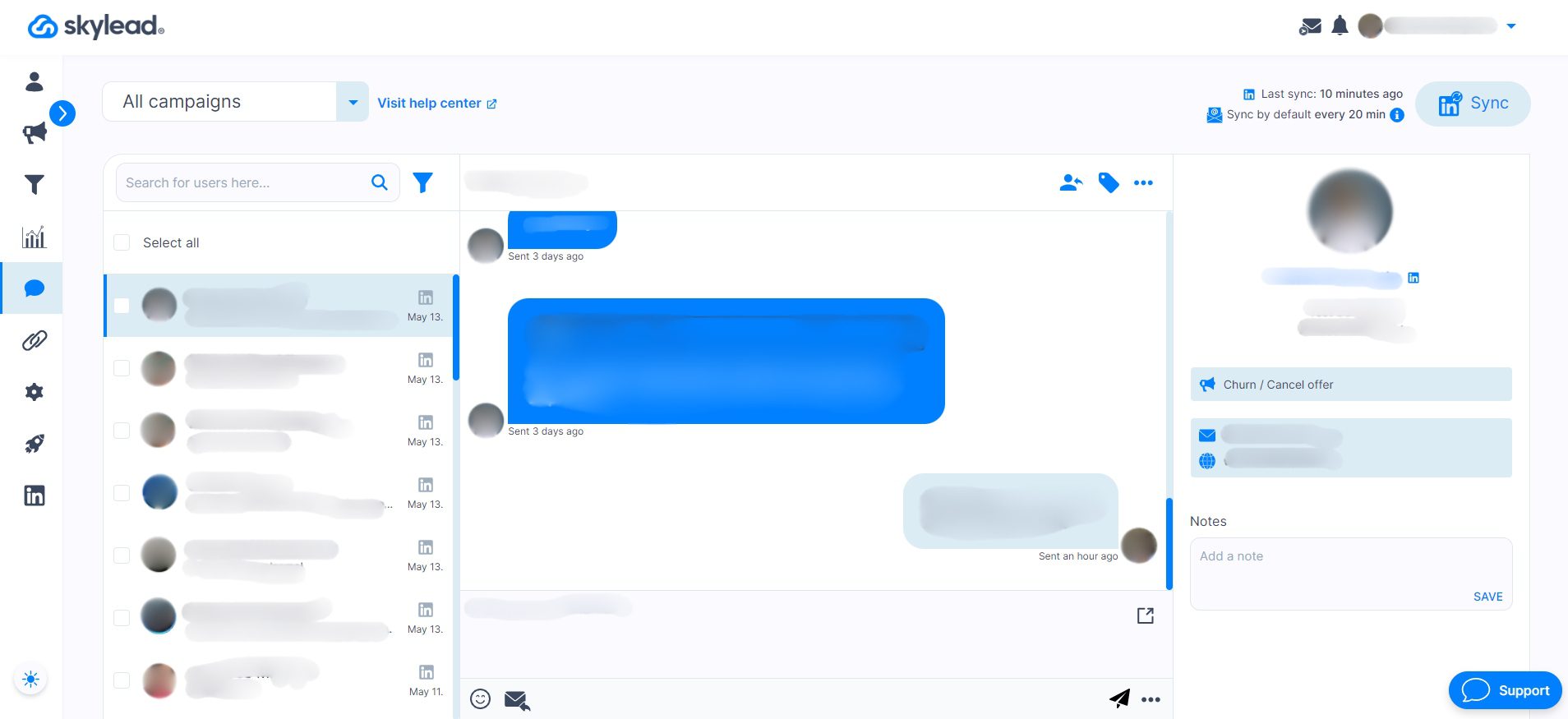
LinkedIn group members' message templates
If you’re having trouble crafting messages for group members, let’s go over examples of messages you can send to the group members you’re targeting. These are great examples, as they demonstrate genuine conversation starters and showcase interest in the lead, which is a best practice for lead generation. 🔎
#1 LinkedIn Connection Request template:
Hi {{firstName}},
Have you maybe found a post in the group that solves {{painPoint}}?
I can see you are working as {{occupation}}, so I was wondering how you handle such a challenge in {{currentCompany}}.
Let’s connect and see what we can learn from each other!
Real-life example:

#2 LinkedIn Connection Request template
Hey {{firstName}},
I noticed you’re also rocking it in the {{occupation}} world! I’m all about swapping stories and insights with fellow professionals. How about we link up and share some of our coolest experiences?
I'm game if you want to connect!
Real-life example:

#3 LinkedIn Connection Request template
Hi {{firstName}},
I'm looking to connect with like-minded professionals who are passionate about {{relevantTopic}}.
I'd love the opportunity to exchange ideas.
Let's connect!
Real-life example:

Target specific group members' sequence template
When you use Skylead, you also get a chance to try out some proven sequences from our outreach templates library. The target specific group members is a sequence made for those who want to see the full glory of using LinkedIn groups for lead generation.
This particular sequence has a 53% acceptance rate, 73% open rate, and 27% reply rate. Here’s what it looks like 👇
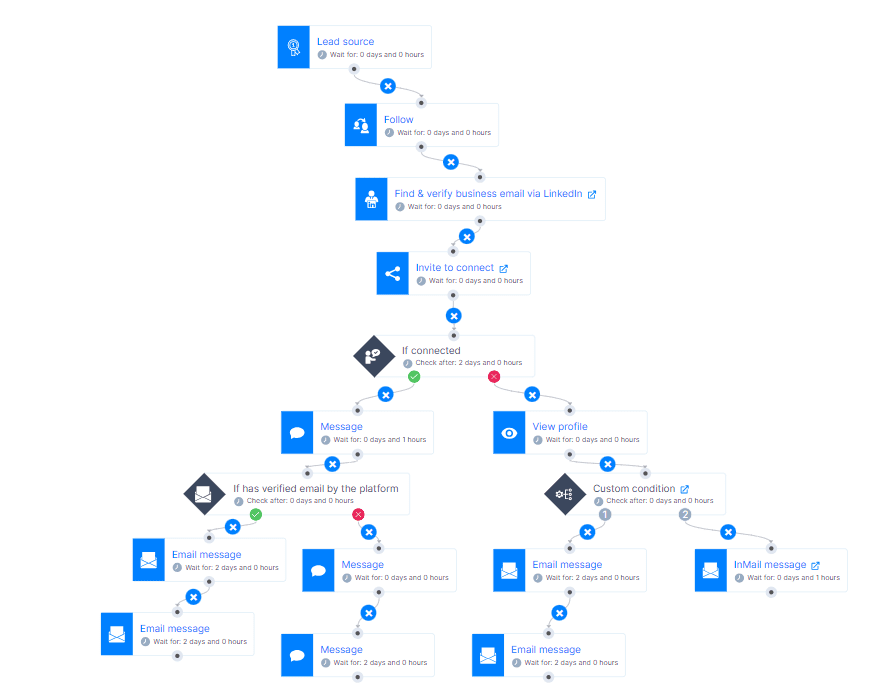
Frequently Asked Questions
What are the common challenges or limitations when using LinkedIn groups for lead generation?
When considering the use of LinkedIn groups for lead generation, several challenges and limitations can arise. One of the primary issues is the low activity level in many LinkedIn groups, which can significantly hinder engagement and networking efforts. To address this, marketers and salespeople need innovative strategies to inject life into these communities. However, it is very time-consuming to outreach each member individually. This is where automation tools like Skylead come in handy to solve the problem.
How can one measure the success of lead generation efforts within LinkedIn groups?
Measuring the success of lead generation efforts within LinkedIn groups involves monitoring several key metrics. The effectiveness of these strategies can be gauged by tracking the growth in group membership, the engagement rate with posted content (likes, comments, shares), and the conversion rate of group members to leads or customers. Additionally, using tools like LinkedIn's analytics for group admins can provide insights into member activity and interaction patterns, helping to refine targeting and content strategies. When it comes to automated lead generation, you can track your outreach effort in your LinkedIn automation tool and cold email software such as Skylead.
Are there any privacy concerns or ethical considerations to keep in mind when targeting group members for lead generation?
Regarding privacy concerns and ethical considerations, targeting group members for lead generation requires a careful approach to comply with LinkedIn's policies. Marketers and salespeople should ensure that their outreach efforts are genuine, respect users' privacy settings, and provide value to the recipients. It's also crucial to avoid spam-like behavior by personalizing communication and ensuring that the content or messages are genuinely beneficial to group members. By adhering to these principles, marketers, and salespeople can effectively use LinkedIn groups for lead generation while maintaining ethical standards and respecting privacy.
Ready to reach out to LinkedIn group members?
Now that you know how to create, join, and use LinkedIn groups for lead generation, it’s time to put that knowledge to work and create your very first campaign in Skylead and automate your outreach!
You can register for free, start your 7-day free trial, and use those LinkedIn groups to your benefit and outreach your target audience away! 💥
Are you thinking of launching your first automated outreach campaign to reach out to your leads, book meetings, distribute content, or find new clients, ideal candidates, and backlinking partners?
We’ve got your back!
In this blog, we’ll take you through the entire campaign creation process using our powerful LinkedIn automation tool and cold email software - Skylead - as an example.
We’ll even throw in some tips and tricks on achieving outreach success and cover use cases and outreach messages for every profession.
Let’s dive into it.
What is an outreach campaign?
An outreach campaign is an automated campaign that uses tools to streamline all outreach activities, thus allowing individuals to connect with their target audience faster. People may initiate these for email and/or LinkedIn lead generation purposes. However, they also use outreach campaigns to find new clients, nurture relationships with existing clients/customers, increase brand visibility, or promote content.
In the past, outreach campaigns revolved around individuals contacting other individuals manually, typically over the phone. Fast forward to now, we have outreach tools like Skylead to handle the reaching out part — over multiple channels, nonetheless!
The benefits of setting up an outreach campaign
Outreach automation has revolutionized the workflow of countless people! Here’s why!
Firstly, there’s the time-saving aspect. Automated outreach campaigns can be real game-changers, saving you as much as 11+ hours per week on manual work. That’s an extra 6 days each month to focus on other tasks!
What’s more, with outreach campaigns running on autopilot, you can reach a larger audience in a shorter period. This allows you to allocate resources more effectively and, thus, improve overall productivity. You can even reach people you thought were unreachable before, as email enrichment features like Skylead’s email discovery & verification can be included in the campaign flow.
Yes, as your business grows, so will your outreach. But that’s not a reason to worry! You can automate multiple campaigns at the same time and scale without compromising quality.
Finally, automated campaigns ensure no lead falls through the cracks. The system keeps things moving, whether through personalized emails, follow-ups, LinkedIn messages, or inMails.
Outreach campaign use cases
Salespeople
Sales professionals are often seen juggling multiple leads at a time. With so many leads to manage, little time is left for other tasks, plus the risk of missing important messages increases. Outreach campaigns streamline the process and ensure consistent communication across multiple channels.
Sales reps can continuously create campaigns with thousands of leads to keep their calendars consistently full. These campaigns also allow them to automate various outreach tasks, leaving them only to respond to messages and book calls.
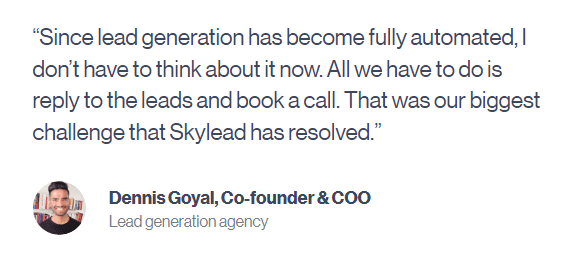
Why does this matter, though?
Because automating outreach tasks such as sending LinkedIn connection requests, inMails, messages, and emails helps sales professionals save +11 hours a week—hours they can now focus on lead nurturing.
Lastly, outreach campaigns permit salespeople to A/B test their messages. This allows them to see what works and what doesn’t, which in turn helps them optimize their campaigns for better results.
Marketers
When it comes to marketers, they can use outreach campaigns to:
- Generate leads for their sales teams;
- Find backlinking partners faster;
- Distribute content and reach wider audiences;
- Increase conversion — Marketers can leverage Skylead’s email discovery and verification feature to find their leads' email addresses. Once the tool finds and verifies emails, they can use them to create a lookalike audience on LinkedIn, Google Ads, and/or Facebook, which will result in better targeting and increased conversions;
- Expand their network and become thought leaders.
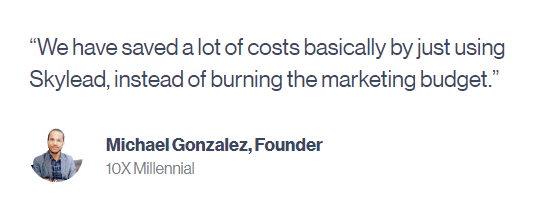
Recruiters
Manual cold outreach can be time-consuming for recruiters who are constantly scouting for the best talent. Thankfully, automation simplifies candidate engagement.
That said, recruiters can set up automated sequences to:
- Generate a large pool of candidates and pick the best from the crowd;
- Speed up the hiring process;
- Target individuals attending specific job fairs;
- Personalize the outreach to keep candidates’ interest high.
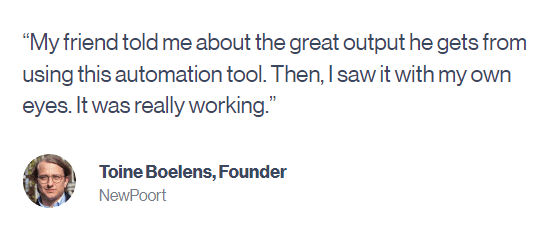
Company founders and agency owners
Company founders and agency owners typically have a full plate of managing daily operations, strategizing business development, ensuring financial health, and more. Automated outreach campaigns lighten the load and accelerate revenue growth.
If you are a company founder and have a B2B product or service to sell, outreach campaigns can help you reach out to a wider pool of leads and find clients faster on autopilot.
Meanwhile, if you are offering lead generation services as an agency, you can often white-label the tool used for campaign creation and thus help yourself to another stream of income. Moreover, outreach campaigns can also help you generate new leads for yourself and your clients!
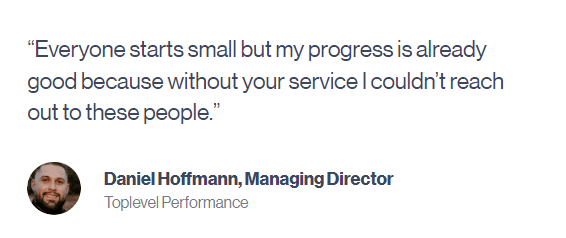
How to conduct an outreach campaign: Step-by-step guide
Now that we’ve covered the basics, it’s time to launch your first campaign! We’ll use our own tool, Skylead, to show you how you can use outreach tools to create one.
When you don’t know where to start…choose LinkedIn.
Jokes aside, in this blog, we will make a LinkedIn search-based campaign to ease you into the entire outreach campaign creation process.
However, you should know that, when it comes to Skylead, options are far more extensive. Aside from LinkedIn search, you can target leads from a:
- Sales Navigator search
- Sales Navigator lead list
- Recruiter search, Talent pool, and Pipeline URL
- LinkedIn post
- LinkedIn event
You can also import them through:
- API,
- And a CSV file.
That said, here’s how to start creating your outreach campaign.
#1 Target your audience
Start by typing a keyword in the search area.
We went by a job title.

After you click "People", choose the LinkedIn connection type you want your outreach campaign to target.

1st-degree connections are members with whom you are already connected on LinkedIn. Choose this connection type if you want to run a LinkedIn message campaign.
Meanwhile, 2nd-degree connections are leads you aren’t connected to but with whom you have mutual connections. You can’t send them a message right away. Instead, you need to connect with them first or reach out to them via LinkedIn inMail or email.
As for 3rd-degree connections, you aren’t connected to them either, but you also don’t have any mutual connections. Similarly to 2nd-degree connections, you can also reach them via email and/or inMail (free or paid).
Back to pinpointing your audience, you can also apply other filters to narrow down your search further (see the ‘’All Filters’’ option on the right).

Your search can result in thousands of leads, but LinkedIn limits the results to 100 pages, with 10 leads per page. So, if you create a LinkedIn search-based campaign, you can reach a maximum of 1000 people. However, if you're using Sales Navigator, the limit increases to 2,500 leads per campaign. Therefore, it is recommended that you narrow the list down as much as possible.
This is where defining your Ideal Customer Profile (ICP) and buyer persona comes in handy.
Your ICP is the type of company that would benefit most from your product/service, and your buyer persona is a fictional representation of your ideal customer within that company, as informed by market research and actual customer data.
That said, define your ICP and buyer persona first and use the corresponding LinkedIn filters to find them. That's how you'll target the best leads!
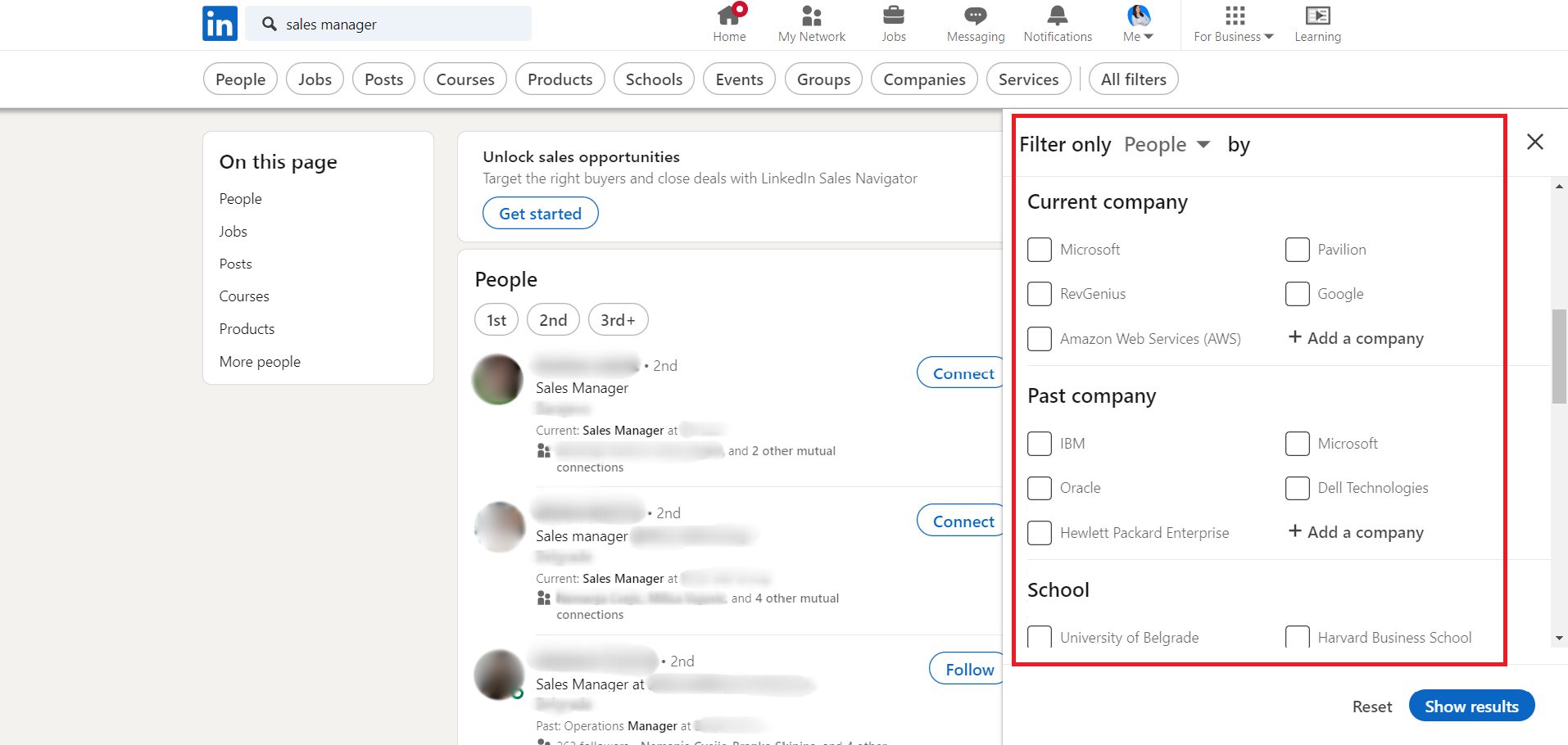
#2 Import your leads
You’ve completed LinkedIn prospecting and carefully chosen your audience. What now?
You proceed to build an outreach campaign!
To do so, firstly, go to your Skylead dashboard and locate the Campaigns page.
Once there, click ‘’Create new campaign’’.
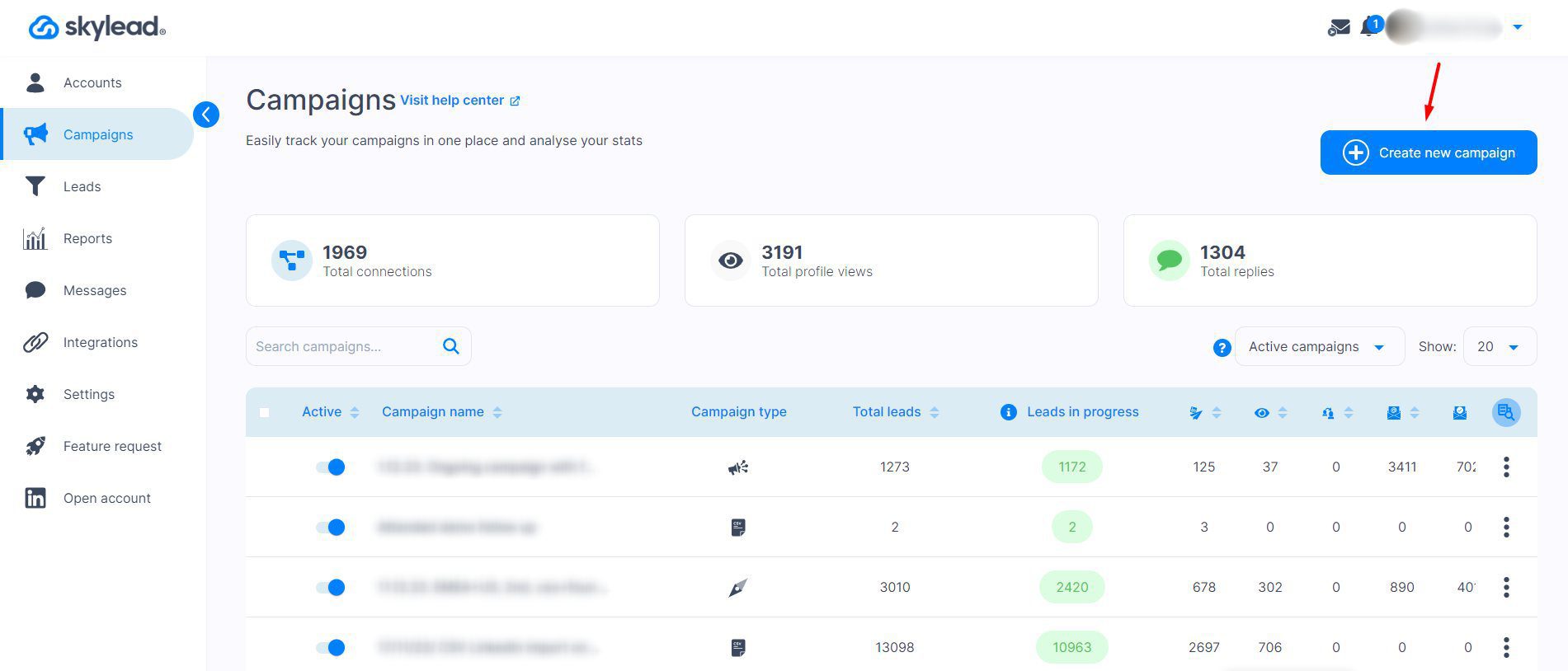
Now, go back to LinkedIn and copy the search result URL.

Return to Skylead, insert your campaign name, and paste the link you just copied.
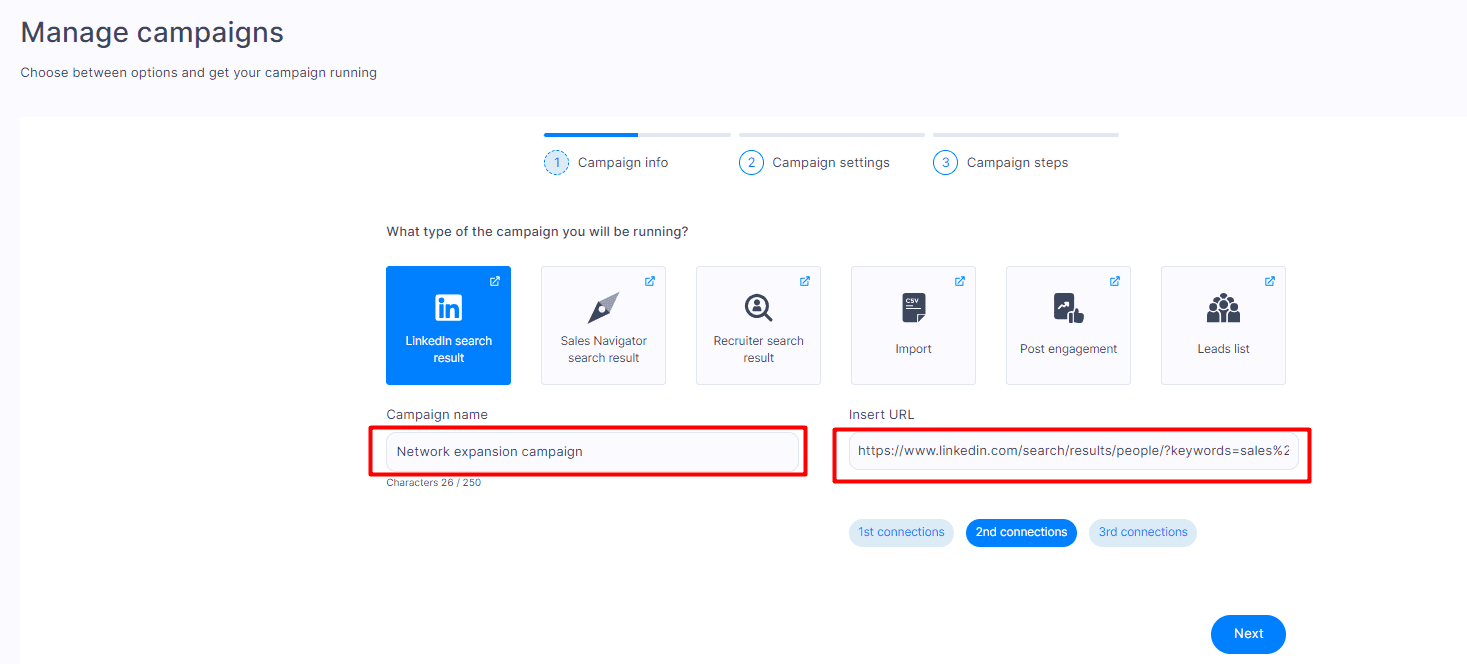
Under the URL, you’ll see a connection-type button. If you’ve selected the connection type on LinkedIn, Skylead will automatically recognize it. If not, you can select it now.
Click ‘’Next’’.
#3 Define outreach campaign settings
Now comes the time to define the settings for your outreach campaign.
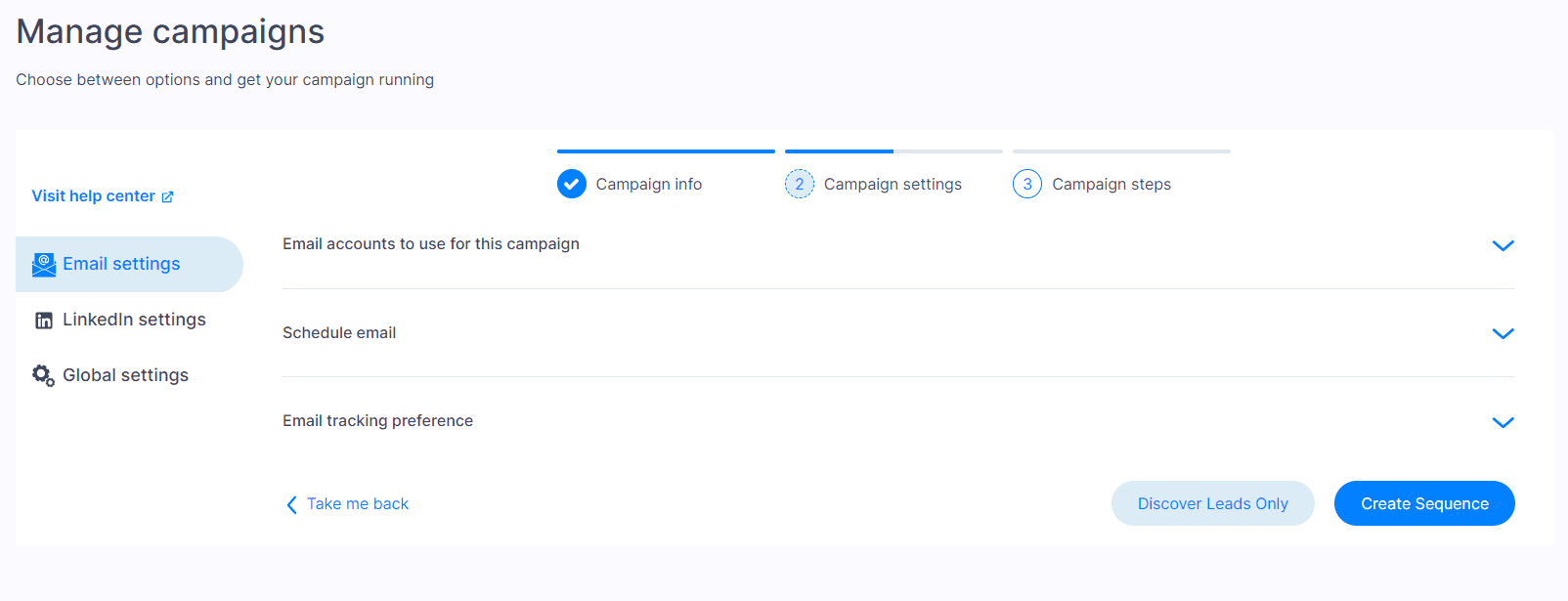
On the left side, you’ll see 3 different types of settings:
- Email settings
- LinkedIn settings
- Global settings
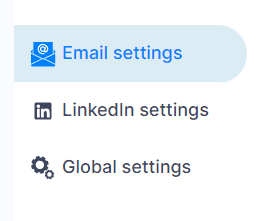
Email settings
If you plan to use email outreach for your campaign, firstly, click the ‘’email settings’’ button.
This is where you’ll notice 3 drop-down menus.

Expand the first menu to select the email account(s) to use in your campaign.
Skylead lets you add an unlimited number of email accounts at no extra cost.
Once added, the software will auto-rotate them so you can send tens of thousands of emails per month. This way, you can bypass the email limit while protecting your domain.
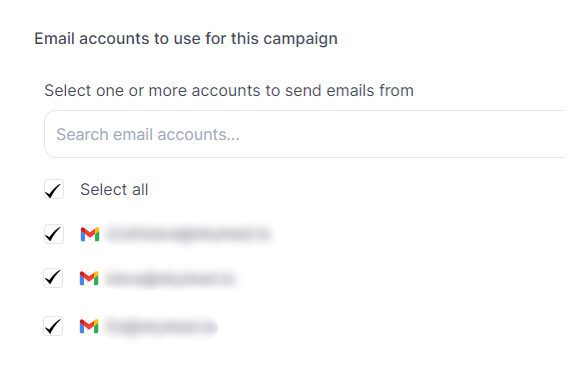
The second menu gives you the option to choose a schedule that Skylead will follow for your email outreach.
Here, you can select your default schedule or create a new one. You can also manage your team’s schedule (unless you are a one-person team).

Lastly, it’s time to set up your email tracking preferences.

With these options on, you can:
- Track the number of email link clicks
- Track the number of opened emails
- Authorize Skylead to send text-only emails (no HTML) with no visuals. However, if you turn this option on, you won’t be able to track opened emails and email link clicks.
LinkedIn settings
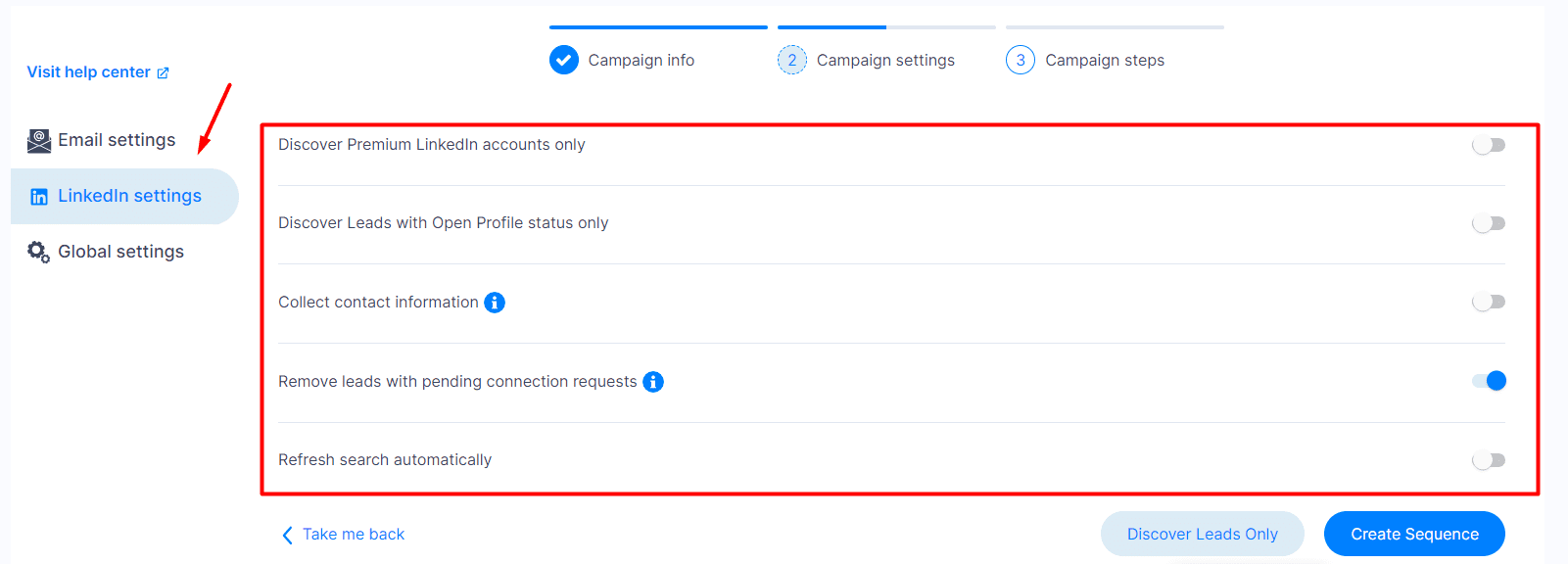
In terms of specific options, you can customize the LinkedIn part of your outreach with:
- Discover Premium LinkedIn accounts only — Turning this one on singles out leads that have a LinkedIn Premium account;
- Discover Leads with Open Profile status only — Select this, and the tool will exclude leads whose profile is set to ‘’Private’’ (aka leads who can only receive paid inMails).
- Collect contact information — With this option on, Skylead will collect all publicly available information from the lead’s LinkedIn profile. This option implies a “View profile” step. You don’t need to add it to your outreach campaign, though; it will be executed in the background.
- Remove leads with pending connection requests to exclude unresponsive leads.
- Refresh search automatically — Turn it on, and Skylead will periodically refresh your search results URL for new leads. Moreover, if they emerge, it will automatically add them to your campaign.
Global settings

Under global settings, you can define targeting options and schedule the start of your outreach campaign.

As for targeting options, you can choose to (or not):
- Include leads that replied to your messages—applies to leads you had a conversation with via LinkedIn messages, inMails, or emails.
- Include leads found in other campaigns from your and your team's seats—this is not applicable to your first campaign, so feel free to keep it turned off. However, if anyone on your team has run outreach campaigns in Skylead in the past, we suggest turning this option off.
- Discover new leads only—If turned off, this option can also include leads from other campaigns under your seat. As such, it’s not applicable to your first campaign. However, if this is your second campaign, keep it turned on to ensure you don’t have any duplicates.
Once you’ve determined the leads to target, select the date and time when your campaign will kick off.

💡 Pro tip: Make sure your campaign starts running (and keeps on running) during your leads’ working hours.
If you’re only interested in finding leads and their contact information for future outreach, click on the ‘’Discover Leads Only’’ button. Then, you can find them on your Leads page.
However, if you wish to reach them out on autopilot, continue to the ‘’Create sequence’’ button.
#4 Build a Smart sequence
Multichannel outreach is currently the most effective way of generating leads, and Smart sequences represent a groundbreaking realization of that path!
It’s precisely these Smart sequences that make our outreach campaign flow. We are talking about an algorithm that lets you combine different actions and if/else conditions that unfold depending on the prospect’s behavior. But what for? To make sure you get to each of them as quickly and efficiently as possible.
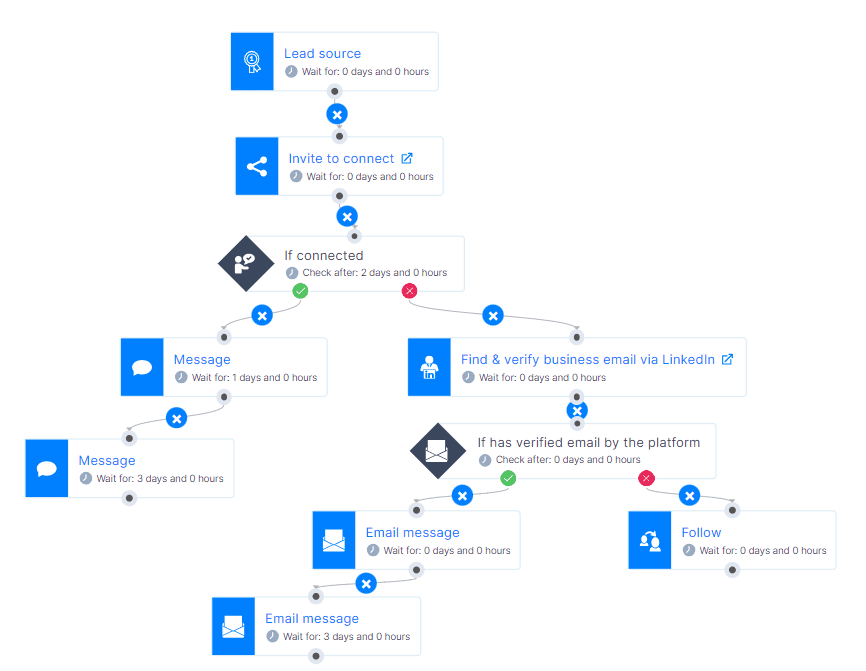
Now, let’s create one, shall we?
After clicking the ‘’Create sequence’’ button, a pop-up will appear that prompts you to decide between using a sequence template or building a sequence from scratch.
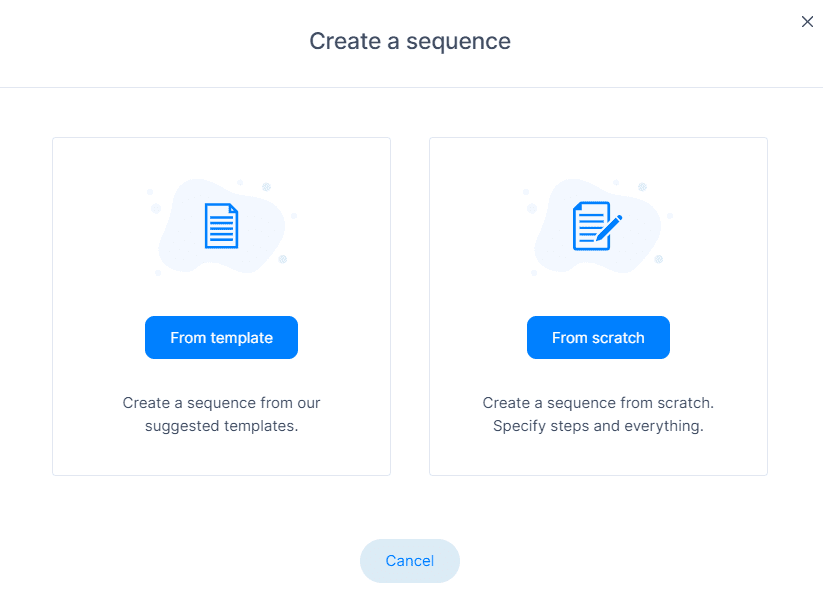
You are welcome to browse through proven smart sequence templates that our team of experts made (and tested) for you. These are templates with real data that you can use immediately.
But for the sake of this blog, we’ll show you how to create one yourself.
So, choose the ‘’From scratch’’ option.
Smart sequence builder
Upon entering the Smart sequence builder, this is what your dashboard will look like.
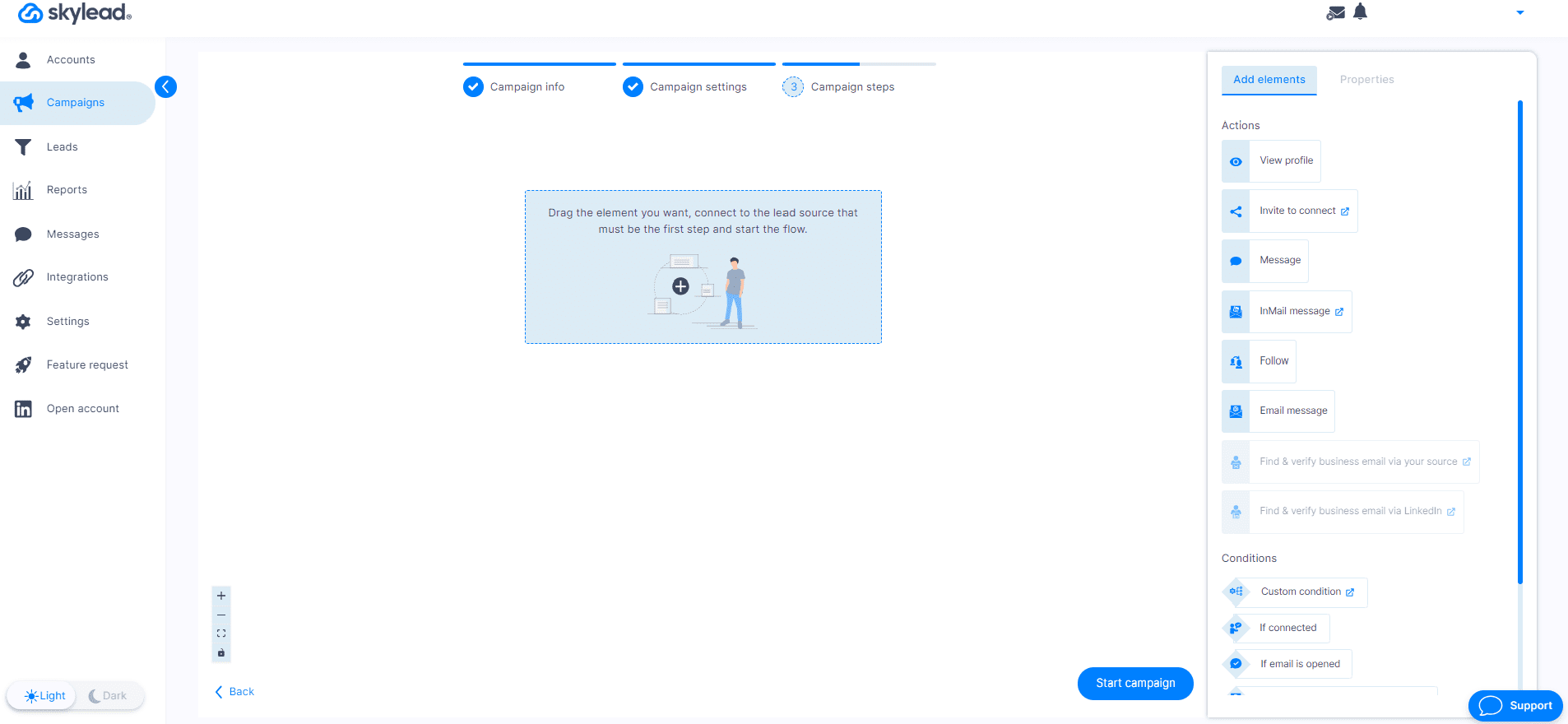
As you may see, there are actions and conditions on your right.
Drag them one by one to the workspace dashboard and connect them in a coherent way to create your outreach flow! Don’t forget to set delays between the actions because they ensure human-like behavior and enhance your account security.
Certain actions let you insert the message (Invite to Connect, Message, inMail, Email) and personalize it further using all the variables you need (preset and custom ones). You can also A/B test up to 5 different variants of your copy to determine which one resonates best with your leads.
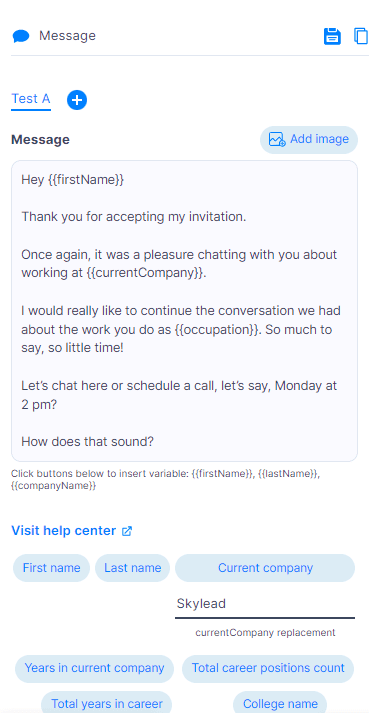
If you wish to further personalize inMails, emails, and LinkedIn messages, you can do so with Skylead’s native Image and GIF hyper-personalization feature.
To access it, click the ‘’Add image’’ button above the message editor.
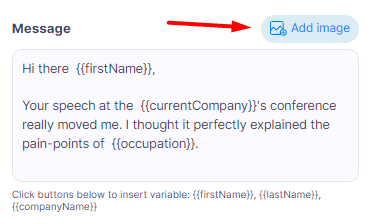
Then, you’ll be taken to a library of templates. Hit the ''Create new template''.

Next, upload the image you wish to edit.
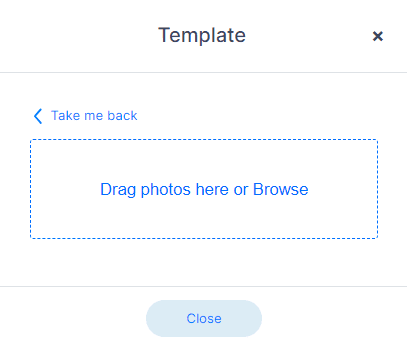
After choosing an image, click ‘’Submit’’.
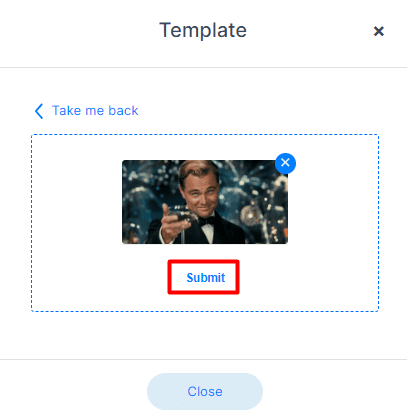
Then, a new window will open where you’ll have the option to add:
- Your profile picture (extracted from LinkedIn)
- Your lead’s profile picture
- A custom logo
- Your lead’s logo
- Text
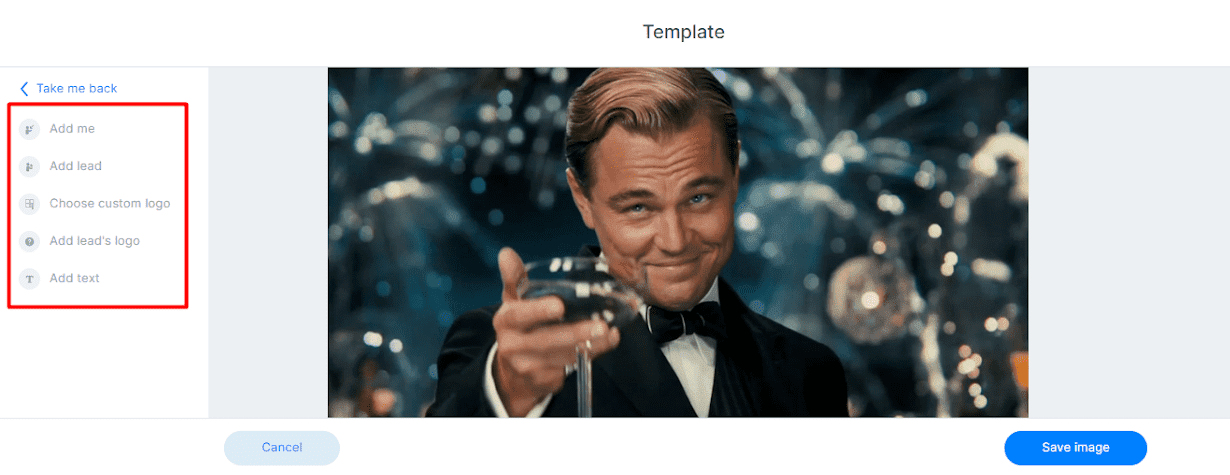
…and here’s what the final result can look like.

Of course, feel free to play around with the image editor as you see fit and create something that will keep those replies coming!
Once you are happy with the steps, your copy, and delays, you can save your sequence as a template to reuse at a later date.
Finally, click ‘’Start campaign,’’ and that’s it! Your outreach campaign has been successfully launched!

#5 Analyze and optimize your outreach campaign
The work doesn’t stop the moment you hit the ‘’Start campaign’’ button. In fact, after putting your outreach campaign in motion, it’s time to sit back and observe the results.
Luckily, Skylead has a nifty Reports page that lets you track performance in three different view modes:
- Graph
- Tabular
- Step-by-step
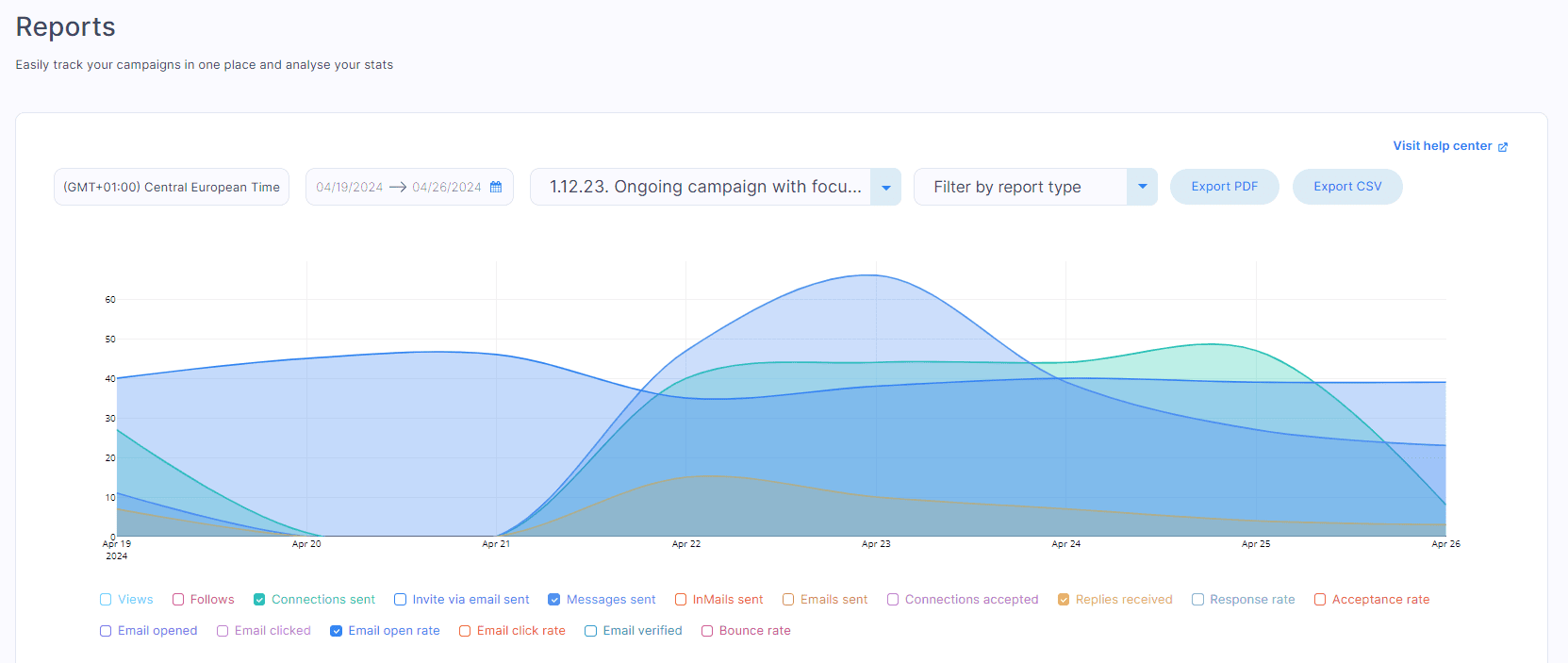

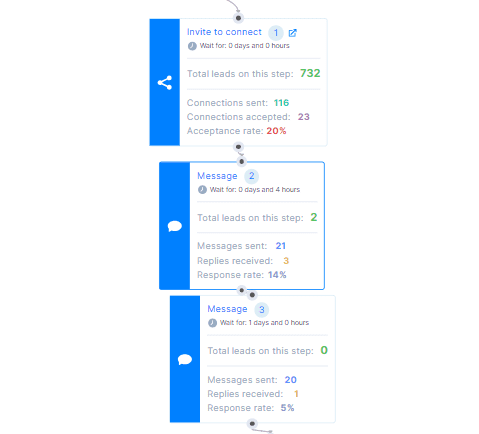
Here, you can monitor different metrics, such as your connection request acceptance rate, email open and click rates, response rate, and more.
The graph and table view differ from step-by-step campaign analysis in that they show daily fluctuations in metrics. As a result, they make it easy to spot patterns and trends. Once you’ve got a handle on these, you can fine-tune your ongoing campaign and make informed choices for the ones down the line.
On the flip side, a step-by-step breakdown really comes in handy when running A/B tests. The results produced by different variants are displayed side by side, making it simple to determine what messages work and should be used in your next campaign vs. those you should discard.
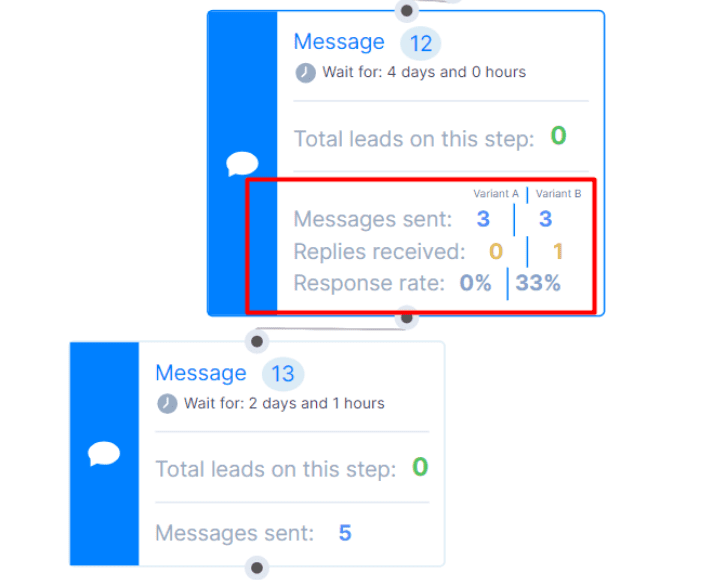
#6 Talk with your leads
Skylead automates the initial outreach. But remember, the goal is to spark conversations that you will take over. Once a lead responds, the sequence stops for them, and it’s your cue to jump in and build that relationship.
Luckily, Skylead makes it easy for you to manage these conversations! The software comes with a Smart inbox that consolidates all messages received via LinkedIn, Sales Navigator, Recruiter, and emails into one place.
Moreover, to keep things organized, you can label your chats based on their status or any criteria that suit your workflow. This can help you prioritize your responses and measure your conversion rates.
Additionally, Skylead allows you to leave notes on your chats. These can be reminders to follow up, points to mention in the next interaction...or any other information that can help you personalize and enhance the conversation.
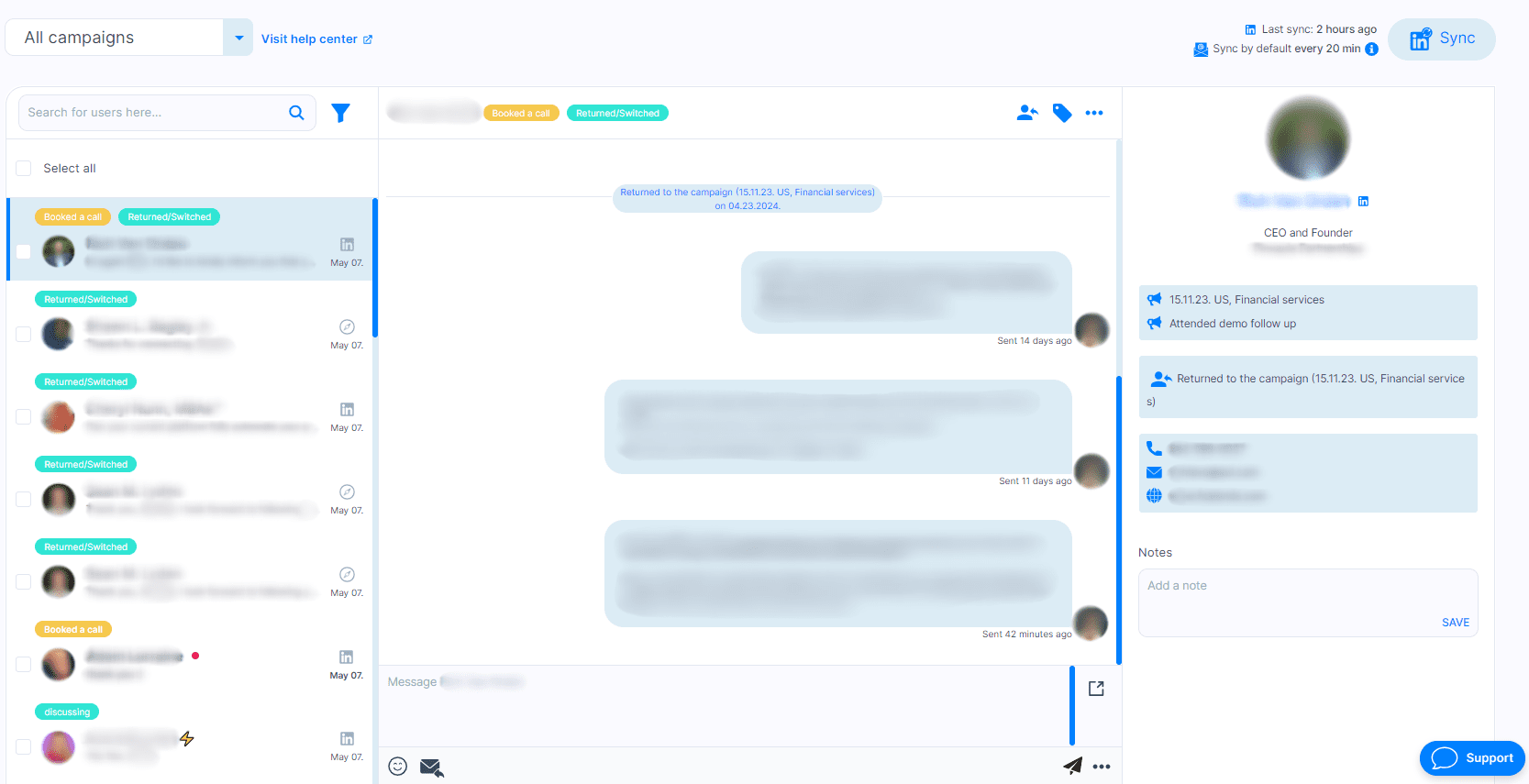
Tips for a successful outreach campaign
Now you know how to set up your outreach campaign and what to look out for. However, you have yet to learn how to make the most of your outreach.
Personalize your messages
People are more likely to respond to personalized outreach messages that feel relevant to them. So, take the time to customize your messages based on the information you have about your leads.
With Skylead, you can reach a whole new level of personalization in cold outreach. Use pre-defined variables, add custom ones if using a CSV file as a lead source, and don’t forget to take advantage of our image & GIF hyper-personalization feature. They can increase your response rate up to 63%!
Feeling uninspired? Head over to our blog to explore personalized image and GIF templates that improve response rate!
Follow up in due time
Don’t be discouraged if you don’t get a response right away. Sometimes, all it takes is a well-timed follow-up message. However, be mindful of the frequency of your follow-ups to avoid coming off as spammy. The golden rule is to wait between 2 and 5 days from the initial message. And if you aren’t sure how to write a follow up email after no response, we have a handy guide to help you out!
Outreach campaign examples and templates for each role
Remember how Skylead came with the premade templates for you to use? Here, we’re sharing some of the best-performing sequence and message templates applicable to each role and different situations.
Sequence for sales professionals
If you want to target someone in an alternative way, why not use a viral LinkedIn post that your target audience has commented on?
In that case, you can use this template to reach out to leads who have engaged with it.
We tested it out, and our results were:
- 76% acceptance rate
- 35% reply rate
- 85% open rate
Furthermore, you’ll find every step comes with a corresponding message that you can tweak as you like.
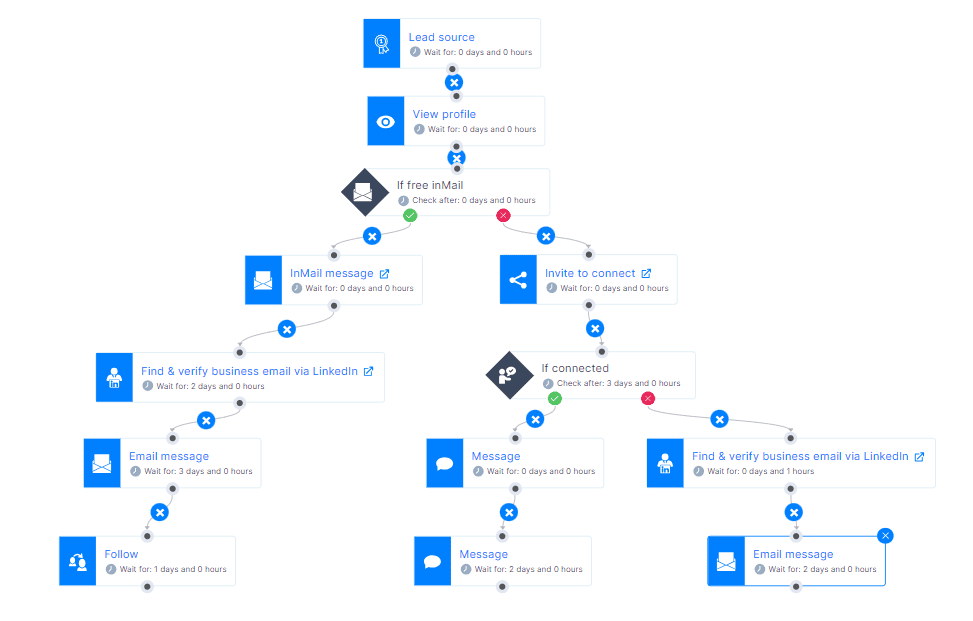
Outreach campaign template for marketers
Feel like targeting your website visitors? You might like this sequence template, which aims to do precisely that! However, feel free to use the message templates that come with it, as well!
For this one, we had a whopping:
- 43% acceptance rate
- 23% reply rate
- 71% open rate
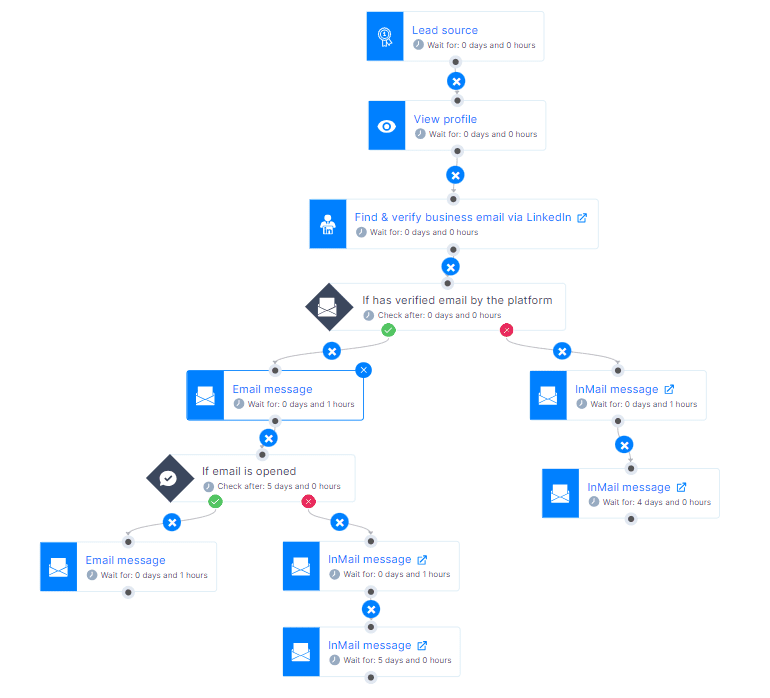
Template for company founders and agency owners
Check out this template specifically designed for reaching out to B2B founders.
We’ve run the numbers and found that, with it, our acceptance rate was 44%, reply rate 29%, and open rate 82%!
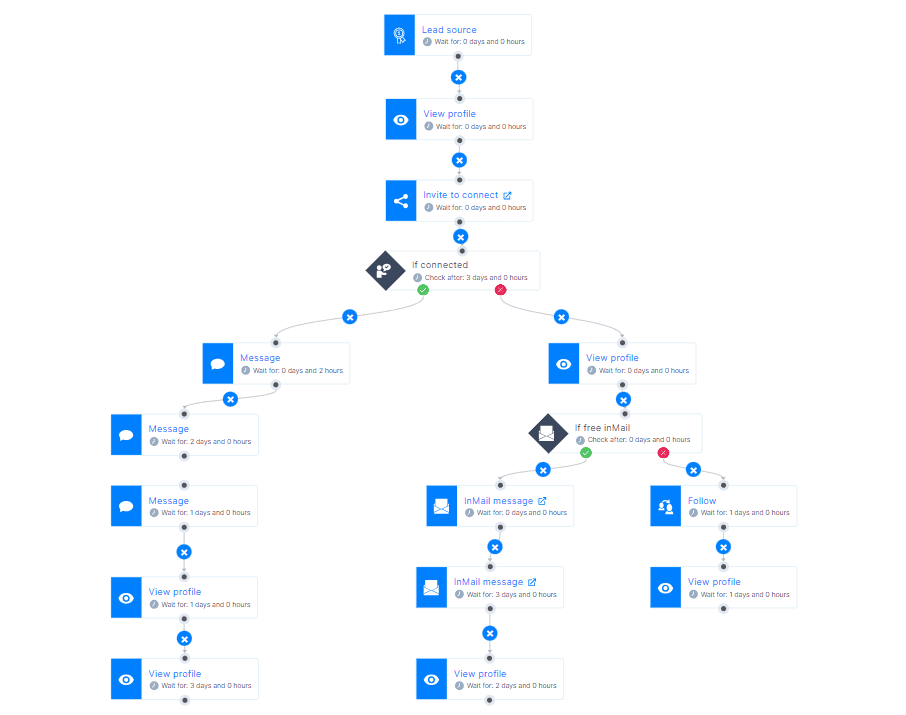
LinkedIn outreach template for recruiters
For example, let’s say you wish to reach out to your perfect candidate for the job in your company. In that case, your LinkedIn connection request can sound like this:
Hey {{firstName}},
My name is {{yourName}}, and we’re currently seeking a {{Occupation}}, and I truly believe that this role offers you a platform to leverage your skills and make a significant impact at our company.
I’d be happy to share more details about the role and benefits we offer.
Choose to use it, and you might see results similar to ours, which were:
- Acceptance rate 79%
- Reply rate 46%
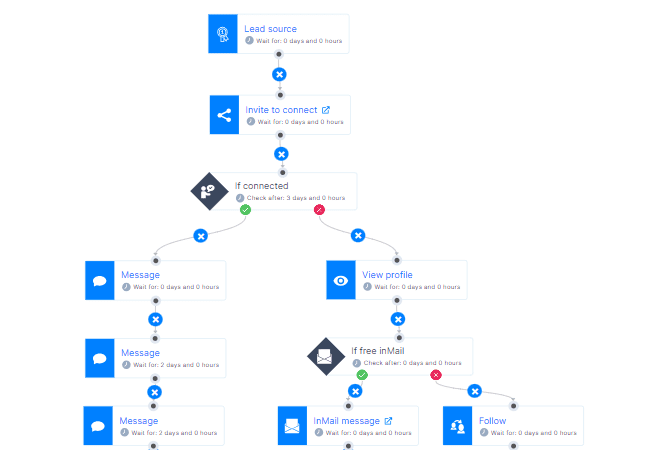
Frequently asked questions (FAQs)
1. What metrics or KPIs are most important to track the success of an outreach campaign?
Key metrics to focus on include response rate, conversion rate, and ROI. These indicators help gauge engagement, effectiveness in converting prospects, and the overall financial efficiency of the campaign.
2. How do you conduct an outreach campaign?
To conduct an outreach campaign, define your target audience and choose the appropriate channels. Create a structured plan, personalize messages, and use automation for efficiency. Monitor important metrics to adjust strategies and follow up regularly to maintain engagement and improve response rates.
3. How can you segment the audience for different types of outreach campaigns?
For successful segmentation, you must understand and divide your audience based on factors like industry, job role, company size, and past interactions. This will ensure your messages resonate more effectively with each segment and will reflect positively on response rates and campaign relevance.
4. What are the common challenges or pitfalls in managing automated outreach campaigns, and how can they be avoided?
Common challenges include impersonal communication and message fatigue among recipients. To avoid these, make sure email and LinkedIn automation tools of your choice mimic human interaction patterns, use varied content, and regularly update messaging strategies to maintain personalization.
Ready to splash into outreach waters?
As our guide comes to an end, it marks the beginning of your cold outreach journey.
All it takes is that first outreach campaign to get you started, and it's just a couple of clicks away.
But remember, cold outreach isn't a one-and-done type of process. In other words, you can't just build your campaign, launch it, and be done with it. It's what comes after launch that actually matters.
So, in the aftermath of creating an outreach campaign, pay a close eye on the results it brings. But don't get discouraged if everything doesn't go as planned! Instead, observe the data, learn from it, and use it to improve your subsequent outreach efforts.
And you know what the best thing is? Skylead comes with a free 7-day trial period that you can use to test out the outreach waters. Create your account now, build that sequence, and watch as your outreach — and conversions — skyrocket!
Alongside your profile picture and LinkedIn headline, your LinkedIn cover photo plays a crucial part in your LinkedIn identity.
Not only does it contribute to your overall professional image, but it represents an important element in forming the first impression for your LinkedIn profile visitors.
As such, a LinkedIn background photo requires an equal amount of attention you would dedicate to any of the other sections of your LinkedIn header.
Therefore, in this blog, you’ll learn:
- How to change your LinkedIn cover photo for personal & company pages on desktop and mobile;
- The size of a LinkedIn background photo for personal & company pages;
- What online tools to use to craft a perfect LinkedIn cover photo;
- Top 17 LinkedIn cover photo ideas with real-life examples for any profession to make your profile stand out on the platform.
How do I change a LinkedIn cover photo?
Change LinkedIn background photo for LinkedIn personal profiles
On desktop
This is your LinkedIn background photo.
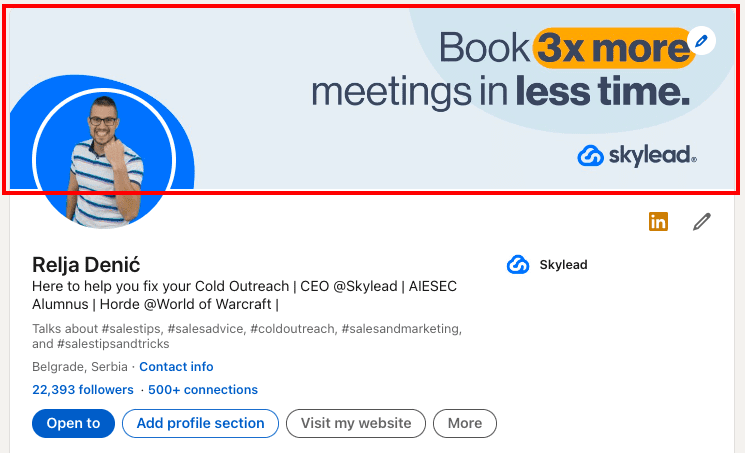
You can change it anytime and as many times as you wish.
#1 Click on the pencil icon in the top right corner of your LinkedIn profile’s header.
You will see two pencil icons, the lower one takes you to change your name, last name, headline, locations, etc., while the upper one takes you to change your LinkedIn cover photo.
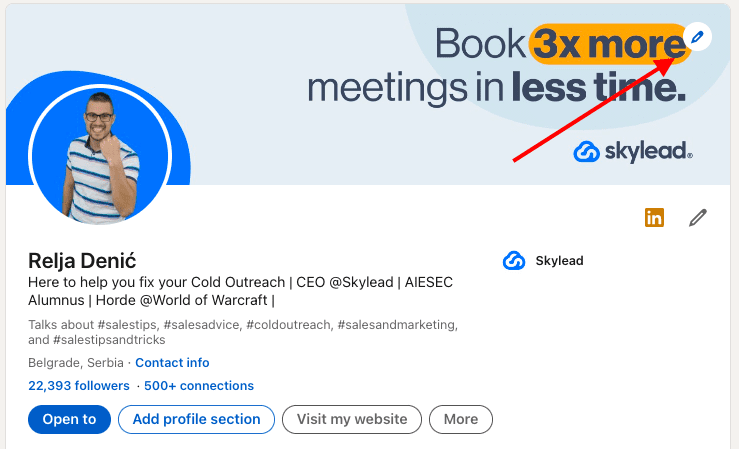
#2 Click on the Pen icon to access the LinkedIn background photo editor.
Here you can:
- Upload a new cover photo,
- Crop it,
- Apply filters,
- Adjust brightness,
- Rotate it,
- Zoom it, etc.
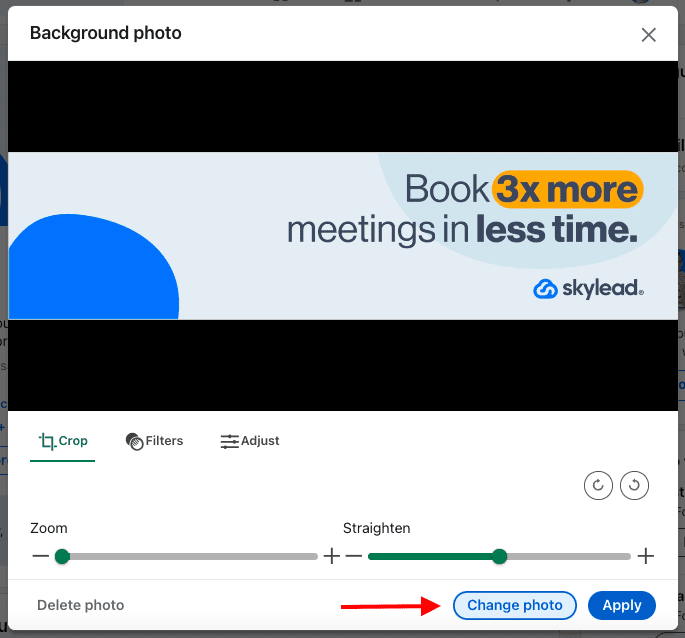
By clicking the Adjust icon you can make additional corrections to your image, such as
- Brightness
- Contrast
- Saturation
- Vignette
On mobile
To change your LinkedIn background photo on mobile, go to your LinkedIn profile page and click the Pencil icon in the top right corner.
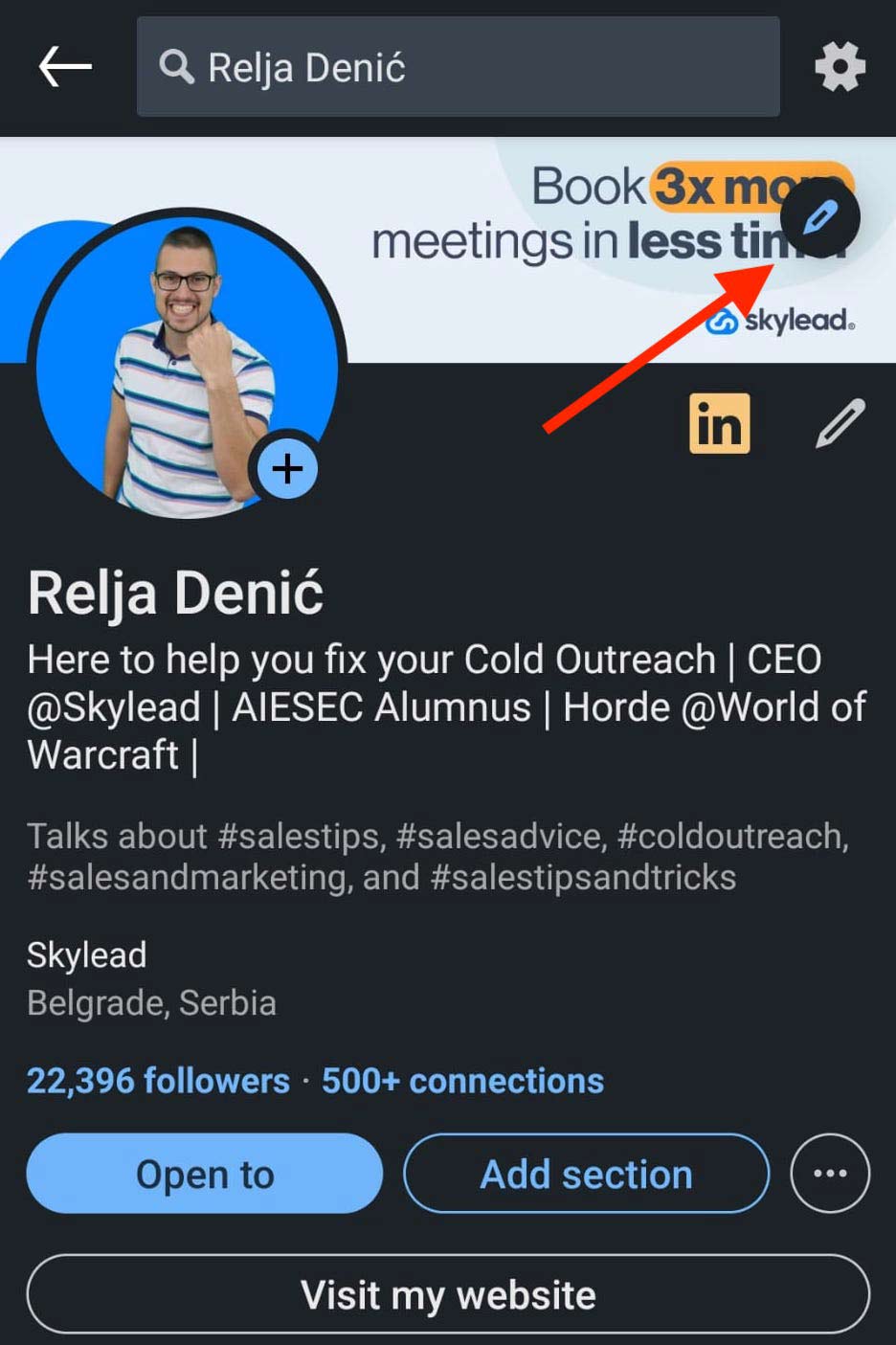
#2 In the bottom, you’ll find the options to edit, add a photo, or delete the existing one.
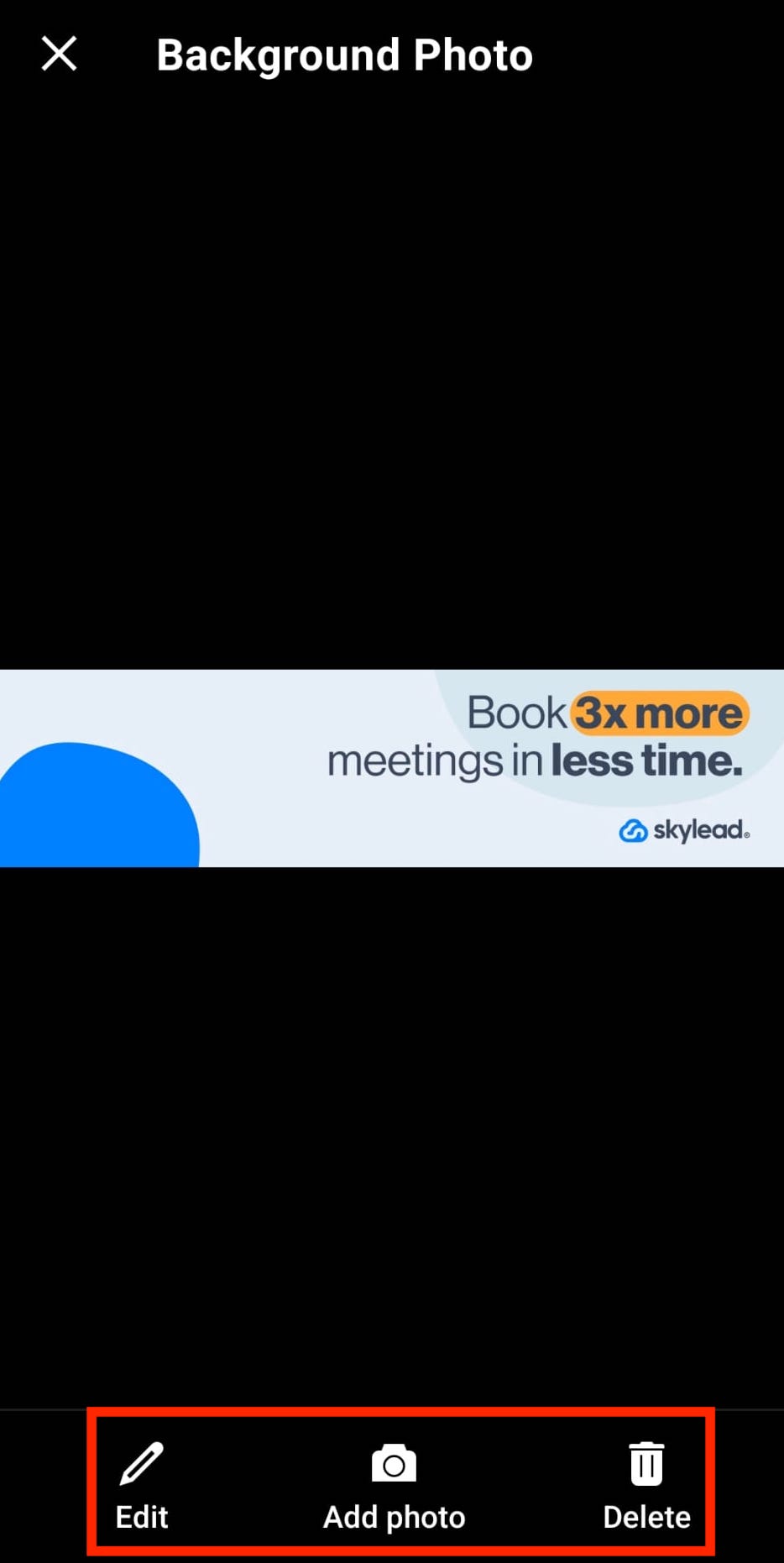
#4 Once you’ve uploaded the photo, you’ll get the same editing options as on the desktop.
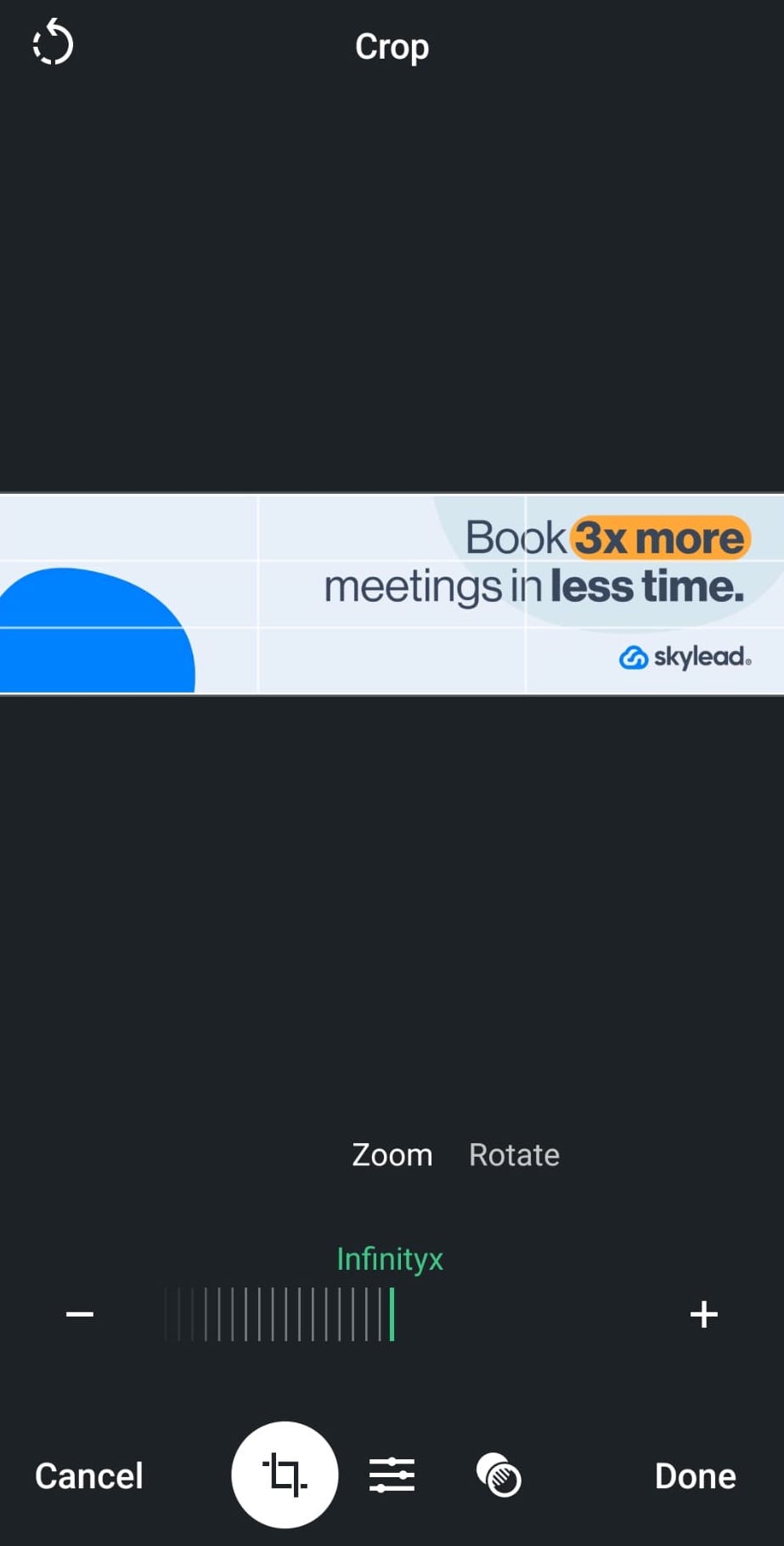
Change LinkedIn background photo for LinkedIn company pages
On desktop
To change the LinkedIn background photo on your LinkedIn company page, you must either be the page’s admin or be given access to the page with editing permissions.
Then, go to the LinkedIn company page you’re managing, and click the Pen icon here.

You will get a dropdown menu to:
- Upload a new cover image (check out LinkedIn cover photo size recommendations in this blog’s next section)
- Adjust the current cover image;
- Or, delete the current cover image.
Once you upload a new LinkedIn banner for your company page, or if you click to adjust the current one, the LinkedIn cover image editor will give you options to:
- Upload a new cover photo,
- Crop it,
- Apply filters,
- Adjust brightness,
- Rotate it,
- Zoom it, etc.
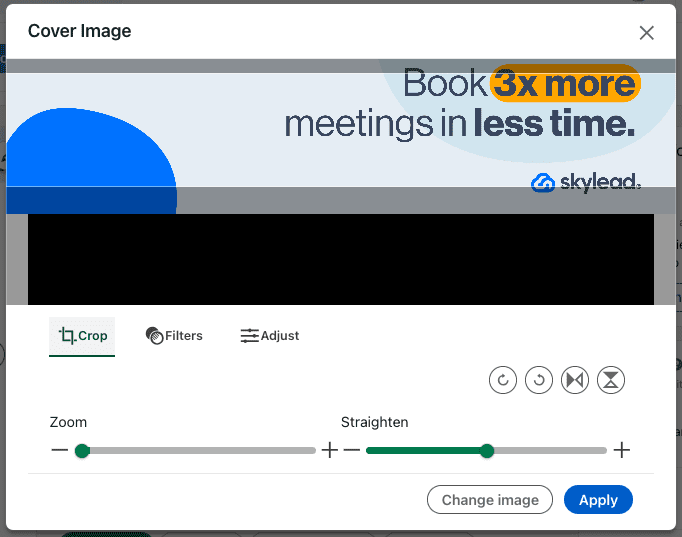
Also, by clicking the Adjust icon you can make additional corrections to your image, such as
- Brightness
- Contrast
- Saturation
- Vignette
What is the size of a LinkedIn cover photo?
In 2025, a LinkedIn cover photo size for personal profiles should be a maximum of 1584 x 396 px and a minimum of 1192 × 220 px, up to 8MB, and in JPEG, GIF, or PNG file formats.
When it comes to LinkedIn cover photo size for company pages, LinkedIn recommends a size of 1128 x 191 px, which is at the same time the minimum size, up to 8MB, and in JPEG, GIF, or PNG file formats.
Also, another thing to bear in mind is that LinkedIn cover photos are cropped differently on mobile and desktop devices. So, make sure to view your profile on both kinds of displays when setting up a new LinkedIn background photo. You don’t want important parts of your banner to be hidden or simply look bad.
Luckily, there are many online tools to help you make an ideal LinkedIn cover photo, and you don’t even need to be design-savvy.
Where can I find LinkedIn cover photo templates?
Nowadays, many online design tools have templates specifically for LinkedIn - such as posts, profile images, and background photos that require very little editing to look good.
Otherwise, if you wish to put in more effort, there are websites with free or paid stock images, or you can consider hiring a designer or someone design-savvy to do it for you.
Start with these.
| paid stock image websites | free stock image websites | online graphic design platforms |
| iStockphoto.com | Vecteezy | Canva |
| Shutterstock.com | Freepik | Fotor |
| Envato.com | Morguefile | VistaCreate |
| Depositphotos.com | Pixabay | Freepick |
| StockAdobe.com | Stockvault | |
| Pexels | ||
| Picjumbo | ||
| Pikwizard | ||
| Rawpixel | ||
| Reshot |
In our next section, you will find 10 ideas on different types of LinkedIn cover photos depending on the message you wish to get across with it.
Top 17 LinkedIn Cover Photo Ideas For Any Profession
As mentioned above, your LinkedIn background photo should complement your profile picture and headline and offer clarity on what your business is all about to your profile visitors already through the LinkedIn header section.
However, this doesn’t mean that you have one solution only.
Here’s a list of 17 LinkedIn cover photos that represent good practices with real-life examples.
Highlight your customers’ goals on your LinkedIn background photo
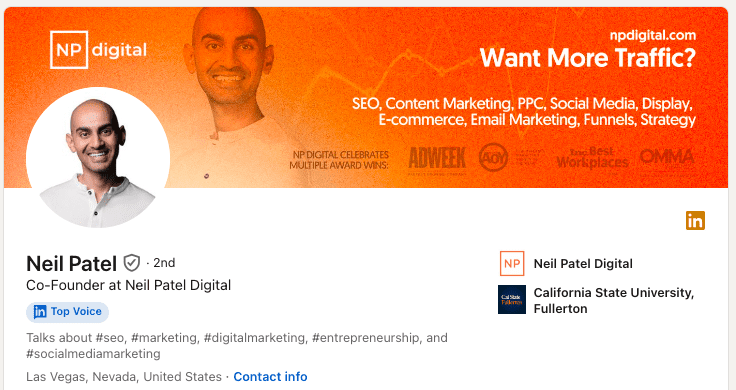
An excellent way to draw attention to yourself is to highlight your client’s most common pain point or ask a question that you know they’ll answer affirmatively.
Of course, it should relate to your service and a pain point your product or service can solve.
Make sure you communicate these messages clearly and include an important award or some kind of social proof (if any).
Showcase the people you serve on your LinkedIn cover photo
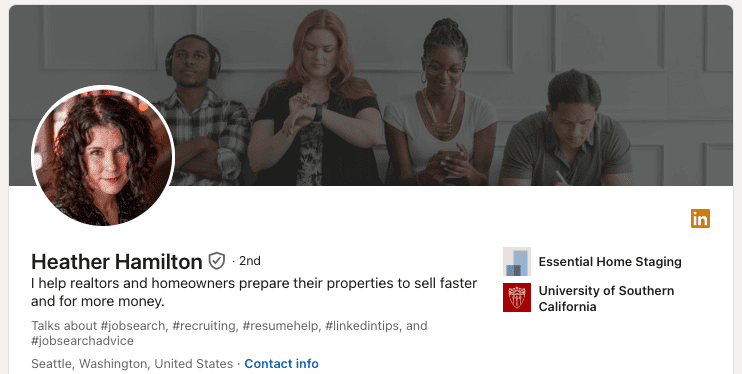
Featuring your customers is beneficial because people who visit your LinkedIn profile know right away if they potentially fall into that category.
Additionally, people are more drawn to images of real people, faces, and their expressions, so a LinkedIn cover photo of this kind will make them want to investigate further.
A LinkedIn background photo that showcases your clientele or your target clients doesn’t need to be their actual photo, of course. You can get a stock image that features people who are good examples of the types of people you serve.
Use the location or the location of your business on your LinkedIn banner
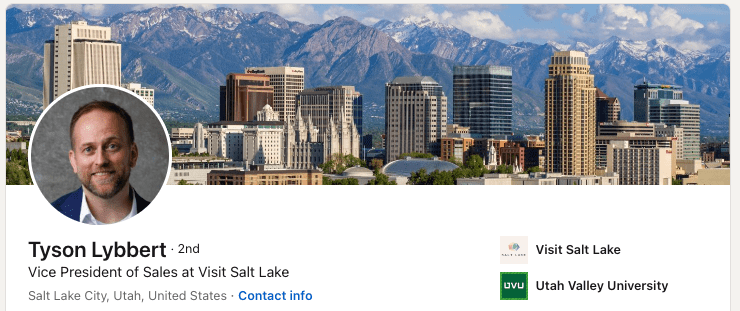
OR
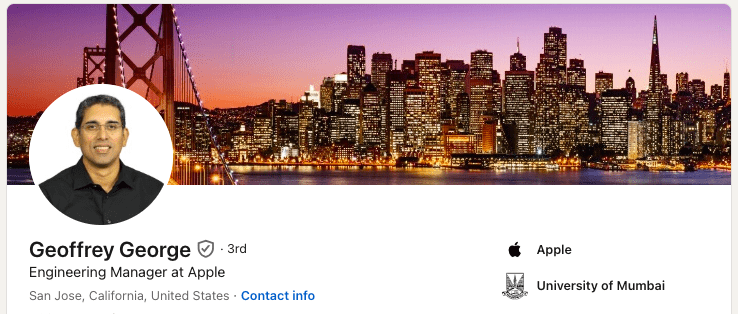
Highlighting the location of your business makes sense if what you do is restricted to a specific area or it’s particularly significant for it.
These types of LinkedIn cover photos don’t have to be necessarily limited to industries such as tourism for example. Still, they can be applied to any business or industry that acts locally.
On the other hand, displaying the city where you work or where you came from or that is particularly dear to your heart independently from the location of your business can ‘humanize’ your LinkedIn profile a bit.
Just because LinkedIn is a professional network whose members are encouraged to connect, network, and chat in the name of business, that doesn’t mean you should hide that you are a human before anything else. People are more likely to work with those whom they can connect with, rather than robots.
Put your hobbies or interests on your LinkedIn cover photo
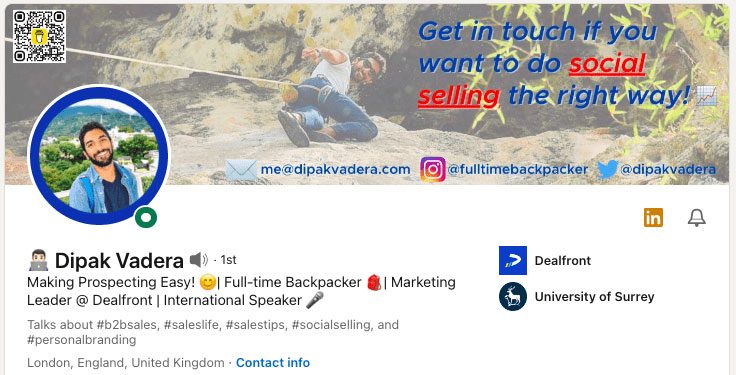
Speaking of ‘humanizing’ your LinkedIn profile, there’s no better way to do it than sharing something that interests you outside of your work schedule.
You could use your LinkedIn background photo to tell others about your hobbies, volunteering activities, or any kind of extracurricular activities. Opinions on sharing personal pictures on LinkedIn vary, given the platform’s professional nature. However, if the sharing is genuine, not excessive, and comes from a desire to build authentic connections, we say go for it.
No matter if you’re on LinkedIn to network, get clients, or find a job, everyone likes to see there’s more to you than just your professional, online self.
Display objects or tools relevant to your job on your LinkedIn background photo
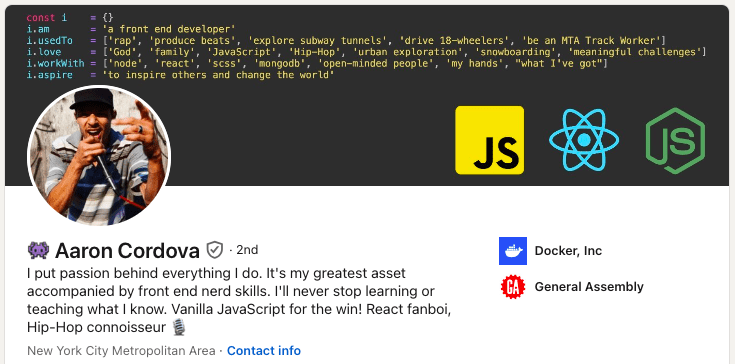
Featuring an object such as a photo camera if you are a photographer can seem a bit ‘unsurprising’ but it doesn’t need to be! Just look at how creative, yet informative the above LinkedIn cover photo is.
Without even reading through this LinkedIn user’s profile, you can understand what he does for a living and what technologies he knows (JavaScript, React, NodeJS).
Furthermore, he adds a personal touch to his LinkedIn background photo by mentioning the things he loves, believes in, and does outside his regular working hours.
This type of LinkedIn cover photo is excellent for freelancers and people who are searching for a job, as it says straight off the bat what your professional strengths are.
Use a LinkedIn cover photo of you doing your work
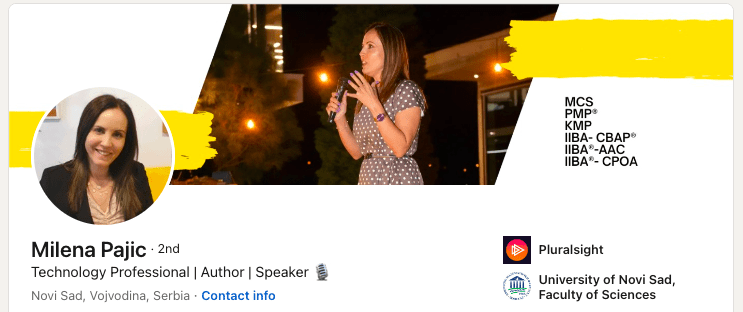
A picture of yourself doing your work can be a great choice if your job is actually some kind of service that can be presented clearly in a photo.
On LinkedIn, usually, these types of LinkedIn cover photos are typical for motivational and public speakers, or for those who want to highlight them speaking in front of larger audiences.
It doesn’t mean that it will not work for other industries as well, just put your creativity to use and make sure you have someone to take a good shot of it.
Clearly state what your job is on your LinkedIn banner
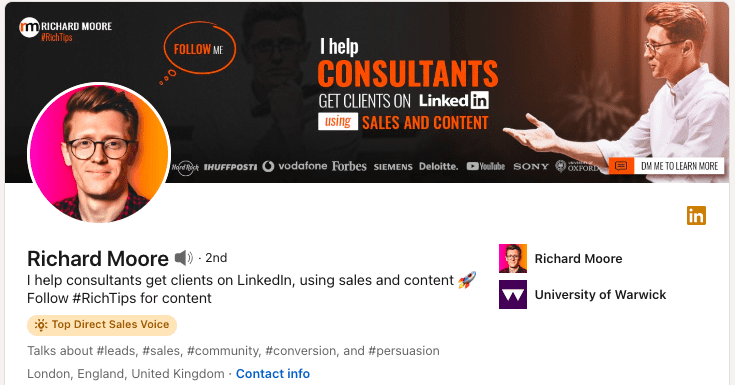
OR
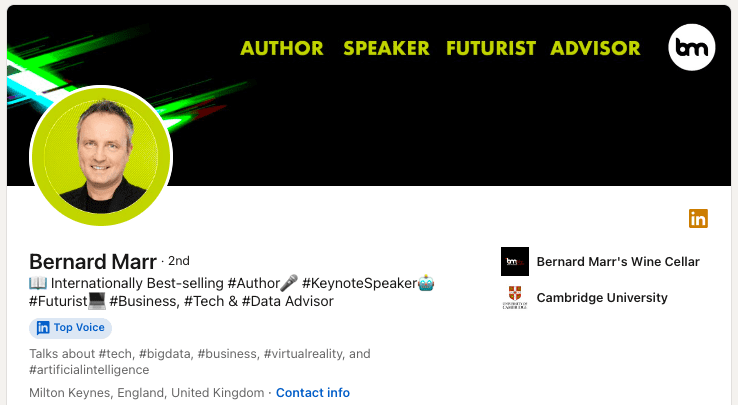
This is a pretty straightforward, nothing-too-crazy yet effective way to make it very clear to your LinkedIn profile visitors what you do for work.
As you may see from the above examples, you can describe what you do (example #1) and how you do it, or simply list your professional roles (example #2).
This way, it is very clear what your business is about to whoever lands on your LinkedIn profile.
Showcase your product or service on your LinkedIn background photo
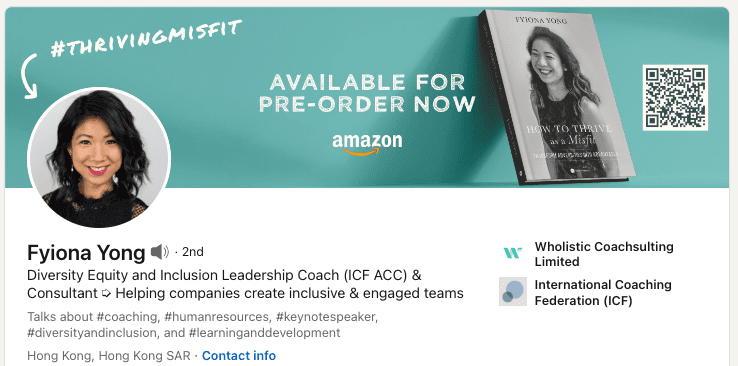
This is a pretty straightforward, yet effective way to tell your profile visitors what you are all about in general or at the moment. Furthermore, it is a great way to promote a book, podcast, service, you name it.
As you may see from our examples, displaying your product or service could be accompanied by a catchy Call-To-Action.
Display your career path on your LinkedIn cover photo
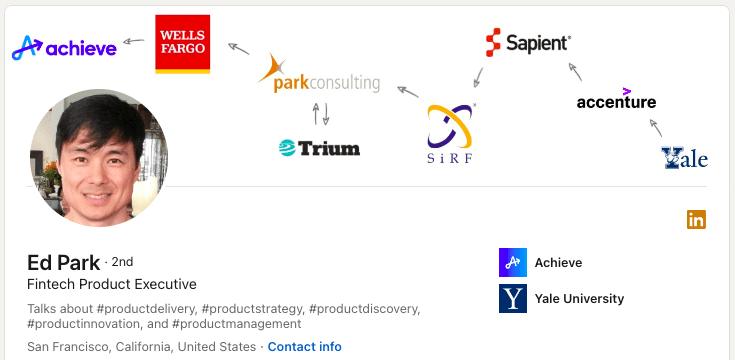
If you find your career path to be the most valuable part of your curriculum or your valuable unique selling point, here’s a creative and smart idea of how your LinkedIn profile visitors can learn all about it.
This LinkedIn member decided to display his path from a college to the company for which he currently works. However, this creative idea can be applied in many ways depending on what you wish to highlight in your LinkedIn background photo.
Use your company’s LinkedIn cover photo for your personal LinkedIn background photo
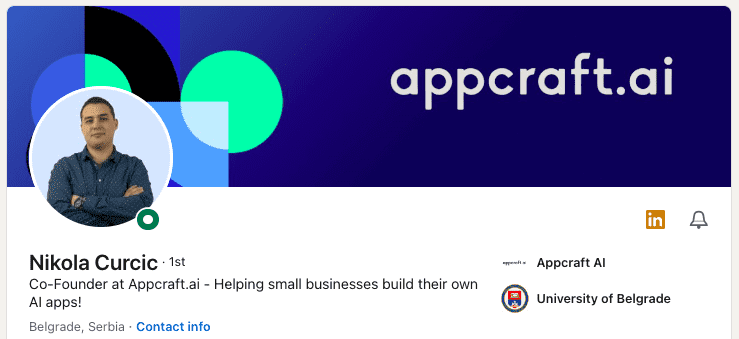
OR
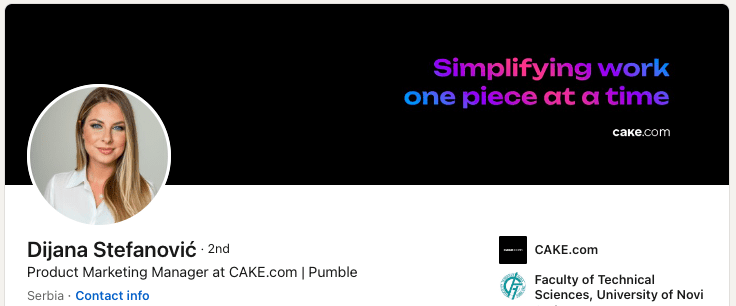
Some companies have LinkedIn cover photos designed specifically for their employees. This can be the simplest way to tell your profile visitors where you work right off the bat.
Featuring a LinkedIn background photo with just your company’s logo or some other kind of visual representation of your company can be a good choice if you feel strongly about the brand.
Furthermore, your company’s LinkedIn cover photo can contain a mission statement, values, or any message that your brand wants to get across.
Put an inspiring quote on your LinkedIn banner
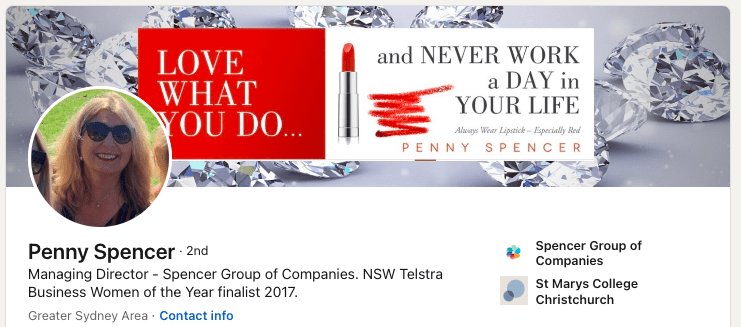
An inspirational quote on your LinkedIn background photo can refer to something you personally believe in, or it can have to do with your brand.
If combined with an attractive design, this type of LinkedIn cover photo can be pretty effective and inspiring to people visiting your LinkedIn profile to investigate your services further.
Put a picture of an office space or a building for corporate, executives, legal, & similar to your LinkedIn cover photo
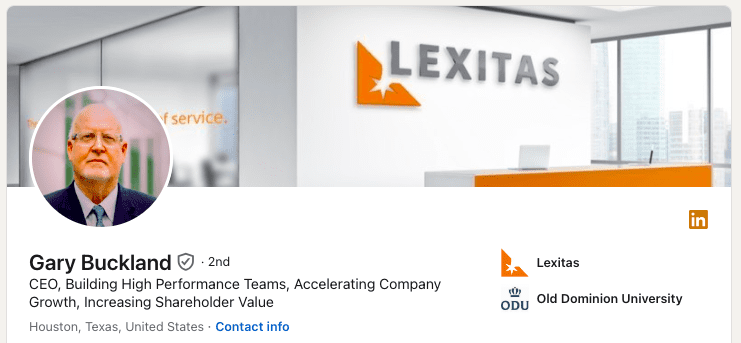
OR
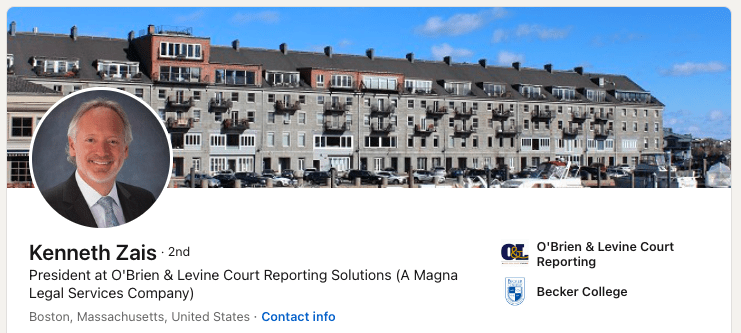
The above example is a good LinkedIn cover photo of people working in corporate, upper management, legal, and anyone who finds their business space to give off the impression of professionalism, a specific status symbol, high-level service, or similar.
Furthermore, if your office is a well-known building, or it has been there for ages so that it even become part of the city's history, displaying it in your background might give your LinkedIn profile visitors a sense of familiarity.
Make your LinkedIn banner a collage
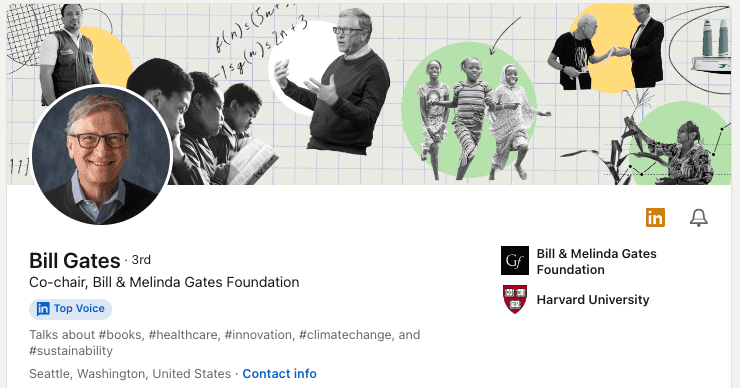
Finally, you can make a collage visually representing your interests, product or service, target audience, yourself while doing your work, or pretty much anything you wish to showcase on your LinkedIn cover photo.
However, keep in mind that crafting appealing collages is not as easy as it might seem – they should be informative without becoming cluttered or chaotic. Therefore, unless you are a skilled visual artist, you might want to hire a designer to do it for you. Collages are pretty effective, so it could totally be worth it.
Summary
Before diving into choosing your ideal LinkedIn cover photo, consider your focus — clients, yourself, workspace, or tools.
Which emotions do you wish to convey? Empowerment, trust, professionalism?
What kind of LinkedIn background photo would enhance your professional image while aligning seamlessly with your brand?
This strategic approach ensures your LinkedIn presence resonates effectively with your target audience while automating your LinkedIn lead generation activities through Skylead. All features are available for a 7-day FREE trial starting today! Don’t miss out!
A well-crafted LinkedIn connection message can make a busy decision-maker click Accept to yours and leave pending the other 50+ connection requests they received that day on the platform.
With over 65 million decision-makers, LinkedIn is THE #1 professional social network that made it possible for the entire world to connect business-wise.
However, while it’s true that, today, you can find anyone you need on the platform, the volume of messages certain professionals get on a daily basis is so high that you need to find a way to stand out from the crowd to get their attention.
To understand how important connections are on LinkedIn, bear in mind that 98% of sales representatives with more than 5,000 LinkedIn connections mostly surpass their selling quotas.
The maximum size of your network on LinkedIn is limited to 30,000 connections, so you want to use that number to connect with LinkedIn members relevant to your business (and you want to do so before your competitors, so… ⬇️ )
In this blog, we will:
- Answer some of the most common questions about LinkedIn connection requests;
- And give 25 proven LinkedIn connection message examples with up to a 78% acceptance rate to use right away.
How to send a connection request on LinkedIn?
To connect with a LinkedIn member from the search result, click on the Connect button in the top right corner of the member’s LinkedIn profile section.
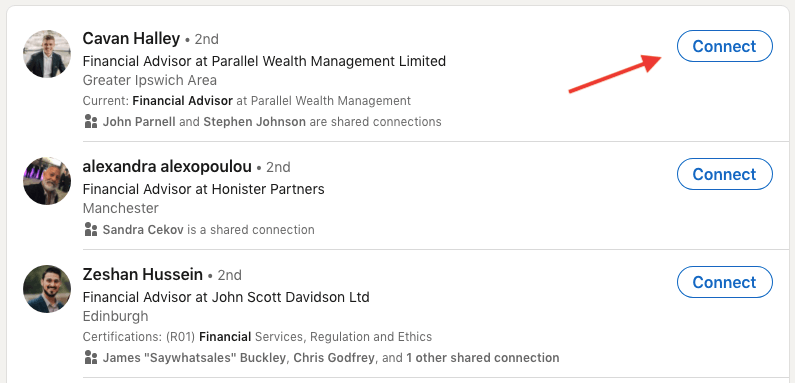
OR
Open the LinkedIn member’s profile. Click Connect.
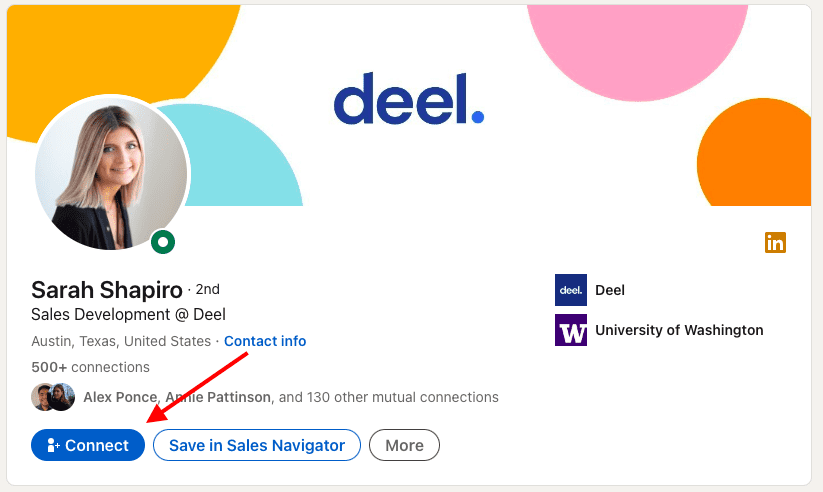
How to cancel a pending LinkedIn connection request?
Not a lot of people monitor their pending LinkedIn connection requests, which is wrong because the integrity of their LinkedIn profile could get damaged. Essentially, good pending-request hygiene can save you from LinkedIn jail and improve your acceptance rate on the platform.
That’s why, we wrote a complete guide on How to cancel your LinkedIn invite, and, above all, explained in detail:
- Why do you need to cancel your LinkedIn invite;
- What you need to know about the cancellation process;
- How to cancel LinkedIn invitations that are pending for a long time;
- Why your LinkedIn invites aren’t getting accepted;
- How to create engaging invitations that will increase your acceptance rate.
Skylead users have the benefit that you can set up Skylead to withdraw pending requests to safeguard their LinkedIn profiles and allow them to send invites to connect to other people relevant to their business.
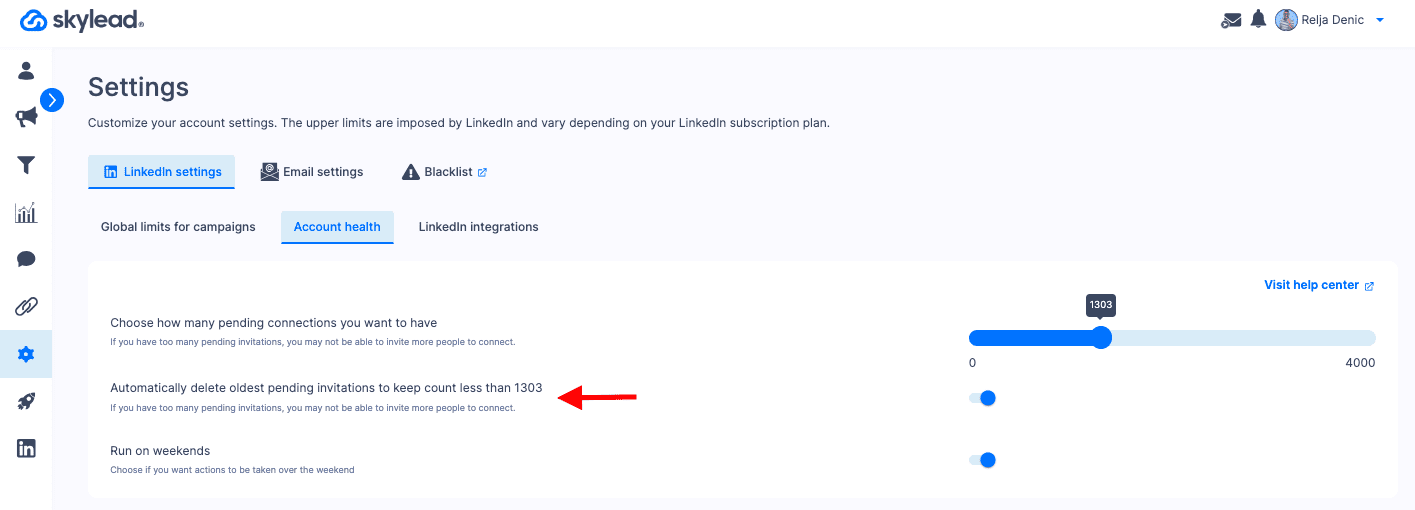
In the meantime, if you just wish to cancel a pending LinkedIn connection request, first click My Network on your LinkedIn profile home page.

Choose Manage or See all.

Choose Sent and the Withdraw option that’s next to the LinkedIn member’s name.
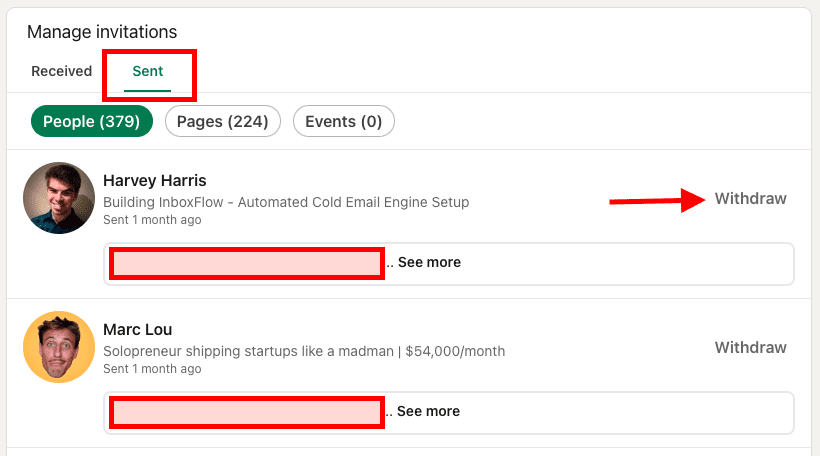
If you cancel a LinkedIn connection request, you won’t be able to send it again to the same member for the following 3 weeks.
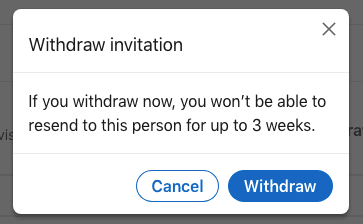
How to message someone on LinkedIn who is not a connection?
There are 3 types of connections on LinkedIn, and here is how to message every one of them.
- 1st-degree connections are LinkedIn users who are already part of your network. Reach out to them via regular LinkedIn messages using some of these LinkedIn sales message templates.
- 2nd-degree connections are LinkedIn members who are connected with your 1st-degree connections but not with you. Send them a LinkedIn connection message first, followed by a Thank you message on LinkedIn once they accept.
- 3rd-degree connections are LinkedIn members connected with your 2nd-degree connections. The platform encourages to reach out to these members via LinkedIn InMail first ( ➡️ here are LinkedIn InMail templates with a 25% reply rate formula tested by our Head of Sales, Andrea)
How to write a connection message on LinkedIn [5 best practices]
So, as mentioned above, it takes only a few people to deny your LinkedIn connection request and click I don’t know this person for you to be flagged on LinkedIn.
So, we decided to share 5 guidelines followed by our sales team when writing a LinkedIn connection message.
Look for common ground.
Mentioning any common ground turned out to be a positive practice. It could be a community you both belong to, a shared interest, a school, an industry, or even the same point of view on a specific topic.
Stay professional.
Reach out to other members in a professional manner. Avoid making personal references or giving compliments that are not business-related or argued.
Personalize your LinkedIn connection messages.
Addressing your lead by name is a must. Then, any other detail that you can mention, such as - the company name, the exact job title, set of skills, or job description, shows that you did your research. The more you know about your lead, the higher the chances of getting accepted on LinkedIn and turning that lead into your customer.
No generic nor irrelevant LinkedIn connection messages.
Even a blank LinkedIn connection request is better than I’d like to add you to my network.
Also, it’s hard for a pharmaceutical sales representative to be interested to read your article on SEO. Know who you are talking to.
Avoid selling straight out the gate.
Even if they need and like your product or service, no one will purchase anything without any additional info, chat, or call.
25 LinkedIn connection message examples [Up to 78% acceptance rate]
Tailor-making a LinkedIn connection message to each lead might seem a bit time-consuming, but it doesn’t have to be (not if you’re using Skyleaaaad 😂 ).
Jokes aside (or not!), the results of sending personalized LinkedIn connection messages are pretty rewarding.
Once you get used to the principles of writing in a compelling, LinkedIn-friendly way, your LinkedIn outreach will become a much more enjoyable experience.
Until then, use the LinkedIn connection message examples below that our team and users tested to grow their networks with relevant prospects.
Mention a mutual connection
Template
Hello {{firstName}},
I noticed that you are connected with {{mutualConnection}}.
{{mutualConnection}} and I worked together at {{company}}. I really loved {{whatYouLovedAboutMutualConnection}}.
I see that we are both in the {{industry}} industry and would love to have you in my network.
Example
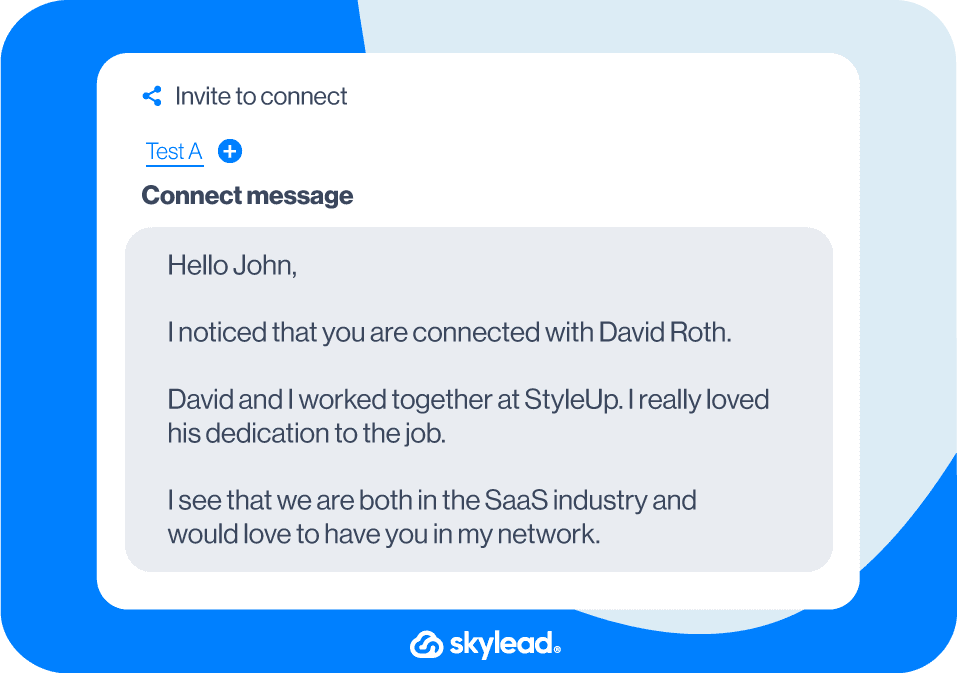
OR
Template
Hello {{firstName}},
{{mutualConnection}} pointed me your way for B2B lead generation services – would love to connect.
Example
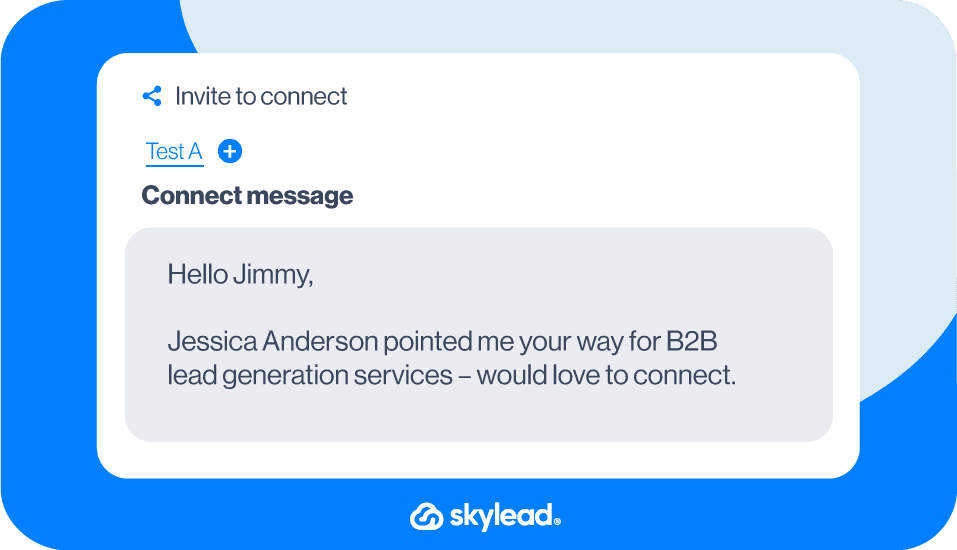
Reaching out to a candidate (as a recruiter)
Template
Hello {{firstName}},
It seems that you’ve been a great addition to your team at {{company}}. Way to go!
I would like to talk to you about a business opportunity.
But even if you’re not interested, it would be great to have you as part of my network!
Example
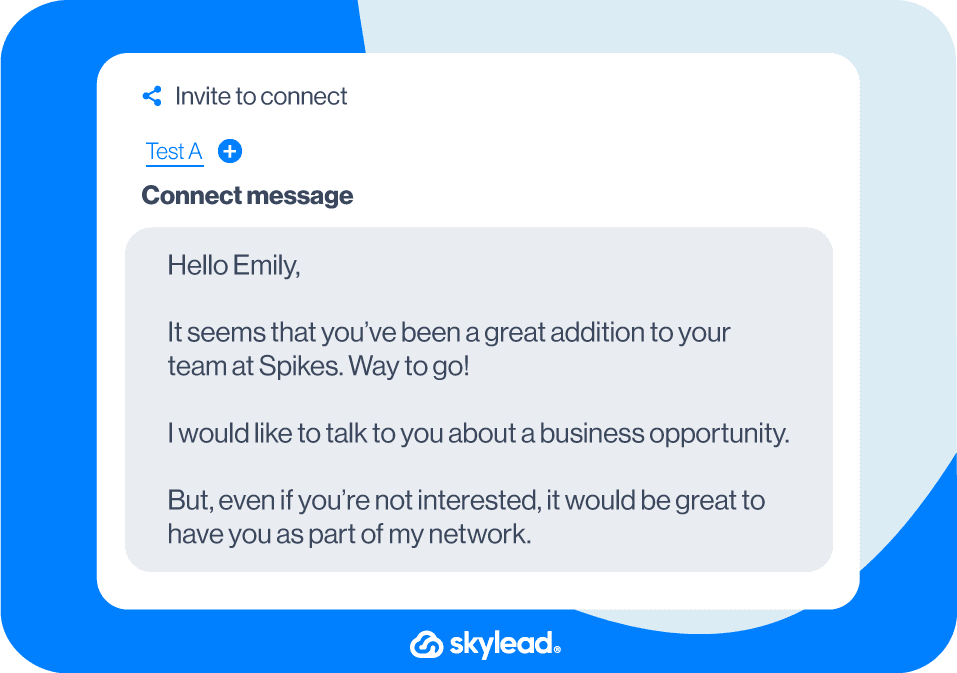
OR
Template
Hello {{firstName}},
I am reaching out to you for your vast experience as a {{occupation}}.
{{company}} is currently searching for a {{position}}.
If this sounds interesting to you, let’s connect.
Example
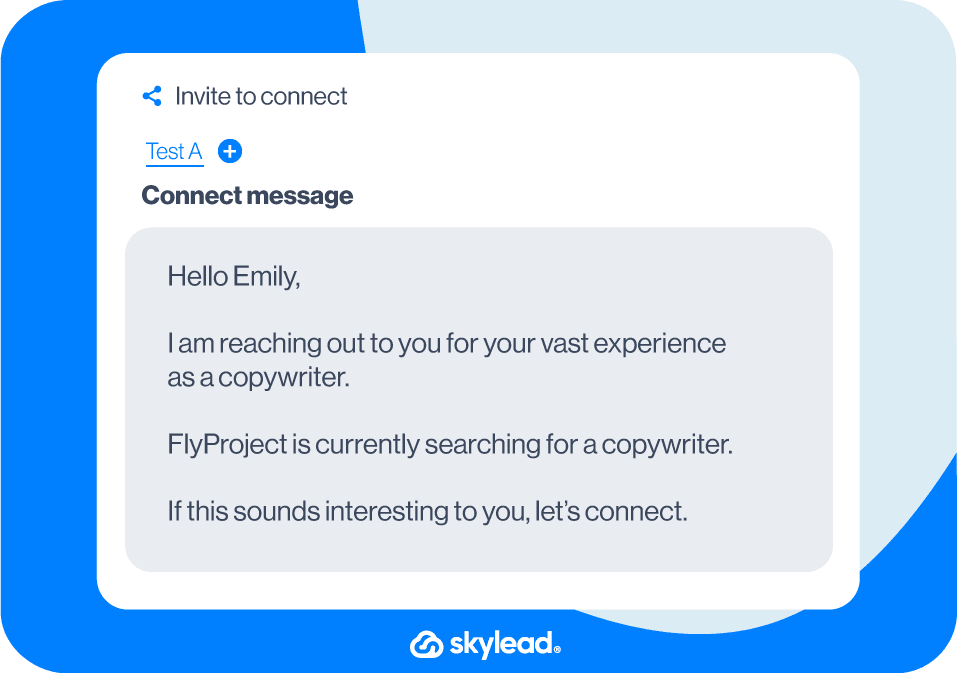
Reaching out to a recruiter (as a job seeker)
Template
Hello {{firstName}},
I saw that you are a recruiter at {{company}}.
I am a {{occupation}} with {{number}} years of experience in the {{industry}} industry, currently seeking new opportunities.
I’d like to connect and chat to see if my background fits any of your openings.
Example
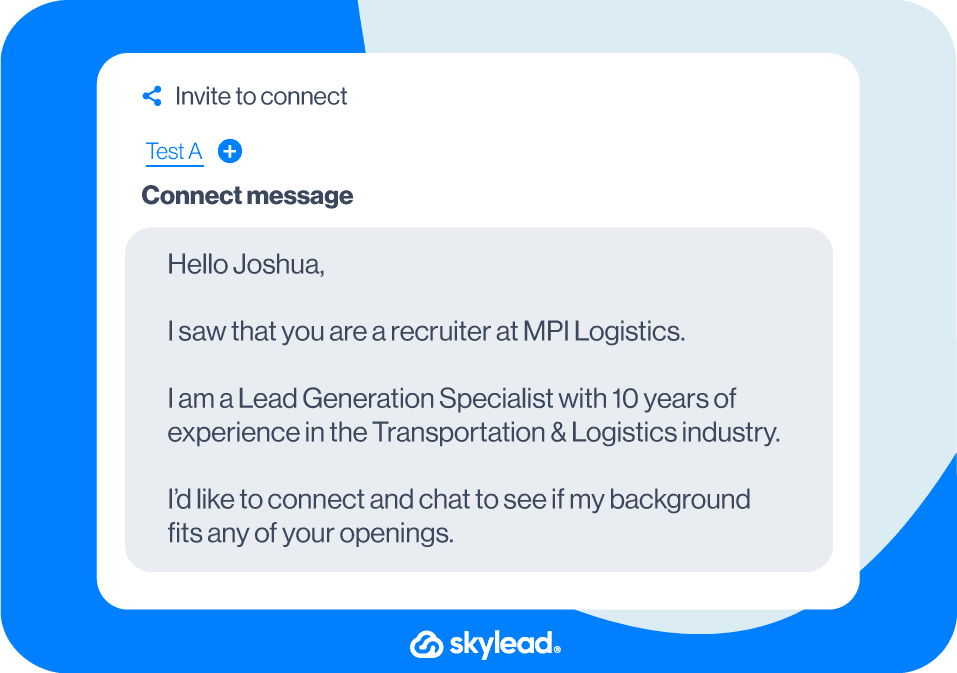
OR
Template
Hello {{firstName}},
I see that you’re the recruiter in charge of the {{occupation}} position at {{company}}.
I am very interested in applying but would like to ask you a few questions first.
Let’s connect.
Example
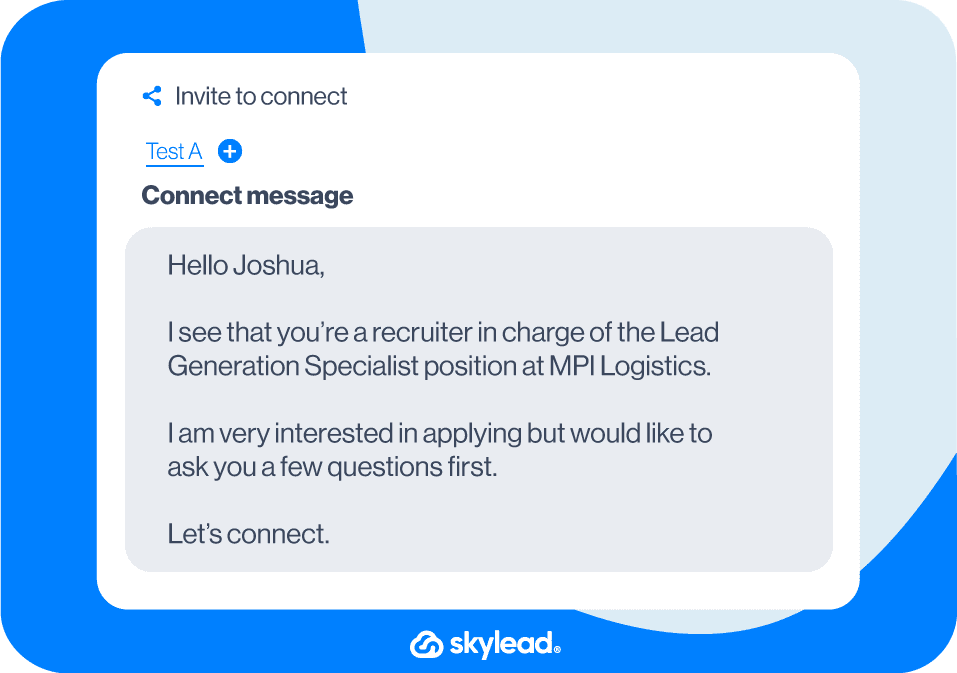
Intro to a collaboration proposal
Template
Hello {{firstName}},
I am a long admirer of your work.
I followed your advice regarding {{topic}} that you shared {{where}}. {{achievedResult}}.
Thank you once again!
Would love to connect!
Example
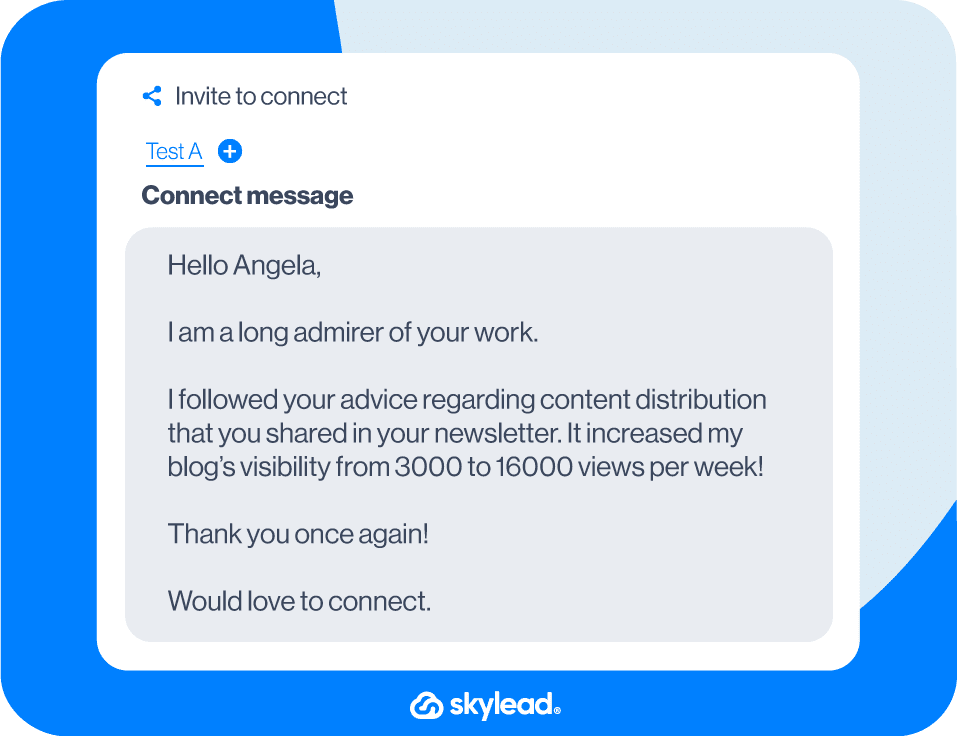
Connect with a member of the community
Template
Hello {{firstName}},
Your post in {{mutualCommunity}} was quite insightful.
I particularly liked the part where you said {{quote}}.
I would like to discuss it further with you. Let’s connect.
Example
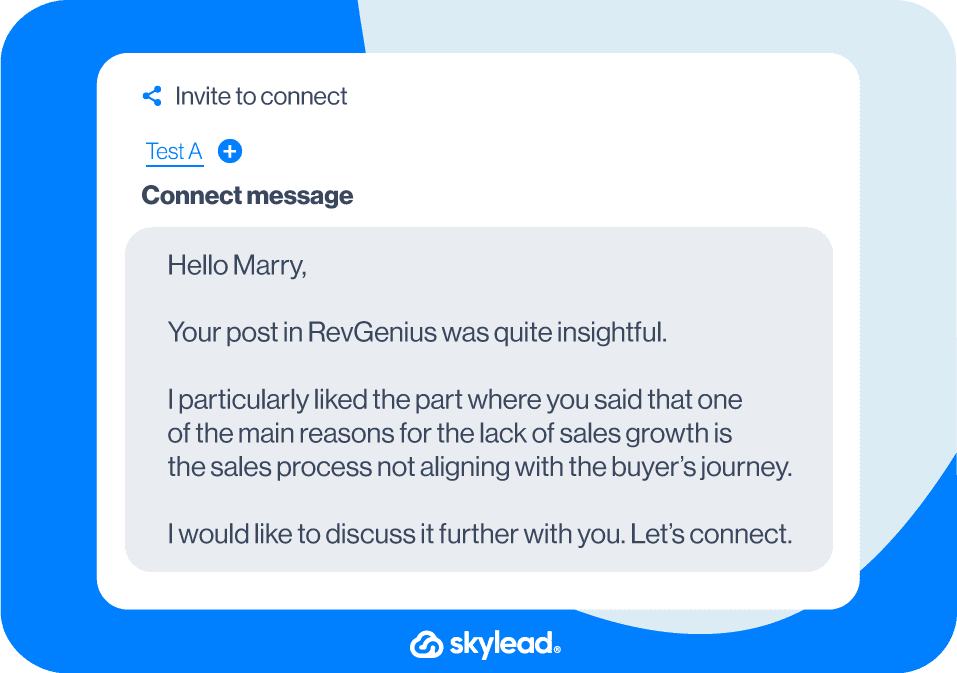
OR
Template
Hello {{firstName}},
I saw that you are also a member of {{mutualGroup}}.
I would love to connect with you since we both work in the {{industry}} industry.
Example
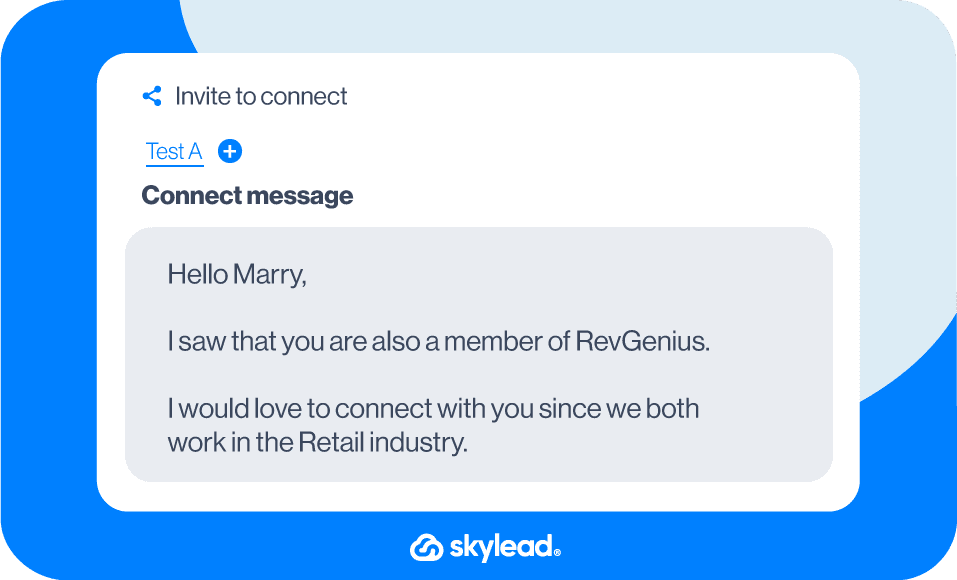
Approach an event attendee
Template
Hello {{firstName}},
It was great speaking to you at the {{eventName}} {{when}}.
What you do at {{currentCompany}} sounded fascinating and it totally inspired me!
I’d definitely like to stay up-to-date with your work.
Thank you in advance for connecting!
Example
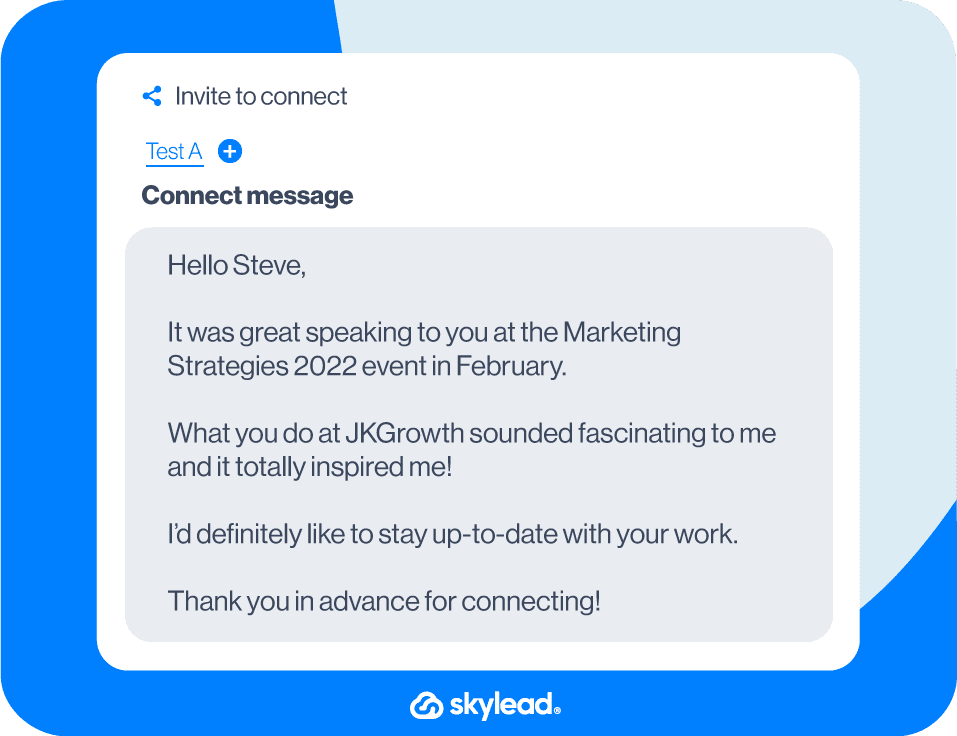
OR
Template
Hey {{firstName}},
I saw you at the {{eventName}} but I didn’t get the chance to approach you and introduce myself. How did you like the {{eventName}}? Would love to connect here and stay in touch!
Example
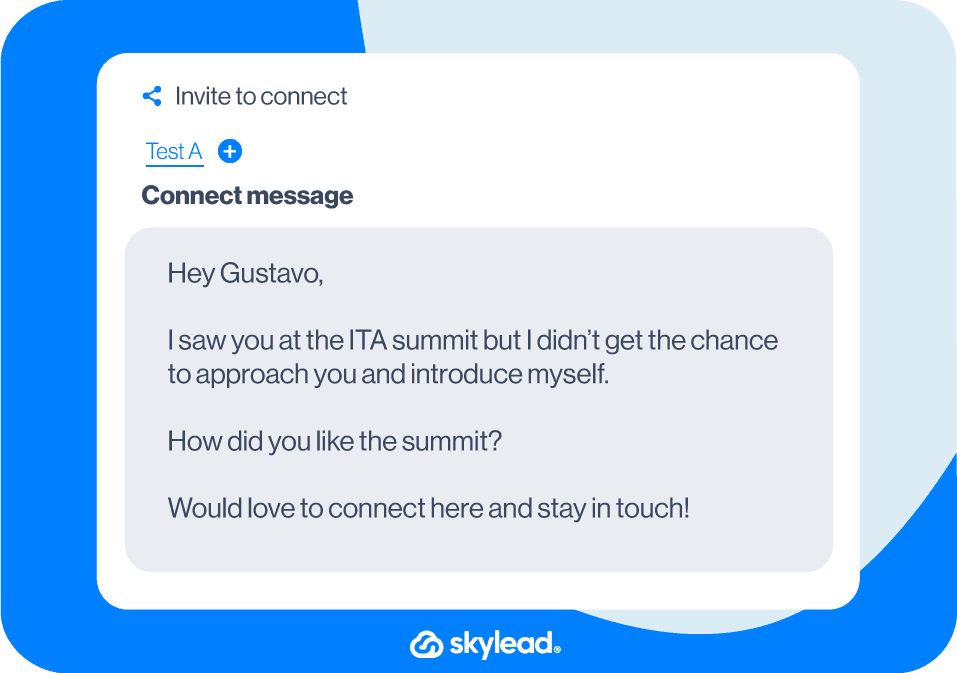
Reach out to a LinkedIn event attendee
Template
Hello {{firstName}},
I saw that you too attended the {{eventName}} LinkedIn event.
Learning {{what}} was particularly useful for my business.
Anyways, I would love to connect and exchange feedback on the event.
Example
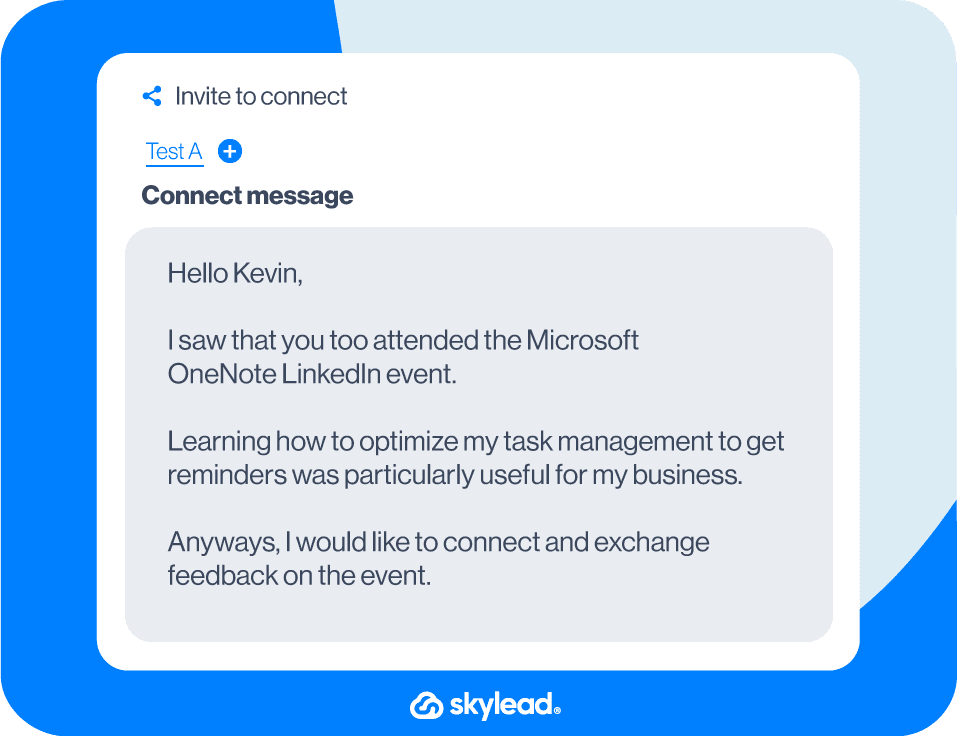
Reach out to an author of a LinkedIn article or post
Template
Hi {{firstName}},
I came across your LinkedIn article on {{topic}}.
I really resonated with your thoughts on {{topic}}.
I’d love to keep in touch and learn more about your work.
Example
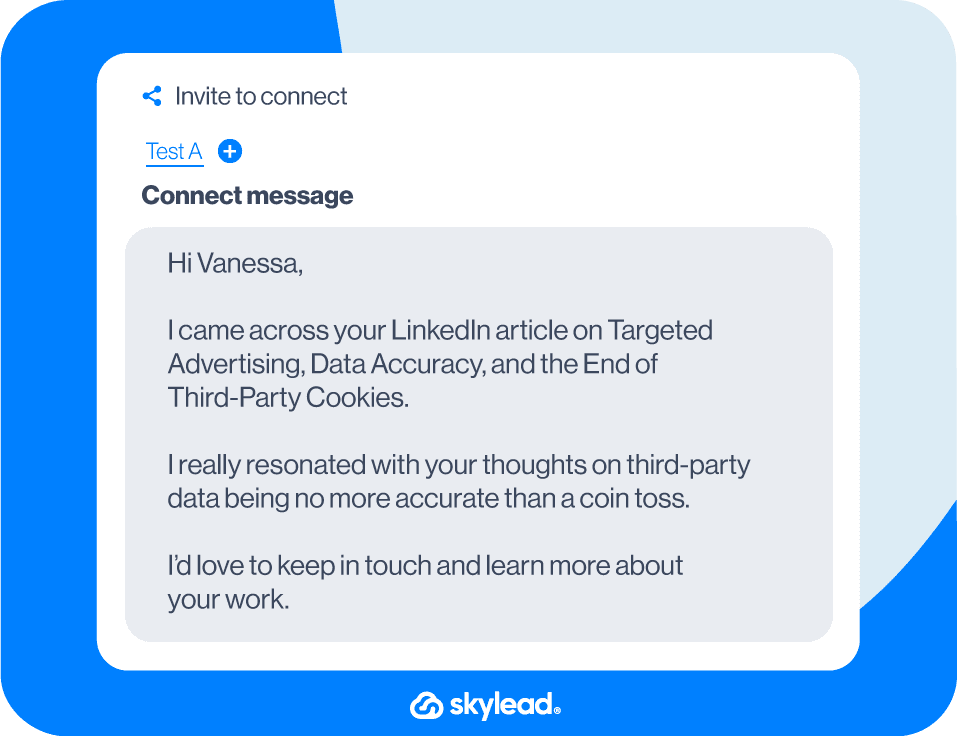
Break the ice using industry humor or a joke
Here are 35+ industry jokes that you could use in your LinkedIn connection requests as an icebreaker.
Template
Hi {{firstName}},
How many therapists does it take to change a light bulb?
Just one - but the light bulb has to really want to change.
Jokes aside, I would love to connect!
Example
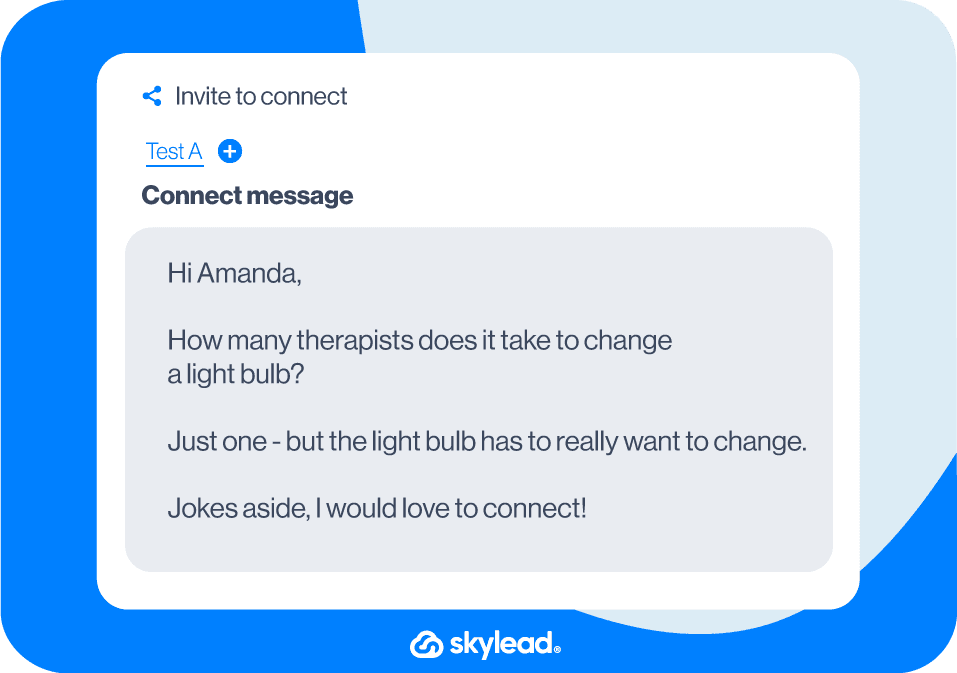
OR (something as silly as this)
Template
Hello {{firstName}},
I noticed we both breathe oxygen.
Sounds like a perfect fit to me, let’s connect!
Example
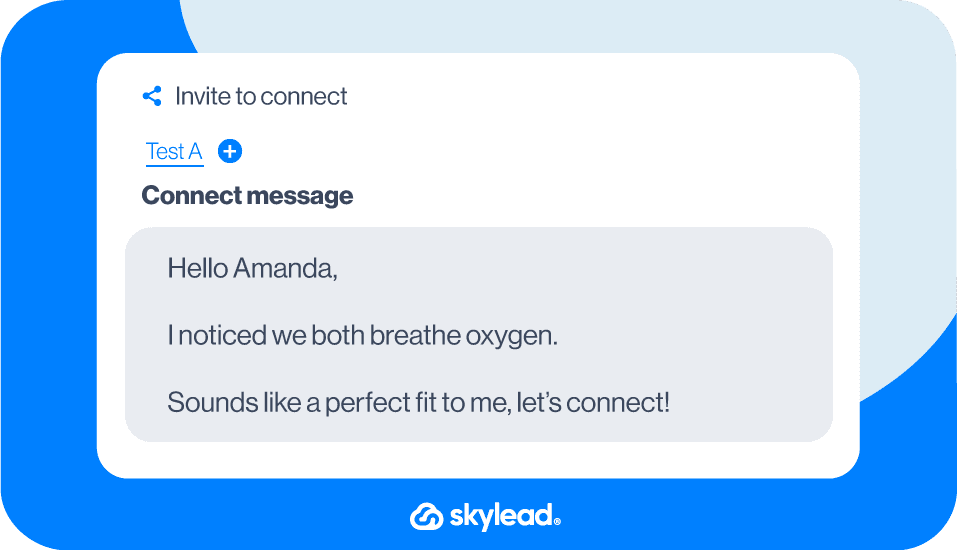
Connect with a former colleague
Template
Hello {{firstName}},
Remember me?
We used to work together at {{company}} back in {{year}}.
Let’s connect and catch up, I would love to hear how it is going at {{currentCompany}}!
Example
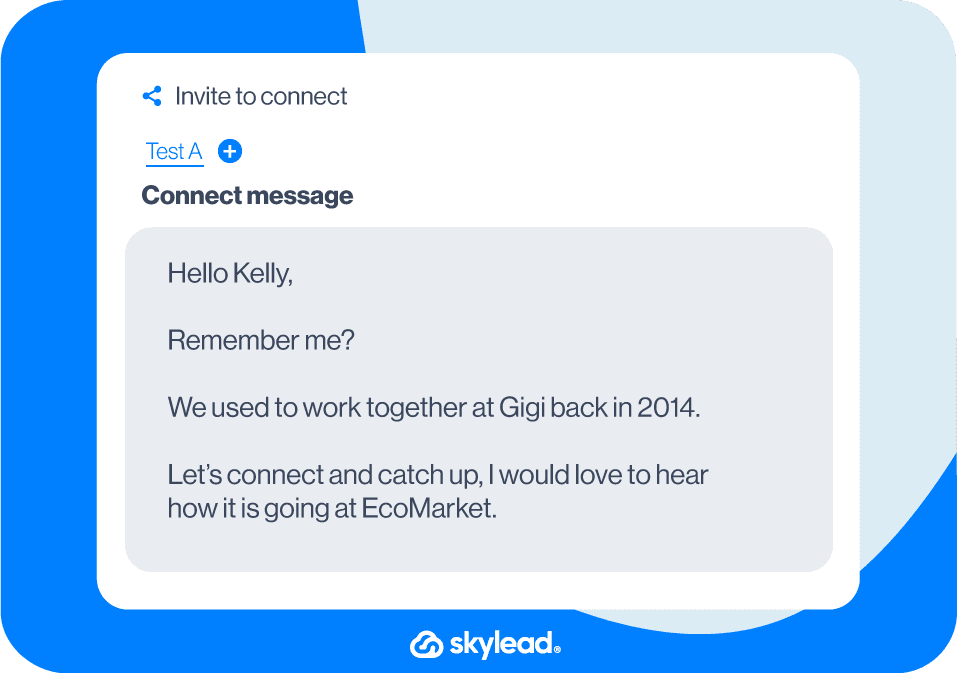
OR
Template
Hello {{firstName}},
It was such a pleasure working with you at {{company}} back in {{year}}.
Let’s connect! I would like to hear what you’ve been up to professionally since.
Example
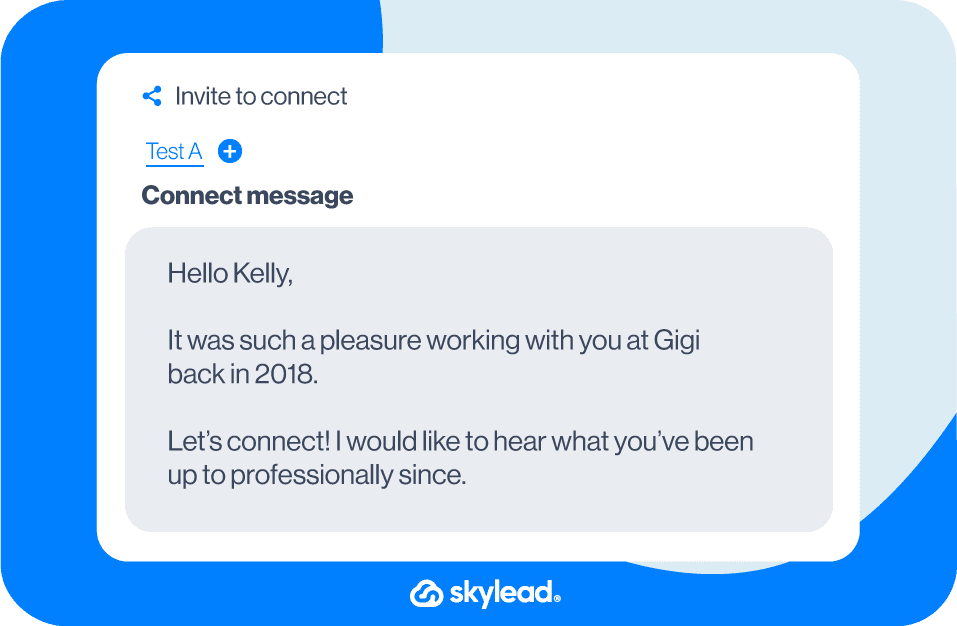
Reach out to a colleague
If a company is big, knowing everyone you’re working with is hard.
However, connecting with colleagues is a good practice for expanding your network on LinkedIn.
Remember that they also might have some interesting connections, and you never know who they could introduce you to.
Template
Hello {{firstName}},
Good news travels fast! I heard about you {{achievement}}. Great job!
Anyways, I am {{yourName}} from the {{department}} team and would love to connect!
Example
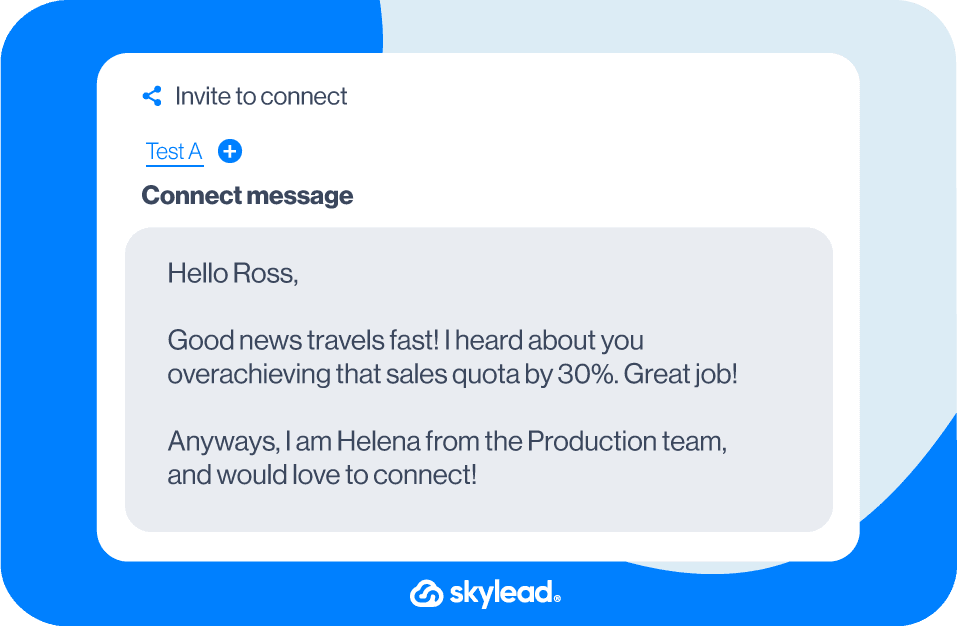
Connect with former alumni
Template
Hello {{firstName}},
I see that we graduated from the same university. Go {{school’sSportsTeam}}! 🙂
I would like to connect and learn more about your experience at {{company}}.
I myself majored in {{major}} and currently work in the {{industry}} industry.
Example
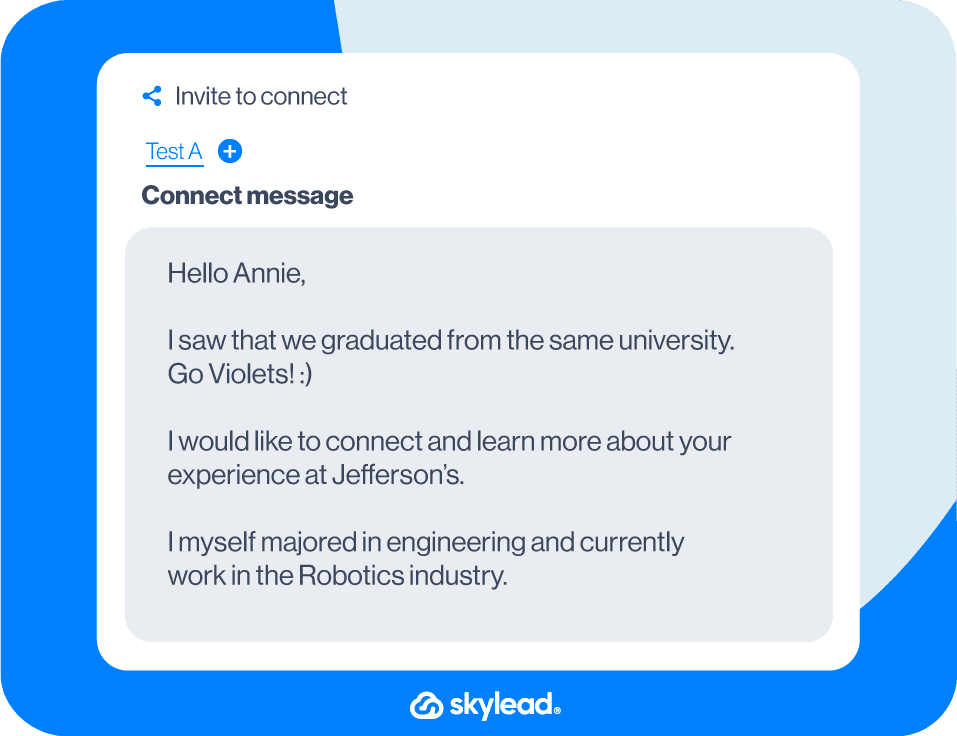
Reach out to members who reacted to your or someone else’s LinkedIn post
Template
Hello {{firstName}},
I saw that you are also a fan of {{name}}’s content and just wanted to connect with you.
Example
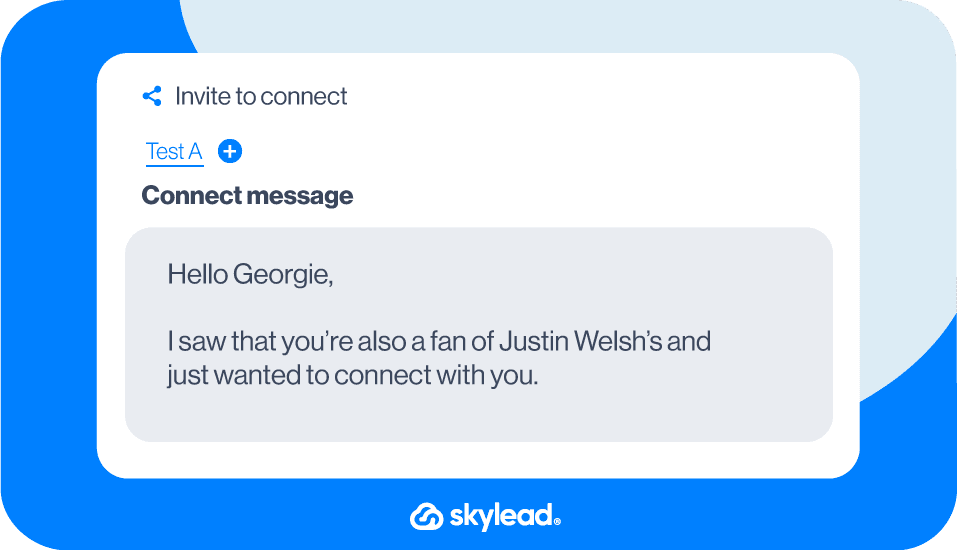
OR
Template
Hello {{firstName}},
I saw that you also liked {{Name}}’s post on {{topic}}. I am a big fan of his/her work.
His/her advice worked well for me!
Anyways, I would love to connect and maybe even discuss it further.
Example
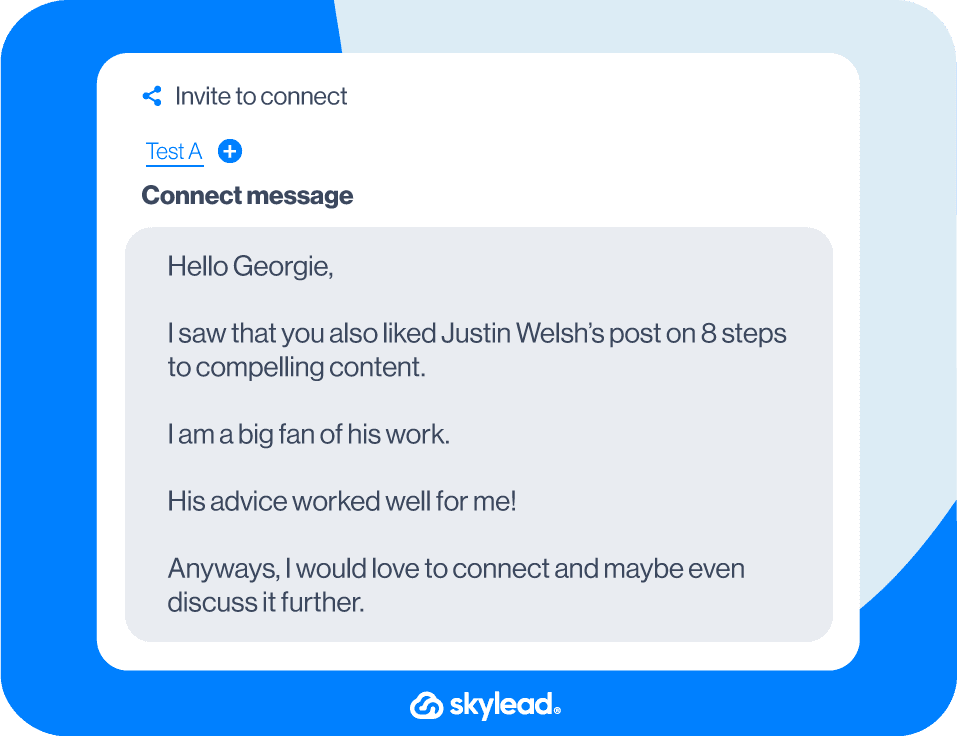
Connect with a member who asked a question in the post comment
Template
Hi {{firstName}},
I saw that you commented on {{name}}’s post about {{topic}} and asked {{question}}.
I would like to connect and share some resources with you that could be helpful.
Example
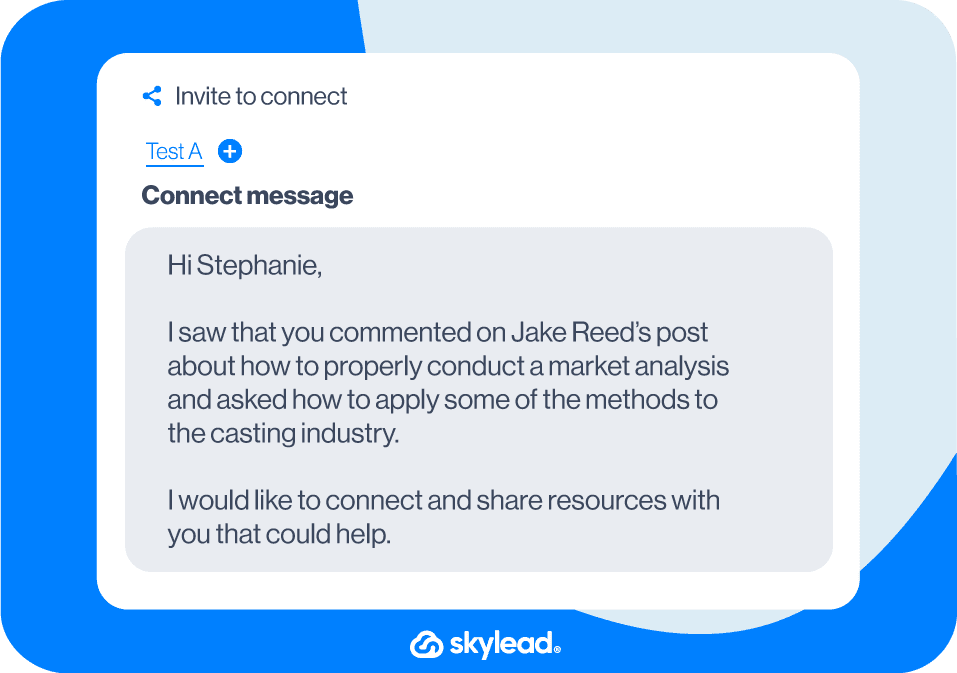
Reach out to members suggested by LinkedIn
The People also viewed feature displays a list of LinkedIn members that the platform’s algorithm found important for your LinkedIn experience, whether you are using it for networking, job search, or lead generation.
Use this template to reach out to them.
Template
Hello {{firstName}},
Your profile came as suggested through the People also viewed section, so I was curious and checked it out. I saw that we’re both in the {{industry}} industry, so I thought we connect and exchange experiences.
Example
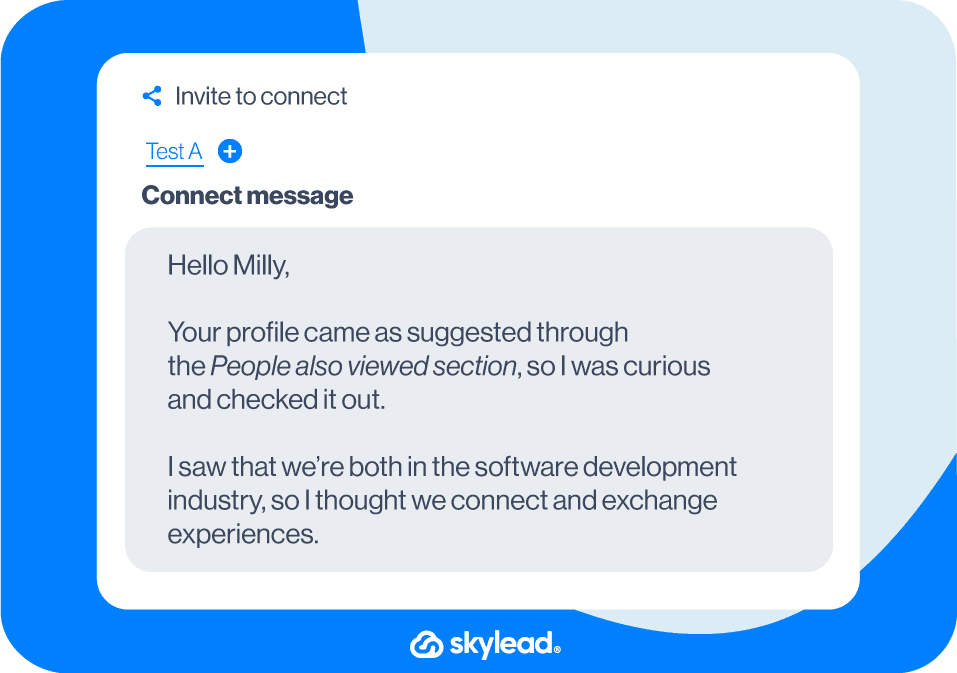
OR
Template
Hello, {{firstName}}
LinkedIn suggested your profile several times now, so I was curious and checked it out. I saw that we’re both {{occupation}}, so I thought it would be good to connect with professionals from the industry. Let’s exchange experiences:)
Example
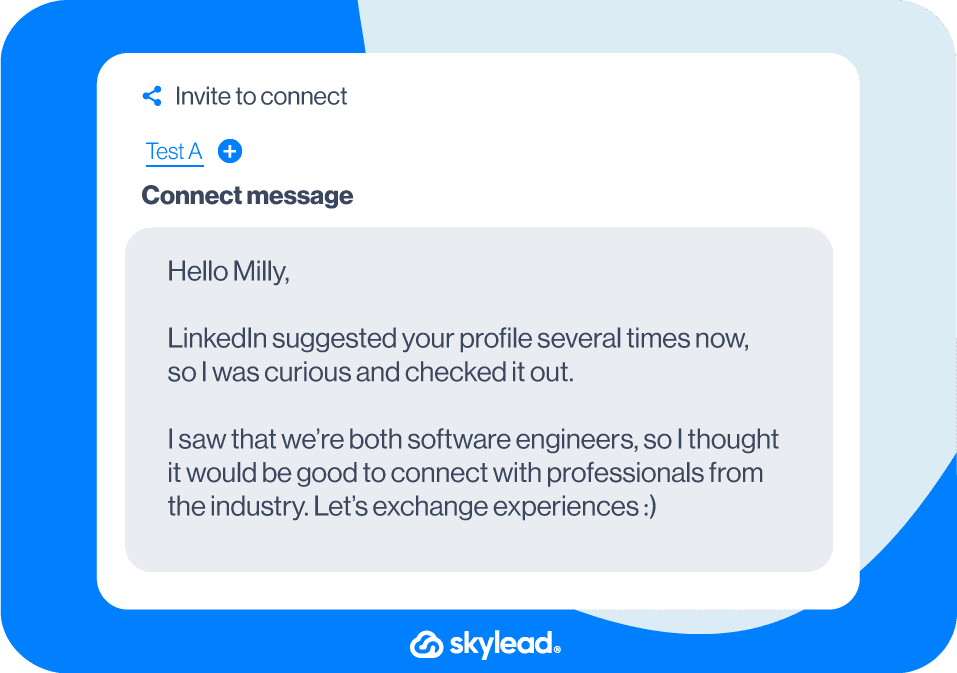
Start with a genuine compliment
Template
Hi {{firstName}}
I have been following your work for some time now, and I must admit your career path in the {{industry}} industry impressed me. I would love to connect with you and ask you a few questions about your beginnings in the field.
Example
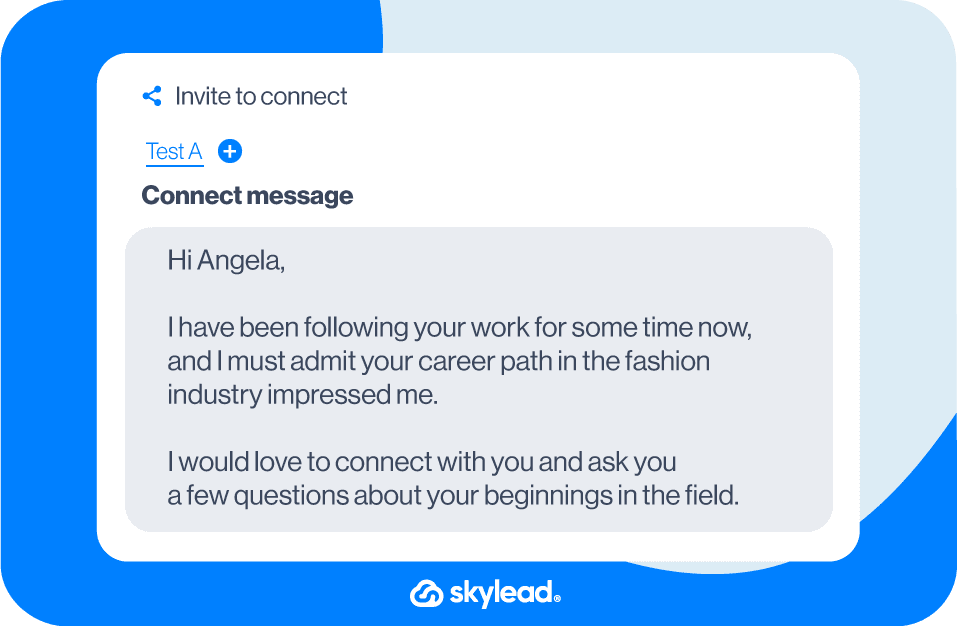
LinkedIn Connection Message: FAQ
How can one effectively track and measure the success rate of these LinkedIn connection message templates, especially in terms of resulting in meaningful professional relationships or business opportunities?
To effectively track the success of LinkedIn connection message templates, monitor acceptance rates and follow-up interactions. Analyzing these metrics can provide insights into which templates foster meaningful connections and opportunities. Adjust strategies based on this data for improved outcomes.
What are the best practices for following up on a connection request if there's no response initially, without coming across as too persistent or spammy?
Following up on a LinkedIn connection request requires a delicate balance. If there's no initial response, a polite and concise reminder after a reasonable period can be appropriate. Avoid being overly persistent; one InMail or email follow-up is generally considered tactful to maintain professionalism without seeming spammy.
How do you politely ask for a connection on LinkedIn?
Asking to connect with someone on LinkedIn has become as common as asking or giving your business card to someone. Many professionals include links to their profiles in the paper or QR code business cards or in the signature section of their emails.
Should I send a message with a connection request on LinkedIn?
Adding a message with a connection request on LinkedIn is generally considered good practice that increases your acceptance rate. However, sending a blank request rather than a generic message is better if you decide not to use a personalized approach. Check out our examples above.
What message to write with a connection request on LinkedIn?
Mentioning something that you have in common with the person you are trying to connect with is generally considered good practice that increases your chances of getting accepted. However, there are many other LinkedIn connection request messages that you can use. Check out our examples to get inspired.
How do I send a cold connection request on LinkedIn?
The cold connection request is not “as cold” as it seems if you follow the golden rule of connecting to people relevant to your business or with whom you have something in common. Therefore, the best way to connect on LinkedIn is by mentioning something relevant to both of you.
Did someone reject my connection request on LinkedIn?
You can ignore someone’s connection request on LinkedIn by clicking “Ignore” instead of “Accept” or by ignoring it and letting it pend. LinkedIn does not notify the sender when their connection request has been declined. Also, LinkedIn automatically deletes pending connection requests after 6 months.
What happens when you ignore a connection request on LinkedIn?
To decline someone’s connection request, just click “Ignore”. LinkedIn will not notify the member of their request being declined, but they can send you another connection request. If you literally ignore the request and leave it pending, LinkedIn will automatically delete it after 6 months.
Do LinkedIn requests expire?
Yes, LinkedIn requests expire. All pending LinkedIn connection requests will be automatically deleted after 6 months. After that, the member whose request has been deleted can ask for another connection again.
Can people see withdrawn LinkedIn requests?
Your recipient won’t be notified if you withdraw your connection request on LinkedIn. To do that, go to My Network > Manage (top right corner) > Sent > Withdraw. If the LinkedIn member already accepted your invitation to connect, they can be removed as a connection.
How do you know if someone accepted your LinkedIn request?
You will get a notification when someone accepts your connection request. To set up notifications, go to Settings & Privacy > Notifications > Connecting with others > Invitations to connect. Or, go to My Network > Connections (top left corner) > Recently added > See the list of recently added connections or search them by name.
At first mention, cold outreach tends to have a bad reputation.
It's no wonder, as no one likes unsolicited emails, LinkedIn messages, or calls.
However, real cold outreach is not useless or annoying. On the contrary, it helps your and your clients' businesses grow and builds strong, lucrative, and long-lasting relationships.
It starts with thoroughly researching the ICP and Buyer Persona, defining a precise outreach strategy, writing sales messages and follow-ups in advance, predicting objections and preparing for objection handling, and much more.
That's why, in this blog, we will dive into a detailed explanation of:
- What cold outreach is;
- How sales, marketing, and recruiting can benefit from it;
- Best practices for successful cold outreach;
- And will give you a list of resources with ready-to-use cold sales message templates.
What is cold outreach?
Cold Outreach is a form of outbound marketing. It implies contacting prospects with whom you had no prior relationship and introducing them to your product/service. It can be conducted via LinkedIn, email (cold emailing), phone (cold calling), or by combining these channels (multichannel outreach).
Companies with a business-to-business work model mainly use cold outreach. For optimal results, each cold outreach campaign should be based on a well-thought-out outreach strategy. This strategy should aligns with the company's needs, goals, and possibilities.
Cold outreach VS warm outreach
Cold outreach, as mentioned above, implies reaching out to prospects with whom you had no prior relationship and who most likely have little or no awareness of your product/service.
On the other hand, warm outreach implies contacting prospects who know about your product/service and have expressed interest in it. The communication channels can be the same as cold outreach strategies - via LinkedIn, email, call, or combining several communication channels. However, the approach is, of course, different.
Cold outreach strategies in marketing, sales, and recruiting
Cold outreach is a form of outbound marketing and sales. It is a traditional form of marketing in which a company initiates contact with a potential customer.
Since cold outreach is mainly implemented by companies with a B2B work model, these potential clients are other companies that could benefit from their products/services the most.
The most common forms of outbound marketing are:
- cold outreach (cold emailing, cold calling, cold messaging on LinkedIn),
- billboards,
- events,
- advertising through TV or radio,
- print,
- online,
- in-person contact, etc.
This chapter will discuss the role of cold emailing, cold calling, and cold messaging on LinkedIn as a cold outreach strategy in sales, marketing, and recruiting.
Cold outreach strategy in marketing
Network with industry peers
LinkedIn networking with industry peers positively impacts the exposure of your business. Furthermore, it brings meaningful connections, and provides additional insights into different marketing trends and practices.
What once was reserved for in-person business events only today is happening on LinkedIn. LinkedIn is a social media platform aimed at building B2B relationships that gathers over 810 million professionals worldwide. In other words, it allows you to find and network with all your industry peers from all over the world in one place.
Connect with thought leaders and influencers
Word of mouth is the best marketing tool, especially from industry experts.
LinkedIn is also an excellent place to connect with thought-leaders and influencers. This way you can talk about your product/service reach your target audience through their content or mention.
Also, you can get in touch with their followers through the Sales Navigator filter Connections Of. Or, use a LinkedIn automation tool, such as Skylead, to scrape LinkedIn members who reacted to specific posts and reach out to them.
Invite top speakers to participate at your event
Whether a startup or an established business, having high-profile speakers at your event (webinars, in-person conferences, seminars, etc.) puts your company in the spotlight. It is an excellent way to gather people from your industry and potential customers in one place.
Additionally, top-level speakers usually have a broad audience and many followers on social media. As a result, they could attract professionals from an industry branch you didn't consider initially. This gives you a significant insight into the direction your business can take.
Submit your content to be published on external resources / Generate backlinks for your website
Create cold outreach campaigns to get in touch with platforms or other brands that could go hand-in-hand with yours.(obviously, skip your competitors!). In return, be open to hosting their content or exchanging backlinks.
Having your content published or backlinked on other places rather than just on your gives your brand significant exposure, whether a startup or an established business. Furthermore, it places you and your team members as field experts.
Send out press releases
A new software release, reaching a business milestone, announcing a new product/service, or anything worth mentioning should be publicly announced. Use cold outreach to get in touch with online magazines relevant to your industry and get extra publicity.
Cold outreach strategy in sales
Simply put, sales represents the group of activities that lead to exchanging goods or services for money or other assets.
Not long ago, the entire sales process, from lead generation to the pitch, was reserved for face-to-face contact. Then, unsolicited calls to prospects without prior contact, known as cold calling, became a crucial part of sales teams' cold outreach strategies. This way, teams managed to reach geographically more distant clients.
Today, with the internet becoming available to almost everyone, sales reps are using more and more social media networks to understand their customers and to reach out to them. However, the social selling process is far more complicated than that.
There are over 63 million decision-makers on LinkedIn. You can now offer your product/service to the entire world, but so can everyone else. That's how social selling was born. It is a sales and marketing strategy that prioritizes relationship building with potential clients and makes the act of selling its consequence rather than a goal. Social selling has many processes, but it usually starts with cold outreach.
Cold outreach strategy in recruiting
Due to the global talent shortage, recruiters must develop an employer branding strategy to present their company in the labor market and a cold outreach strategy to approach ideal candidates and attract them to work for their company.
Furthermore, LinkedIn developed a series of platforms designed to help recruiters find the most qualified candidates for their companies - LinkedIn Recruiter.
What is cold email outreach?
Cold email outreach is an outbound prospecting technique that uses email to approach prospects to establish professional relationships and sell your product. Therefore, a cold email is any unsolicited email sent to someone who knows nothing or very little about your product with the goal of selling it.
B2B Cold email response rates
A generally accepted average cold email open rate is 21.33%, while an average response rate is 1% to 5%.
As you may see, the difference between an open rate and a reply rate is significant. The email open rate depends on your email subject line and your reply rate of how good you are at writing sales messages and follow-up emails after no response.
One of the many benefits of using Skylead, a LinkedIn automation tool and cold email software, is the possibility to find and verify your prospects' email addresses. The verification process is critical, as it ensures higher deliverability (chances of your cold email landing directly in your prospect's inbox instead of spam) and safeguards your domain from restrictions.
Furthermore, every day Skylead team strives to educate our users and beyond on sales and anything sales-related, how to put our tips, tricks, and templates for better open and reply rates, and finally, conversion rates into good use through our tool. You can find sales email templates and LinkedIn templates in our resources or subscribe to our newsletter for the latest industry and software updates and ready-to-use sales templates.
Cold outreach on LinkedIn
LinkedIn is a social media platform that, besides connecting professionals from around the world, gives you significant insights into your prospects' needs, desires, and pain points through their LinkedIn profiles.
Unlike other social media focusing on people's private lives or B2C communication, LinkedIn is majorly oriented towards the B2B business model.
It offers detailed insights into your ideal customers, such as your prospect's name, company name, contact information (email, website, phone number), professional communities they like, and content with which they engage.
Despite LinkedIn being majorly mentioned as a platform for salespeople, sales teams, and marketers, it's important to highlight that it's pretty valuable for recruiters and people looking for new job opportunities.
When fishing for the best talent to join your company, the process is the same as social selling. On the other hand, potential employees rely on LinkedIn before applying to a position that might interest them. They can draw conclusions from the company's employer branding campaigns, growth insights, etc., just like sales reps and marketers do for their potential clients.
What is multichannel cold outreach?
Multichannel cold outreach implies combining channels of communication, usually LinkedIn outreach, email outreach, and cold calling to get prospects to engage in the process of social selling. It can also be performed through your multichannel contact center.
Multichannel outreach is the most effective approach for starting a conversation with your ideal prospects because you are creating more than one touchpoint with your prospects and, at the same time identifying their preferred channel of communication for further conversations.
Benefits of cold outreach
- Cold outreach is cost-effective. You don't need a specific budget to invest in ads, event planning, advertising, etc.
- It's scalable. If you use automation tools, hyper-personalized cold emails and follow-ups can reach thousands of people in a few clicks.
- You can include personalized images, gifs, and videos to make your cold emails or LinkedIn messages more attractive.
- You can reach potential clients and industry peers from all over the world. Cold outreach allows you to expand your business and networking efforts outside a specific geographic area.
- Consequently, cold outreach offers broader brand exposure. Cold emails and cold LinkedIn outreach can reach anyone on the globe. Additionally, LinkedIn provides specific features to promote your business through its feed, online events, sponsored InMails, communities, etc.
Cold outreach: Best practices
Understand your prospects' needs
LinkedIn is a gold mine of qualified prospects and information on those prospects. So, check out:
- the content your prospects share or like,
- the communities they participate in,
- their professional and educational background,
- and their interests.
You can learn all of this by visiting their LinkedIn profile.
Personalize
Once you've understood your prospects' affinities, needs, and goals, it's time to put this information into practice. Personalizing your outreach goes far beyond calling your prospects by their names. Some successful sales reps import CSV files (with email lists or LinkedIn URLs) into automation tools. They also personalize entire paragraphs to each prospect for the best results.
For example, let’s say you have an email list of your ideal prospects. Create a column where you write a personalized intro for each of them where the rest of the sales message copy stays the same for every prospect.

Once you upload this .csv file to Skylead, the column “intro” will automatically turn into a variable {{intro}}. Use it like this.
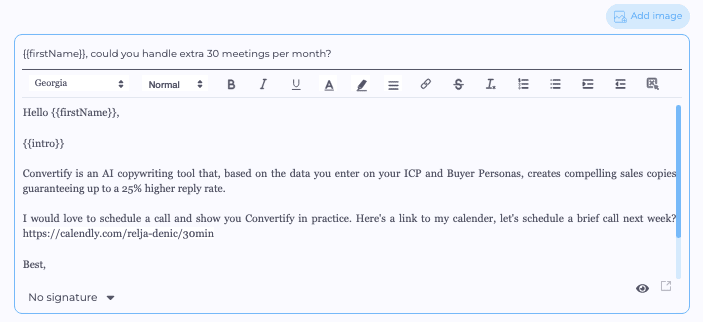
Each prospect will receive a combination of the personalized intro as in the csv file with the rest of the message.
Address the pain points
Your best pitch lies in proving that your product/service solves your prospects' pain points most quickly and directly. Make that clear in your sales messages, from the intro to CTA.
Connect on a human level
However, addressing the pain points doesn't mean selling repeatedly. Keep in mind that your prospects are humans and that you should always try to connect on a human level. Sales reps who genuinely show that they care and want to help their potential customers improve their businesses have higher conversion rates.
Build relationships before selling
As part of social selling, cold outreach is all about building relationships with prospects. People are more likely to buy products from people they trust and with whom they feel comfortable opening up.
Don't quit - follow up
Don't give up after the first try. Decision-makers to whom you're trying to get are busy. They receive numerous LinkedIn connection requests and cold emails and, believe it or not, often forget to reply. So sending a follow-up email is always a good choice.
Qualify your prospects
Qualifying a prospect means determining whether or not someone interested in your product/service is a good fit for it. Therefore, a qualified prospect is a potential client whose pain points your product/service solves in the most direct way. By qualifying your prospects, you will have higher customer lifetime value while lowering churn rates.
A/B test your cold outreach
One cold outreach template won't fit all prospects. That's why it's smart to A/B test message templates of all kinds. A/B test is a randomized experimentation process where two or more versions are sent to different target users simultaneously to determine which one makes results and influences the desirable business action. It's the only way to know what really works for your target prospects.
For example, in this case, we tested 3 different copies of Invite to connect on LinkedIn to see which one would have the highest acceptance rate and/or reply rate.
Here’s how you see the results of A/B testing in Skylead. You also have instant insight into the messages you were testing.
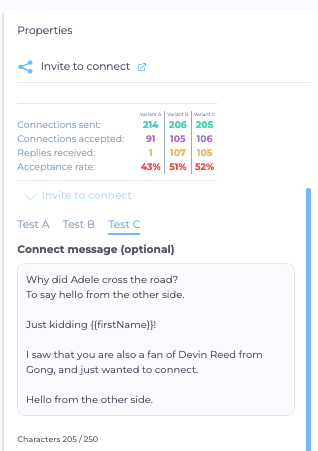
Automate your cold outreach
It's 2025, and we're far past manual outreach. LinkedIn automation tools progressed and are now an indispensable part of any sales, marketing, and recruiting process. Skylead, for example, optimizes your time by finding the fastest way to your prospects, makes sure your cold emails land directly in your prospect's inbox, which affects your deliverability, gives you real-time reports and campaign status, and supports all sorts of integrations with CRMs (i.e., Hubspot, Salesflare, Zoho) newsletter tools, databases, etc. through Zapier and API.
What is a good cold email
A good cold email must show that the sender has thoroughly researched the recipient (prospect) and their company to understand their needs, desires, and pain points. Furthermore, it also includes a concrete and straight-to-the-point explanation of how your product/service can help improve a specific aspect of their business.
The characteristics of a "good cold email" are the same for recruiters and candidates writing to hiring managers to search for job opportunities.
For example, if you're a recruiter reaching out to the ideal candidate, you should show that you've researched that person and why you consider them the right fit for the position. The "spray and pray" approach doesn't work, not it makes your company look good.
The same goes another way around. If you're a candidate searching for an opportunity, make sure you've done thorough research on a specific company's product/service. Even if you're an expert in your field, the hiring manager is less likely to consider you if they notice you don't particularly care about the company itself and that you just go and apply for random jobs.
Cold outreach email template
Now, let's look at some proven cold email formulas (and cold email templates) that increase your reply rates and generate results.
The most basic structure of cold emails, whether a first email or a follow-up, consists of an email subject line, email body copy, call-to-action (CTA), and email signature.
As mentioned above, the email open rate majorly depends on your email subject line. Your response rates depend on how well you researched your recipients, hence, how relevant your offer is to their company. Also, if you included links or hyperlinked words, ensure the anchor words are attractive enough (but not misleading) to improve your click-through rate.
Here are some cold email formulas/templates.
The BAB (Before - After - Bridge) formula
Before - a paragraph on your prospect's pain point.
After - what your prospect's business looks like with a solution you're offering.
Bridge - how your prospect can get there.
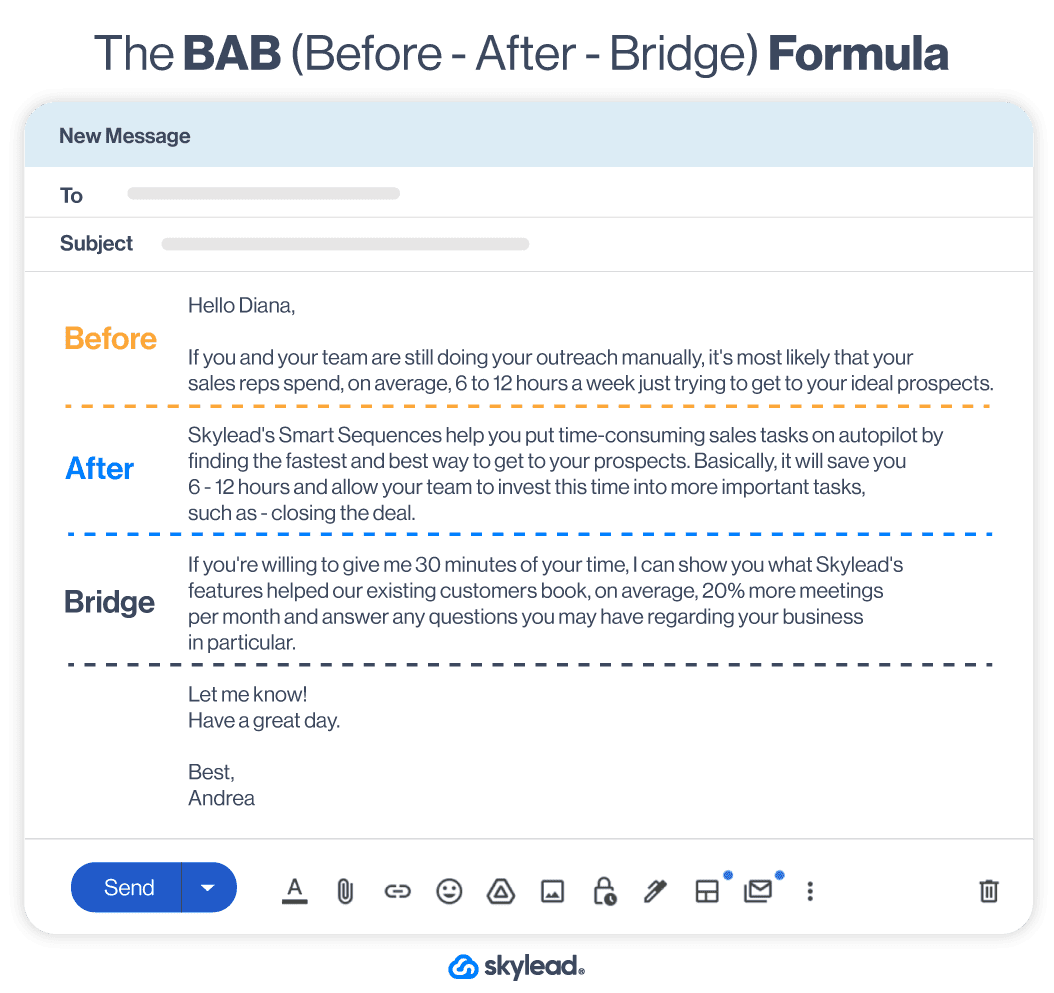
The PAS (Problem - Agitate - Solve) formula
The PAS formula is also known as "a pessimistic version of BAB". However, it works equally well in different situations. You have to evaluate which principle works better for you and your prospects, or you can always AB test them.
Problem - open your cold email with the problem your prospect's facing.
Agitate - emphasize the problem until it "hurts".
Solve - offer a solution to your prospect's problem.
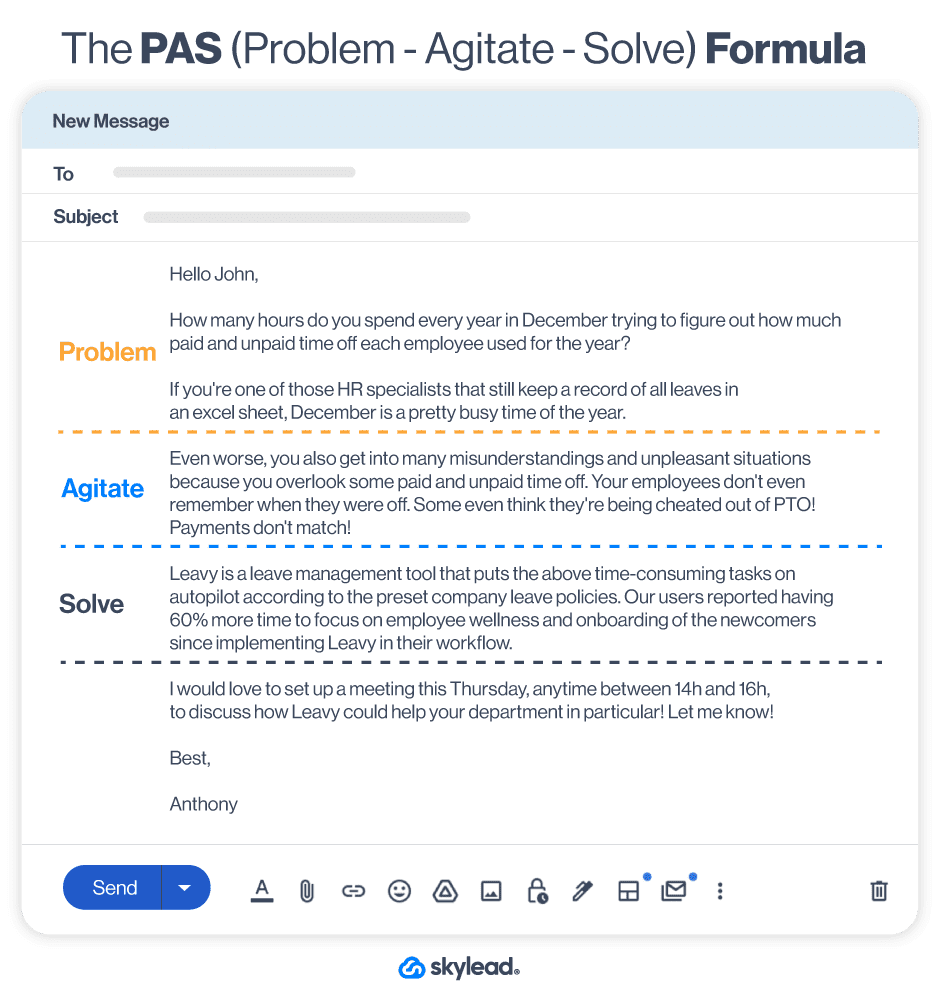
The SSS (Star - Story - Success) formula
Star - introduce the main character, that should be either your prospect or someone with whom your prospect can identify.
Story - tell a story about your character in which they face the same problem your prospect does.
Success - share how your character got out of the problem and offer the same solution to your prospect.
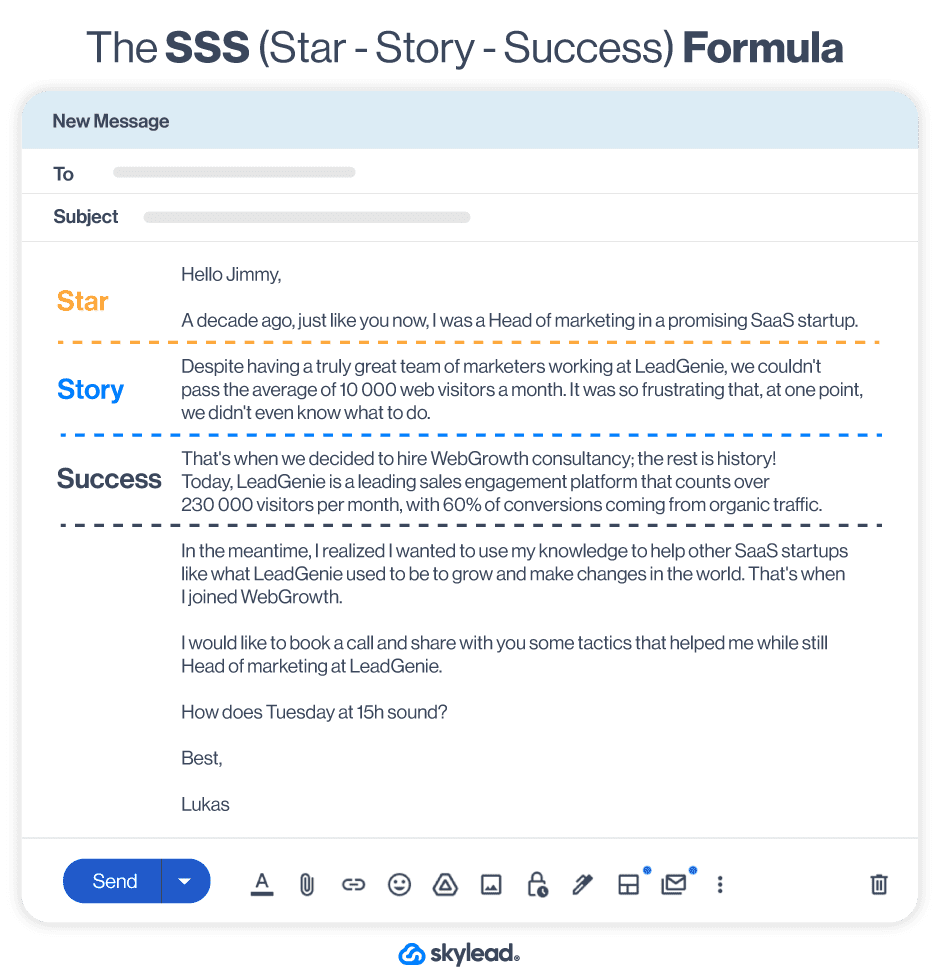
The ACCA (Awareness - Comprehension - Conviction - Action) formula
Awareness - show your prospect that you know what their pain point is.
Comprehension - explain how this pain point affects them, and tell them you have a solution.
Conviction - create a desire for the solution.
Action - call-to-action (CTA).
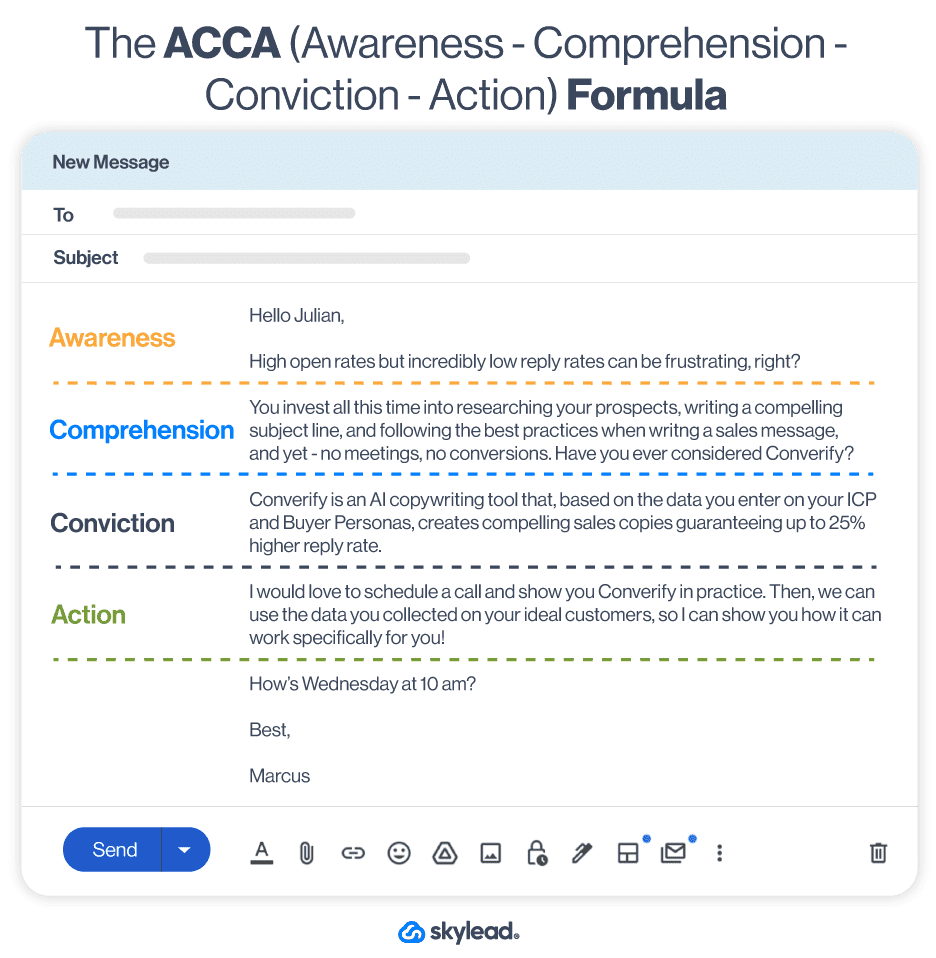
The AIDA (Attention - Interest - Desire - Action) formula
Attention — Grab the prospect's attention.
Interest — Make it personal to engage their interest.
Desire — Build desire for what you're offering.
Action — Ask for a response.
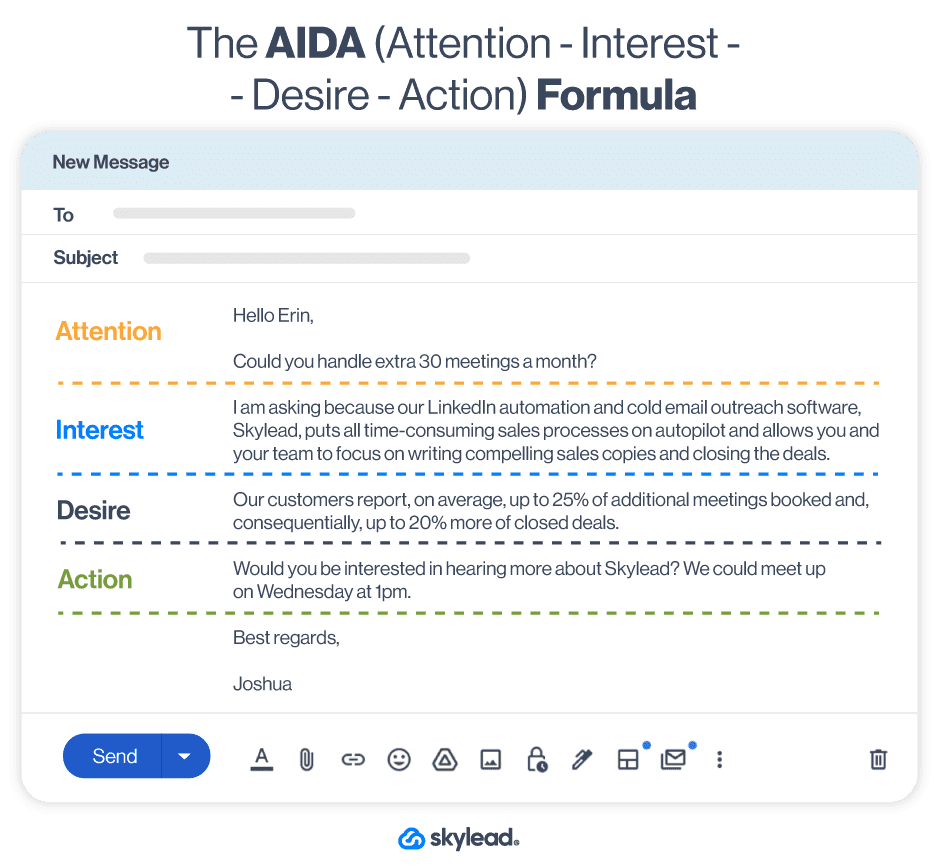
Also, remember to check out our ready-to-use follow-up email after no response templates, as well as the most common email mistakes and the most effective email calls-to-action (CTAs) for higher response and conversion rates.
Best cold email outreach subject line
Whether a first or a follow-up email, your email subject line is crucial for your open rates.
Subject lines should be compelling but not misleading. If you used tricks to get your email opened, and the subject line doesn't reflect the email body, don't expect your prospect to reply. People generally get angry when misled and are less likely to open your follow-up emails, too.
Here are email subject line guidelines, best practices, and over 107 subject line examples that you can use immediately or draw inspiration from.
LinkedIn outreach templates
In simple words, LinkedIn outreach implies using the platform to connect and nurture professional relationships with the goal of selling your product/service to those members that would benefit from it the most.
For this purpose, LinkedIn offers different types of messaging, such as connection requests for better acceptance rates, regular messages for members of your network, LinkedIn InMails for busy decision-makers, and 3rd-degree connections.
From this point of view, LinkedIn outreach is different from cold email outreach for classifying members based on your connection level, whereas you can send a cold email to pretty much anyone whose email address you have. However, LinkedIn as a platform offers other benefits, such as networking opportunities, significant insights into your prospect's professional achievements, pain points, and professional aspirations, etc.
You will find over 30 ready-to-use LinkedIn outreach templates in our resources LinkedIn connection message templates, sales messages for starting sales conversations, and LinkedIn InMails examples.
LinkedIn outreach automation
Skylead is a LinkedIn automation tool and cold email outreach software that, thanks to its smart algorithms that make decisions based on your prospect's behavior, automates time-consuming sales processes and gets to your prospects in the fastest and most direct way possible.
By automating your LinkedIn outreach, you are optimizing your time and saving resources while still getting the most out of your LinkedIn prospecting process. In addition, it is perfectly safe and supports integrations through API and Zapier with CRMs, newsletter tools, database software, calendar booking tools, etc.
Skylead allows you to automate only LinkedIn outreach, make only cold email campaigns, or combine everything into multichannel outreach for the best results. It also has its email finder that, at the same time, verifies each prospect's email address to increase deliverability and prevent harming your email domain.
Skylead’s Smart Sequences work on the “if/else” principle meaning that they act based on your lead’s behavior. The picture below shows what multichannel outreach looks like but you can always opt to make a Smart Sequence that focuses on one channel only (LinkedIn or email).
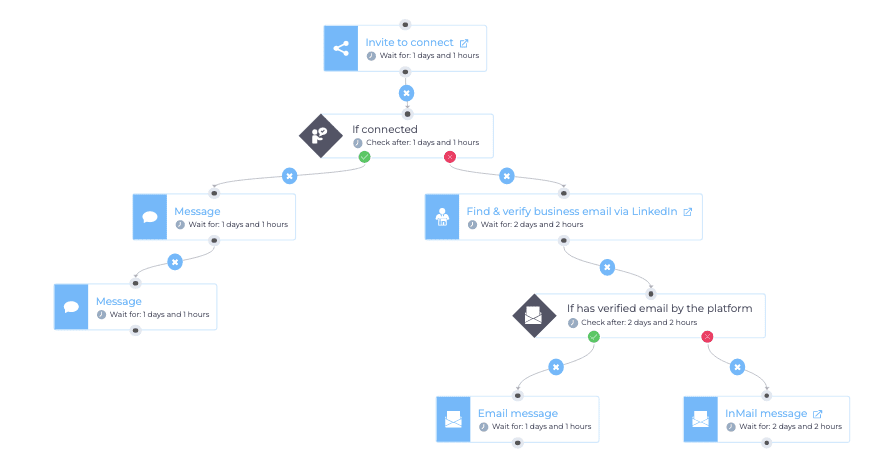
Also, it has a proven boost mode feature that helps you bypass LinkedIn limits and connect with more prospects in less time.
Frequently asked questions
How does cold outreach automation compare to manual outreach in terms of effectiveness and personalization?
Cold outreach automation can scale efforts and maintain consistency while keeping a deeper level of personalization, potentially increasing effectiveness by making recipients feel uniquely considered. While manual outreach can be personalized as well, automation is a preferred option because it saves so much time.
What are the ethical considerations or potential drawbacks of using cold outreach strategies, especially regarding unsolicited messages?
Ethical considerations in cold outreach include respecting privacy, avoiding spam, and ensuring messages provide value. Misuse can lead to negative brand perception and legal issues.
Can the effectiveness of cold outreach vary significantly between industries, and if so, how should strategies be adapted for different sectors?
Effectiveness of cold outreach can indeed vary across industries. Sectors with high digital engagement may respond better. Tailoring strategies to industry-specific preferences and pain points is crucial for relevance and effectiveness.
Is cold outreach effective?
If done right, cold outreach is a powerful prospecting tactic used by many salespeople for its high ROI, the possibility to reach potential clients from all over the world, and the ability to build long-lasting business relationships.
Why is cold outreach important?
Cold outreach can help you gain broader brand awareness and reach potential customers from all over the world. Furthermore, it's cost-effective and can be used for sales, marketing, recruiting, and job searches.
How do you conduct a cold outreach?
- Identify prospects more likely to convert.
- Consider using multichannel outreach to identify their preferred means of communication.
- Prepare your LinkedIn and/or email strategy in advance.
- Prepare your LinkedIn sales messages and/or cold sales emails in advance.
- Personalize.
- Follow up.
Is cold email legal?
You will not get into trouble if you use your prospects' business email addresses for cold email campaigns.
Can you cold email B2B?
Yes, B2B companies' sales teams use cold email outreach and LinkedIn outreach more often to accomplish their sales goals.
What is cold outreach in marketing?
Cold outreach in marketing is a form of outbound marketing that implies contacting prospects who could turn into your potential clients but don't know about your brand and have no previous experience with it. It could be done through email marketing, LinkedIn outreach, and cold calling.
What is cold lead generation?
Cold leads (referred to as "top of the funnel" leads) are those who are most likely not familiar with your product/service and haven't expressed interest in it. Cold lead generation is the process of gaining cold leads' attention, usually through LinkedIn (LinkedIn lead generation), cold emailing, and cold calling.
What is the difference between cold calling and prospecting?
Prospecting is the process of identifying and building relationships with potential customers who probably don't know about your product and haven't shown interest in it so far. Cold calling is one of the prospecting techniques which includes reaching out to potential customers via phone.
Is it better to cold call or email first?
It majorly depends on your sales outreach strategy. However, some outreach experts find cold emailing less invasive and advise starting by reaching out to your ideal customers in written form (cold emailing and/or LinkedIn outreach).
How long should a cold outreach email be?
Generally, shorter cold sales emails of around 50-200 words have higher response rates. However, the most important aspect of cold emails is that they are personalized and highly relevant to the recipients. Also, their subject lines must be catchy while reflecting the emails' topic.
LinkedIn Boolean search is a query technique that combines words and phrases with the Boolean operators AND, OR, NOT, (), “”, to limit, broaden, or better define your search. It is used to produce more accurate results on the platform and allows you to navigate through relevant leads while disregarding unrelated ones.
Boolean search can be a powerful tool to get the most out of your LinkedIn lead generation process while saving time and resources. That’s why, our sales team uses Boolean search in their everyday filtering activities on LinkedIn, and we can proudly say that this was one of the most effective LinkedIn prospecting strategies to go from 2500 to 10 000+ users in 9 months.
To apply Boolean search successfully on LinkedIn, you’ll need to know:
- Boolean search rules & operators;
- LinkedIn filters that support Boolean search;
- How to prepare for Boolean search on LinkedIn to get the most relevant leads for your business.
- Also, we will give you 5 Boolean search string examples for LinkedIn that you can copy & paste or get inspired by to make a Boolean string that fits your business needs better.
The benefits of using a Boolean search on LinkedIn
Utilizing Boolean search on LinkedIn, especially when combined with other filters, offers several benefits. Our sales team has found that Boolean search, when integrated into their search strategy, helps:
- Handpick leads en masse. Boolean search allows you to combine keywords in a way to provide a more detailed search experience.
- Blacklist unwanted leads. The NOT operator enables you to exclude specific terms, which is helpful for subscribers using LinkedIn filters that don't have the Exclude option.
- Efficient talent sourcing: Recruiters can use Boolean search to identify potential candidates with high precision, saving time and resources.
- Fine-tune company research: Boolean operators can be applied to investigate companies, their employees, or industry trends, aiding in thorough research.
- Stay updated with relevant content: Boolean search within filters helps users discover and engage with specific content, discussions, or news pertinent to their professional interests.
How to do a Boolean search on LinkedIn?
Here are some ground rules when it comes to Boolean search principles in general and on LinkedIn.
Boolean search rules for LinkedIn
Here are some basic Boolean search rules to follow when searching on LinkedIn.
- The Boolean search operators AND, OR, and NOT must be written in uppercase. Example: content OR copywriting
- If your search term is composed of more than one word, it needs to go under quotation marks. Example: “content writer” AND copywriter
- If combining the Boolean search terms, use parenthesis to define your query. Example: (“content writer” OR copywriter) NOT “content manager”
Boolean search terms for LinkedIn
Boolean search terms on LinkedIn consist of the following 5 operators that help you create a logical relationship between the keywords you would like to search, and therefore, bring back more precise and targeted search results.
The AND operator
The AND operator tells a search engine to find all people whose LinkedIn profiles include both terms.
For example, if you search for writer AND copywriter, LinkedIn will only bring back users whose profiles contain BOTH the term writer and the term copywriter.
The OR operator
The OR operator tells a search engine that you wish to find users whose LinkedIn profiles include either of the terms. Also, if there’s a LinkedIn profile containing both terms, it will appear in your results.
For example, if you search for content OR copywriter, LinkedIn will bring back users whose profiles contain EITHER of the terms or BOTH terms.
The NOT operator
The NOT operator tells a search engine what words to exclude from search results. Differently from other operators, it needs to stand before the term you wish to exclude. If you wish to exclude multiple terms, the NOT needs to be inserted before each term.
For example, if you search for content NOT copywriter, LinkedIn will bring back profiles containing the word content and it will avoid all profiles that contain the word copywriter. If you wish to exclude editors as well, you should compose your query as content NOT copywriter NOT editor.
Quotations “”
Quotations are used in LinkedIn Boolean search when your search term is composed of two or more consecutive words that need to stay in a specific order. For example, if you wish to find content editors, but avoid content writers, your query would look like this “content editor” NOT “content writer”. If you don’t put the term composed of two or more words under quotation marks, the search engine will look them up as separate terms.
For example, content editor NOT “content writer” will bring back results that contain the word editor, the word content, and will avoid profiles with the word content writer.
Parenthesis ()
This Boolean operator is essential for writing complex search strings that give carefully picked results. Namely, when including parenthesis in the Boolean search, the algorithm sees the string between the brackets as a query that needs to be solved separately and then in relation to other parts of the string.
For example, the query head AND (sales OR marketing) NOT (intern OR assistant OR communications) will bring back results of all leads who are either Head of Sales or Head of Marketing or Head Of Sales & Marketing but will exclude all people from the same departments that are interns, assistant, or hold the title of the Head of Communications.
Here’s a visual presentation of the LinkedIn Boolean terms.
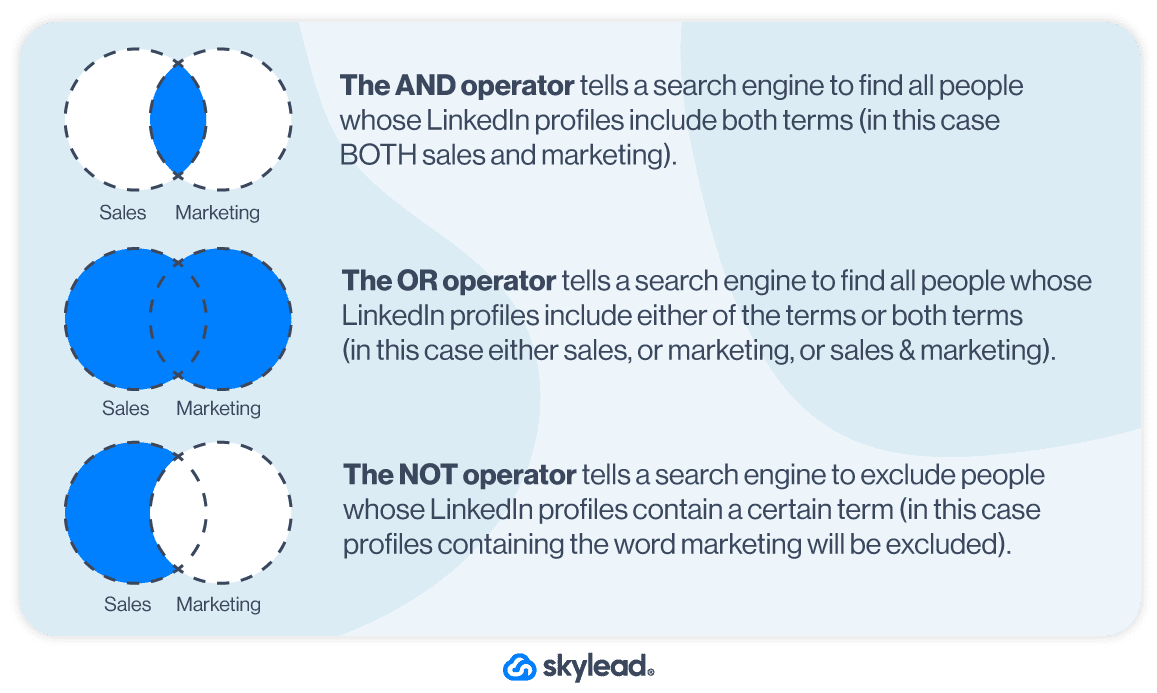
Which LinkedIn filters support Boolean search?
Here are the filters supporting the Boolean search according to your LinkedIn plan.
LinkedIn Boolean search
On LinkedIn, you can apply the Boolean search only to the Keyword group of filters, which are:
- First Name
- Last Name
- Title
- Company
- School
This means that, whatever you put in the Keywords filter on LinkedIn, it will search within these 5 sections of your lead’s profile. If you want LinkedIn to search within a specific section, use precisely that filter instead.
Also, our SRD, Pavle, tested applying longer Boolean search strings to LinkedIn basic and premium filters, and it was interesting to note that they don’t allow longer searches. He would get the “No results found” message, which is not quite true.
LinkedIn just wants to point out the benefits of investing in Sales Navigator, LinkedIn’s premium platform designed specifically to handpick ideal leads through Sales Navigator filters, or in Recruiter with its 23+ filters designed for finding the finest talent for your business.
Sales Navigator Boolean search
Sales Navigator allows you to apply the Boolean search to the following filters:
- Keywords
- Current company
- Past company
- Current job title
- Past job title
- First name
- Last name
The most commonly used filter to apply the Boolean search is the Keywords filter. However, keep in mind that this search result can be very extensive and imprecise since the search engine will list all users whose LinkedIn profiles include that particular word anywhere on their profile (in their title, LinkedIn headline, posts, hashtags, skills, etc).
On the other hand, when you apply the Boolean search to other, more specific filters listed above, LinkedIn will search only those sections of your lead’s LinkedIn profile to find the keyword match.
That’s why, the Boolean search produces the best results when combined with other filters.
Recruiter Boolean search
Unlike other LinkedIn subscriptions, Recruiter explicitly indicates which filters support Boolean search (plus the First and Last name filters which also support Boolean search but don’t have it clearly stated below).
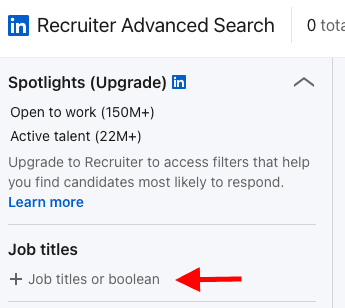
Here’s the list of ALL Recruiter filters supporting Boolean search:
- Job titles
- Companies
- Keywords
- First name
- Last name
How to prepare for Boolean search on LinkedIn
Before creating a Boolean string for your LinkedIn, Sales Navigator, or Recruiter search, make sure you define your Ideal Customer Profile and Buyer Persona.
Then, off of that information, answer the following questions just to make sure you don’t miss out on any relevant leads.
- Are there any synonyms or another name for the same or similar job title of your ideal? If yes, make sure you include them in your search.
- Are there any key skills and expertise your ideal lead should have? If yes, did your ideal lead attend any specific schools or courses, or is part of a specific LinkedIn group where they gained these skills?
- Are your ideal lead’s years of experience in a specific position or company relevant to your search?
Also, on the other hand, to get what you want, sometimes you need to eliminate what you don’t want first.
- Are there any titles you want to exclude from your search? Typically, people exclude assistants, interns, etc.
- Are there any companies that you would like to exclude from the search? Maybe you are already talking to these companies, they are your competitors, or you wish to blacklist their employees for any other reason.
- Is there a particular keyword that could help you exclude a specific niche from your search?
Finally, one of the hacks our sales team uses is to save their Boolean search strings on a separate sheet of paper such as Google Docs or a Word document, just to keep a record of what they combined since LinkedIn filters don’t show longer queries in full.
5 LinkedIn Boolean search string examples
Here are 5 Boolean search string examples inspired by the strings used by our Head of Sales, Andrea, to find the most relevant leads for Skylead.
You can copy & paste them or adapt them to your filtering needs. Also, we always encourage using ChatGPT for sales, so in this case, you can use some of the below Boolean string examples as prompts and ask Chat GPT to produce similar ones.
Finally, the below templates will help you understand better the Boolean principle in general, and how powerful it could be to bring back the most relevant search results on LinkedIn.
Let’s set several Boolean string formulas that can help you understand the Boolean principle better and how to apply it to produce more relevant and precise results.
Boolean search string example for matching job titles with seniorities
Use this Boolean search string to find specific job titles matched with their seniorities while at the same time excluding some of the options.
Formula
(Seniority OR Seniority OR Seniority) AND (Title OR Title) NOT (Seniority OR Title OR KeywordsYouWishToExclude)
Example
(Head OR Chief OR VP) AND (Sales OR Marketing) NOT (Intern OR Assistant OR Consultant OR Growth)
Expected search results from this Boolean string
This LinkedIn Boolean search string will make the search engine bring back LinkedIn profiles including either of the following terms:
- Head of Sales
- Chief of Sales
- VP of Sales
- Head of Marketing
- Chief of Marketing
- VP of Marketing
And it will exclude any profile containing the words - intern, assistant, consultant, or growth.
How to use this Boolean string
If you are a LinkedIn user (basic or premium), check out the Which LinkedIn filters support Boolean search to understand why LinkedIn members cannot use more complex, longer Boolean search strings.
If you are a Sales Navigator user, apply this Boolean string to the Current job title filter.
To access this filter, go to your Sales Navigator home page > Lead filters > Current job title.
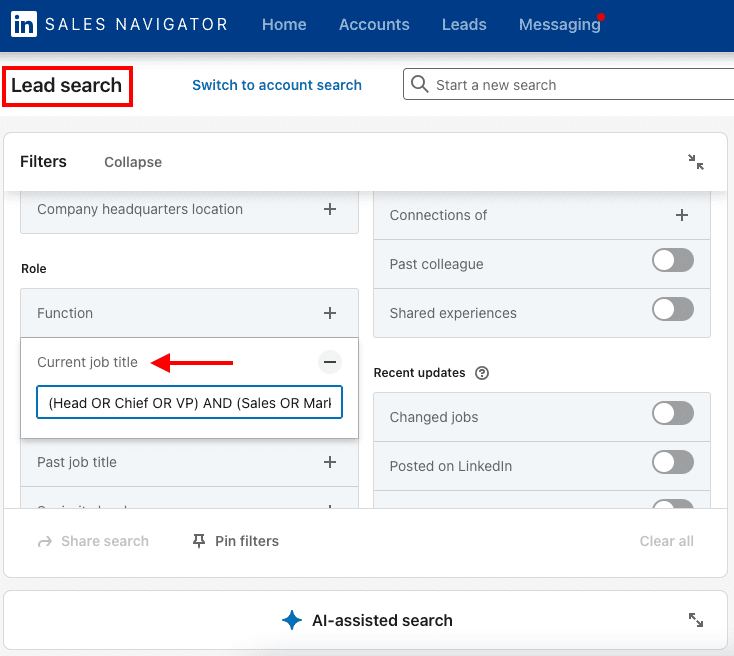
As mentioned above, Boolean search works best if combined with other filters.
Also, Sales Navigator offers the Exclude option for some filters, so you can exclude some criteria through that feature if it works better for you.
Boolean search string example to target or blacklist leads from a niche industry
Use the Boolean search to target or blacklist leads from a specific niche industry.
Formula
Field of work AND (keyword OR keyword OR keyword) NOT keyword
Example
“Medical Practice” AND (sports OR nutrition OR wellness) NOT injury
Expected search results from this Boolean string
This Boolean search string should bring back LinkedIn profiles that include keywords such as medical practice and either of the terms between the parentheses (or all terms) mentioned somewhere on their LinkedIn profile. If a specific keyword is not your target, like injury, in this case, LinkedIn will exclude these users from the search results.
How to use this Boolean string
This Boolean search string can be used by both LinkedIn (free & premium) and Sales Navigator subscribers.
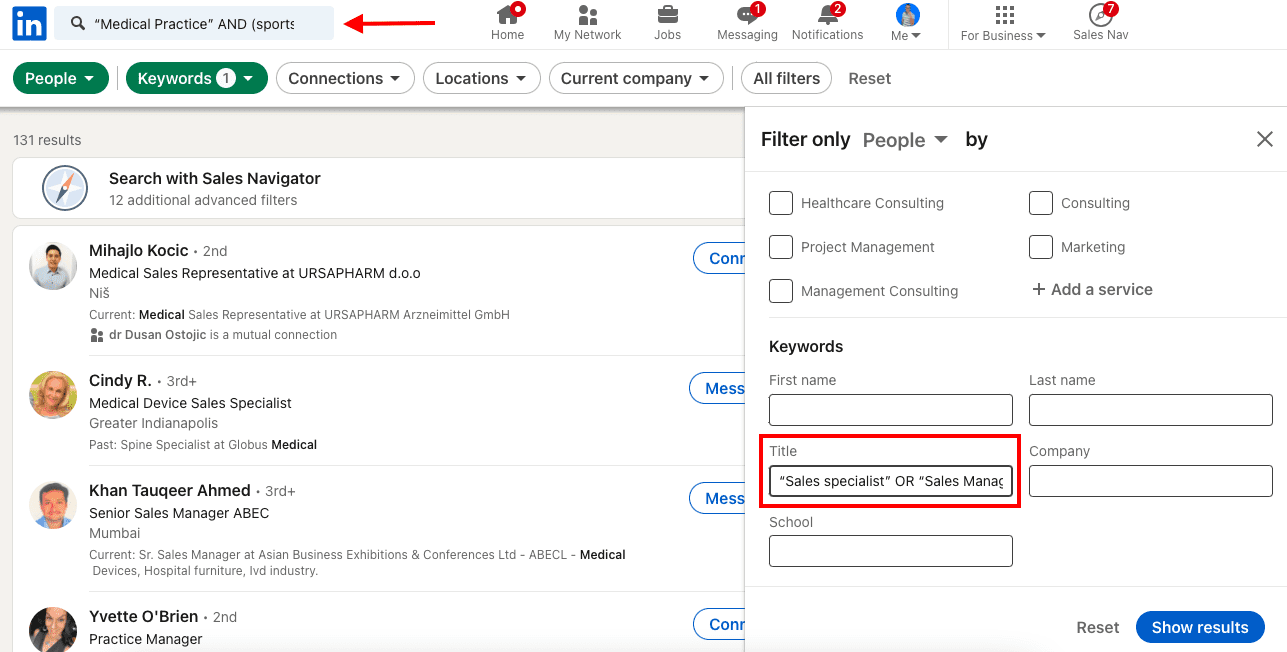
Sales Navigator

As you may see, we applied the string to the Sales Navigator Keywords filter. Additionally, to get an even more specific list of leads, we applied a simple Boolean search string to the Current job title as well.
Formula
Title OR title OR title
Example
“Sales specialist” OR “Sales Manager” OR “Sales Representative”
Of course, you should always add other criteria to refine your search.
Boolean search string example to combine job titles with seniority or a specific skill
The following Boolean search string is particularly useful for LinkedIn users (free & premium) since they don’t have the Seniority filter, nor can they blacklist leads based on different criteria.
Also, it’s useful if your ideal lead’s job title varies, but you want to include a seniority level, a specific skill (a programming language in this case), and maybe even exclude certain companies from your search.
Formula
Seniority AND (title OR title) AND keyword NOT keyword
Example
Senior AND (“Software Engineer” OR “Software Developer”) AND Java NOT TomTom
Expected search results from this Boolean string
This LinkedIn Boolean search will bring back users who hold or used to hold either one of these titles. Also, they need to have Java programming language mentioned somewhere on their page (this is where you need to see manually if they have it as a skill or they just mentioned it in a post or similar), and if they don’t work or that didn’t work for a specific company (in this case TomTom, or they never mentioned a specific company in their LinkedIn profile).
How to use this Boolean string
As mentioned above, this Boolean search string is particularly useful for LinkedIn users, but it can be applied to Sales Navigator filters as well.
We applied this Boolean search string to the Keywords filter and then added other filters to narrow the search result.
Boolean search string example to combine your leads’ titles or functions
Use the Boolean string to be specific about the combination of titles or functions of your ideal lead.
Formula
Title AND (title OR title) NOT title
Example
Owner AND (CEO OR “chief executive officer”) NOT Founder
Expected search results from this Boolean string
For example, this Boolean search string is useful if you’ve noticed that lots of Owners and CEOs are also Founders of their companies. However, you wish to exclude companies where founders are Owners and CEOs at the same time.
How to use this Boolean string
Apply this Boolean search string to the Title filter if you’re a LinkedIn subscriber, and to the Current job filters if you’re a Sales Navigator subscriber.
This Boolean string is particularly useful for LinkedIn subscribers as Sales Navigator filters have the Exclude option.
Boolean search string example to add industry jargon to your search
Consider adding terms or jargon or simply keywords that are common for that particular industry in your Boolean search.
Formula
Seniority AND (title OR title) AND (Keyword OR keywordSynonym)
Example
Head AND (Sales OR Marketing) AND (Saas OR “Software as a service”)
Expected search results from this Boolean string
This Boolean search string will bring back LinkedIn profiles whose users hold or held titles such as Head of Sales, Head of Marketing, or Head of Sales & Marketing, and worked in the SaaS industry, or simply mention Saas or Software as a service in their headlines, posts, about section, experience, etc. on LinkedIn.
How to use this Boolean string
Apply this Boolean search string to the Keywords filter whether you’re a LinkedIn or a Sales Navigator subscriber.
How to streamline the process of reaching leads found through Boolean search
Luckily for you, there’s a way to apply the Boolean search only once and set up an auto-refresh to continuously get new leads that match your criteria and eliminate the time-consuming process of repeatedly going through the search process.
The answer is - Skylead.
Skylead is compatible with ALL LinkedIn subscriptions, and in this blog, we will show you how to reach and auto-refresh leads found through the Boolean search if you’re a Sales Navigator subscriber.
First, set up your Sales Navigator Boolean search and combine it with other filters. In this case, we applied the Boolean search string example #1 from this blog, added the industry filter, and the location filter, and turned on ‘Changed jobs’ in the Recent updates filter section.

Then, copy and paste the URL of your Sales Navigator search result into Skylead’s campaign creator.
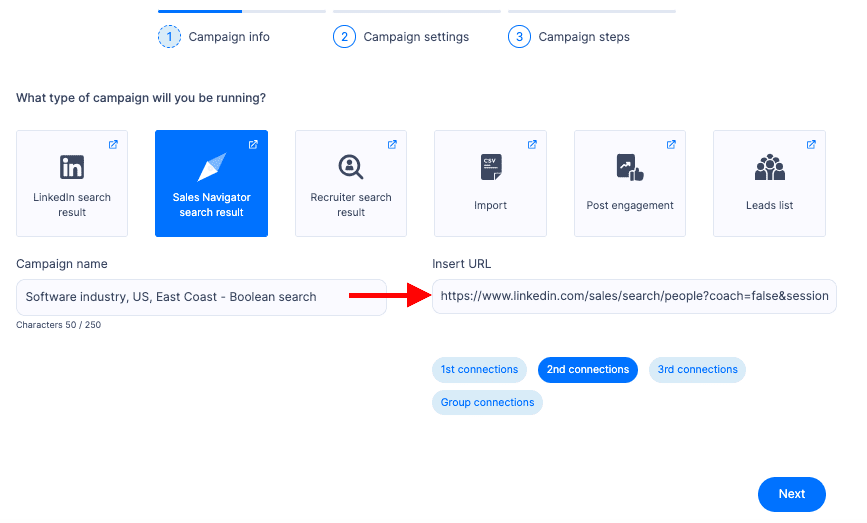
Turn on Skylead’s auto-refresh option. Essentially, if new leads appear within the same URL source, they will be pulled into active campaigns if you turn this option on within the tool.

Then, proceed to make a Smart sequence.
Skylead’s Smart sequences are smart algorithms that allow you to combine LinkedIn automation, unlimited Email automation, Email verification & discovery, and Image & GIF personalization to help you book 3x more meetings than before.
Here’s an example of a ‘classical value proposition’ type of a Smart sequence.

Once you start your campaign, Skylead will do all the work for you, and you can focus on building professional relationships with your leads and closing the deals.
Boolean strings for refined targeting
We understand that the Boolean search on LinkedIn could seem a bit intimidating. However, we hope you understood its huge potential, and that this short manual helped you gain a better understanding of how it works, and how to use it to optimize your search results.
Speaking of, another way to optimize your lead generation, is to automate time-consuming outreach processes with Skylead. Curious to know how? Sign up for Skylead’s 7-day FREE trial, and test out the most powerful tool for LinkedIn and email automation on the market.


